2015 Hyundai Sonata: What's It Like to Live With?
Read the latest updates in our long-term road test of the 2015 Hyundai Sonata as our editors live with this car for a year.
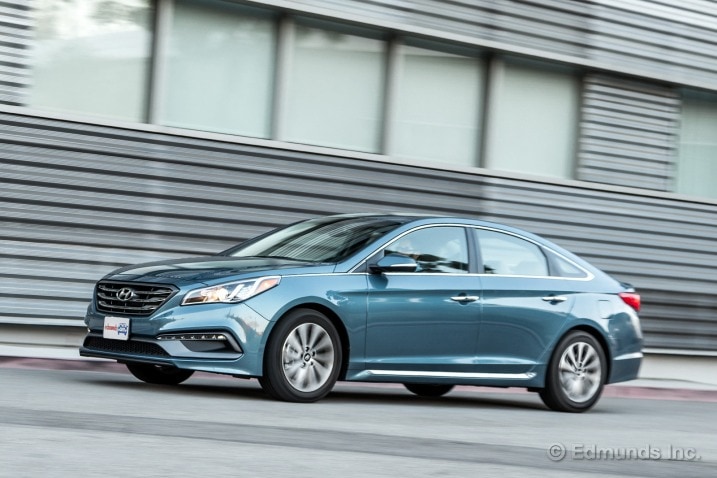
What do you want to know about?
- Introduction
- Airbag Warning
- Solid Driver Seat So Far
- Love the User-Friendly Design
- Airbag Non-Issue
- Fuel Economy Update for December
- Mottled Seat Design
- Road Trip to the Rock, Part 1
- Road Trip to the Rock, Part 2
- More Center Stack Observations
- Handy Storage Cubbies
- Did We Get the Wrong Car?
- Performance Tested
- Hands-Free Smart Trunk
- Fuel Economy Update for January
- Lights Need Straightening
- Sliding Sun Visors
- Smooth and Refined Engine
- Opinions on the Touchscreen Interface
- A Very Likeable Sedan
- Fuel Economy Update for February
- Big Trunk
- 5,000 Miles So Far
- A Slightly Less Distinctive But Very Straightforward Control Layout
- Spacious Rear Seat in Most Dimensions
- Rear-Facing Convertible Car Seat Fits Well in the Center, Can't Use LATCH
- Rides and Steers Better Than Its Predecessor
- Vastly Better Seats Than Before
- Fuel Economy Update for March
- Earns "A" and "B" Ratings From Edmunds
- BMX Bike Fits
- Aux Controls Keep Your Eyes on the Road
- I'm Impressed
- Better Steering and Shifting in Sport Mode
- Hey Driver, Your Wheels Aren't Straight
- Easy-to-Use Navigation System
- Fuel Economy Update for April - City Miles Drop Our Combined Average
- Clawing Back MPG In Eco Mode
- Grocery-Smashing Trunk Hinges
- Northbound & Down
- Does Details Better than Accord
- Looks More Expensive Than Before
- Fuel Economy Update for May — Overall Mileage Improves
- Bright or Low Light, This Blue Is Just Right
- Can't Charge Everything
- Good Sound From Hyundai's Own Label
- I Like Almost Everything About It
- Winded and Wheezy on Mountain Climbs
- Good First Impressions, But Do They Last?
- Real World Numbers
- Rear-Facing Convertible Car Seat Fits Better On Side
- Fuel Economy Update for June: New Records for Best Range and MPG
- First Service and Tire Rotation Woes
- Veering to the Right
- A Nice Companion When You're Not Going Anywhere
- Navigating with Android Auto
- Impressions from a Family Road Trip For Fireworks
- A Little Gutless, But Trouble-Free and Comfy After 10,000 Miles
- Better Mirror Than BMW
- Forget SMS - Android Auto Can Send WhatsApp Messages
- Fuel Update for July - Steady Gains Toward EPA Rating
- A Macro Look at Interior Materials
- Yep, Android Auto Includes MLB At Bat
- So Very Gray
- What I Don't Like About Android Auto
- Excellent Road Trip Car
- Stays Cool in the Heat
- Nice Light for Dark Driving
- A Hotter Hand than Honda?
- A Hyundai I'd Like to Own
- A Warm Respite from Snakes
- Road Trip Ruminations
- Fuel Economy Update for August - Many Miles Moves the Needle
- Exactly What You Want
- Fuel Economy Update for September - Long-Distance Runner
- 15,000-Mile Service
- Fun to Play With the "Beats Effect"
- Two Details Away from Being a Benchmark
- Blind-Spot Audio Alert Promotes Bad Habits
- Tracking Down the Missing Rear Seat Vents
- Smart Trunk Surprise — Here's How It Works (with Video)
- Fuel Economy Update for October: A Little More Led in Our Step
- Balance of Power — A Case For and Against the Four-Cylinder Turbo
- No Problems On the Way to 20K
- Warns About Losing Your Grip
- The Long Road to Phoenix
- I Still See You
- Blinded by the Light
- Wrap-Up
Introduction
What Did We Get?
Just a few years ago, Hyundai shook up the midsize family sedan segment with a radically redesigned Sonata that looked like nothing else on the road. Shoppers in the segment definitely liked what they saw, as sales nearly doubled from 2009-'10.
For 2015, Hyundai took a more traditional approach when it came time to redesign the Sonata. Instead of a curvaceous, extroverted look, it's now boxier and more sedate on the outside. Inside the cabin, the dashboard surfaces that were once angled or contoured are now arrow-straight and simple.
It's an interesting evolution that could turn off those who liked the more expressive styling, or it may attract those who still preferred the Honda Accord or Toyota Camry instead. We liked what we saw enough to give the new Sonata an "A" rating after our initial test, so we figured it was a good candidate to add to our long-term test fleet.
Rather than get a top-of-the-line model with the most powerful engine, we opted for a high-volume model. We expect the Sonata Sport model with the standard 2.4-liter four-cylinder engine and six-speed automatic transmission to account for the lion's share of the Sonata's sales, so that's what we ordered.
The 2015 Hyundai Sonata starts out at $21,960 in SE trim. Our Sport trim began at $23,985.
What Options Does It Have?
Very few options packages are available at the Sport level, so it was easy to choose how to outfit our Sonata. The Premium package includes a blind spot monitor, leather seats with cloth insert, dual-zone climate control and hands-free entry. Also on order was the Tech package ($1,750), a bundle that ties together an 8-inch navigation system, Dimension audio and an auto-dimming rearview mirror. A set of floor mats set us back another $125.
With the options packages all tallied up, our tester rings in at $27,560.
Why We Got It
The previous Hyundai Sonata solidified the brand as a major player in the midsize sedan segment. It proved that an eye-catching design can be a big part of a sedan's success even if it's competing in a segment not known for daring designs.
This time around, however, Hyundai has toned down the design and aimed more for the middle. Now that Hyundai has shoppers' attention, the brand is hoping to capitalize on it by offering even more of what it's known for, mainly quality and value.
Does it have what it takes to compete with the Honda Accord and Toyota Camry? Early indications are good, so now it's time to see if those impressions hold up over the long haul. Does the new, more sedate Sonata merely blend in with the crowd now? Or does it still offer something its competitors don't?
We will drive 20,000 miles over the next 12 months to find out. Visit our Long-Term Road Test page for daily updates on its progress.
Best MPG: 24.4
Worst MPG: 23.0
Average MPG over 658 miles: 23.6
The manufacturer provided this vehicle for the purpose of evaluation.
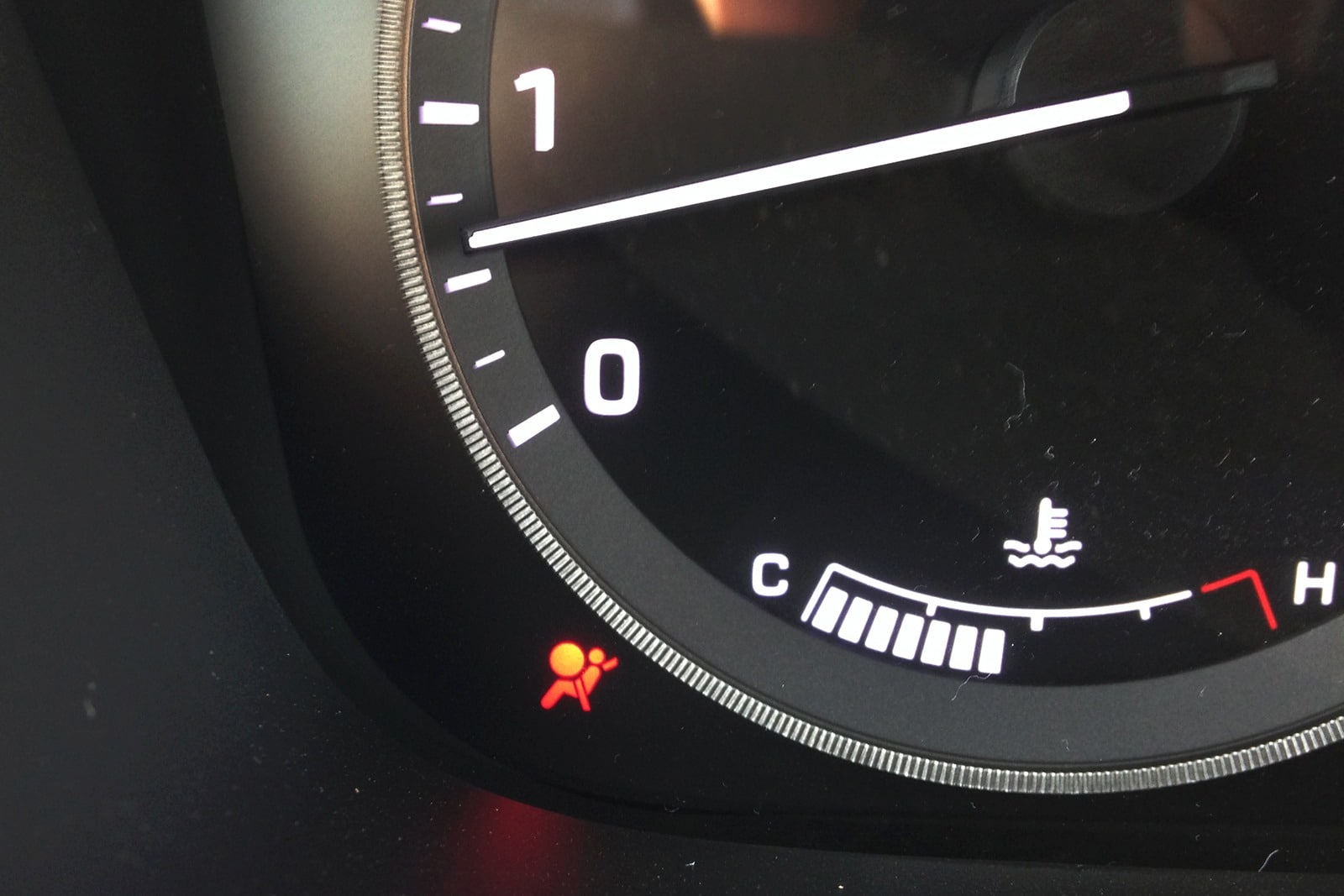
Not even 500 miles into our time with our new 2015 Hyundai Sonata and up jumps the airbag light. Boo.
Intuition tells us this is a simple fix, probably doesn't merit whipping on the car this early in the relationship. Don't want to come off too strong, especially given that early impressions of this car are quite good. Then again, don't want an airbag deploying in our face at highway speeds.
Off to the dealer to see what's going on.
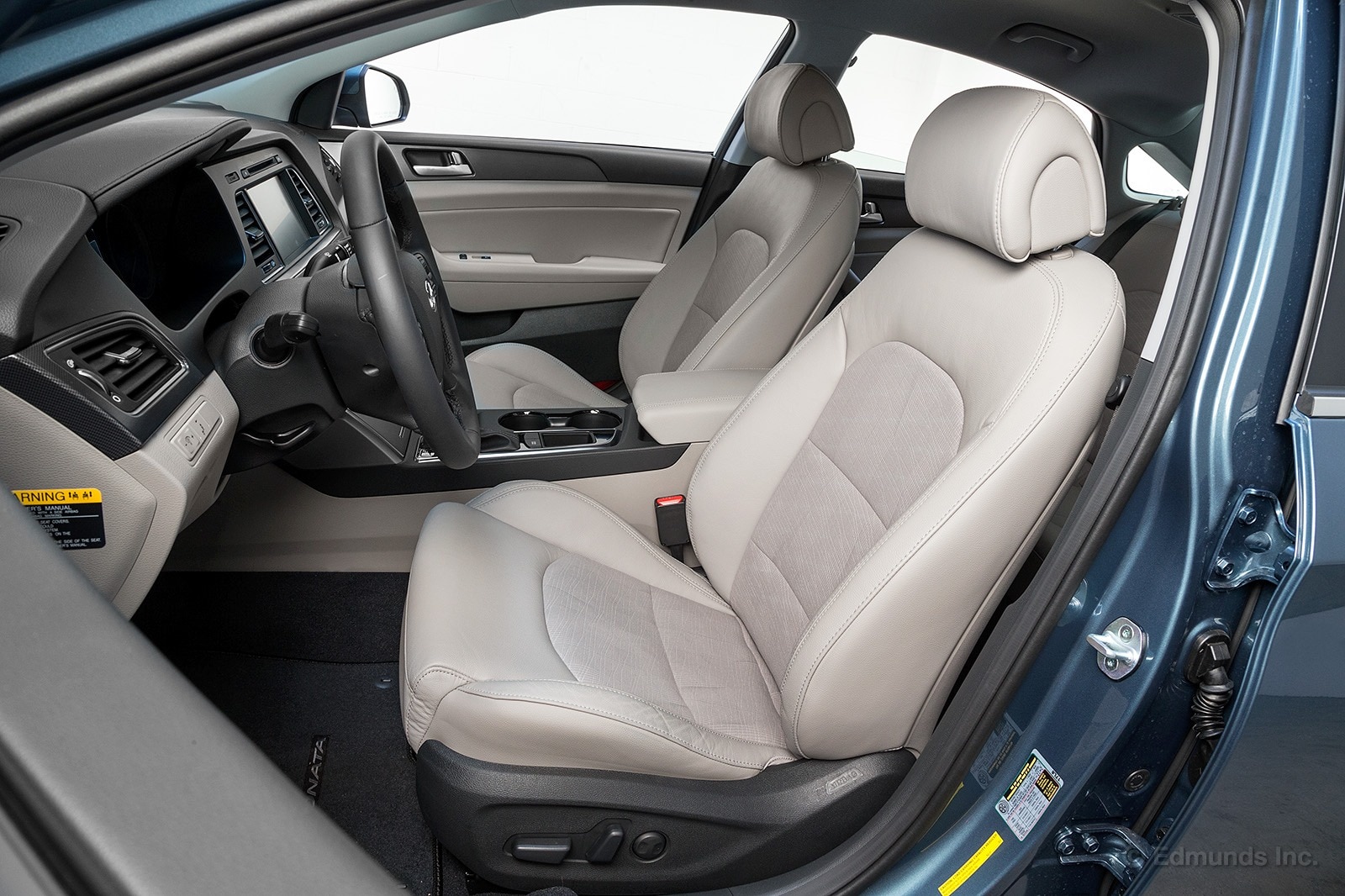
We haven't had our 2015 Hyundai Sonata for very long, but I've already managed to endure several multi-hour stints in the driver seat thanks to a sizable commute and typical L.A. traffic.
I'm glad to report the initial indications are good. The seat not only feels well designed in the first few miles, it still feels that way two hours later. Any new car seat should be comfortable to some degree, but designing a seat for a mainstream sedan that appeals to everybody often leads to a design that average across the board.
In our Sonata, the seat cushion is long enough to provide good thigh support and firm enough to remain supportive after the first hour has passed. The seatback isn't unique in any particular way unless you consider a combination of leather and cloth particularly novel.
It's worth noting that we have the optional sport seats that come with the Premium package. They add the "leather sport bolsters with cloth inserts" but I'm not sure if that's what makes them feel so good. We'll see how well they hold up over the rest of the year, but so far I'm liking the way they feel.
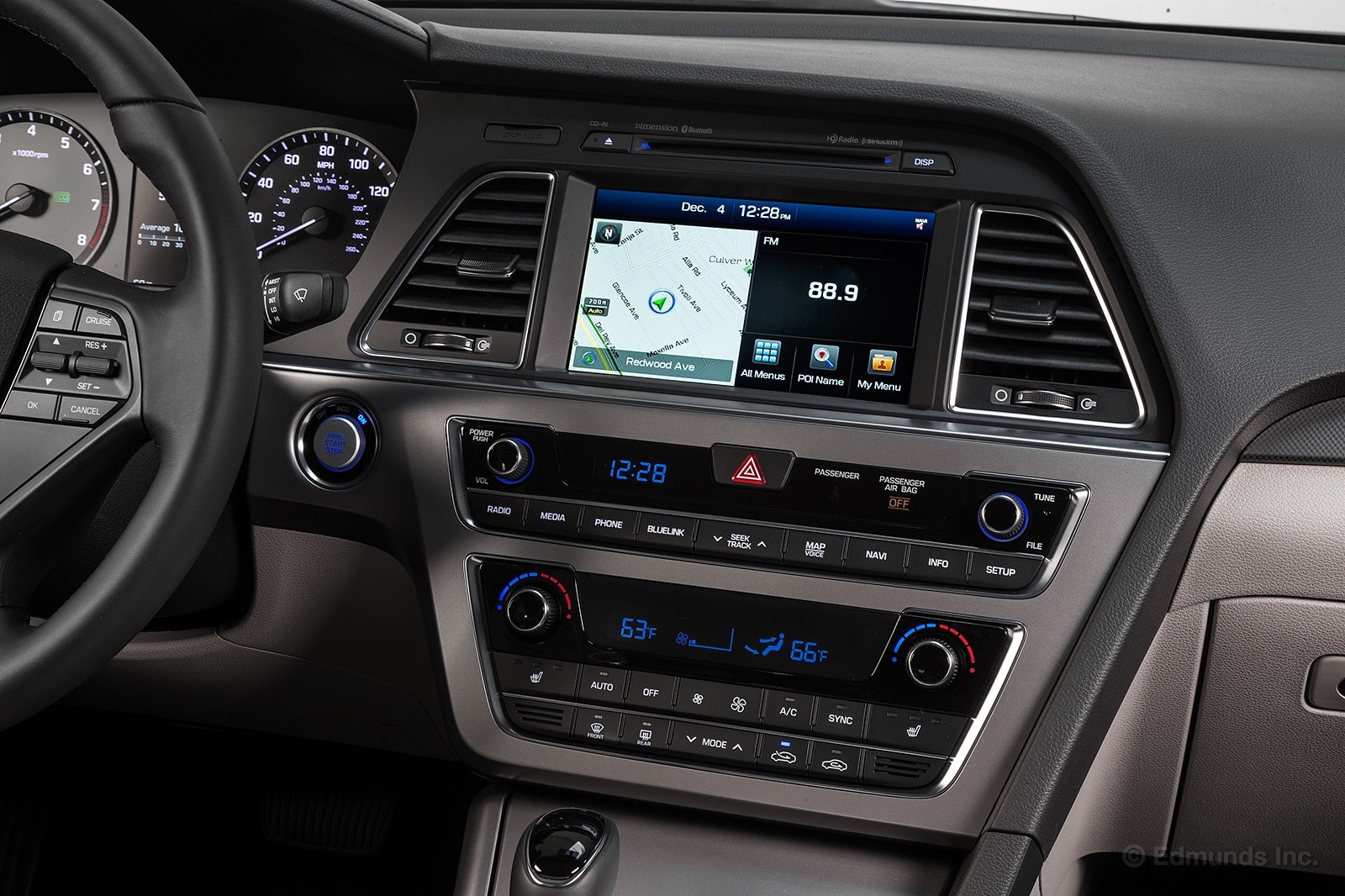
Our 2015 Hyundai Sonata might not earn many points for originality, but the design of its dashboard controls is as user-friendly as you're going to find in any sedan.
I liked the spacious, logical layout at first glance, and subsequent drives have only made me appreciate it more. The buttons are large, well-marked and have a solid feel to them. You can figure out any function at a glance and the navigation screen is crisp and clear.
I feel older than my 40 years giving the layout so many points for simplicity, but there are plenty of cars out there that try too hard when it comes to something as simple as the climate controls. This setup doesn't do that and yet it doesn't look half bad either. All that, and it includes just about every feature you could want. A great setup so far.
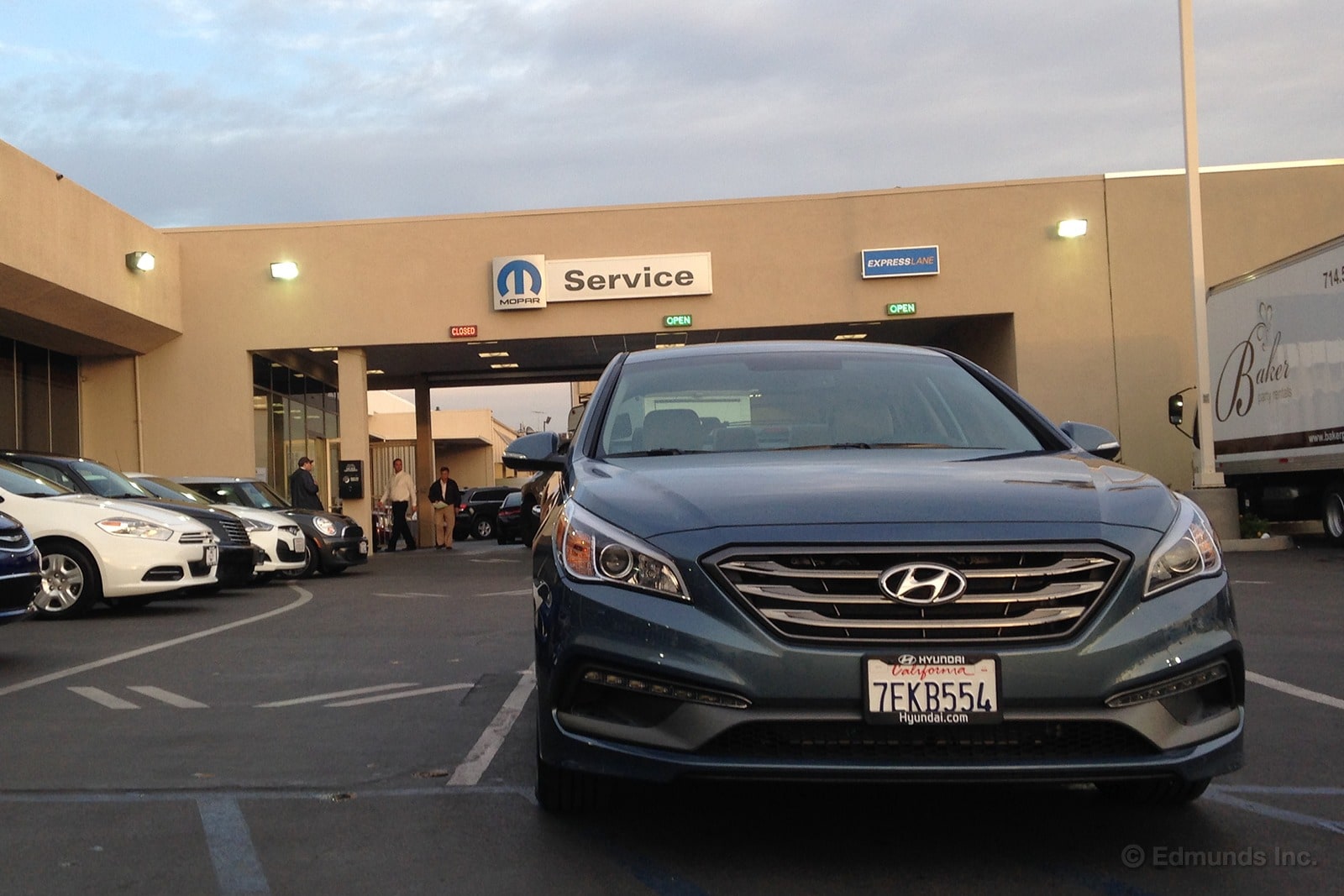
We've all been in relationships where the slightest lapse in communication or feedback results in a spiral of worry, doubt, confusion and dread. Your day got busy and you forgot to call. You didn't return a text within the allotted 60 seconds. Some offhanded comment was reinterpreted through many layers of psychoanalysis and next thing you know, you're sitting down for "a talk."
In most cases, there's no need to jump to conclusions. Sometimes we just get preoccupied. So it is with our new 2015 Hyundai Sonata. It flashed us an airbag light. Our younger, less-emotionally developed selves would have kicked in the gauge cluster and dislodged the side mirror with a Louisville Slugger.
These days, we just leave it with the dealer. We took our Sonata to Tuttle-Click Hyundai in Irvine in the morning. The Hyundai side is receiving a facelift, so we were directed around to the Chrysler service entrance. We were greeted by an exceptionally polite, helpful and talkative fellow who got us parked and connected with our service advisor, Anthony.
By mid-afternoon, Anthony called with the verdict: A front impact sensor had disconnected from its harness. The technician confirmed the sensor was working fine and that the fault was in the connection.
Tuttle-Click also updated our Sonata with the latest navigation update, checked our tire pressures and threw a little soap and water on it. We were back in the car by about 4:30 p.m.
Total cost: $0.
Total downtime: About six hours.
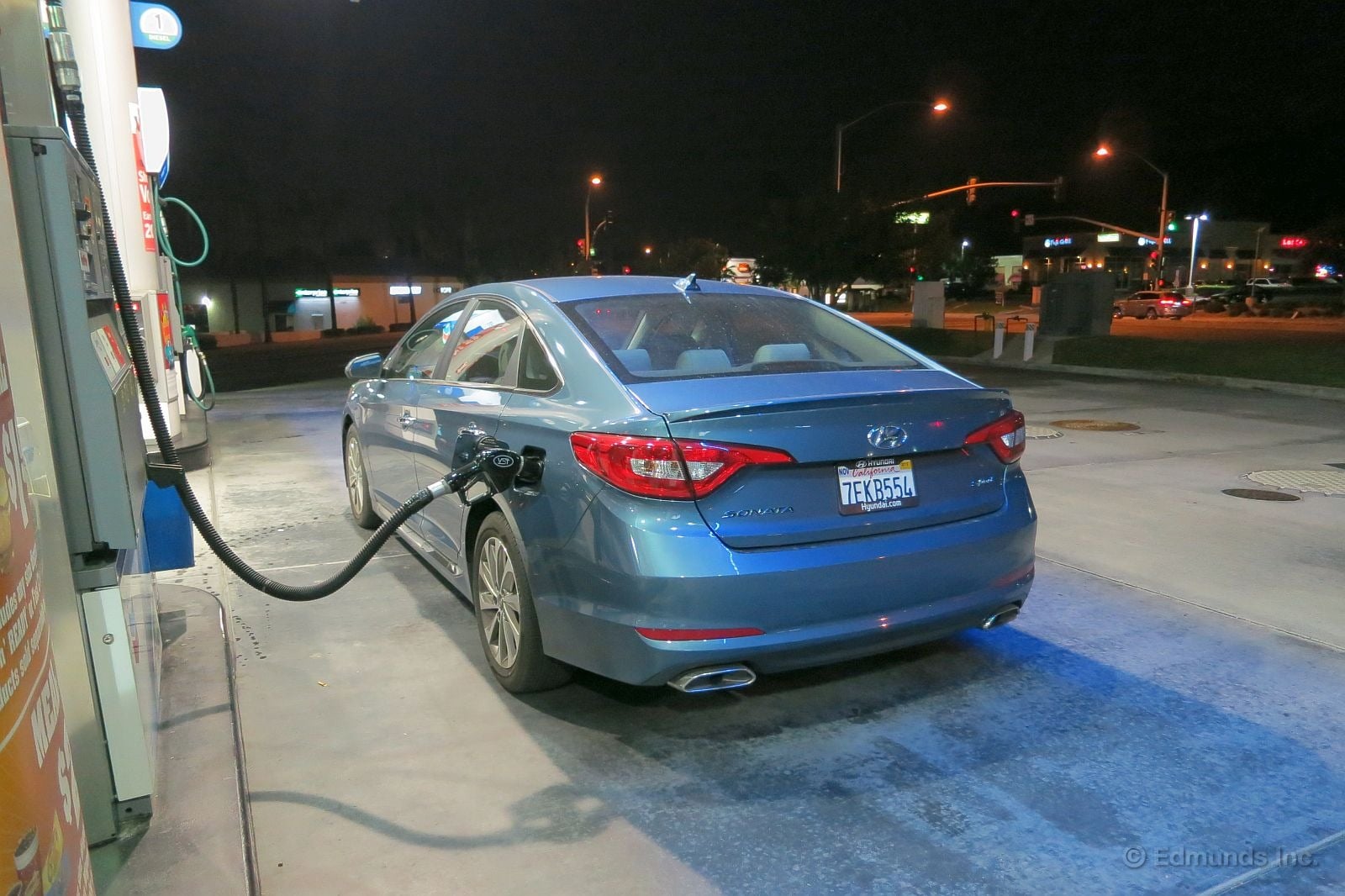
Our 2015 Hyundai Sonata Sport logged 1,824 miles in December, its first month of service in our fleet. It averaged 26.0 mpg for the month, a bit below its EPA rating of 28 mpg combined (24 city/35 highway).
Our best fill of the month was 31.7 mpg during a mostly highway road trip to Morro Bay, while our worst fill was 23.0 mpg. It achieved a best range of 370.4 miles, and that's likely to increase in upcoming months as editors experiment with how far they can run the Sonata's fuel tank down.
Worst Fill MPG: 23.0
Best Fill MPG: 31.7
Average Lifetime MPG: 26.0
EPA MPG Rating: 28 combined (24 city, 35 highway)
Best Range: 370.4
Current Odometer: 2,253 miles

"I think the seats in this 2015 Hyundai Sonata are what they call mottled," my friend said to me (I know, it's strange, but she quite often talks in a way that has her listing the year, make and model of the car I'm driving, almost as if she knows that later when I write my update I'll need to drop in a hyperlink).
"Modeled, what do you mean they're modeled," I asked?
"No, not modeled with a D, you dumbo, mottled with two Ts," she said.
This was followed by me stating that either a) "mottled" was not a word, or at least b) she was using it incorrectly. We settled on our usual $1 bet to see who was right. I've lost many a dollar to my friend. It's annoying.
To the dictionary we went (in truth it was an online version, since we were driving, but whatever). Turns out "mottled" is a word, and it's a pretty good choice for describing the seemingly random display of lines on the Sonata's seat fabric. This photo may not show it overly well, but the way certain sections of the stripes on the seat inserts are arranged makes it look like there are raised surfaces.
It's actually pretty neat that Hyundai put the extra effort in to make an interesting design out of, well, a seat.
And credit to my friend, as she's apparently not only more observant (I hadn't even noticed the odd striping), but also more of a wordsmith.
She has more money than me, too.
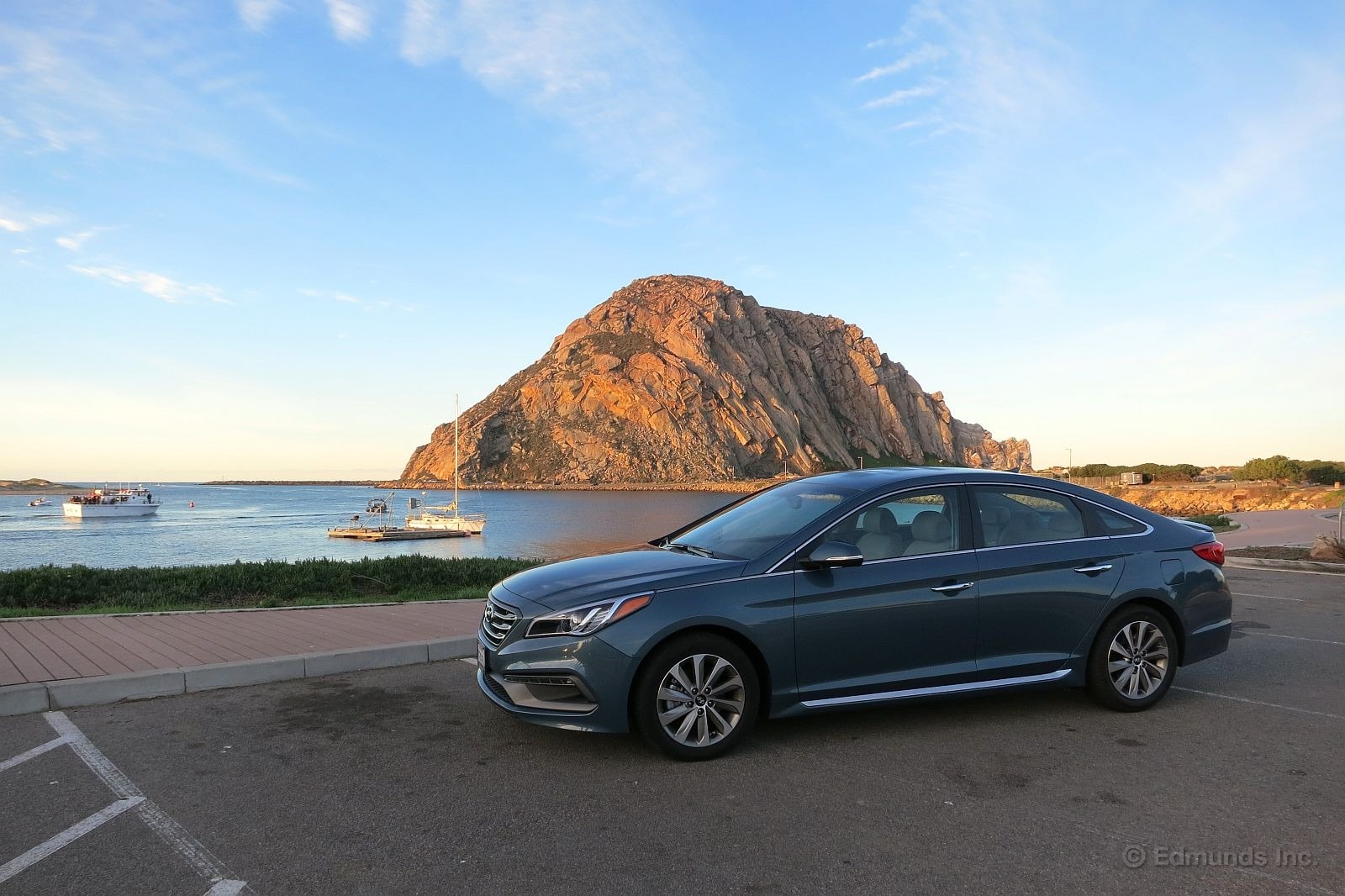
I used our long-term 2015 Hyundai Sonata Sport for a quick weekend trip to Morro Bay. This small California village is best known for Morro Rock, a nearly 600-foot-high volcanic plug. At least, that's what Wikipedia says it is.
To me, it's a giant rock with a small tourist trap disguised as a fishing village nearby. But it's a neat little town to visit, with some great restaurants and hotels and fun things to see and do. And this time of year it's not too crowded, and it was even blissfully chilly (into the 40s at night).
Our long-term Sonata Sport with its 185-horsepower 2.4-liter four-cylinder did well on the trip. This naturally aspirated engine isn't brimming with power, but it does okay in most situations.

Only on a couple of occasions when I was trying to get around a slower car did I realize, "whoa, I'm nearly at full-throttle." I figured it was more like half.
Overall, though, the Sonata is a good highway traveler. The front seats are comfy, the leather steering wheel gives a good grip, wind and tire noise are well suppressed and the suspension is able to keep all but the biggest hits out of the cabin.
The only real problem I had with the Sonata was that the smooth-shifting six-speed automatic transmission can at times be too responsive. It has a wantonness to downshift a gear at speed on the highway pretty much anytime you even just gently add more throttle. I'd prefer the transmission let the engine tap into its 178 pound-feet of torque a bit, or at least wait until I give it a sturdier prod.
The result of this overly responsive behavior is more up-and-down shifting action than seems needed. But in pretty much all other areas, this new Hyundai Sonata is quite a good car.
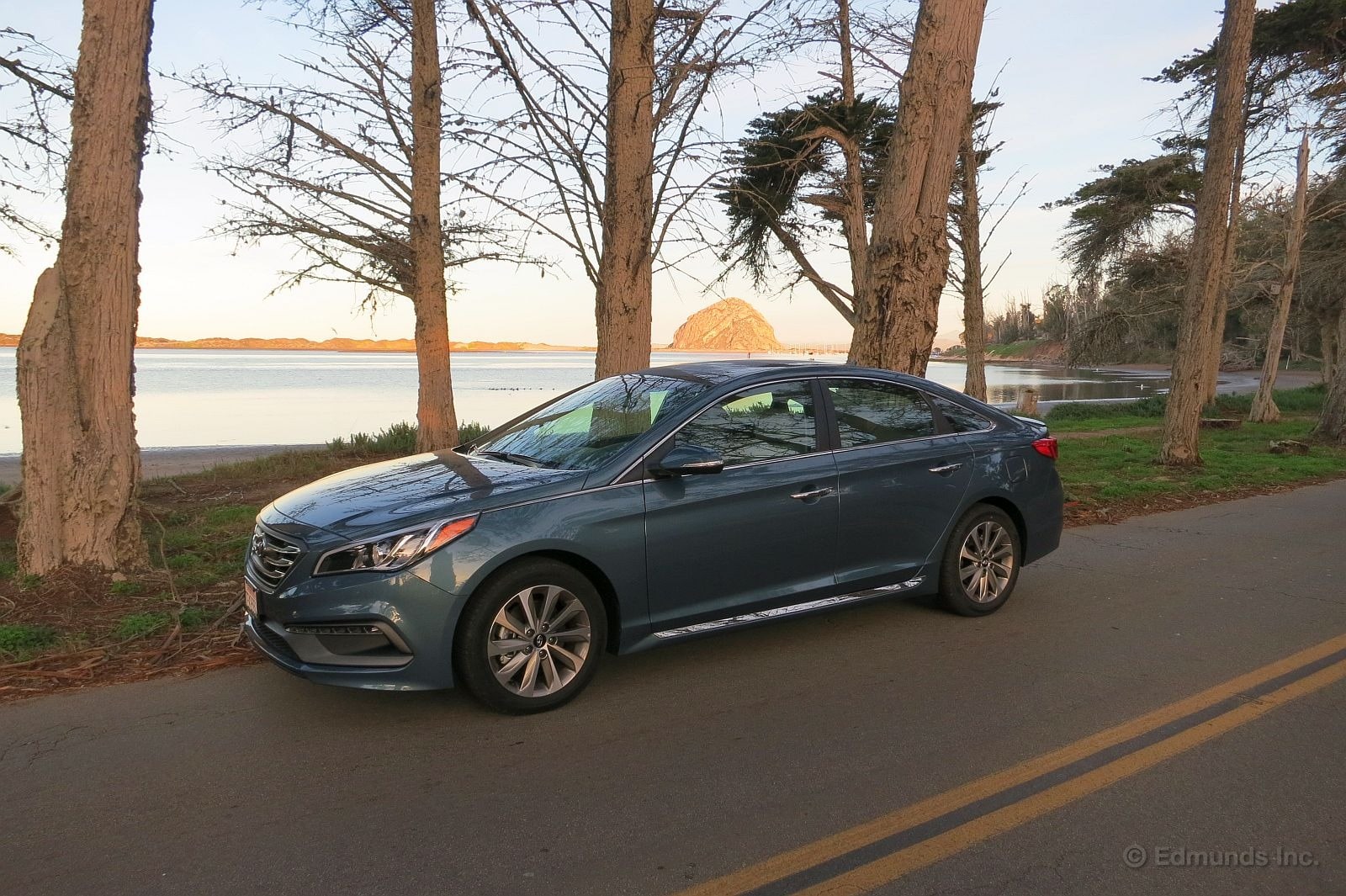
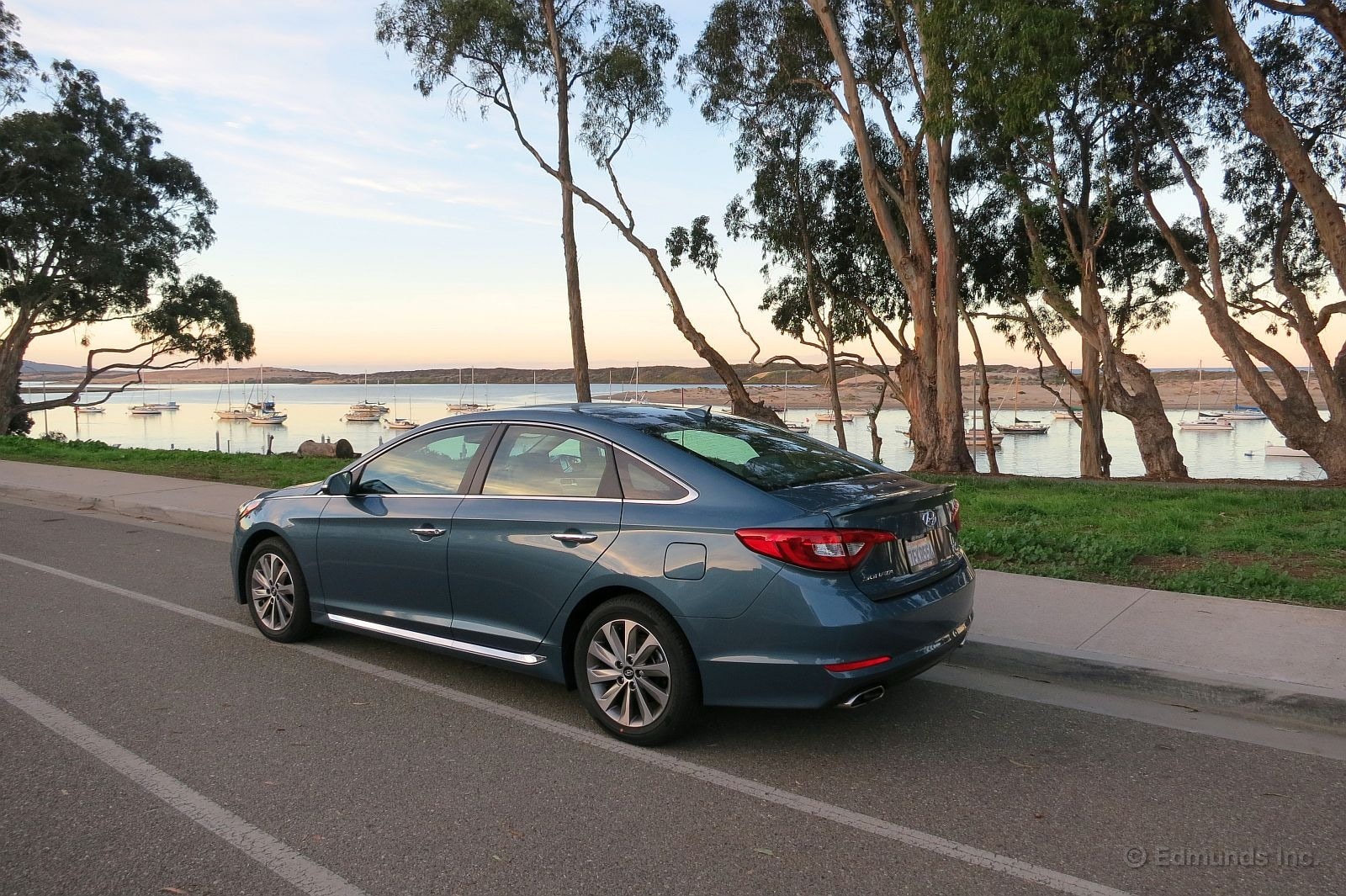
Picking up from where we left off in Road Trip to the Rock, Part 1, the trip back from Morro Bay, California to Orange County in the 2015 Hyundai Sonata Sport went smoothly.
Sunday traffic was pretty light, partially in thanks to a reasonably early start time. The lack of stop-and-go no doubt helped the Sonata's fuel economy numbers. The 31.3 mpg we achieved for this almost-entirely highway trip was a bit off the EPA's 35 mpg highway estimate for the Sonata Sport. There was a very minor bit of puttering around town.
Data from the trip:
Total roundtrip miles: 512
Actual trip mpg: 31.3
Onboard indicated trip mpg: 34.2
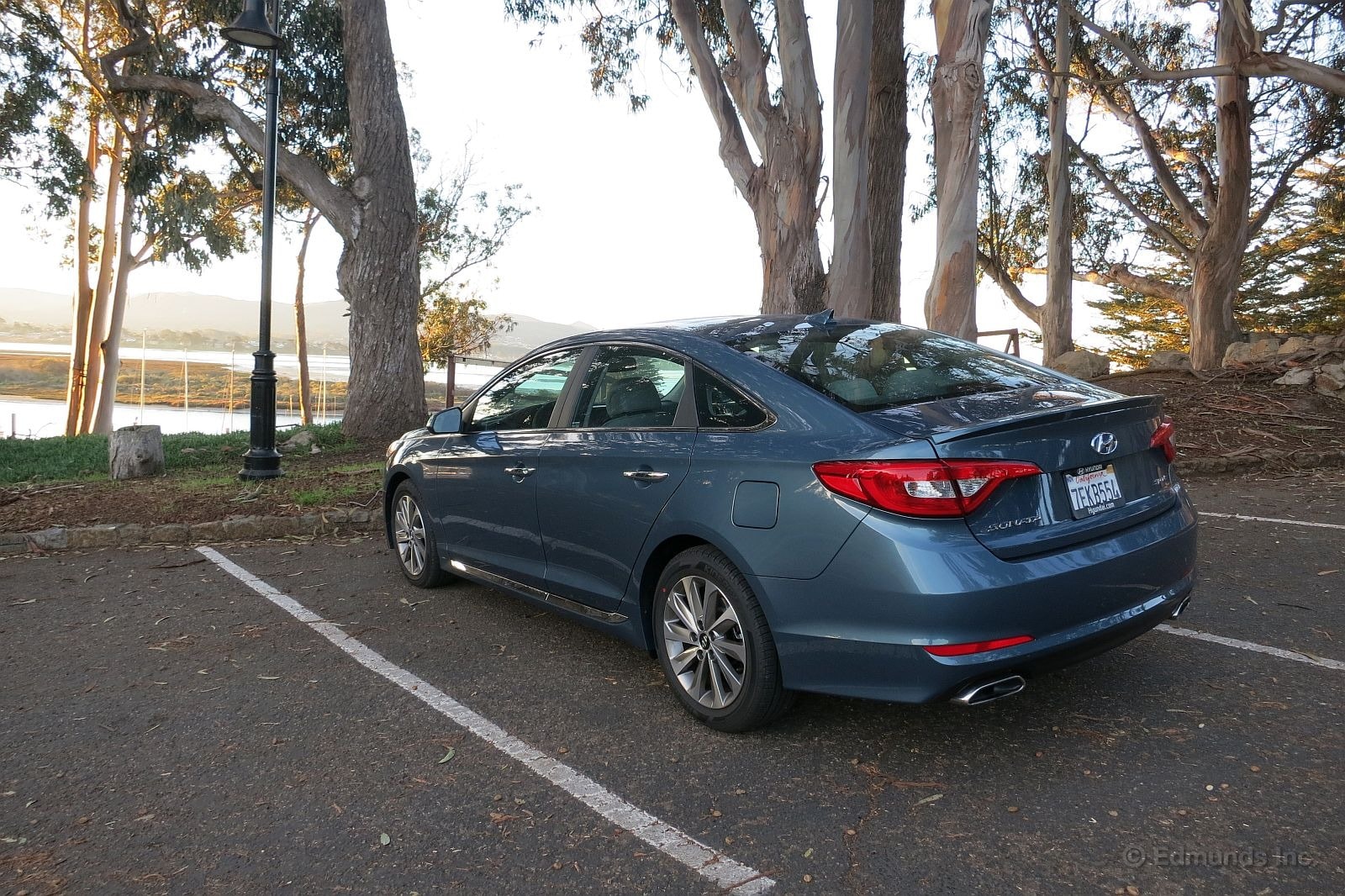
Morro Bay has a quaint, fishing village vibe to it.

These little guys, just floating around on their backs, are sea otters. Call me lazy, but that looks like a pretty good life. Of note, there are two young ones in there. One is fully camped out on top of mom's stomach, the other is resting his/her head on mom.

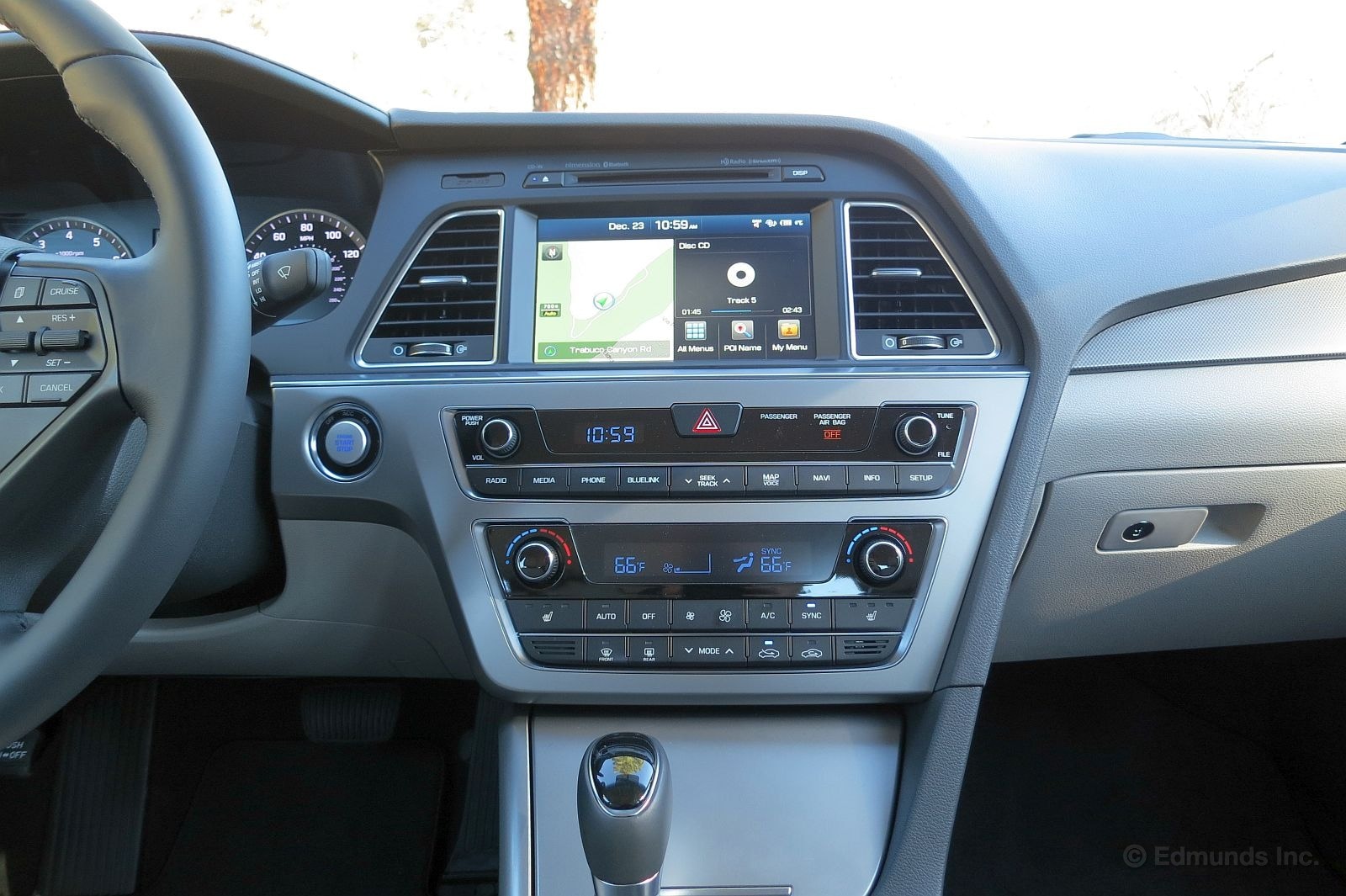
The center stack/dash vent combo in the 2015 Hyundai Sonata is different than most we're seeing these days. How so? Well, first off, it's rather simple in its design and layout. It's a huge, flat surface with plenty of large buttons, along with knobs for controls that deserve knobs. Like for stereo volume and tuning.
It's also not perfectly symmetrical, as the central screen and center stack controls don't perfectly line up, and the left-side vent is offset as well. Not a problem in the least, just an observation.
The nice thing about "simple" is that it means everything is easy to learn and use in this Sonata. The only gripe I have so far with this setup is that the detents for the temp control knobs aren't quite detent-ful (new word) enough. Meaning, it's easy to move a temp knob two or three clicks when you're just trying to go one.
Other than that, I really like this simple and clean arrangement.
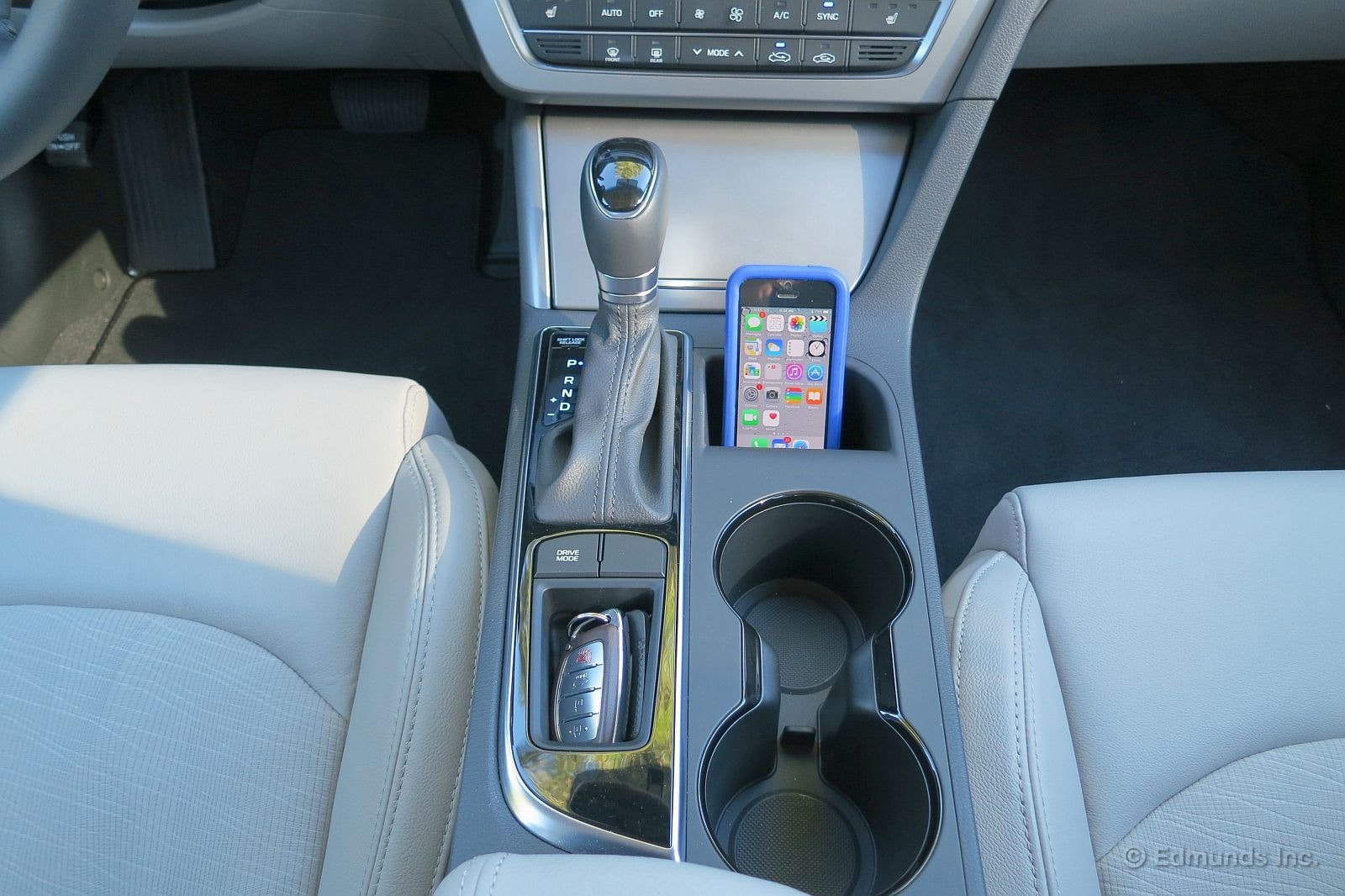
I like the thought that was put into small-item storage in the 2015 Hyundai Sonata. For instance the front bin, where the USB port and your music device reside, has a handy security door to keep things hidden when you're not in the car.
There's also a cubby that's decent at holding cell phones in place ahead of the cupholders. A lot of us end up using cupholders as cell phone holders during transit, so it's nice to have a different, more effective spot for them.
Judging by how perfectly suited the slot is to the left of the cupholders at holding the key fob, Hyundai must have recognized that some folks don't like the key in their pocket while driving.
Well done, Hyundai.
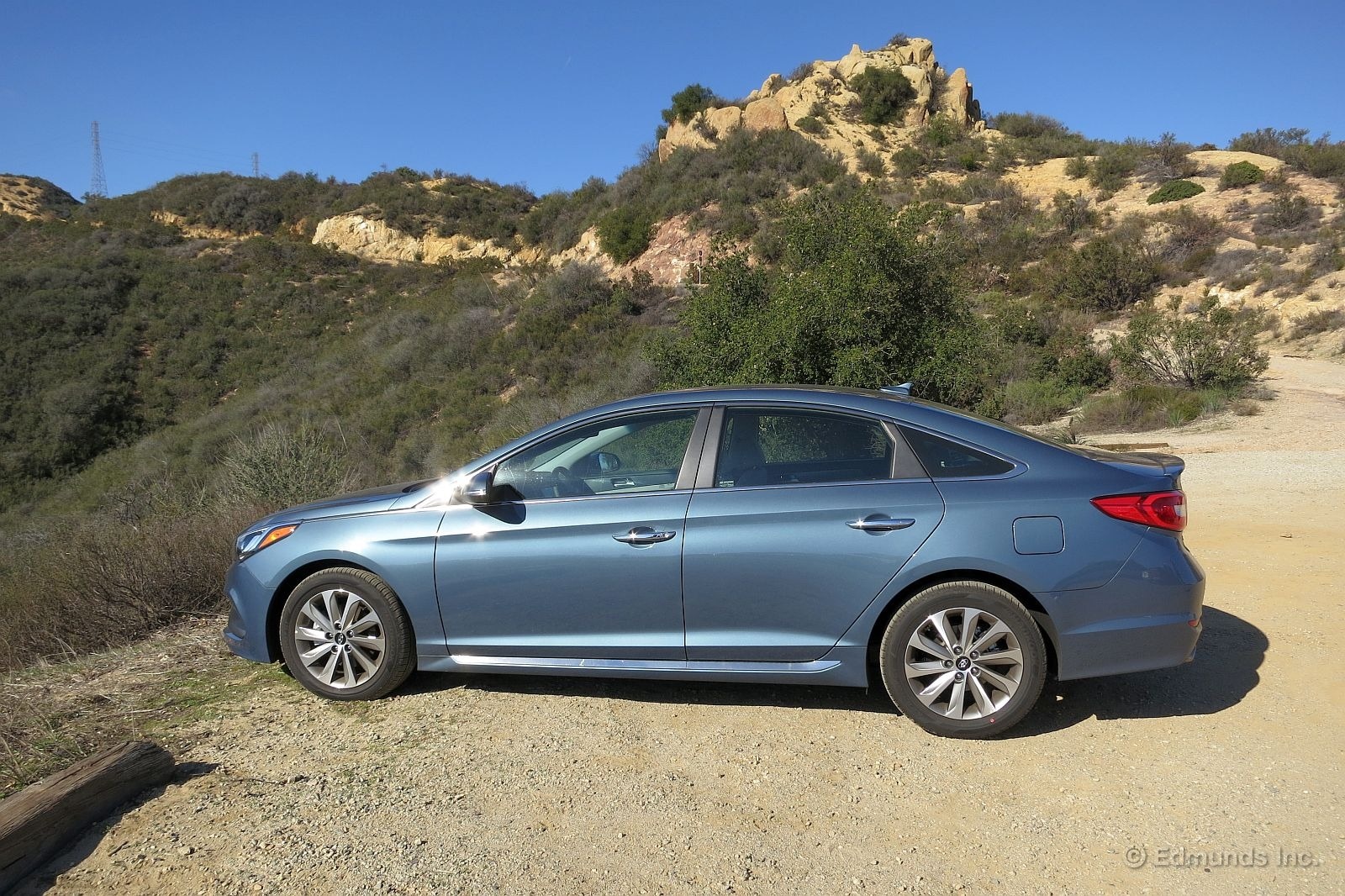
I'm not going to lie to you. When I realized our 2015 Hyundai Sonata was not the Eco model, I was a little bit bummed. "We got the wrong car," I thought to myself.
The reason I thought this was because we had a short-term Sonata Eco test car in here a little while ago and it actually outperformed the more powerful 2.0T Sonata (which has an extra 68 horsepower over the Eco!) in a straight line, the Eco hitting 60 mph in 7.5 seconds, the 2.0T in 8.3. That surprised us, but then the Eco is the only Sonata with the new quick-shifting dual-clutch seven-speed transmission, and that 1.6 turbo is a lively little piece.
My point is, I wasn't expecting much the first time I drove our Sonata Sport, with its 185-horsepower 2.4-liter naturally aspirated four-cylinder. This is the drivetrain we're thinking will be the volume seller for the Sonata. Boredom was what I was thinking was in store for me.
But then I drove it. And you know what? It's a pretty nice car. Quiet, smooth riding, super comfortable front seats and a well-thought-out interior. The four-cylinder has just enough power so it doesn't feel underpowered, and the traditional six-speed automatic transmission doesn't have any of the low-speed lurching we keep coming across these days. The throttle pedal isn't overly abrupt, either.
So could the Eco model be better? It's possible. We'd need to spend more time with one to know for sure. But what I can tell you right now is that this Sonata Sport is a damn good car.
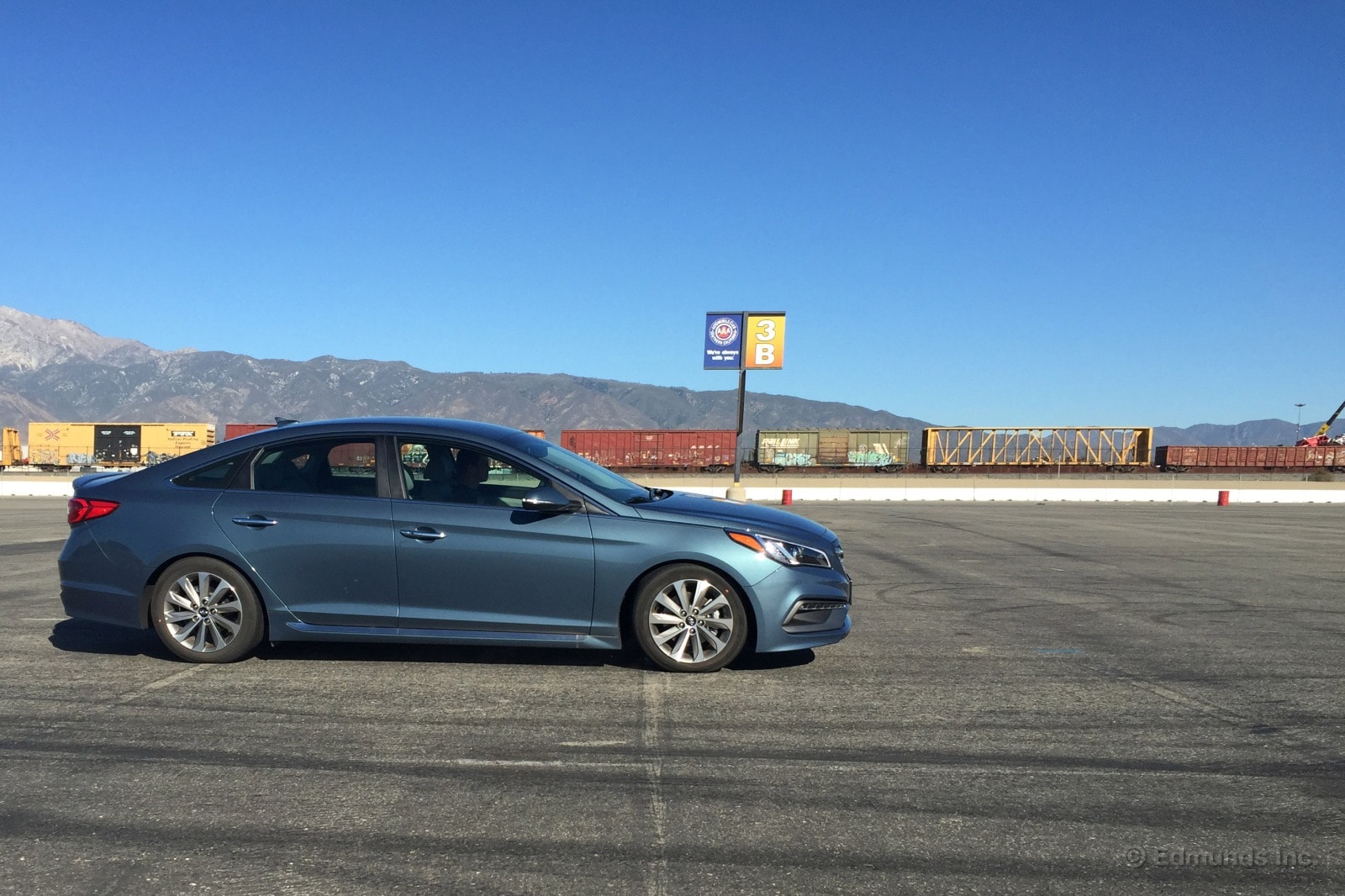
We took our 2015 Hyundai Sonata to the test track to collect some performance data.
It's not the Eco as Monty mentioned. We opted for the Sport trim which adds a sport grille, sport door chrome molding, sport turn indicators on the side mirrors, sport touchscreen audio display, and sport automatic headlight control. But will it be sporty at the track?
Read on to find out.
Vehicle: 2015 Hyundai Sonata Sport
Odometer: 2,438
Date: 1/6/2015
Driver: Chris Walton
Price: $27,560
Specifications:
Drive Type: Front-wheel drive
Transmission Type: 6-speed automatic
Engine Type: Naturally aspirated inline-4
Displacement (cc/cu-in): 2,359 / 144
Redline (rpm): 7,000
Horsepower (hp @ rpm): 185 @ 6,000
Torque (lb-ft @ rpm): 178 @ 4,000
Brake Type (front): One piece ventilated disc with single-piston sliding calipers
Brake Type (rear): One piece solid disc with single-piston sliding calipers
Suspension Type (front): MacPherson strut with anti-roll bar
Suspension Type (rear): Independent multilink with coil springs and anti-roll bar
Tire Size (front): 215/55R17 94V M+S
Tire Size (rear): 215/55R17 94V M+S
Tire Brand: Hankook
Tire Model: Kinergy GT
Tire Type: All-season
As Tested Curb Weight (lb): 3,362
Test Results:
Acceleration:
0-30 (sec): 3.2 (w/ TC on 3.4)
0-45 (sec): 5.3 (w/ TC on 5.7)
0-60 (sec): 8.2 (w/TC on 8.6)
0-60 with 1-ft Rollout (sec): 7.9 (w/TC on 8.3)
0-75 (sec): 12.5 (w/TC on 12.9)
1/4-Mile (sec @ mph): 16.2 @ 86.5 (w/TC on 16.4 @ 86.0)
Braking:
30-0 (ft): 30
60-0 (ft): 119
Handling:
Slalom (mph): 65.1 (64.0 w/ESC on)
Skid Pad Lateral acceleration (g): 0.86 (0.86 w/ESC on)
RPM @ 70: 2,000
Comments:
Acceleration comments: Even with traction control disabled, the Sonata 2.4L Sport cannot manage to get any wheelspin whatsoever. Upshifts are smooth and reasonably quick. In manual-shift mode, the engine reaches indicated redline and auto-upshifts. Very little acceleration difference between Normal and Sport mode (in this test), but in normal driving Sport delays upshifts at part throttle and makes noticeable downshifts while braking. Power is linear and modest, but produces competitive acceleration to its peers. There are no shift paddles, but a manual shift gate is available on the console shifter, where knocking the shifter toward the driver (good) engages it, but upshift = push forward and downshift = pull back (not our preferred orientation).
Braking comments: Medium-firm brake pedal from first to last stop. Very little dive, excellent straight-line stability and little ABS commotion from the brake system or the tires. Negligible distance increase with additional runs, and pedal feel and poise remained. The Sonata manages shorter stops than some similar 'base' cars in its segment.
Handling comments: Like the rest of the Sonata lineup, this is the kind of car that inspires confidence in the rapid transitions of the slalom, but rewards prudence. Sure, the electronic stability control (ESC) system is sophisticated and makes subtle corrections and recedes once it's satisfied. However, if pushed beyond the limit of the chassis (rather than the tires), it can get a little loose at the rear of the car. Commendable grip and poise on the skidpad with the grip going away nearly simultaneously front/rear, but with a slight bias at the front. Steering response is good, weight feels artificial, precision is good, and while it has more "feel" than the previous generation Sonata, it is still rather numb.
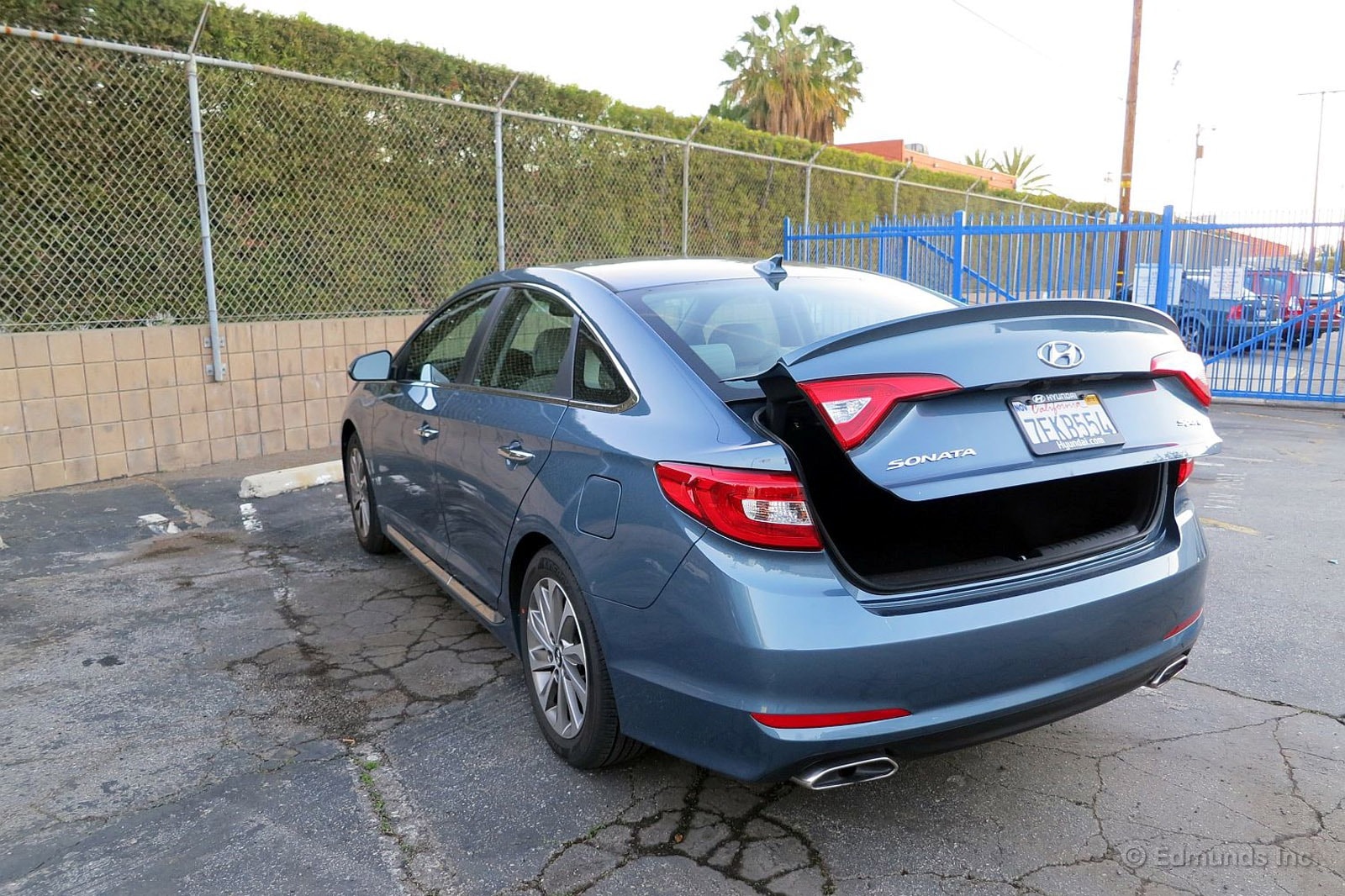
I was reading through the Monroney (or window sticker) of our long-term 2015 Hyundai Sonata Sport and noticed that, as part of the $1,700 Premium package, our car has a Hands-Free Smart Trunk Opener.
I asked Road Test Assistant Cameron Rogers if he knew anything about this. Not because he's our resident Hyundai Sonata expert or anything, but rather because he was the nearest person to me at the time.
"Nope," he said. "Let's go find out."
Off to the Edmunds parking garage we went.
I had used what I figured to be a similar system during a Hyundai Genesis press drive once, and was pretty sure all we had to do was walk up to the rear of the car with key fob in pocket and, voila, the trunk would open.
Nothing happened.
After a few variations of unlocking, locking, walking away, walking back and then standing behind the car like a couple of stooges (which we're quite good at, incidentally), we gave in and read the dang owner's manual. Turns out the Smart Trunk system needs to be activated, which we clearly hadn't done.
While Cam sifted through the car's Settings Mode to turn the hands-free system on, I checked my Facebook notifications to see if anyone had "liked" any of my recent posts. I pretty much can't function without near-constant affirmation that everyone loves me, as well as anything I post online.
With the system all set up, we once again locked the Sonata, walked away, waited 15 seconds, then walked to the back of the car and waited a couple seconds. You know the system is working when the hazard lights flash four times while a chime goes off, and then the trunk magically pops open on its own.
But the trunk just barely cracked open. So if you had both hands full of groceries, you'd need to give it a good "knee" or something to open it enough to put anything inside.
The next day when I did the same thing for the purpose of taking photos, wouldn't you know it, the trunk opened significantly further, to what you see in the above photo. Instead of a knee, a minor elbow nudge should open it the rest of the way. It certainly opened enough to get the job done.
What was weird was that both times the car was parked on level ground, so I'm not sure why it opened different amounts. Maybe the trunk is breaking-in with use and eventually it will open all the way when the hands-free is activated.
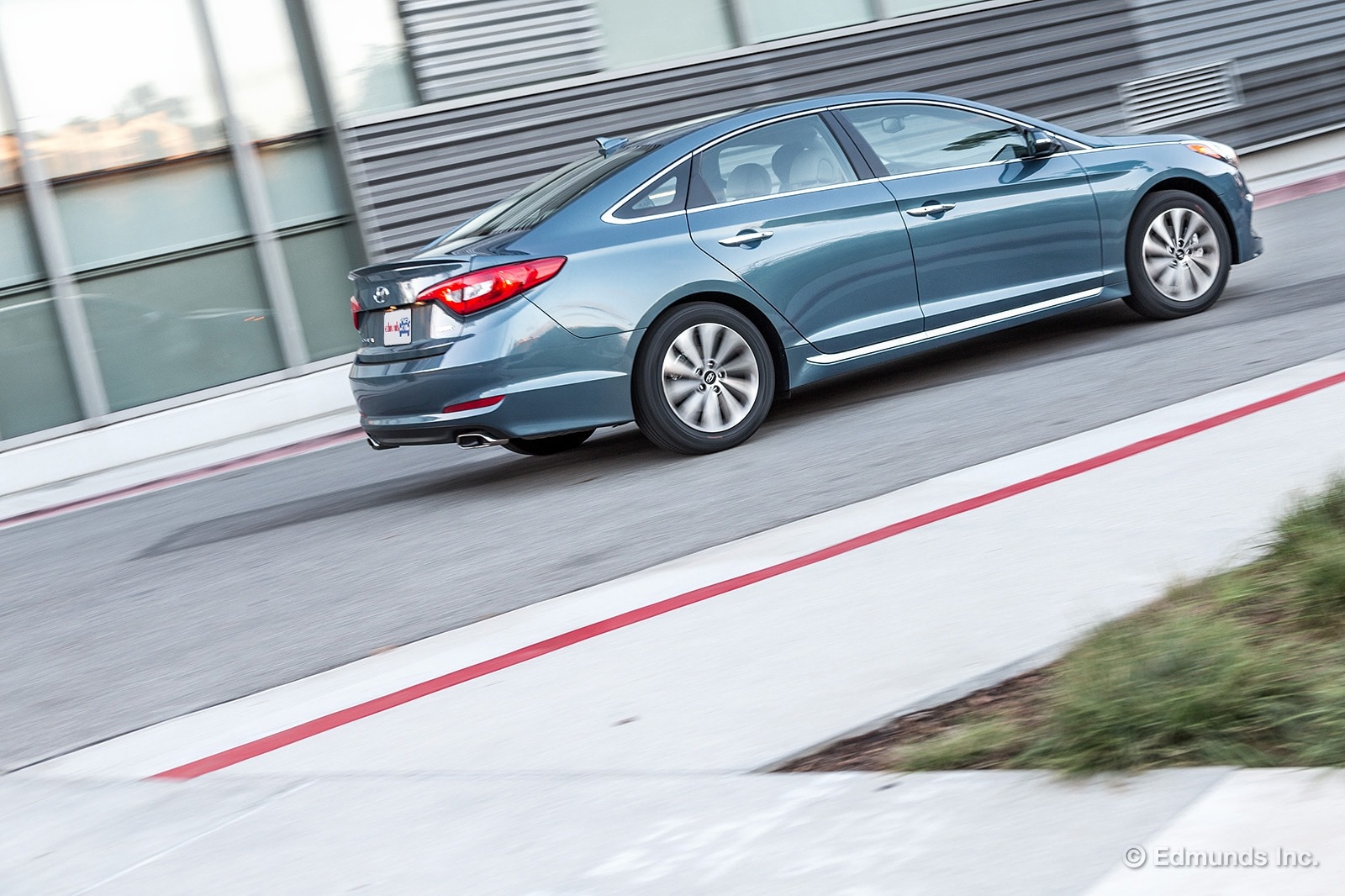
January was an active month for our long-term 2015 Hyundai Sonata. We drove it for 1,373 miles and gave the Sonata its first track-test and evaluated it on our standard ratings loop.
Testing at the track earned it 12.0 mpg, but I'm not counting that as a usual fill-up. It was 3 gallons of extreme driving.
For the month of January we averaged 24.3 mpg, slightly better than the EPA estimate for city driving.
We brought its lifetime average down a bit this month from 26.0 to 25.2 mpg.
Worst Fill MPG: 19.3
Best Fill MPG: 31.7
Average Lifetime MPG: 25.2
EPA MPG Rating: 28 combined (24 city/35 highway)
Best Range: 370.4
Current Odometer: 3,625 miles

As you can see, the lights on our 2015 Hyundai Sonata aren't aimed quite right. Well, maybe you can't see from this particular photo, but the driver's side beam is off to the right and a little high, while the passenger side beam is slightly off to the right and a little low.
It's not nearly as bad as the lights on our Hyundai Santa Fe were for most of its time with us, but it's enough that I would take the time to give them a slight adjustment. If I could that is.
After checking the owner's manual it appears as though there is no way for owners to do this job themselves. According to the manual, any aiming of the headlights should be done by an authorized Hyundai dealer.
At that point I didn't bother to see if I could find some adjustment screws and do it myself. I suspect that it's not quite as simple as turning a couple of screws. It's the price you pay for having fancy headlights.
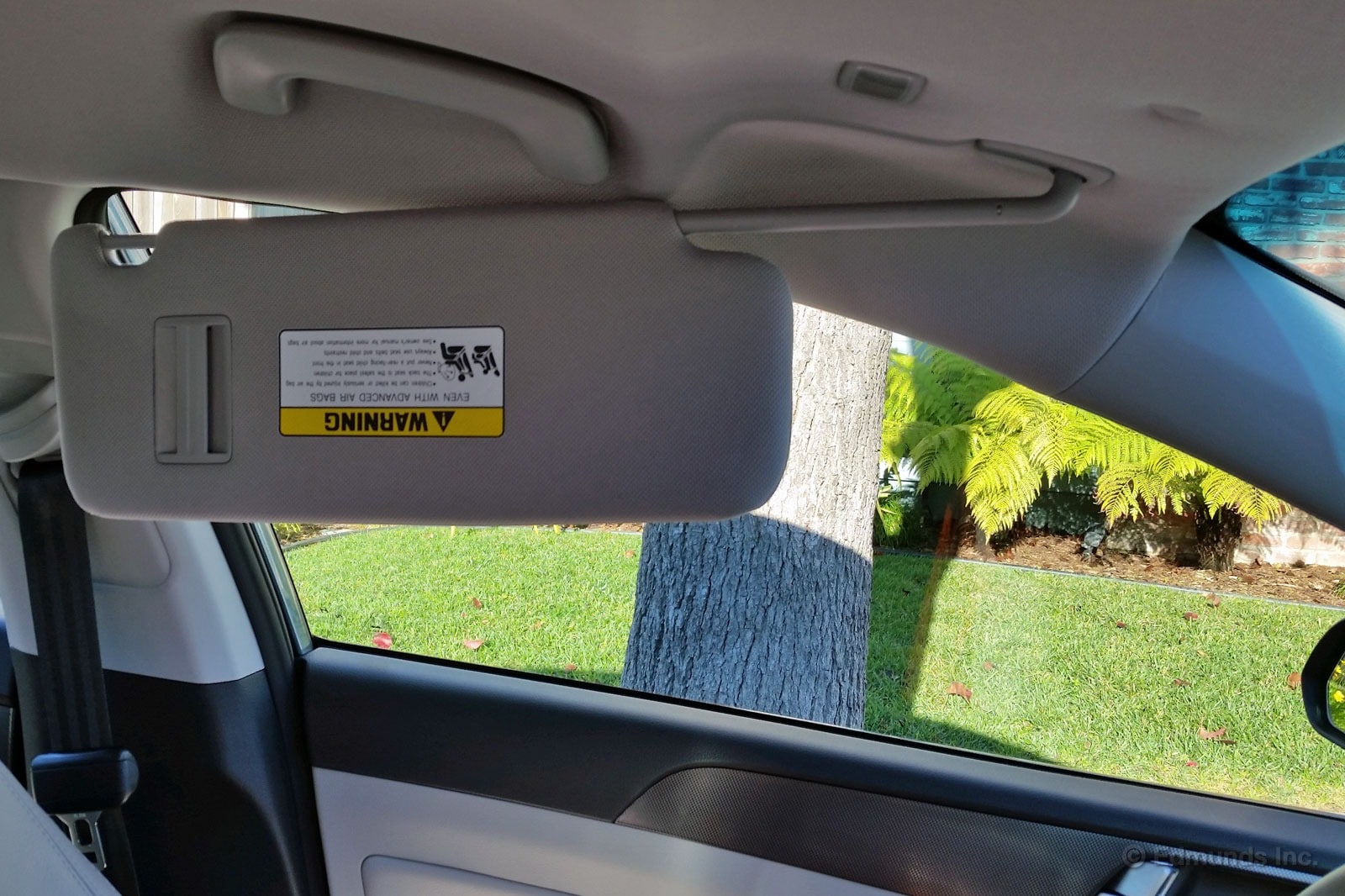
It was a super bright sunny morning in Southern California, and as I was headed into the office, I was grateful to find our 2015 Hyundai Sonata has sliding sun visors.
Some cars have the two-part extendable visors, allowing drivers and passengers to cover the entire side window. But I found the Sonata's sliding visor was more than adequate in blocking out the light from the side.
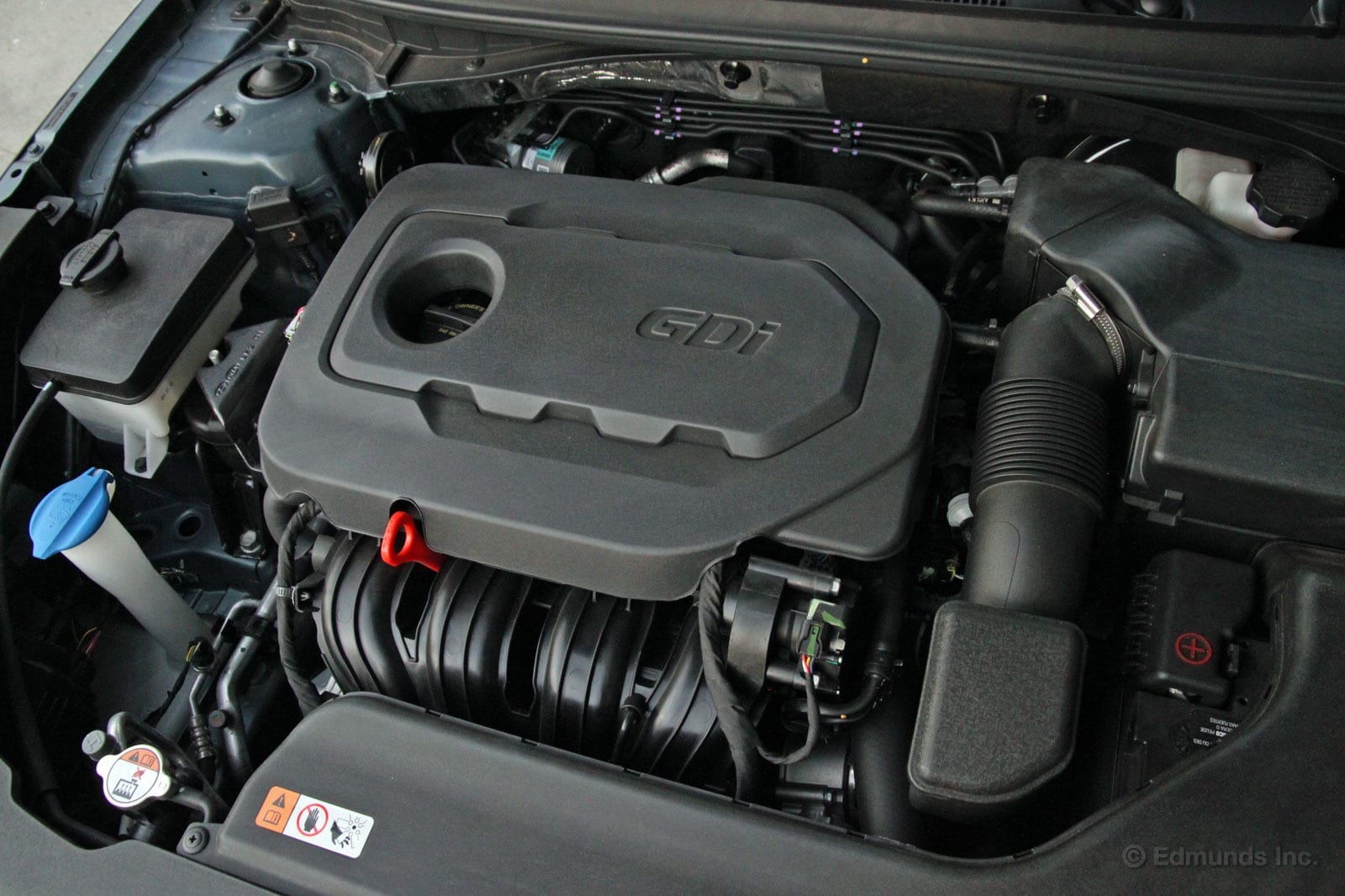
Look past all those plastic parts on the engine in our 2015 Hyundai Sonata and you'll find a very refined four-cylinder power plant. Whether you're wringing it out while getting on the highway or just cruising around town, the 2.4-liter engine sounds and feels well suited to this sedan.
I like the responsiveness of the throttle and the six-speed automatic does a good job of getting the most of its 185-horsepower. That said, this is not a fast car by any means. Thankfully, it's not dreadfully slow either. You can make passes on the highway in a reasonable amount of time and if you want to gutter ball someone at a light it will do that too.
So far its mileage numbers haven't lived up to its rating, but it's still early. I suspect this engine will get pretty close to its claimed numbers once we get some additional miles on the clock.
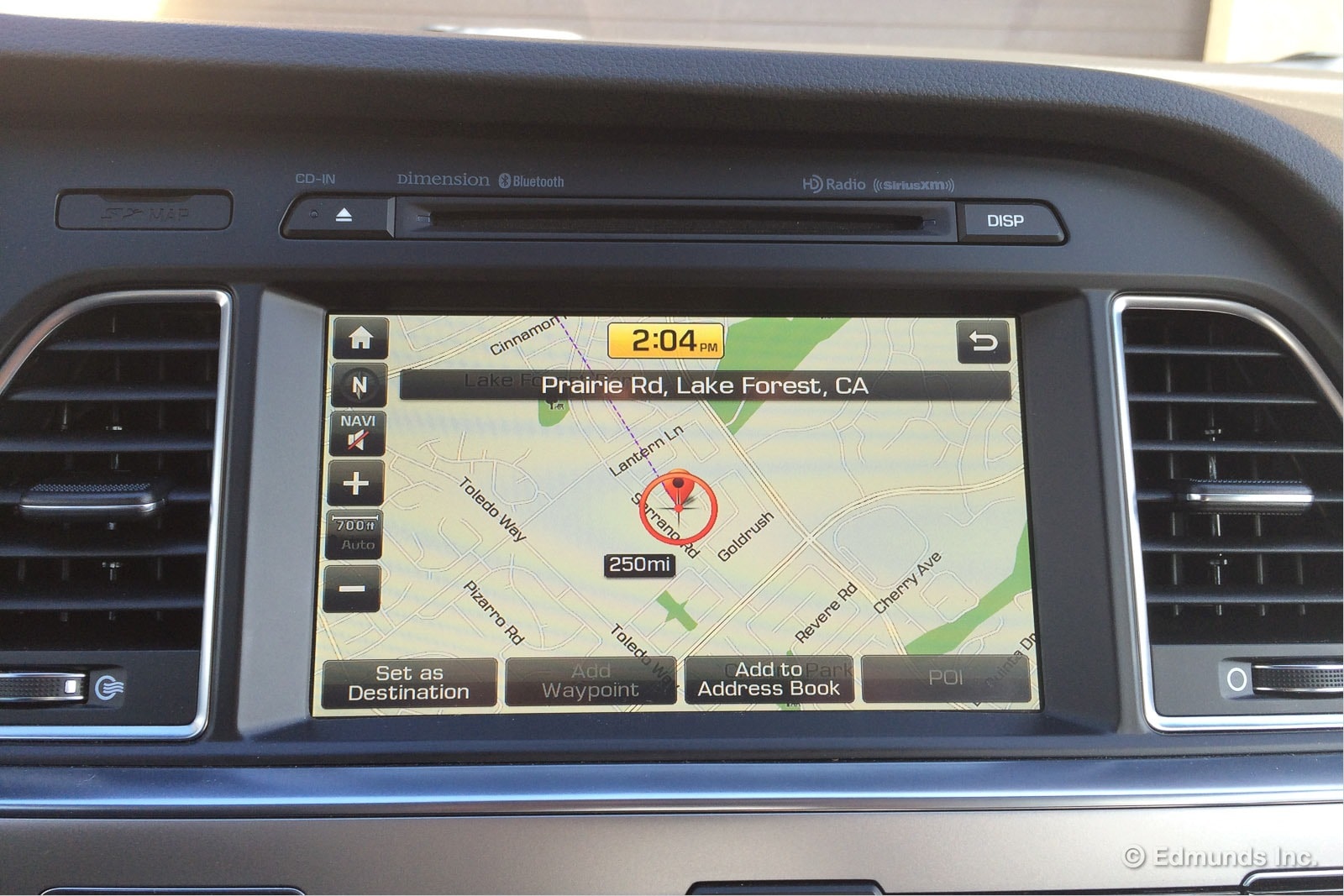
Our 2015 Hyundai Sonata is equipped with the optional navigation system and 8-inch touchscreen display. A couple of my coworkers have written some updates on how they like the center stack control layout (here and here), so I thought I'd follow up with some specific commentary on the Sonata's latest touchscreen.
The touchscreen's menus and general operation are similar to the system we had in our 2013 Hyundai Santa Fe. The screen has high-resolution graphics that result in crisp fonts, detailed maps and a useful view from the rearview camera. It responds quickly to your touch inputs and has hard buttons below the screen for shortcuts to the main system operations such as radio, media and navigation.
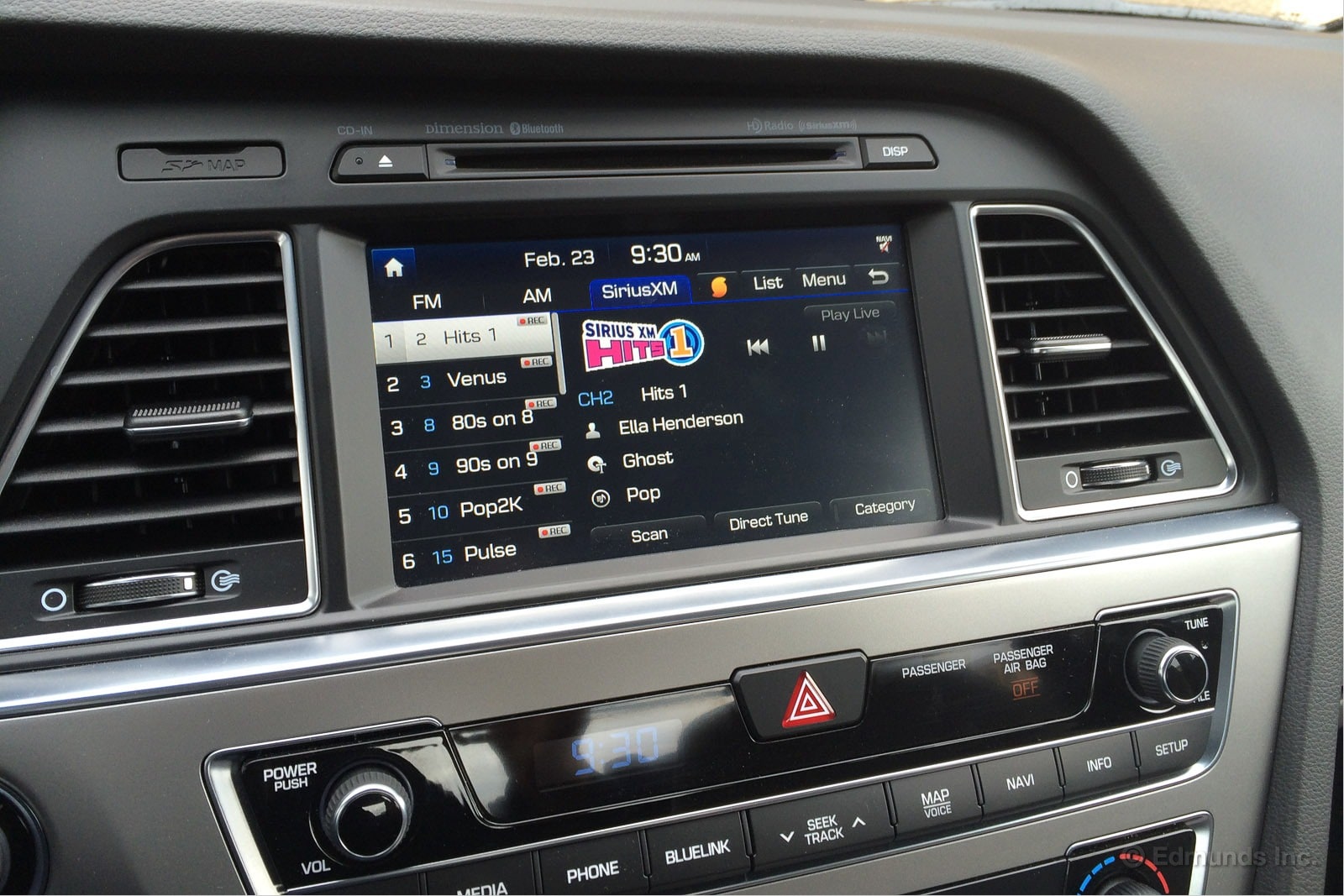
I noticed some differences with this latest system, though. The radio presets, for instance, are displayed in a left-hand column that shows six presets at a time. To get to the next set of six, you swipe your finger down or up. It originally took me a moment to figure out how that worked, but after that it's been easy to do. There also seems to be some new smartphone app integration functionality. I haven't used any of it yet, though, so I'll leave that topic for a future update.
There is one aspect I'm not fond of. Even with my outstretched right arm, the Sonata's screen is still positioned a few inches away from my fingertips. I have to stretch and/or lean forward to press or do anything on the touchscreen. I've talked to other drivers on our team who have driven the Sonata. They didn't notice anything about the screen being too far away, so it's likely that my proportionally long legs have me sitting further away from the dash.
Overall, though, this optional touchscreen upgrade in the Sonata is well done and seems to be a very worthwhile option to get in my opinion.
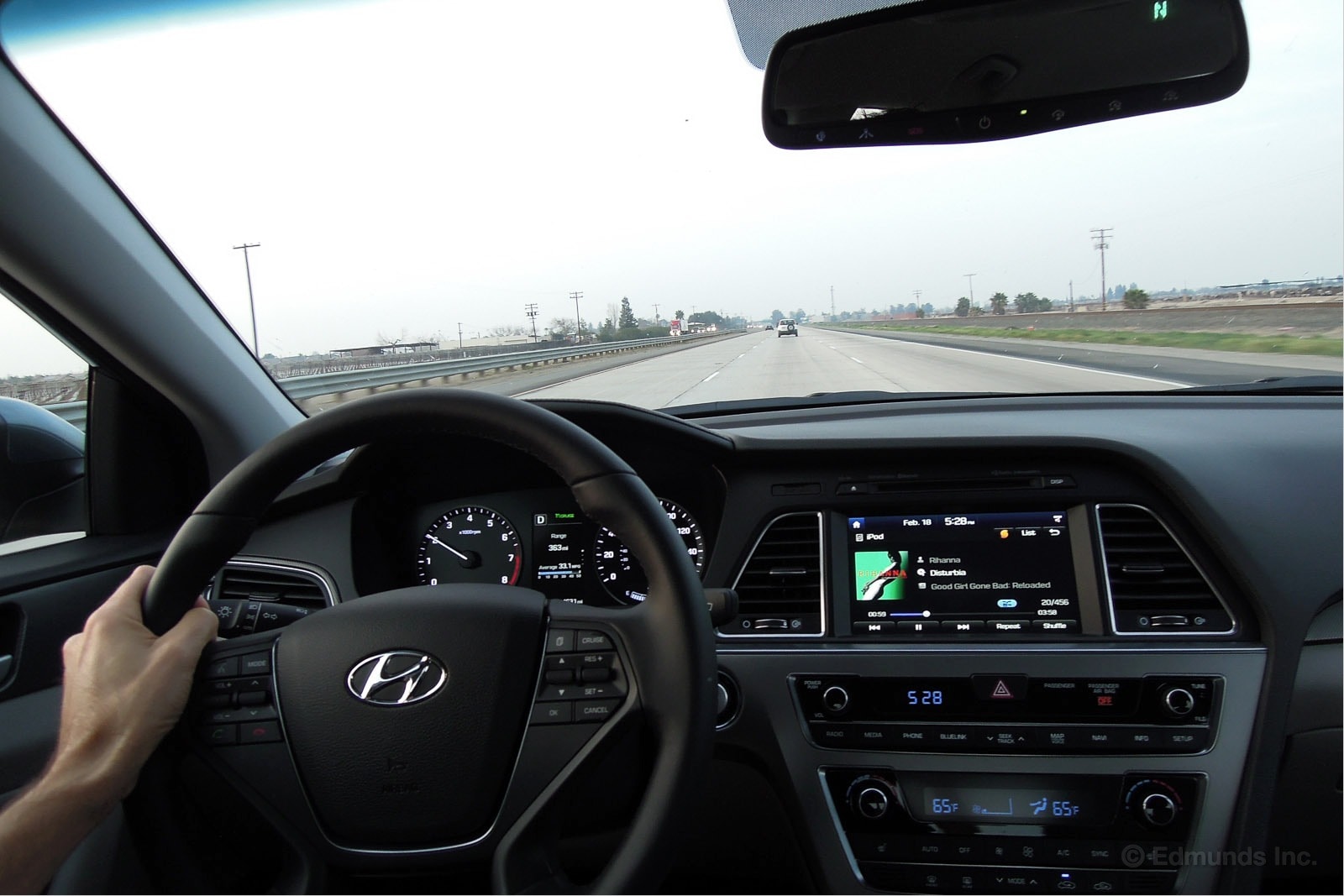
I've been driving our long-term 2015 Hyundai Sonata for a few days in a row. It's sort of a sneaky car. It's not going to blow you away with flash and pizzazz, but pay attention and you'll realize that it goes about its business in an impressively polished manner. For just about everything I'd actually want in a midsize sedan, the Sonata's got it.
First off, it's easy to drive. The driver seat is comfortable for extended trips. Ride quality is very good, too, as the Sonata ably absorbs rough pavement and bumps. Pleasingly, this isn't due to overly soft suspension tuning. For a family sedan the Sonata is nicely balanced and feels secure when going around turns.
As Mike Monticello wrote previously, it would have been interesting to test out the Eco model. But I'm pretty happy with the 2.4-liter engine in our Sport. It's a solid mill with respectable power and fuel economy.
Back seat? Roomy. Trunk? Big. Plenty of places to store your personal items? Yep. Logical control layout? Spock would love it. High safety scores? Five stars across the board, the government says. And, of course, there are Hyundai's traditional strengths in value and warranty coverage, too.
If I were shopping for a midsize family sedan, the latest Sonata would be right in the mix of cars I'd consider.
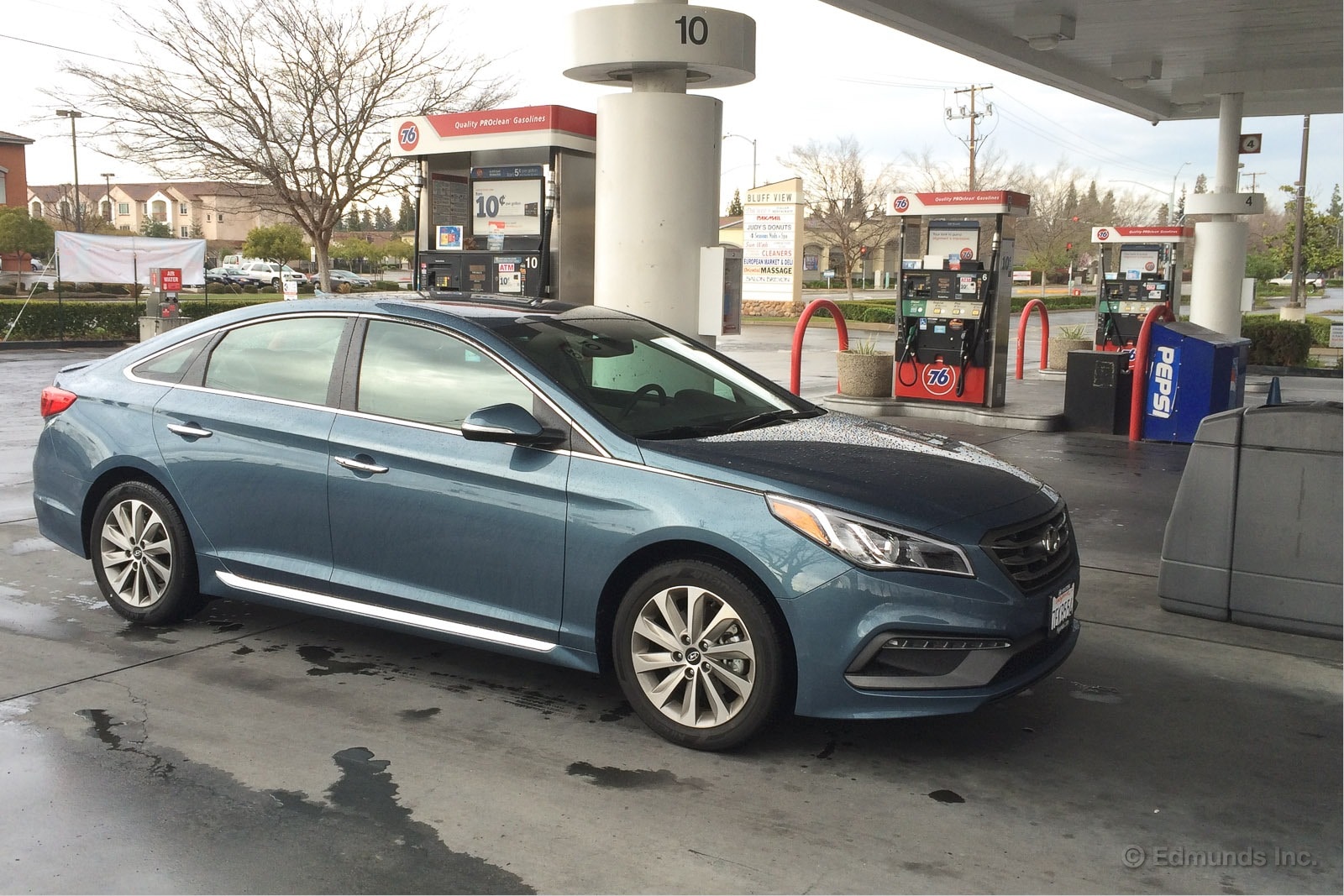
In February we didn't use our 2015 Hyundai Sonata Sport for any road trips. Much of the driving was commuting around in Edmunds' home base of Los Angeles. In total, we added about 1,500 miles.
As a result our fuel economy for the month hovered around the lower end of the spectrum.
For the month, we averaged 25.4 mpg. That's nearly identical to our lifetime average of 25.2 mpg after almost 5,000 miles. The EPA says we should be expecting 28 mpg combined (24 mpg city/35 mpg highway). We did post another above 30 mpg fill-up this month (31.3 mpg), though. And at this point, it's still pretty early in our test. I'll be taking our Sonata on a highway-biased drive soon, and I'll be curious to learn what fuel economy I get.
Worst Fill MPG: 19.3
Best Fill MPG: 31.7
Average Lifetime MPG: 25.2
EPA MPG Rating: 28 Combined (24 City/35 Highway)
Best Range: 370 miles
Current Odometer: 4,967 miles
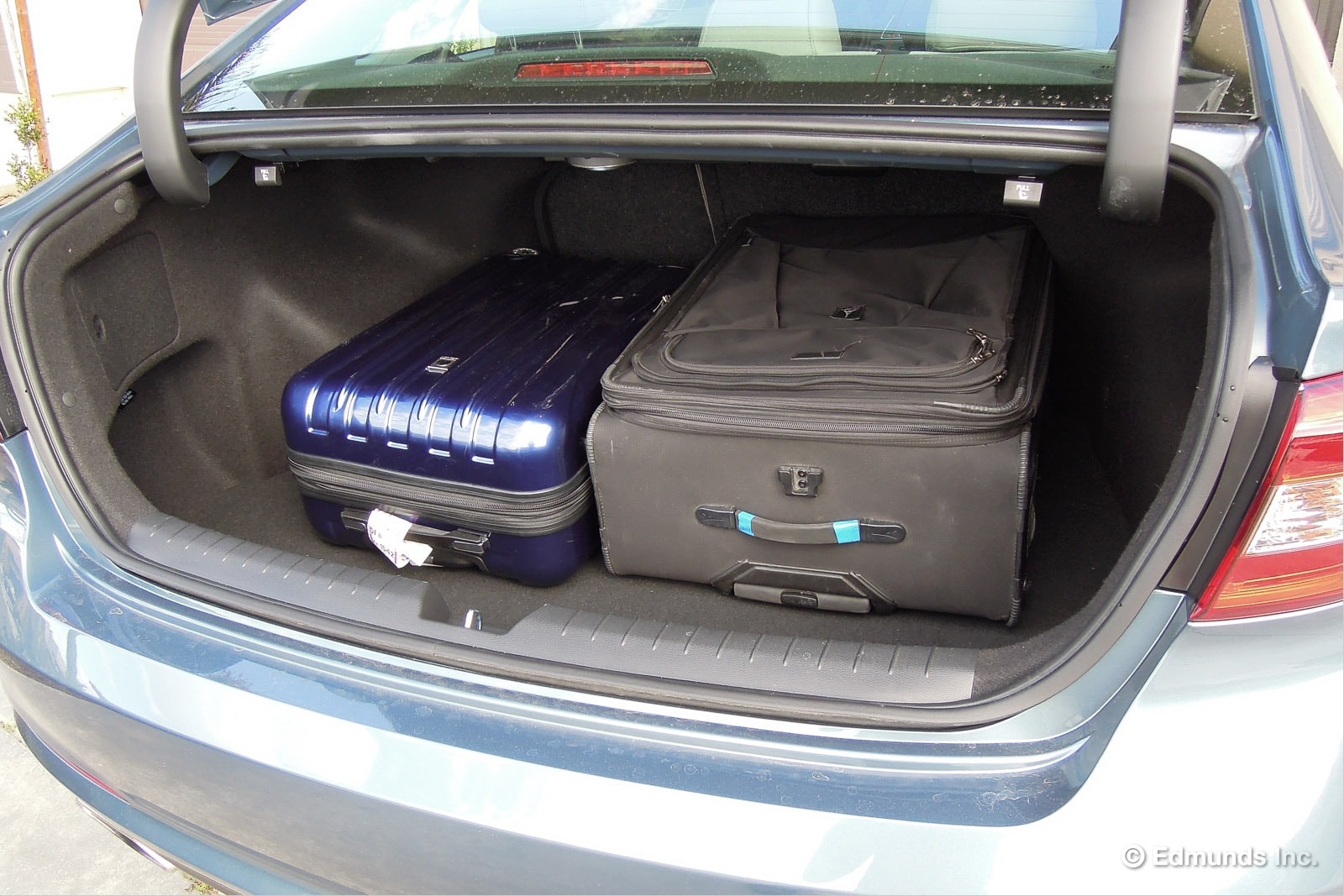
I've loaded a few items into the trunk of our 2015 Hyundai Sonata so far. Each time, I thought to myself that the trunk seemed pretty roomy. And in actuality, the Sonata is a leader among its main rivals for trunk space on the spec sheet, too.
Trunk capacities of today's midsize family sedans are fall within a cubic foot of each other. But I guess there's always that cliché about being big, right?
Vehicle |
Trunk Space (cu-ft) |
2015 Chrysler 200 |
16 |
2015 Ford Fusion |
16 |
2015 Honda Accord |
15.8 |
2015 Hyundai Sonata |
16.3 |
2015 Kia Optima |
15.4 |
2015 Nissan Altima |
15.4 |
2015 Toyota Camry |
15.4 |
2015 Volkswagen Passat |
15.9 |
Loading items such as suitcases into the Sonata's 16.3-cubic-foot trunk is helped out by a wide opening. The only downside I've noticed is that if you're packing in a lot of stuff high you have to pay some attention to where the trunk lid hinges lower down (when you close the lid). This is true for most sedans, but the Sonata's "gooseneck" hinges seem to be positioned a couple of inches more inwards than, say, the ones in our last big-trunk sedan, the Volkswagen Passat. Other than that, our Sonata is at the ready for carrying our stuff.
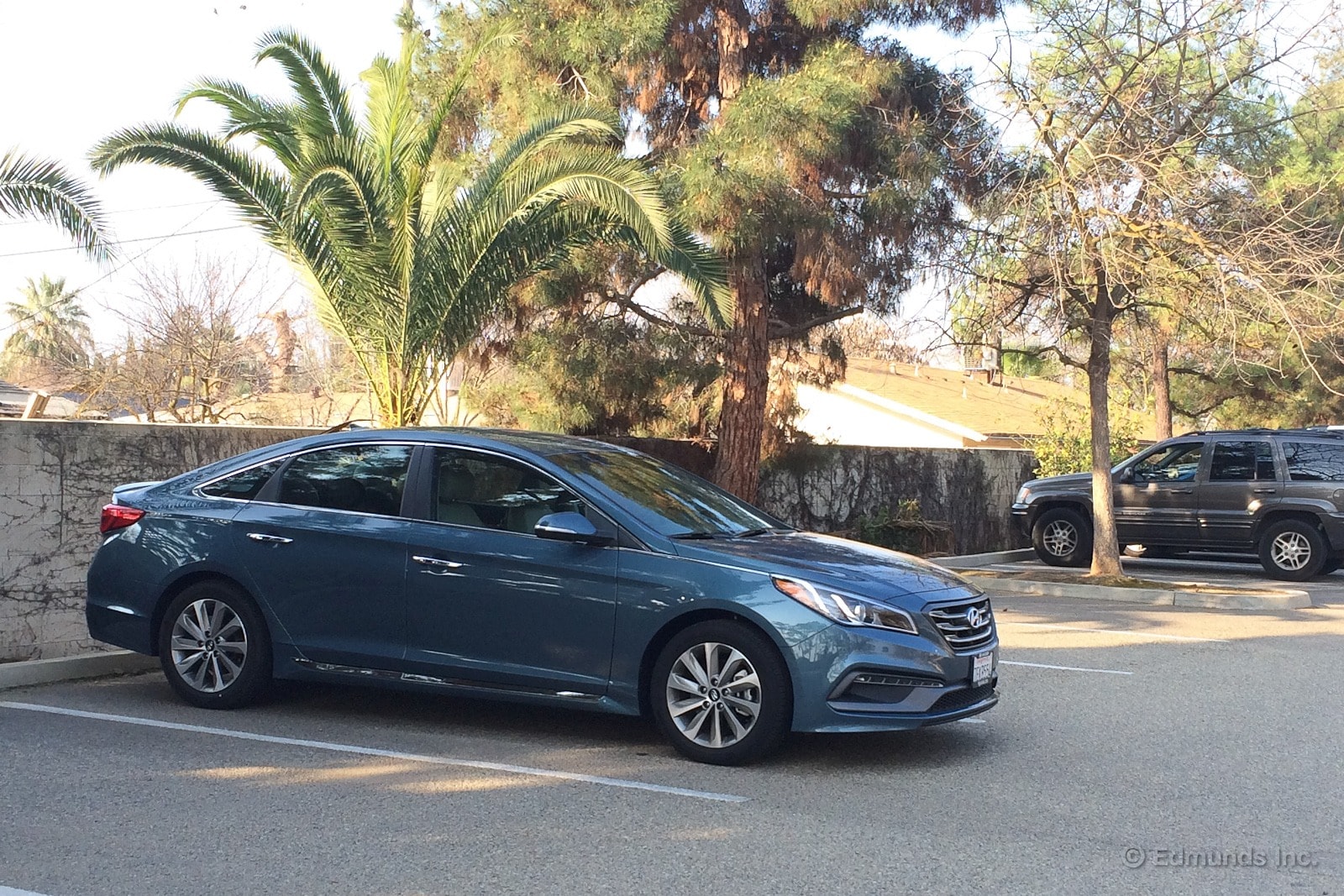
We've had our 2015 Hyundai Sonata in our long-term fleet for about three months now. Just a few days ago we also clicked off 5,000 miles, which puts us on schedule to achieve our typical goal of amassing 20,000 miles for a car with a one-year stay.
So far, our Sonata has been very well received.
Almost all of the updates we've written have been favorable. It's also been trouble-fee other than the issue with the airbag warning light, which we did have to go to the dealer for. Otherwise, our first official visit for service will be at 7,500 miles, according to Hyundai's maintenance schedule.
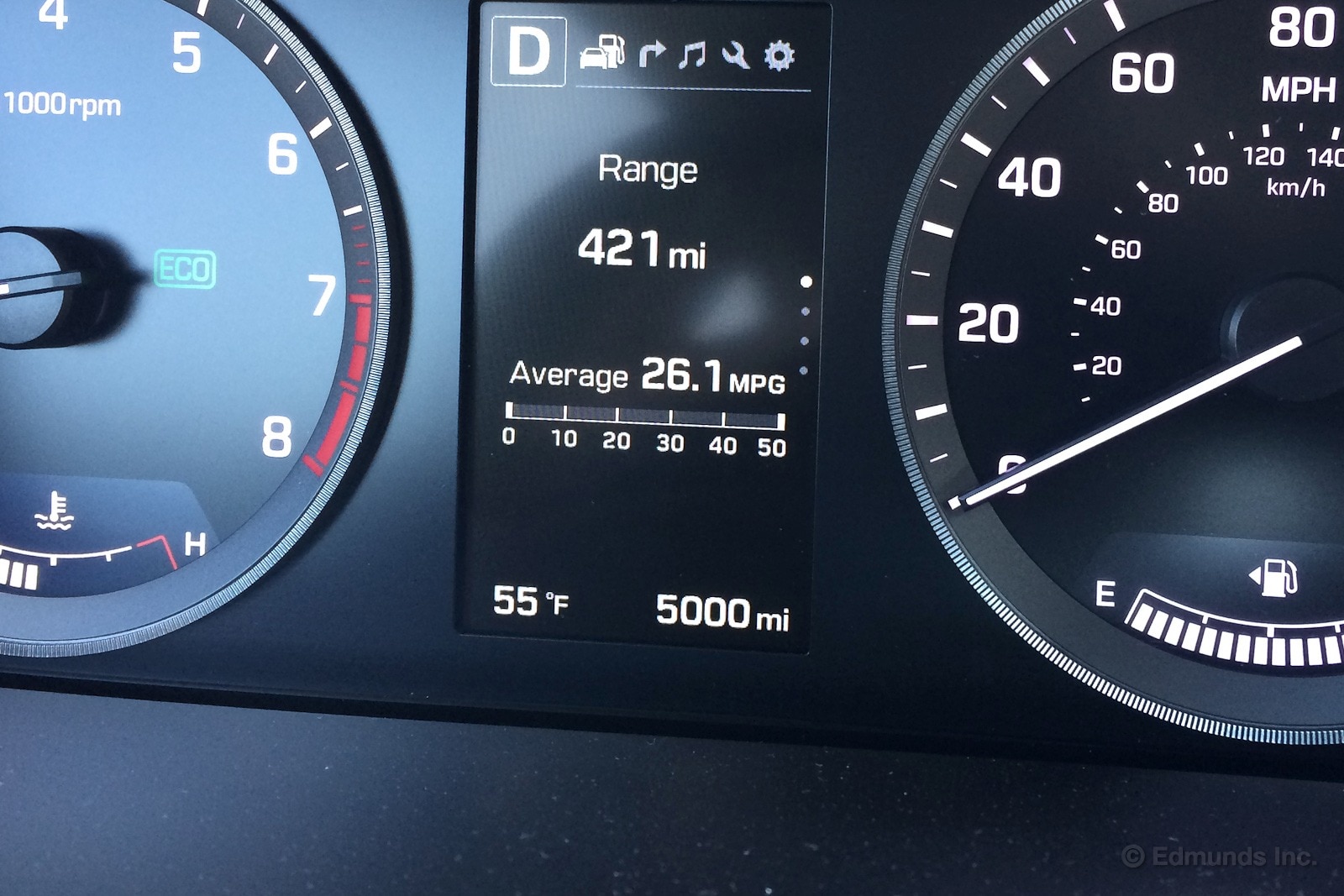

There's a reassuring simplicity to the control layout in our 2015 Hyundai Sonata in the daytime, and at night when the illumination is white for the main instrument dials and blue for everything else.

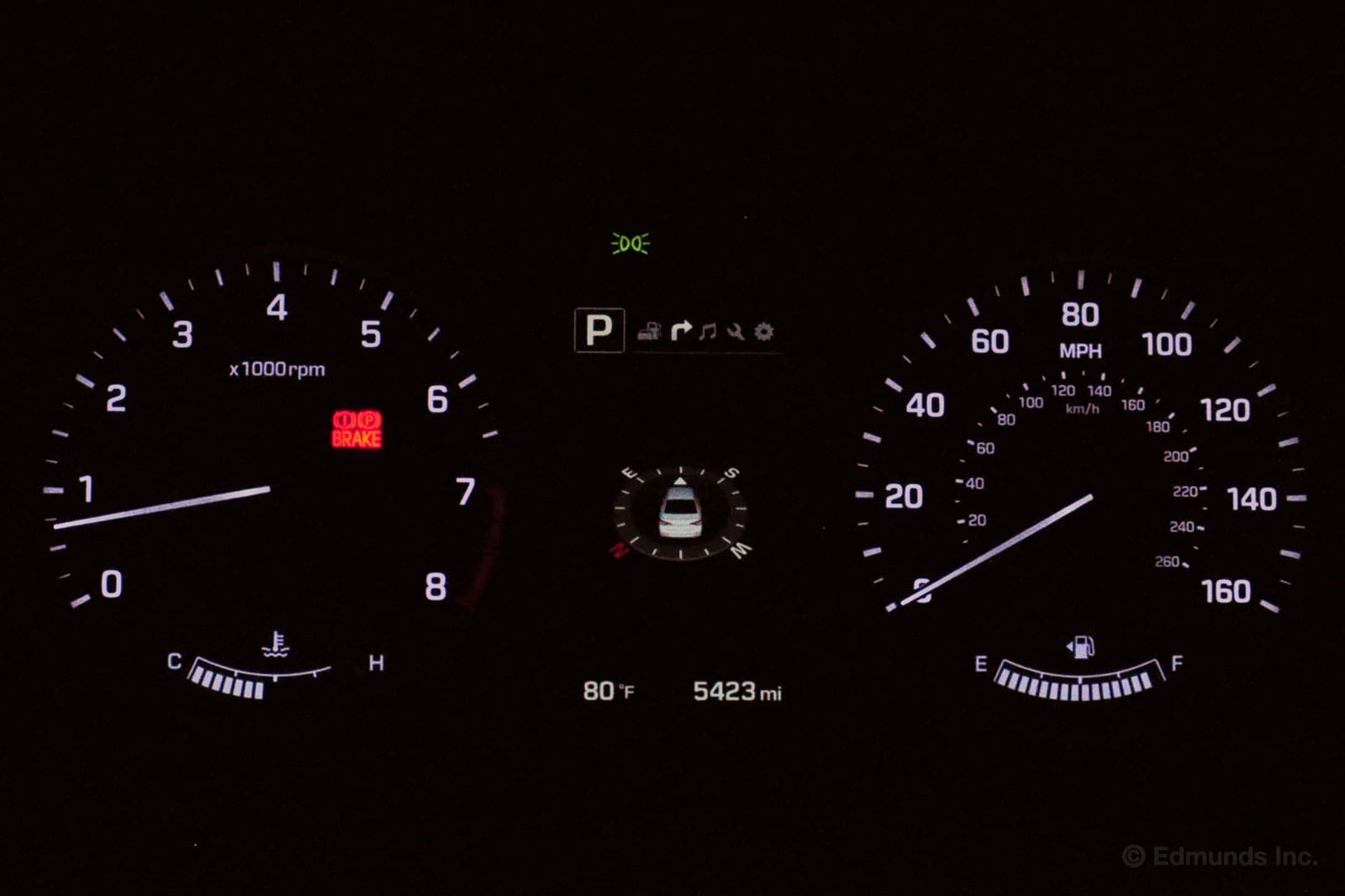
To my eyes, it's a very functional but less interesting design than what we had in our non-navigation 2011 Sonata GLS. That car had some strange shapes, individual gauge binnacles, a Volvo-inspired humanoid for the climate functions and unusually nice materials.

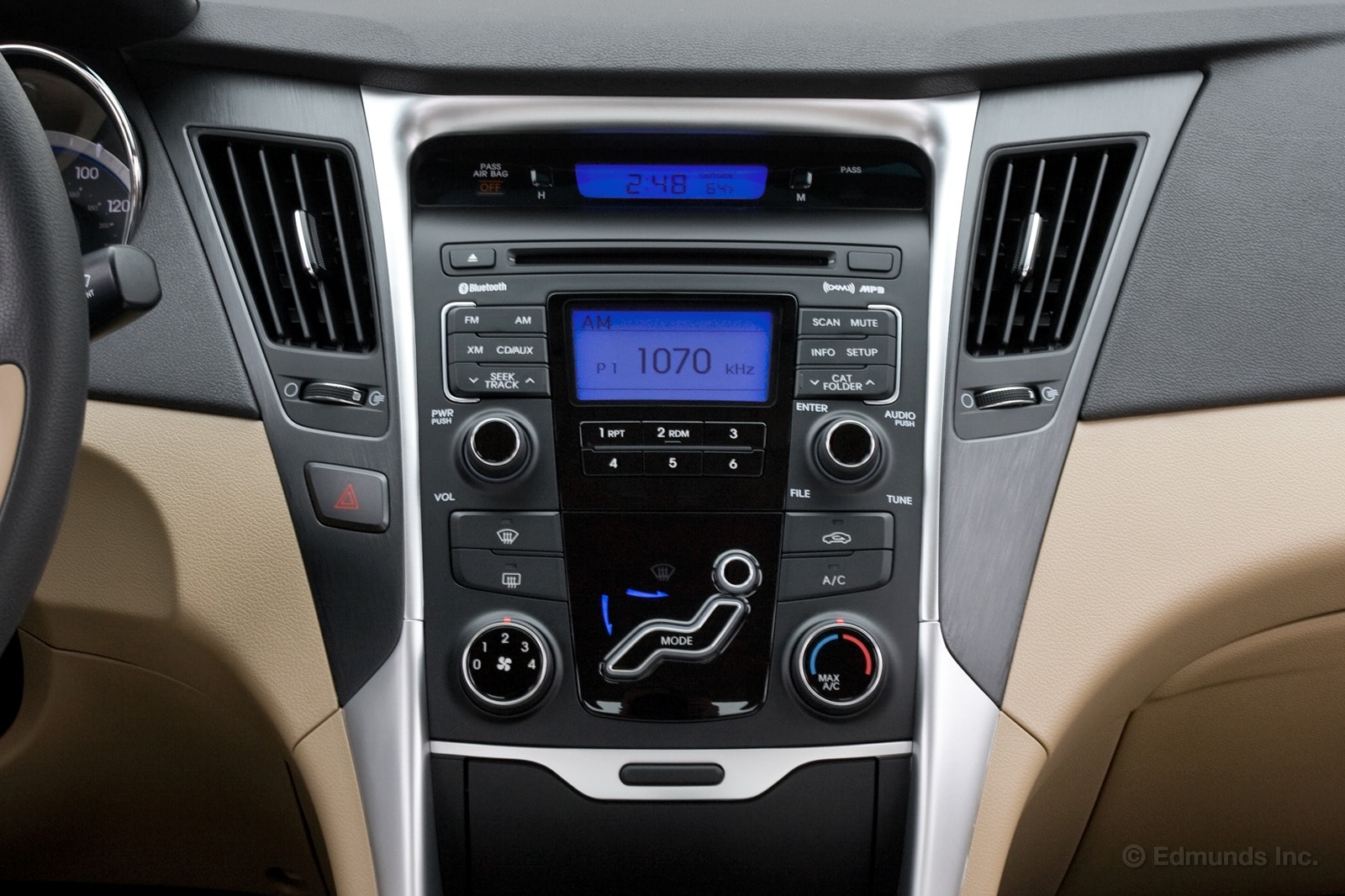
The materials in our 2015 Sonata Sport are just as high-quality, maybe even a touch better in some areas. Overall, the interior design feels more mainstream and reflects the Sonata's standing in the midsize sedan class.
Back in 2011, the Sonata was still a bit of an alternative choice, a car you'd feel good about buying if you got out the door for a rock-bottom price. Not that there's anything wrong with that. That 2011-'14 Sonata deserves most of the credit for elevating Hyundai's position in this class.
Now in 2015 we have a Sonata that should be considered right alongside the Accords, Altimas and Camrys of the world no matter how your priorities stack up. And maybe the consequence of that is that in certain small ways, the Sonata has given up a bit of personality. This is no bad thing if you like simple controls.
In fact, the only confusing thing I've encountered so far is the smartphone-inspired swipe selection process for certain touchscreen menus, including the one I had to visit to change the clock to daylight-saving time. It's surprising, I suppose, because the Sonata still has an old-school radio tuning knob plus two separate dials for dual temperature control. But just as with any new smartphone, I think I'll adjust quickly.
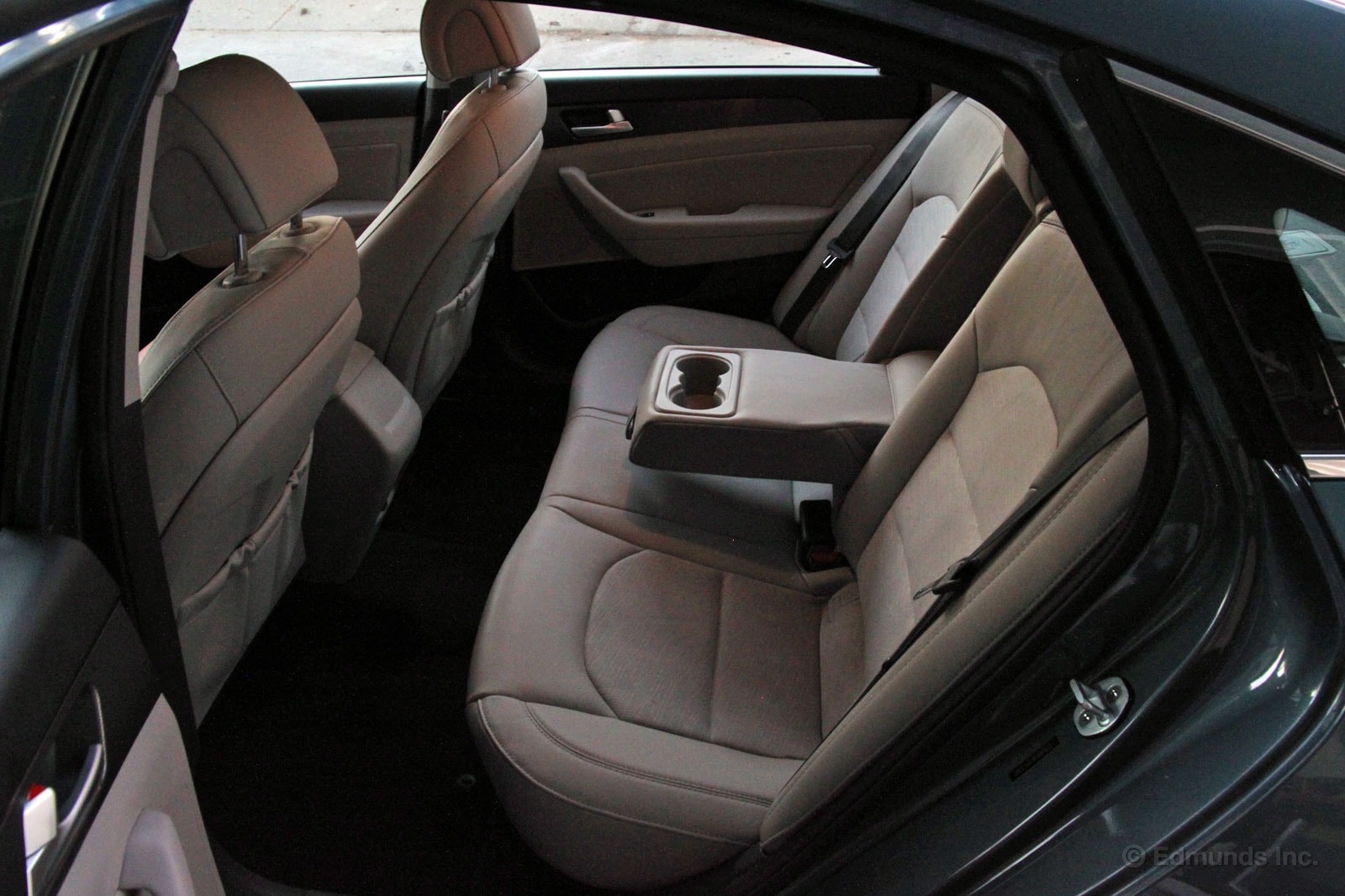
After sitting in the back seat of our 2015 Hyundai Sonata, I figured the dimensions probably measured up favorably to competitors like the Honda Accord, Nissan Altima and Toyota Camry. Turns out this Sonata does much better in some respects than others.
Where does it come up short? Legroom. With 35.6 inches of rear legroom, the Sonata comes up around three inches short of the Accord and the Camry and half-an-inch short to the Altima.
So why does it still feel roomy? It's tall and wide. When it comes to headroom, the Sonata nearly matches the Camry (38 vs. 38.1) and beats the Accord and Altima by at least half an inch.
More important to its perceived space is the Sonata's rear hip room. It tops the Altima by four inches here and has about an inch and a half more hip room than both the Accord and Camry.
Oddly, all four sedans measure within two tenths of an inch when it comes to rear shoulder room. Guess that's an area no one brand felt the need to exploit.
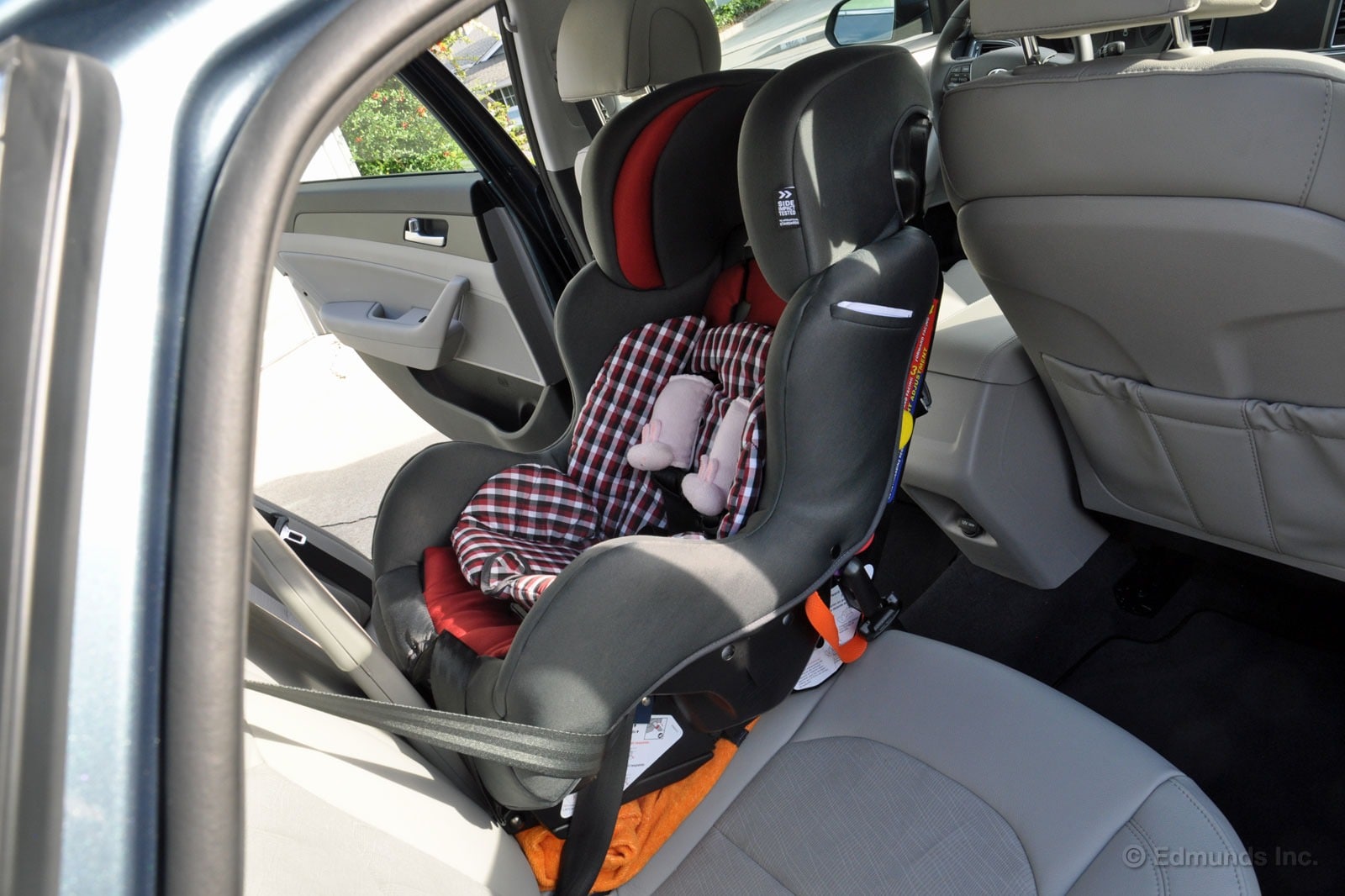
If you only have one child and you don't have a bad back (that would be aggravated by repeated stooping), it's easy to make a case for buying a midsize sedan like our 2015 Hyundai Sonata. There's so much room to spare in here, even compared to most small crossover SUVs and the rare compact minivan like my Mazda 5.
Given all the room in the Sonata, I chose to install my kid's larger-than-average convertible car seat in the rear center position. Hyundai gives you a LATCH setup only in the rear outboard positions, but as usual, I was tempted to use the inboard lower anchors for a center installation. Fortunately, Hyundai lays out what is and isn't OK very clearly in the Sonata's owner's manual.
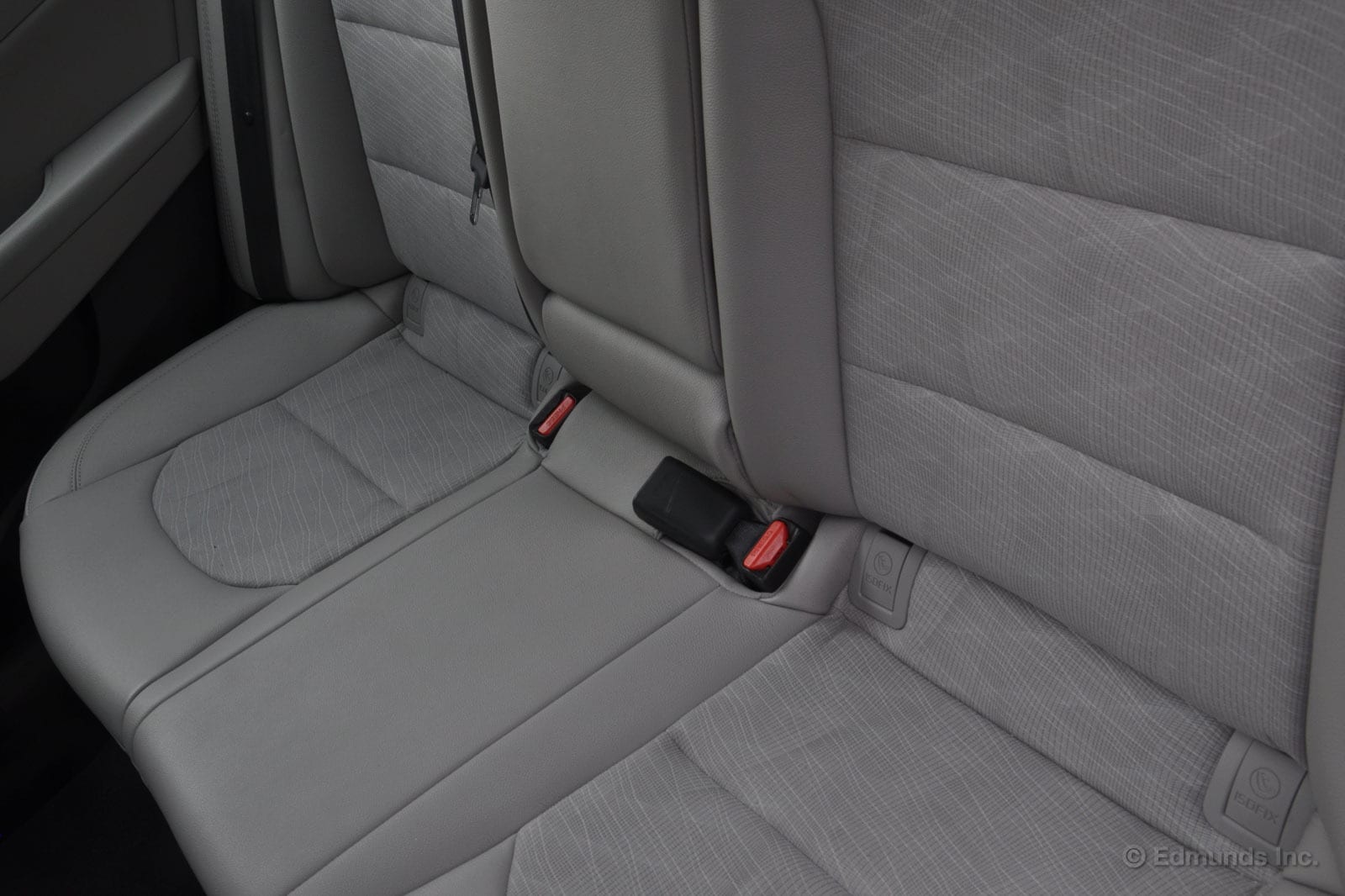

So I knew I'd have to use the seatbelt to install the car seat since I didn't want to put it on the side and take away the front passenger's legroom. Here's one user-friendly touch if you were going to use LATCH: these plastic covers over the lower anchors. Instead of using removable covers that you're likely to misplace as in VW Group vehicles like our long-term Volkswagen GTI and Porsche Macan, Hyundai went with these permanently attached covers. You just press and hold them to access the metal bars. Nice execution.
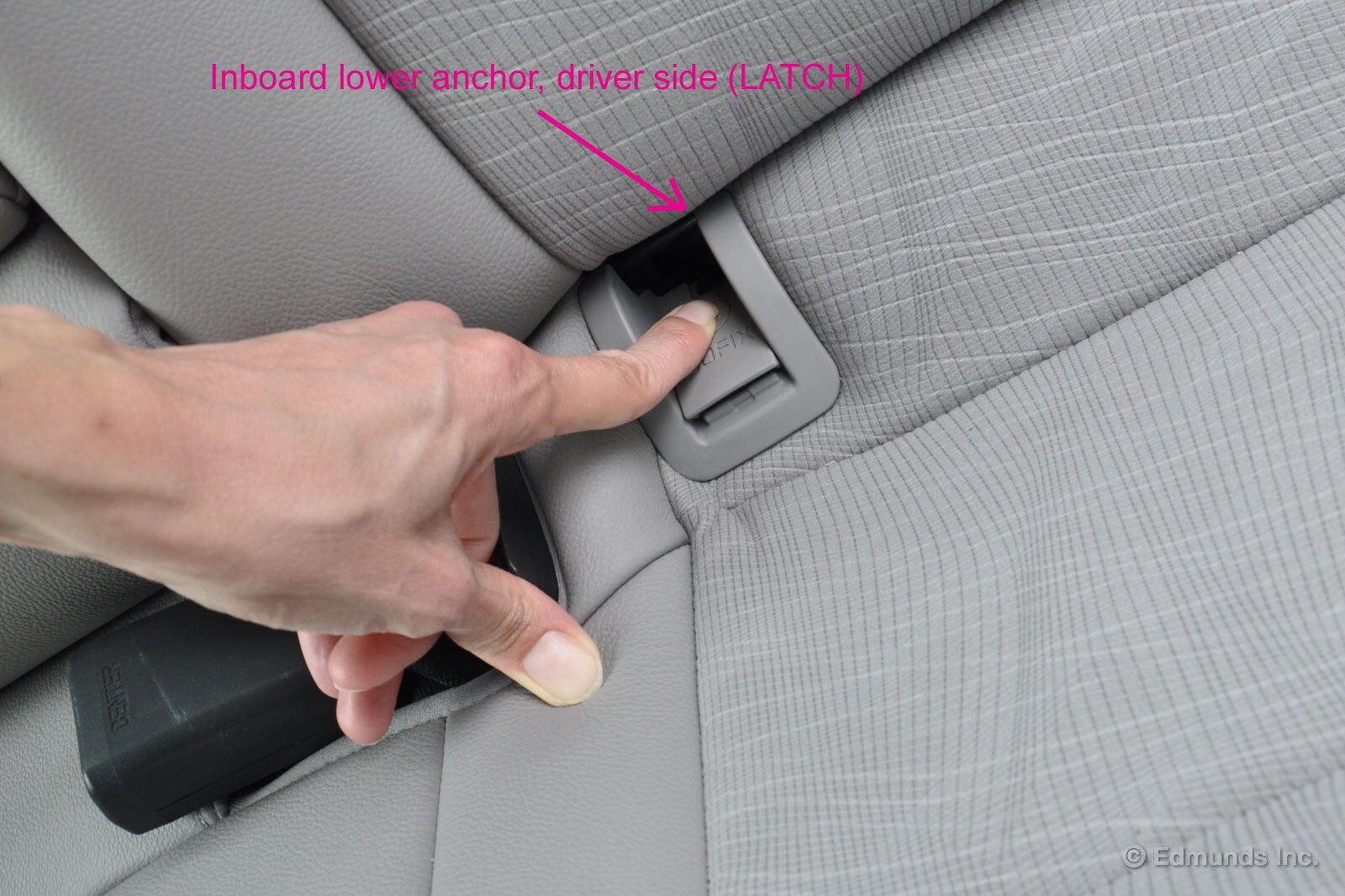
Although I got this First Years True Fit C680 SI snug enough (within the 1-inch wiggle tolerance) with a seatbelt installation, I don't love the fit in here. The center position has vinyl (leatherette, I suppose?) rather than cloth and that makes it easier for the seat to slide around while you're trying to pull the seatbelt tight. I used a rolled-up towel more to add grip than to achieve the correct angle.
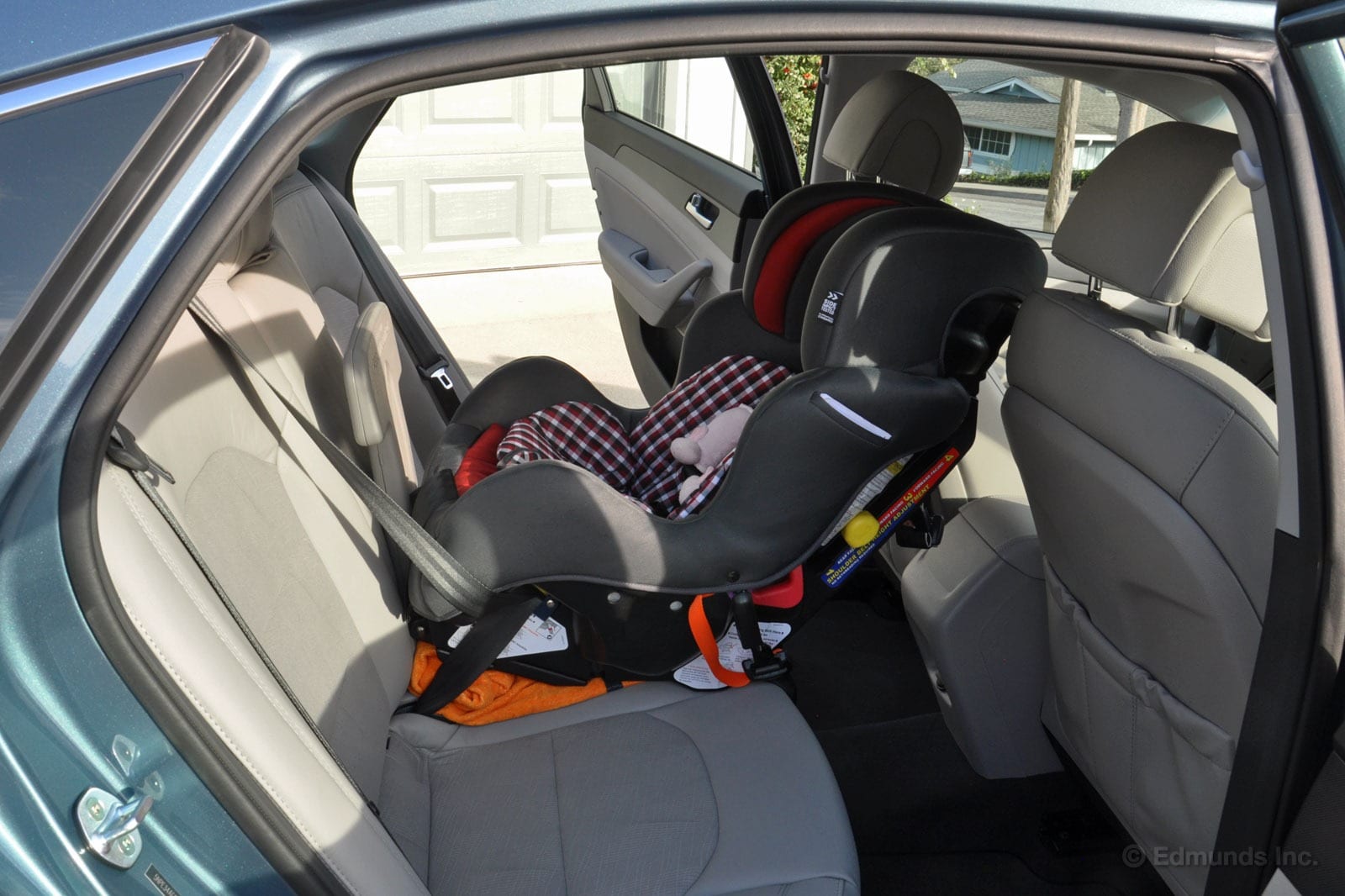
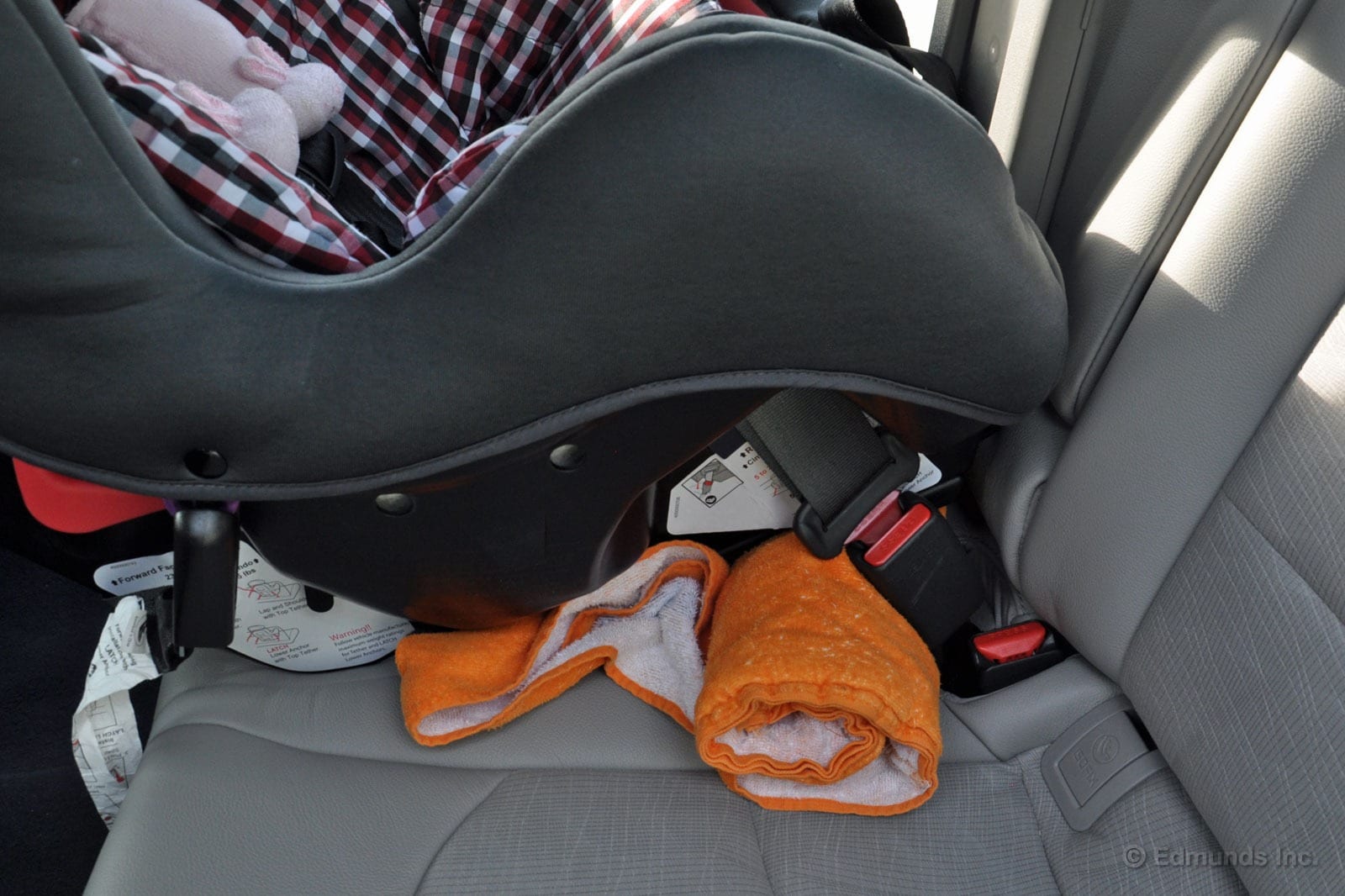
Also, the seatbelt receivers (female end of the buckle) in the outboard positions are rigidly mounted compared to the flexible receiver in the center position. The upshot is that there's no way to extract the passenger-side receiver and buckle the outboard seatbelt with this particular car seat installed. Its footprint is just too wide.
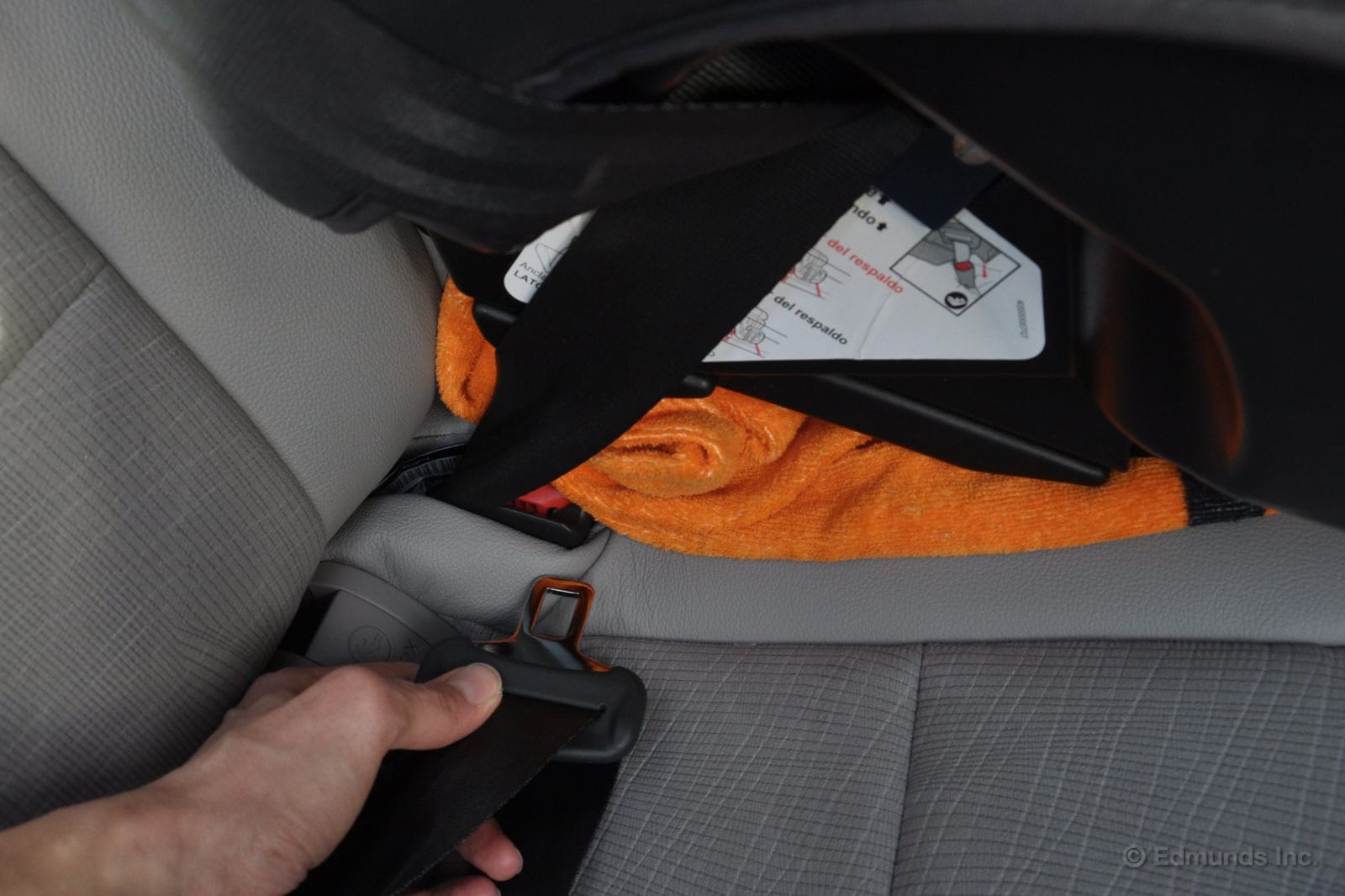
There's of course no such problem on the driver side.
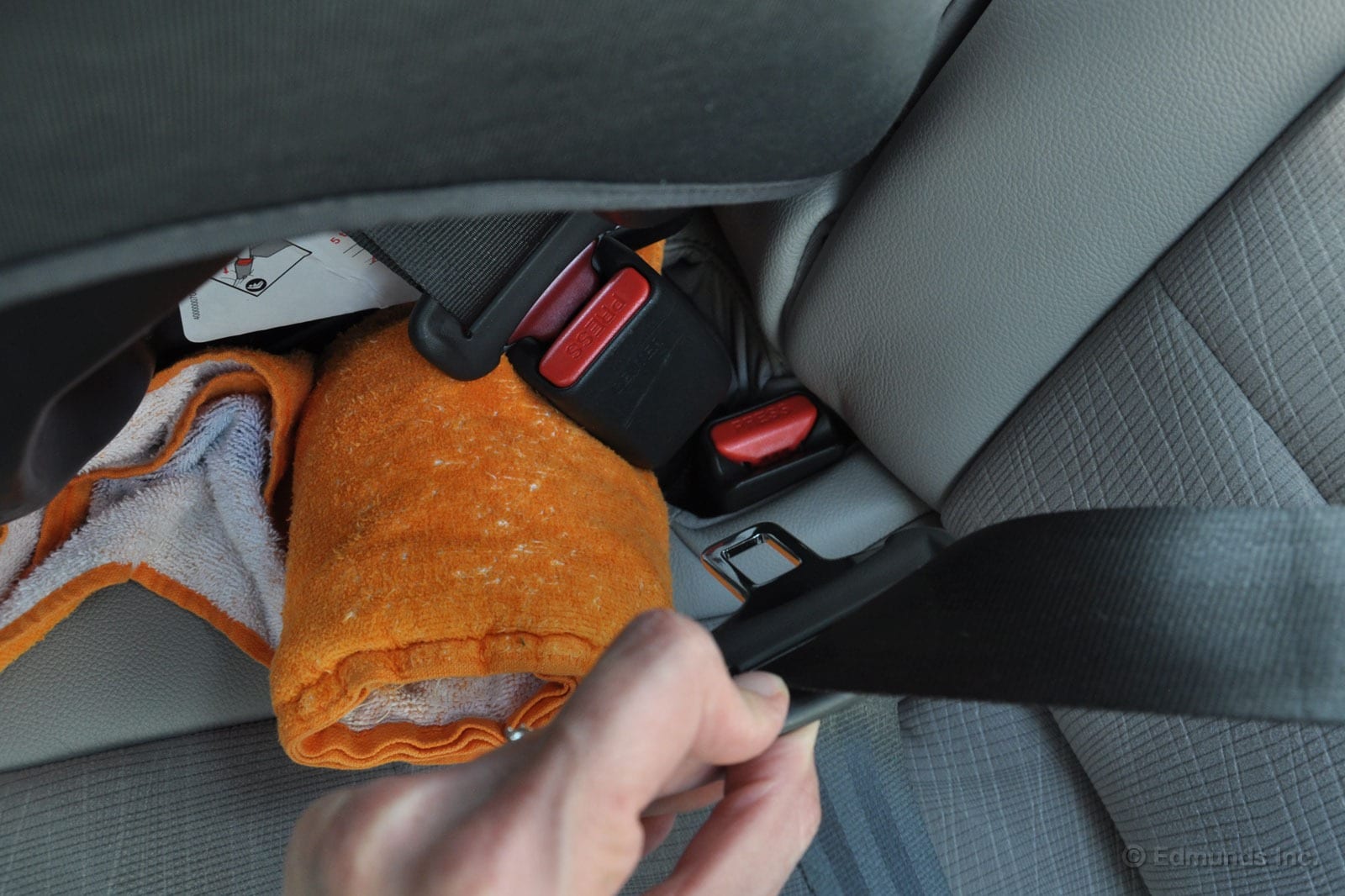
Because of these issues, I'd keep shopping for a different car seat if I owned a Sonata. I'd certainly go for a narrower seat (maybe a Diono Radian) to allow use of the passenger-side rear outboard seat.
One thing that won't be a problem with any rear-facing convertible car seat you install in the 2015 Hyundai Sonata is front legroom. My very wide car seat fits easily between the front seats. Even a longer-legged adult will still be able to sit comfortably in either the driver or front-passenger seat.
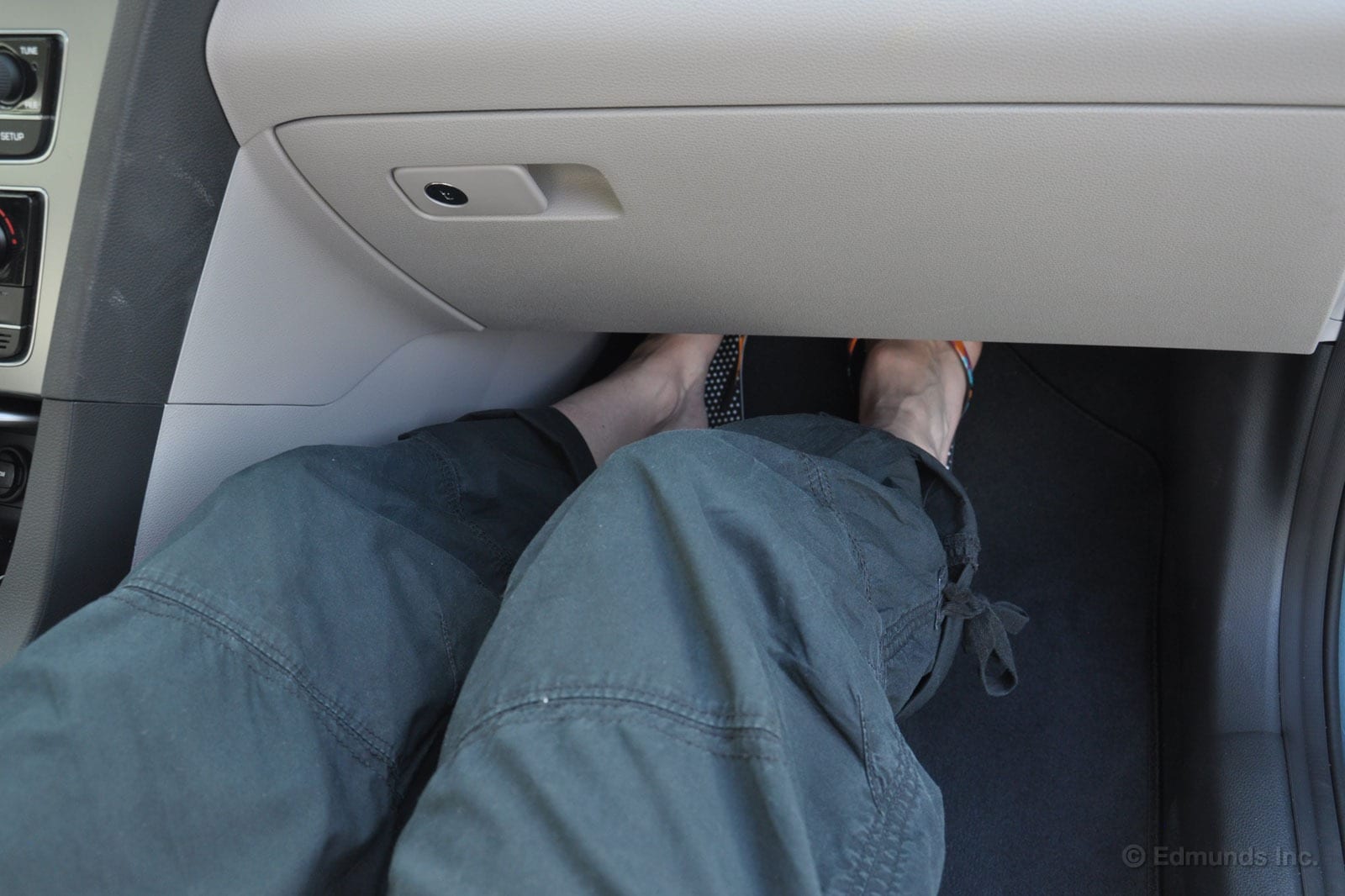
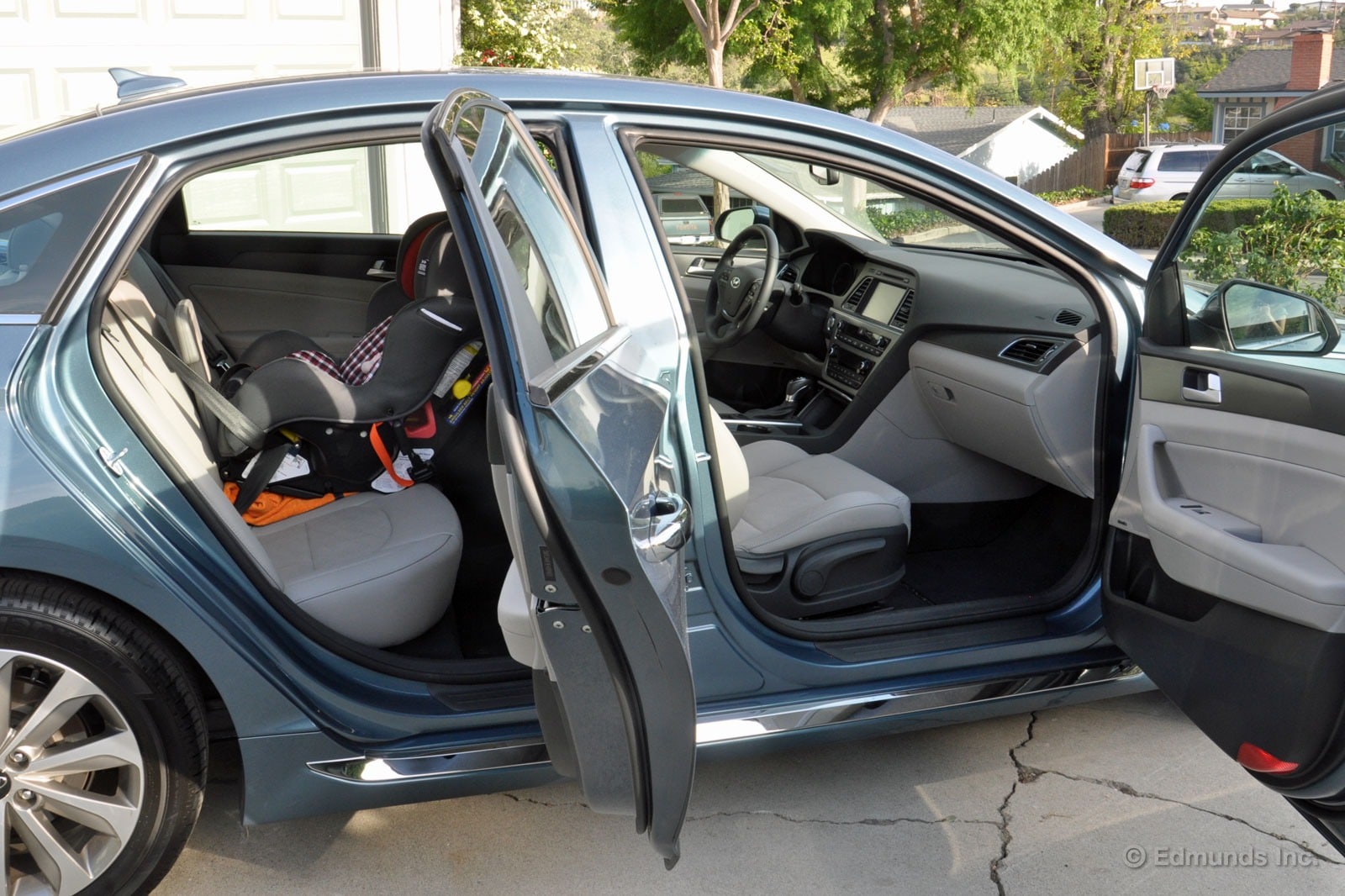
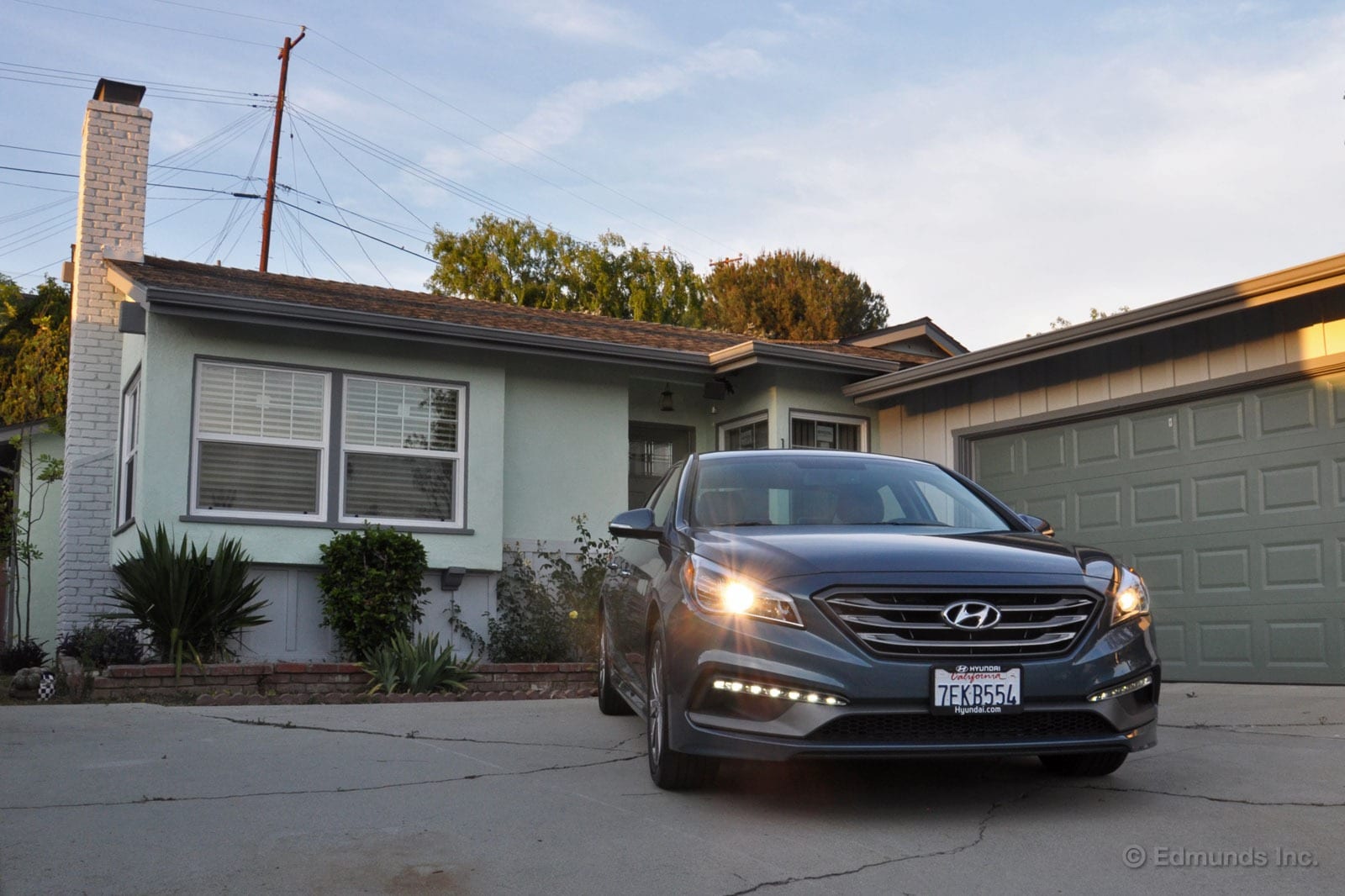
If you're a long-time reader of our long-term road tests, you might remember that we used to have a 2011 Hyundai Sonata GLS in our fleet. I liked the idea of that car, which offered lots of space and lots of features in an attractive wrapper, but the actual execution left me cold. Fortunately, a few of my complaints have been addressed in the 2015 Hyundai Sonata.
Ride quality is the biggest improvement here. Our 2011 Sonata never felt perfectly sorted out. At times, it rode stiffly and transmitted nearly every ripple and rut to the cabin. In other situations, it felt buoyant and disconnected from whatever was happening on the pavement. It was the kind of thing some (normal) people could overlook, but it became an obsession for me and made me want to take refuge in a Honda Accord.
The situation is much better in our long-term 2015 Sonata Sport, which does a much better job of filtering out small imperfections. It's not a sporty car, but it feels buttoned down to an extent that the old Sonata never did.
I also think the steering has come a long way in the new-generation Hyundai Sonata. It's still electric-assist power steering of course, but it feels far less simulated than before. It's just normal steering now, nothing spectacular but precise enough not to call attention to itself in everyday driving situations. And for me, this makes the 2015 Sonata far more agreeable for commuting.
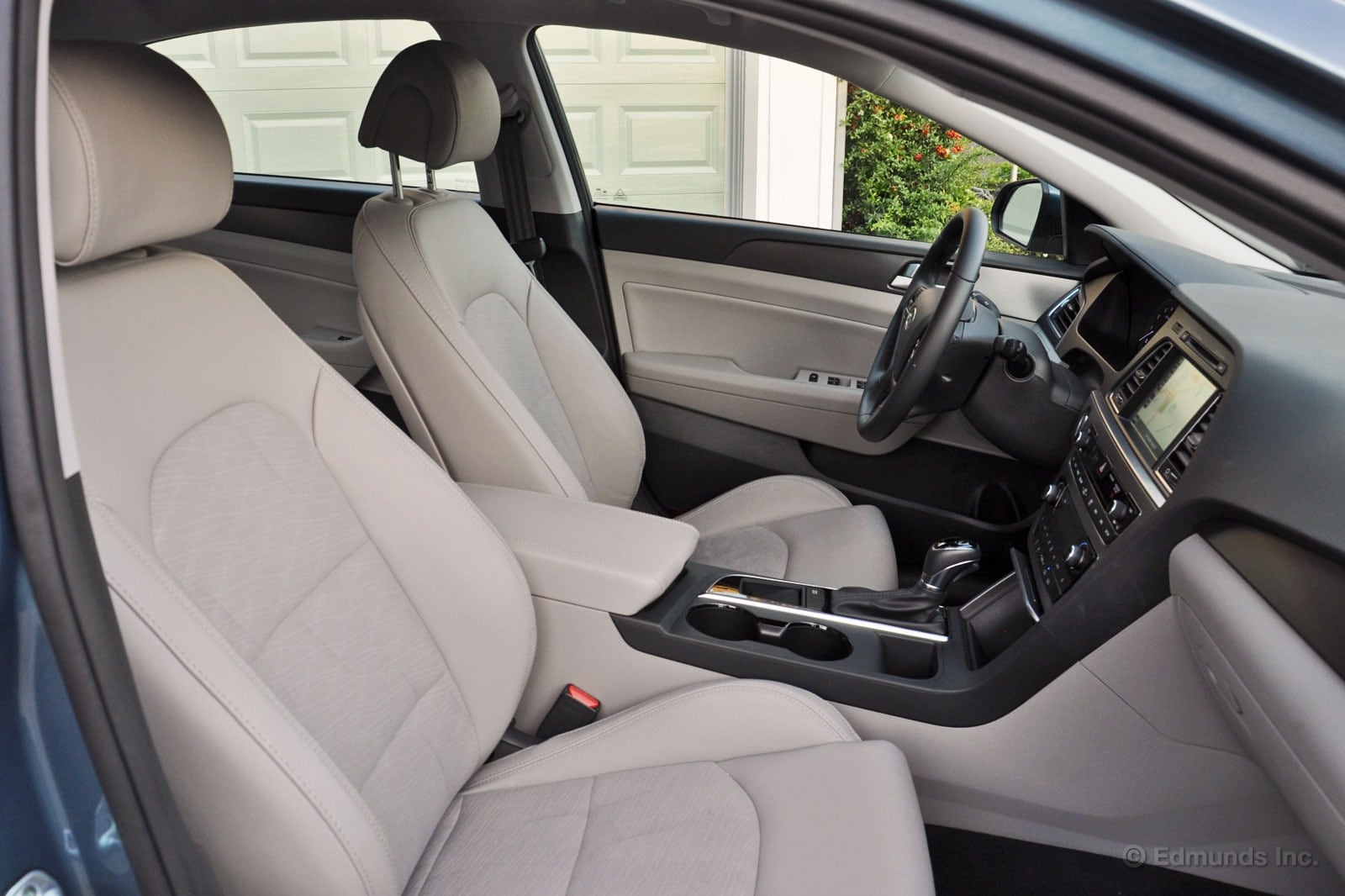
Ed has already written that the driver seat in our long-term 2015 Hyundai Sonata is quite comfortable and supportive on long commutes. I heartily agree with him and would like to add this is a much better driver seat than the one we had in our 2011 Hyundai Sonata GLS.
Here's a photo of the driver seat in our 2011 Sonata:
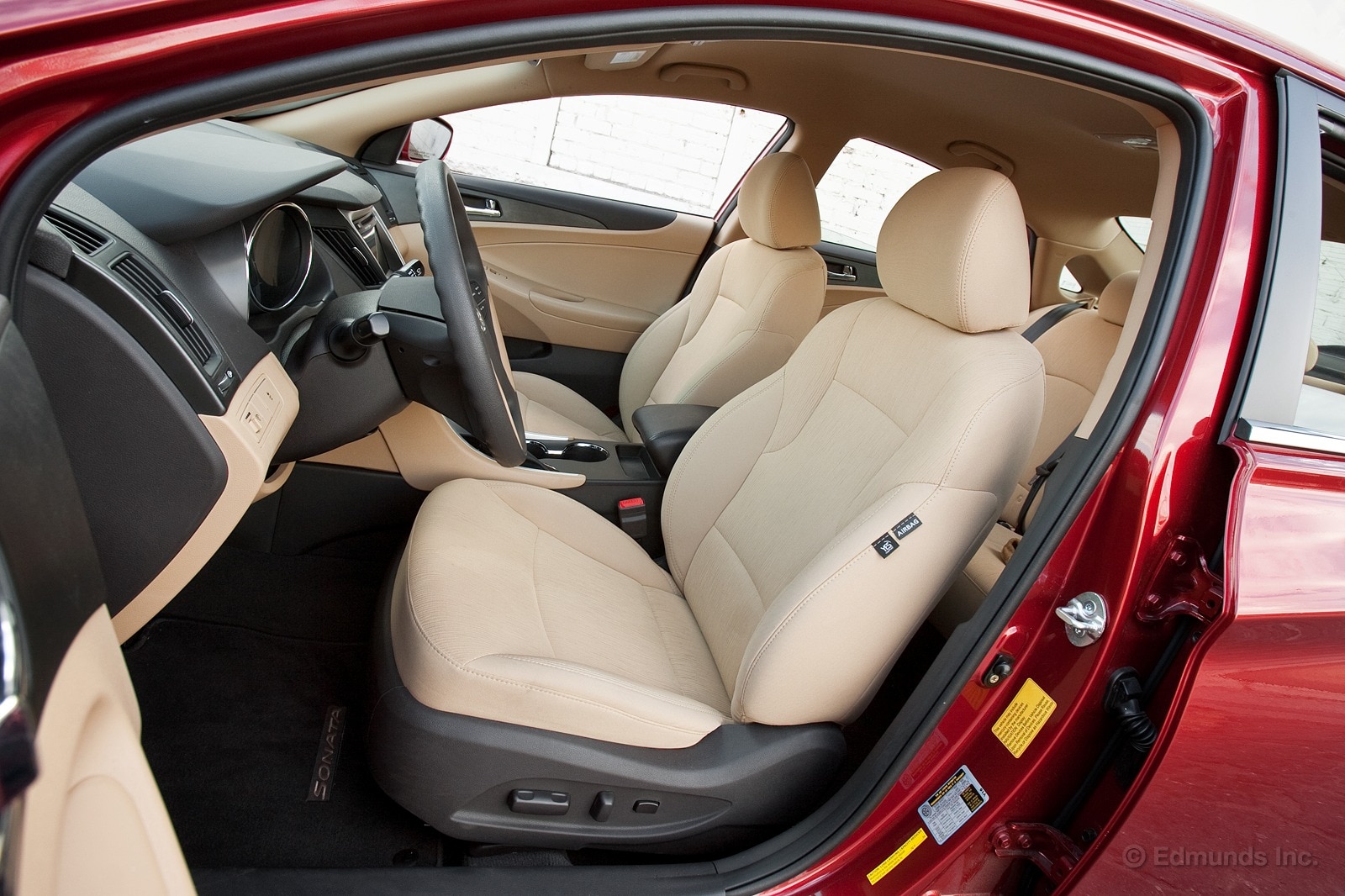
It looks comfy enough, I suppose, but every time I sat in it, I wondered if anyone from Hyundai's North American operation actually sat in it before bringing the car to market here. I'm pretty average size (5 feet, 10 inches tall, about 150 pounds and a bit long of leg), and the shaping was just all wrong for me.
I always felt like I was sitting in too reclined a position and barely able to see over the dash. The latter was more a state of mind than the reality, but still, the dash seemed overly high in relation to the driver seat.
In contrast, the driver seat in our 2015 Sonata Sport is perfectly shaped for someone my size, and the sightlines are much better. I don't think there's any more glass area in this car than the previous Sonata, but the dash feels lower, flatter and less distracting. This is a midsize sedan I could buy. I would've passed on the previous Sonata.
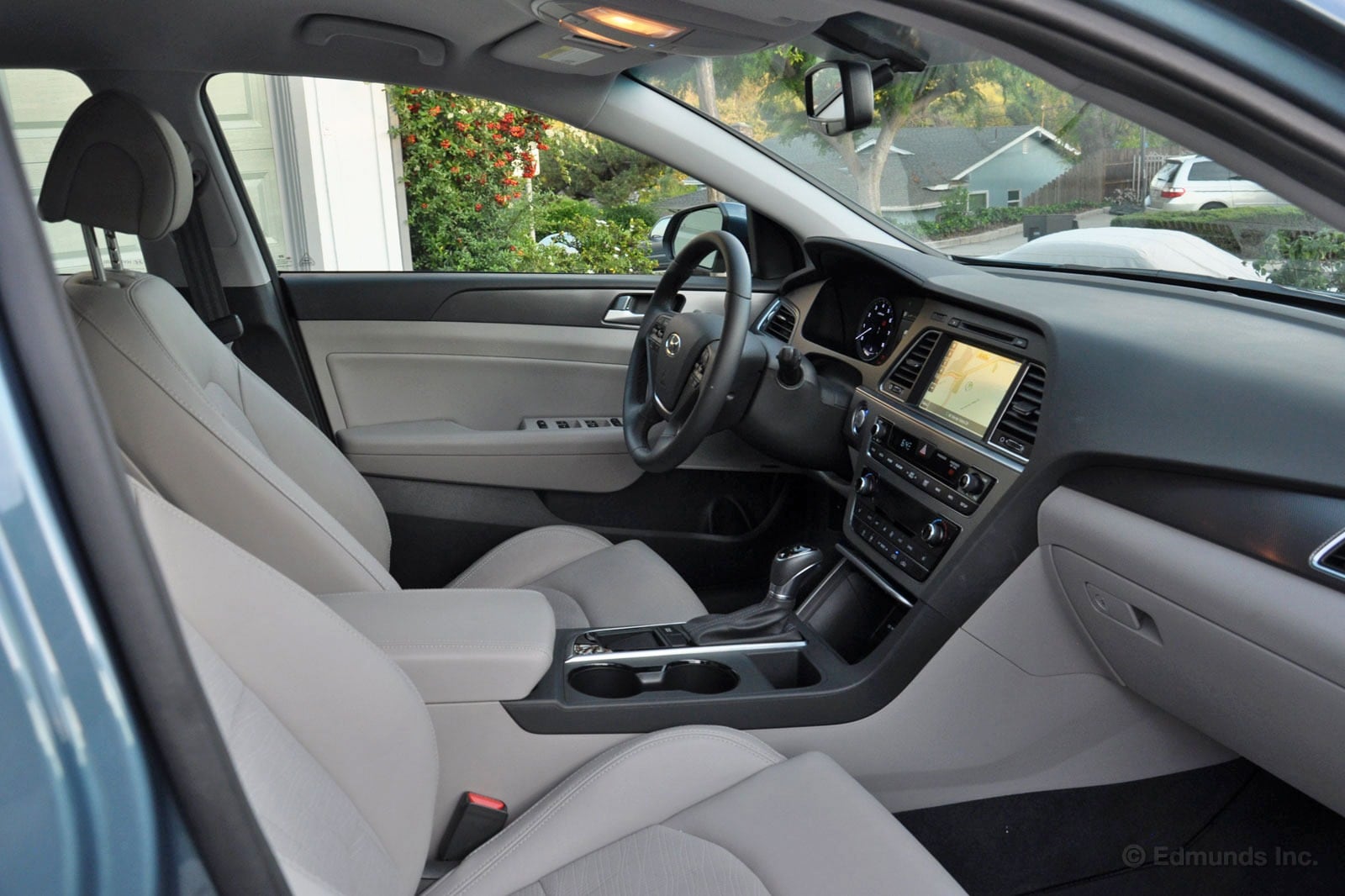

Our long-term 2015 Hyundai Sonata didn't go on any long road trips during the month of March. It hit the 5,000-mile mark early on in the month, but from there it was mostly city miles and short commutes for the Sonata.
As a result, the lifetime average fuel economy stayed exactly the same: 25.2 mpg. That's not terrible, but it doesn't match the EPA's estimate of 28 mpg combined and we've yet to crack their estimate of 35 mpg on the highway. Maybe it's time for some hypermiling.
Worst Fill MPG: 19.3
Best Fill MPG: 31.7
Average Lifetime MPG: 25.2
EPA MPG Rating: 28 Combined (24 City/35 Highway)
Best Range: 370.4 miles
Current Odometer: 5,555 miles

By virtue of utilizing Hyundai's 2.4-liter four cylinder engine, our long-term Sport trim 2015 Hyundai Sonata earns a "B" rating from our editors. Other models in the Sonata line score higher. Read on to discover why.
By nearly every measure the Sonata is a competent and capable midsize sedan. However, this particular flavor - Sport with 2.4-liter engine - lacks both the performance and fuel economy of the Eco trim, which starts only $100 higher.
In our testing, the Sonata Eco, which comes standard with a 7-speed dual-clutch automated manual transmission, accelerated to 60 mph in only 7.5 seconds. The last 2.4-liter Sonata we tested, equipped with a 6-speed automatic, required 8.2 seconds to hit the same milestone.
The Sonata Eco also earns a 32 mpg combined rating from the EPA, a number we equaled in testing. The 2.4-liter Sonata, meanwhile, is rated at 28 combined, a number we haven't achieved yet.
Also impressive is that the Eco trim handles nearly as well as the purportedly sportier 2.0T version, which we also rated an "A."
Find ratings on Sonatas with all three powertrains here.
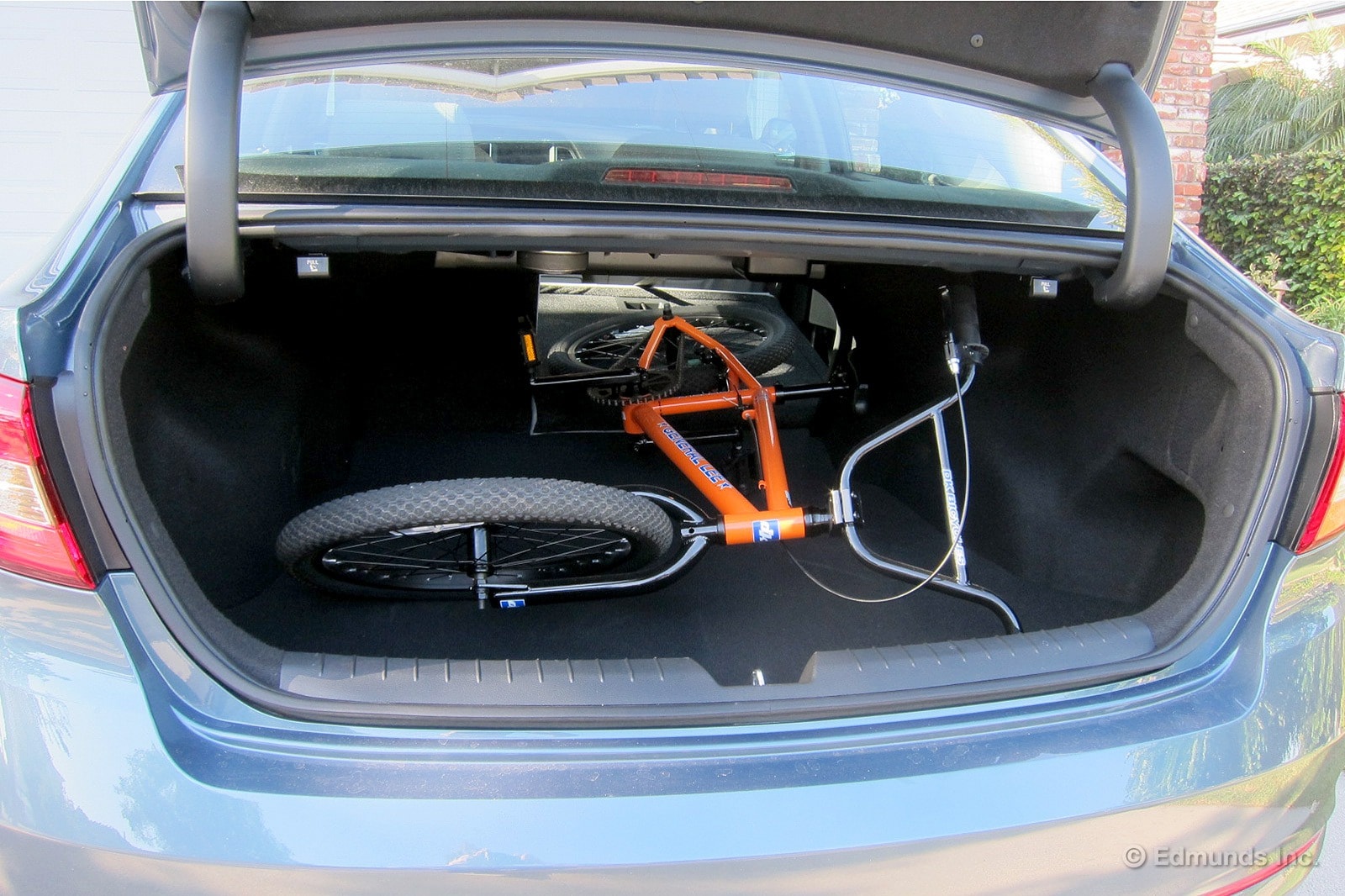
"Daddy, will my bike fit in your car? I thought it would be fun to take it over to the beach and go for a ride."
I wasn't sure. In our driveway sat our long-term 2015 Hyundai Sonata. It has a good-sized trunk, but I didn't know if my daughter's 20-inch BMX bike would fit.
"I don't know honey," I shot back trying to hide the doubt in my voice. "We can try."
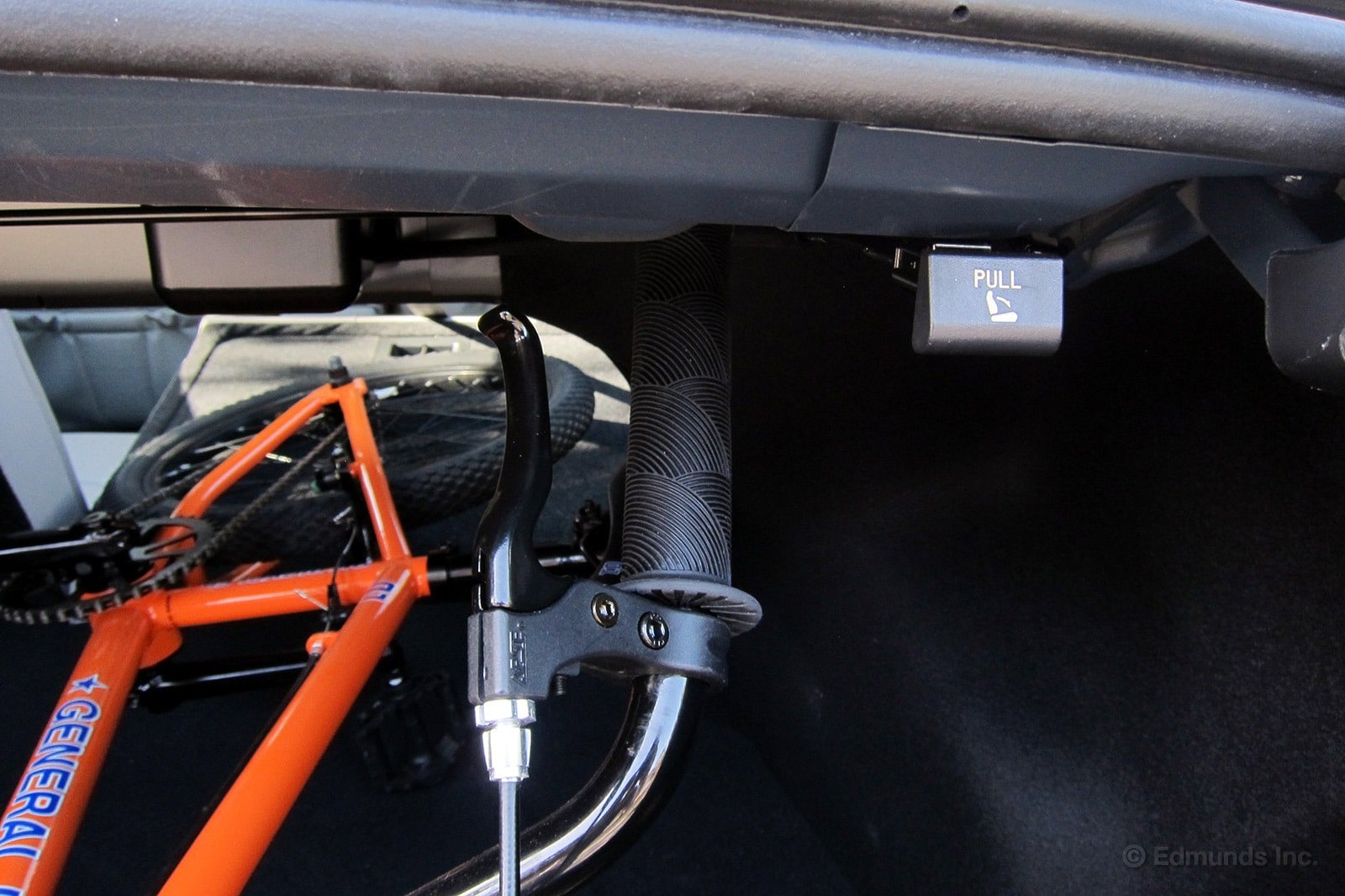
Five minutes later, the General Lee was secured in the Sonata's trunk and we were on our way to the beach.
Thanks to the Hyundai's 60/40 split-folding rear seat, the bike fit easily. And folding the seat was painless thanks to the sedan's trunk-mounted "pulls". One yank and the seat drops. Although the pass-through isn't as large as I've seen in other sedans, it was more than large enough for this job.
Add the smile on my kid's face to the long list of reasons I've become a big fan of this car.
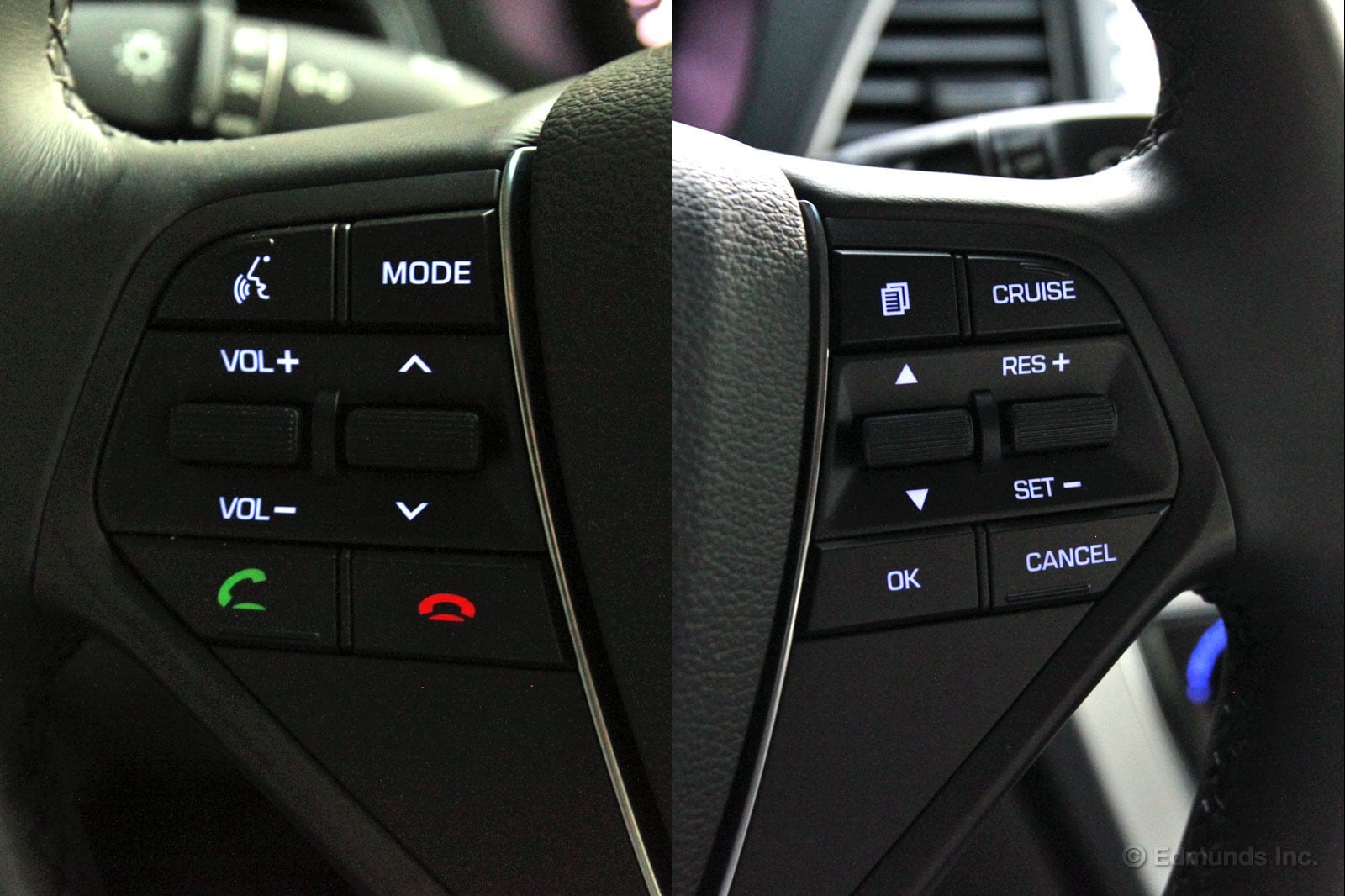
No one is going to buy a car because it has good steering wheel buttons. They're called "auxiliary" controls for a reason, but when the designers get it right, it sure is helpful.
Our 2015 Hyundai Sonata has a great setup that is easy to learn and usable without looking. The latter is important as these controls are intended to keep your hands on the wheel and your eyes focused on the road.
You'll notice that all the cruise control functions are on the far right. Once you remember that, it's easy to manipulate the system without glancing down. Toggle up or down to change speeds and hit either Cancel or Off to shut it off. Of course, hitting the brake pedal always works just the same.
The other buttons on the right side control the information display. You don't need them that often, so they go largely unused. Same goes for their counterparts on the other side. They're a mix of controls (radio presets, source, voice activation) so I only use them occasionally. But they're simple, easy to read at a glance and logical once you use them a few times.
After driving our Sonata quite a bit, I tend to look at the steering wheel first when I need to turn up the radio, answer a call or adjust my cruise speed. Can't say the same for most other cars I drive.
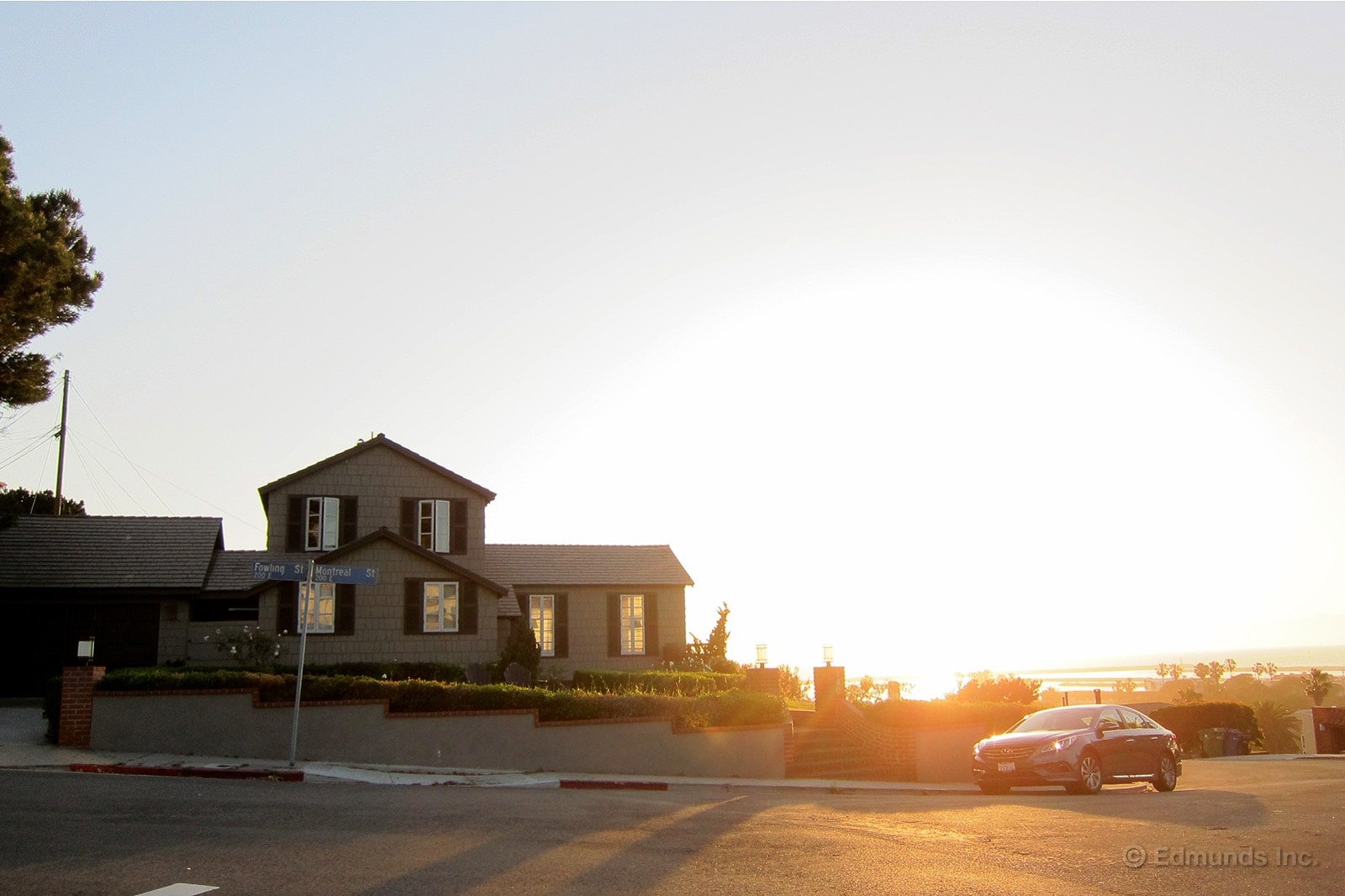
Some cars are just overrated. That's how I always felt about the previous generation Hyundai Sonata, which debuted in 2011. It was okay. Maybe even good. But great? Revolutionary? Special? Not really.
I didn't even think it was particularly attractive. There were better cars in its class, including the Kia Optima (which shared many of its components), the Honda Accord, the Mazda 6, the Ford Fusion and others. We had a long-term 2011 Sonata in our test fleet, which we drove about 20,000 miles. It was reliable transportation and others on our staff became quite enamored with it. I didn't.
Instead, I sat back in amazement as the Sonata was bestowed with praise and sales success. For five years it felt like every auto writer loved it and every midsize sedan buyer wanted one. Which brings me to our long-term 2015 Hyundai Sonata. This is an inspired car.
This time around, the Sonata is real competition in a very competitive class. It not only looks better, inside and out, it feels better, too. And it's not just the broad strokes. This time Hyundai's designers and engineers put some time in the details.
No, it's not a tire-ripping thrill ride. It won't get you privileges with the valet at your local Copacabana. But it's more than a comfortable, reliable, roomy sedan. Much more. This is a car that makes you feel good. Every time I drive it I'm impressed.
The suspension tuning is right on. Where the old Sonata was undersprung and underdamped, this one feels right regardless of speed and road conditions. It never feels harsh or unsettled and it provides one of the best, most comfortable highway rides in the midsize sedan class.
Hyundai has also figured out how to do electric assist steering in its front-wheel-drive applications. Earlier efforts were vague and felt artificial. Back then they dialed in "sticktion" on purpose, one Hyundai engineer told me. They finally decided that was just plain stupid. Nobody likes "sticktion" in their steering and the new Sonata has none.
I also love the new interior. It feels rich and high-quality, but not overdone. Not cartoonish. The seat and driving position are among the best I've ever felt and the design of the dash, console and all other controls and touch points are very much to my liking.
I can also throw endless praise on the Sonata's powertrain and exterior design, which will certainly age better than the look of its predecessor.
Hyundai is rolling. The Santa Fe, Santa Fe Sport and Genesis are all truly exceptional. The new Tucson looks great (I haven't driven it yet.). And now the Sonata is one of my favorites.
Finally, the products are actually as good as the potential and the promise.
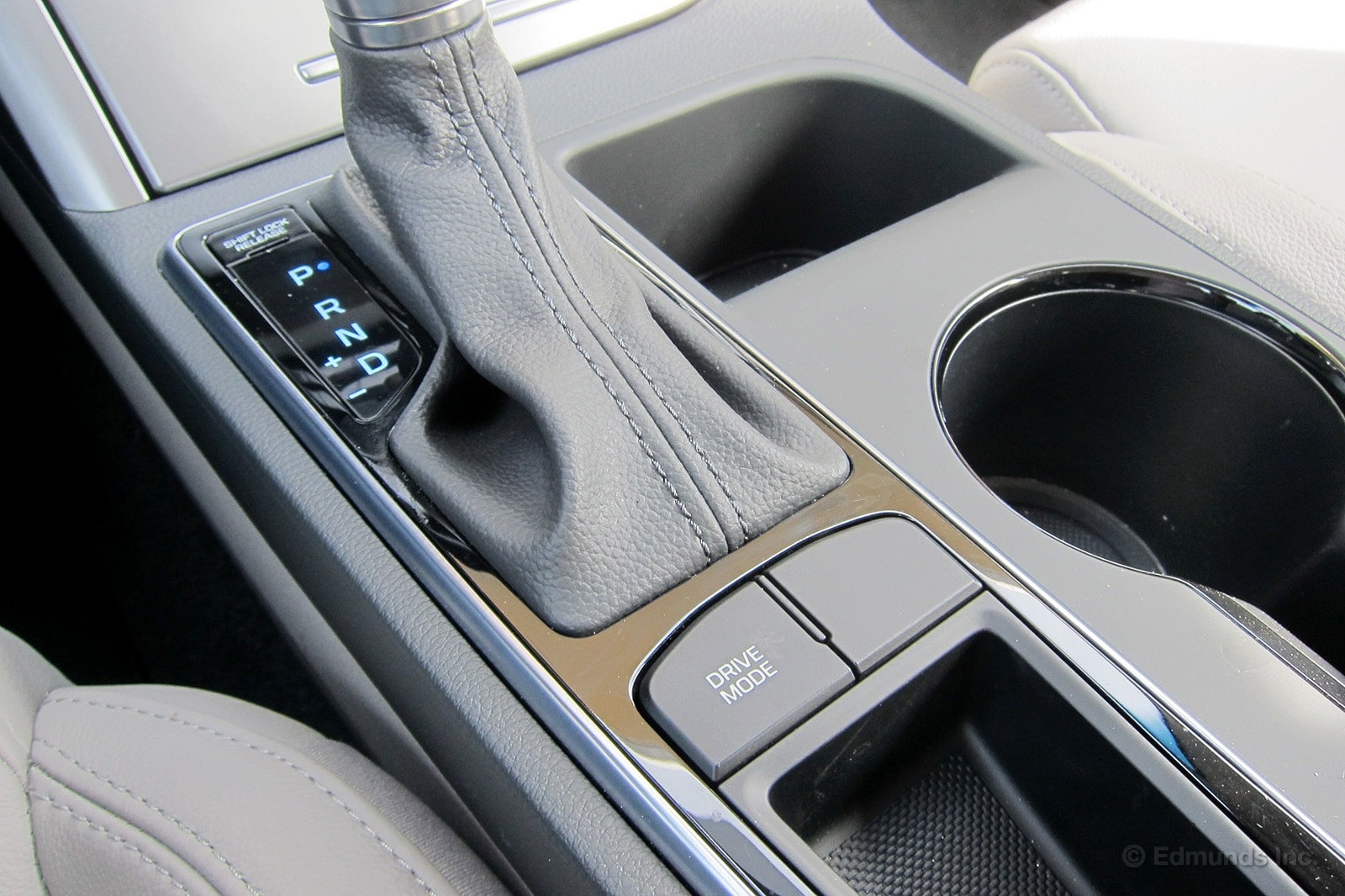
I've been driving our long-term 2015 Hyundai Sonata a lot, often choosing it over sexier, more powerful cars and I never regret it.
Sure, my kids think I'm crazy for passing up our long-term Jaguar F-Type and Ford Mustang GT to drive home in the Hyundai, but this is one of those cars that just feels right to me, from the shape of its seat, to its sightlines and steering feel.
However, I always drive it in Sport Mode.
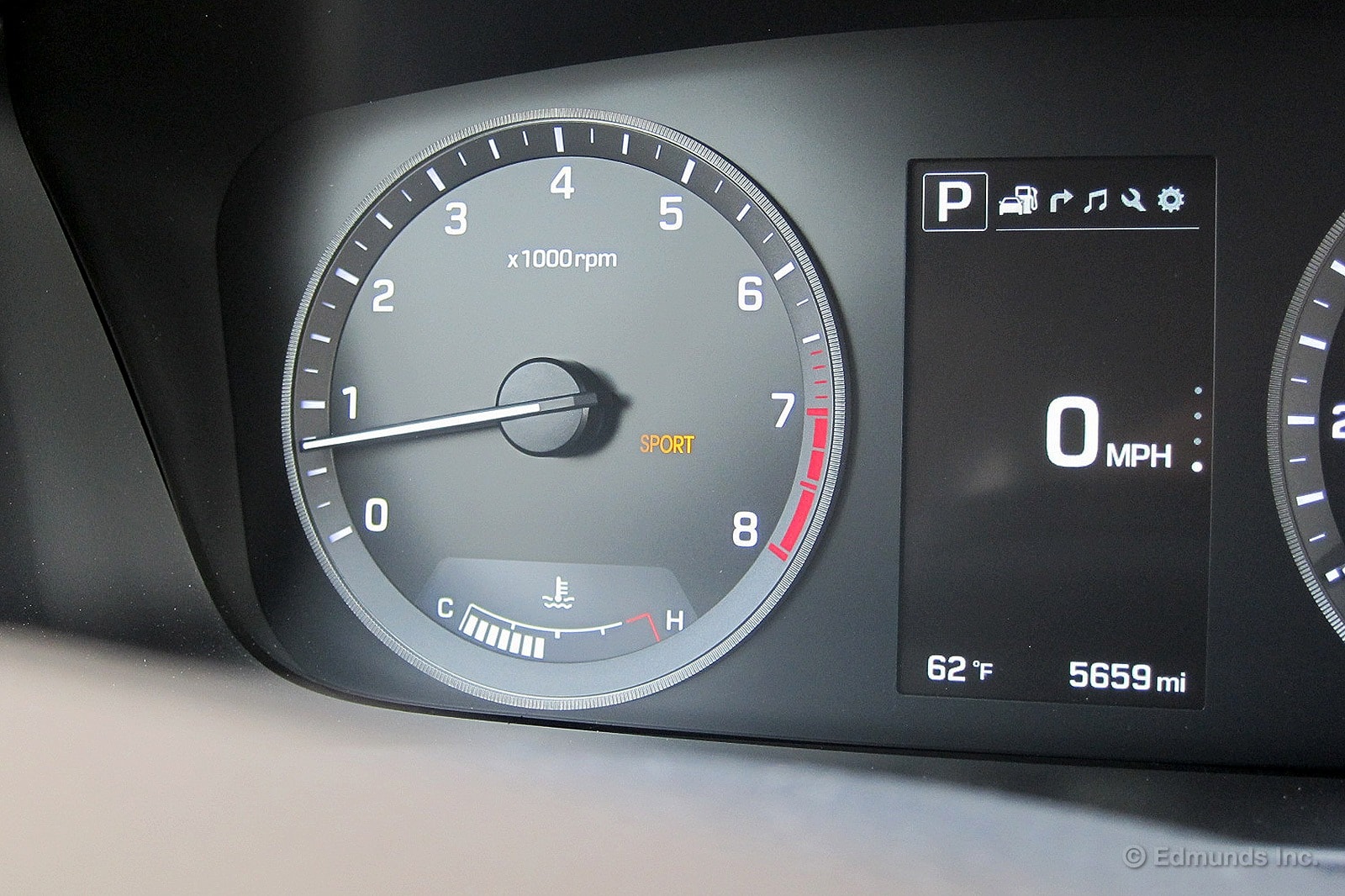
Like our long-term Kia K900, our Hyundai Sonata Sport has three driving modes: Normal (the default setting), ECO and Sport. To activate the ECO or Sport mode, you press the Drive Mode switch on the console behind the Sonata's shifter. Push it once for ECO, twice for Sport. And you must reactivate it every time you cycle the key.
I never use ECO.
In Sport Mode, the changes are subtle but preferable. The Sonata's throttle sensitivity and suspension tuning don't change, but its steering gets a bit heavier and, most importantly, the transmission holds gears longer, or as the owner's manual says, "Up-shifting is delayed."
As I said, the changes are subtle. Nothing is cranked up to eleven. The differences are just enough to give the sedan a little more response, a little more spunk. But that spunk comes with a warning. Two, actually. The Hyundai's owner's manual also states that if Sport Mode is activated, "after accelerating and releasing the accelerator pedal, the gear and engine speed RPM may not drop as soon as in NORMAL mode."
Of course, any real driver will tell you that's exactly what you want.
The second warning simply reads, "In SPORT mode, the fuel efficiency may decrease."
Duh, that's what ECO mode is for.
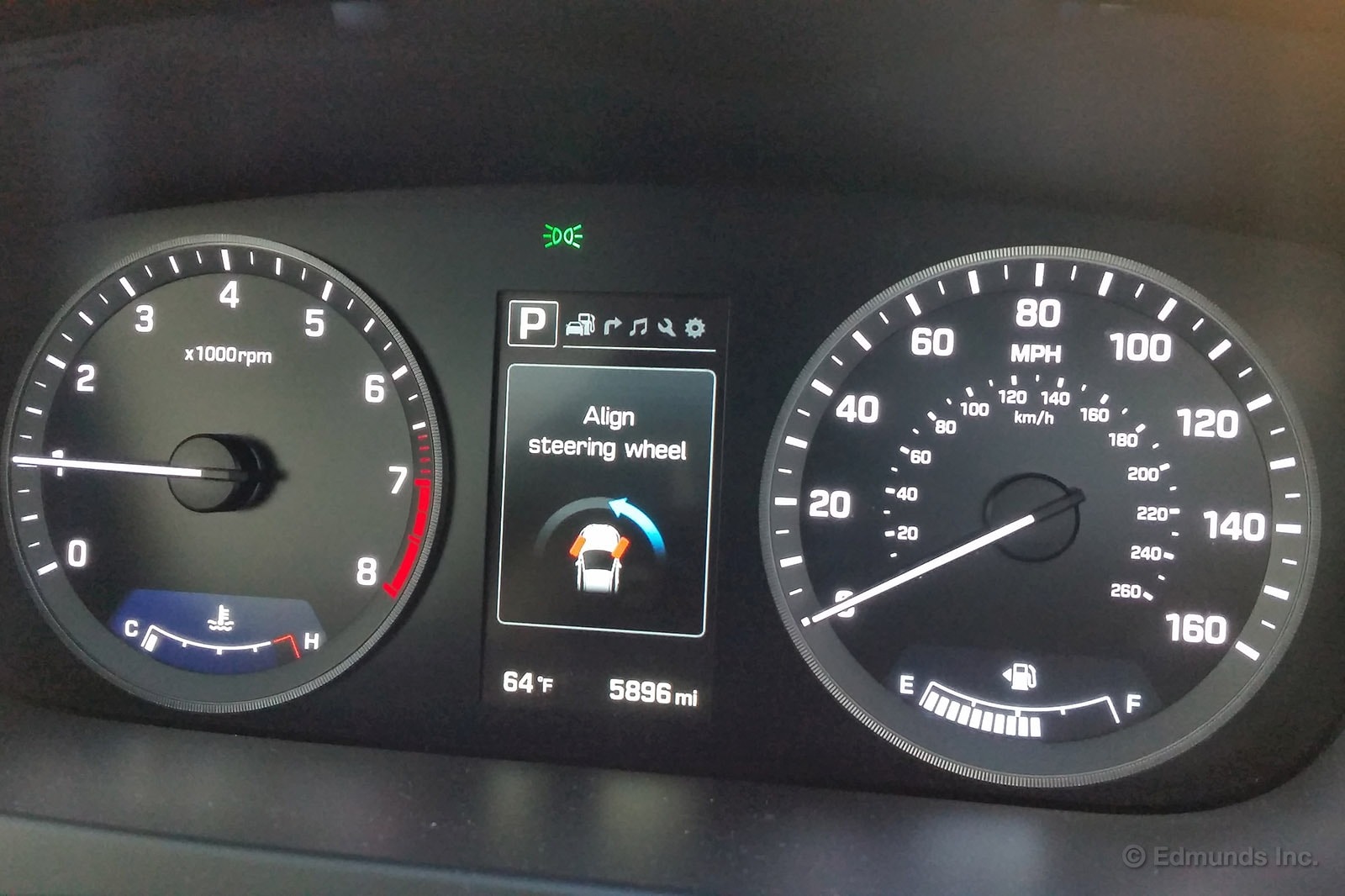
Parking on a hilly street the other night, I left the wheels of our 2015 Hyundai Sonata turned in toward the curb. When I got back in the car, the Hyundai quickly flashed me this message:
"Align steering wheel."
In fact, the message flashed so quickly, I had to restart the car to read what it actually said. Maybe you know other vehicles that issue this warning? It was a first for me.
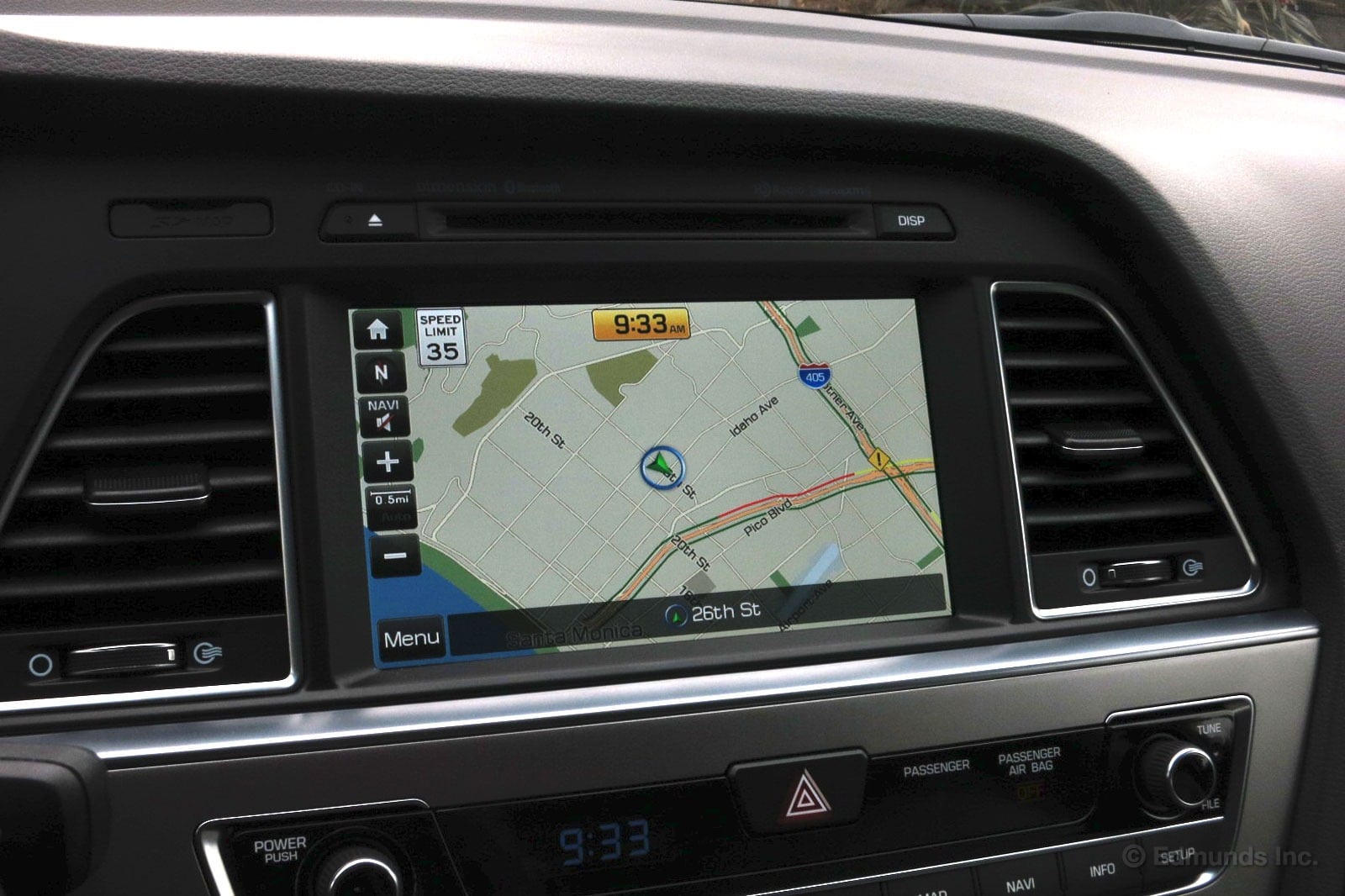
You would think most manufacturers would have the whole navigation thing down to a science by now. You would be wrong. Some are too clever for their own good while others use logic that isn't very logical. The setup in our 2015 Hyundai Sonata is one of the better systems I've used in a while.
It's easy to use, delivers clear directions and it helps that the screen itself is large, clear and easy to read. Inputting destinations is also dead simple thanks to a touchscreen interface and the ability to start with any piece of information you want. Some systems don't want to do anything until you put a street name in first.
I also like the way it splits the screen when a turn is coming up to show you a zoomed view on the right side while keeping a wide view on the left. That's not unique to this system, but this functionality makes it easier to follow than most. And even when you're not using it for turn-by-turn directions, the map is clear and the traffic flow indicators are easily decipherable. Can't say the same about BMW's system that shows way too much info in this regard.
I'm sure there are elements of this system that aren't perfect, but from my experience so far, it's a worthwhile addition to this family sedan.
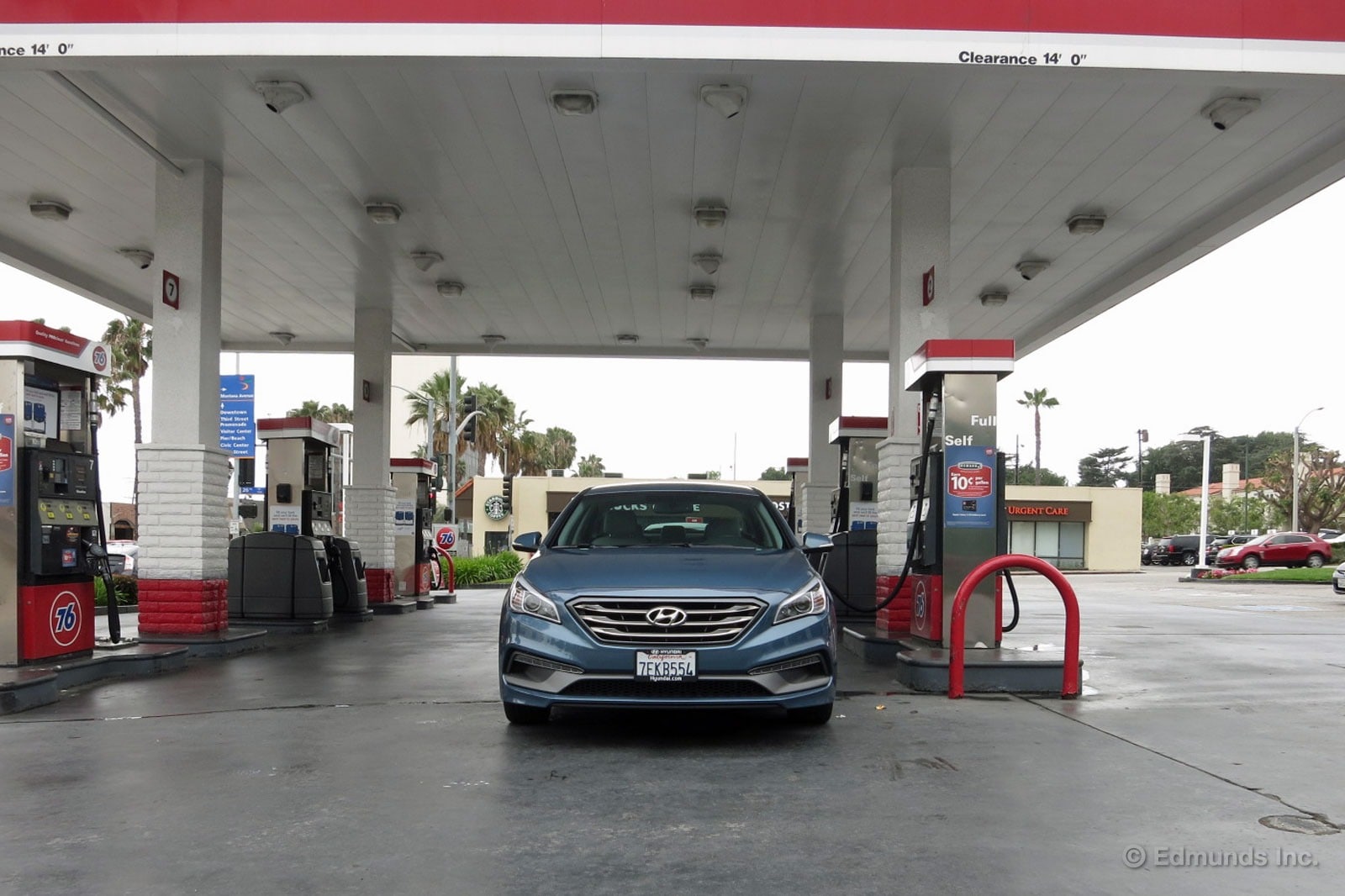
It was a rather uneventful month for our 2015 Hyundai Sonata. We only added around 500 miles to its odometer and most of those were in town. As a result, it turned in one of its least-efficient tanks so far at just 17.5 miles per gallon. That dropped its overall average to 24.7 mpg, which is well below its rated number in combined driving.
So it didn't impress much in terms of its mileage, but it did impress in other ways. Editor-in-Chief Scott Oldham found several reasons to like our Sonata, while our staff in general liked it enough to give it an "A" rating, at least for the 2.0-liter turbo and Eco models. Our Sport model with the standard engine only earned a "B". Check the ratings pages for full explanations.
Worst Fill MPG: 17.5
Best Fill MPG: 31.7
Average Lifetime MPG: 24.7
EPA MPG Rating: 28 Combined (24 City/35 Highway)
Best Range: 370.4 miles
Current Odometer: 6,067 miles
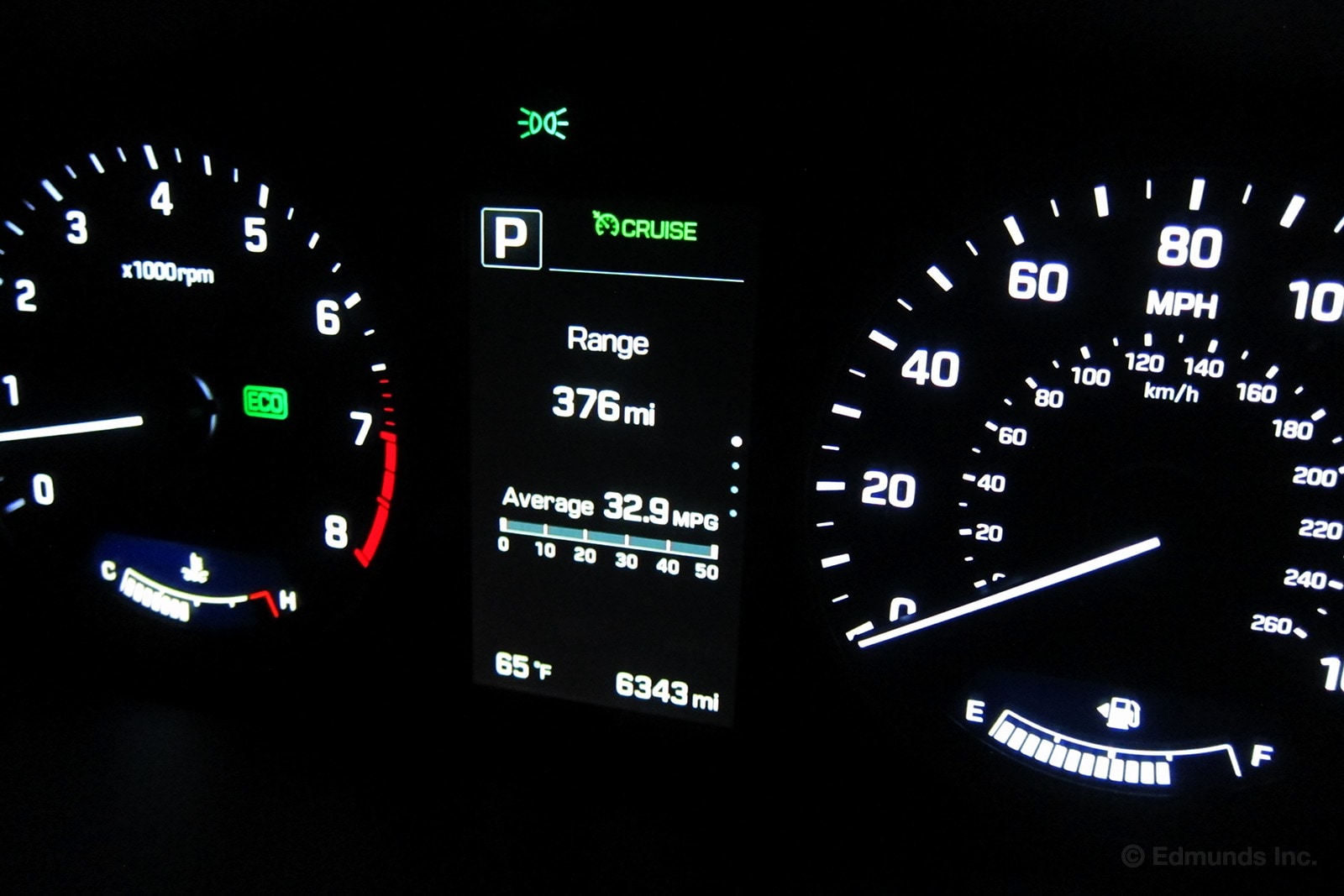
Somebody has to drive our 2015 Hyundai Sonata in Eco Mode. The boss ain't gonna do it. Might as well be me.
With 60 mostly-highway miles ahead of me and light, nighttime traffic, I figured this might be a good time to try out Eco mode. In this scientific, controlled experiment, I simply wanted to see if I could endure the commute tethered to the electronic ballast, namely duller throttle and lower rpm upshifts.
It wasn't so bad.
I drove as I normally would, kept pace with most traffic, and overtook slower cars. I set cruise whenever I had an open lane and made little concession to hypermiling. Overtaking maneuvers required a little more forethought, with a gradual roll on the throttle to gather momentum without triggering a gas-gulping downshift.
There's distinct throttle mush when comparing Eco and Sport modes, but less so between Eco and Normal. Likewise, steering doesn't feel all that alien between Eco and Normal, but there's noticeable weight when you switch to Sport. But upshifts are really the biggest difference between Eco and Sport. In Sport, the automatic transmission lets you wring out the revs to 4,000 rpm or more before upshifting. In Eco, it upshifts at around 3,000.
When I left the office, the onboard computer showed average MPG at 28.4. At one point, it had climbed to mid-34's, just shy of the Sonata's 35-mpg highway rating. When I reached home, the computer cooled to 32.9.
Granted, these trip calculators aren't a precision measurement, but all things being equal, I considered an increase of 4.5 miles per gallon over a 60-mile trip - a mile "earned" every 13.3 miles being one way (maybe a flawed way) to think about it - a mild success.
The next day, I drove back to the office in Sport mode.
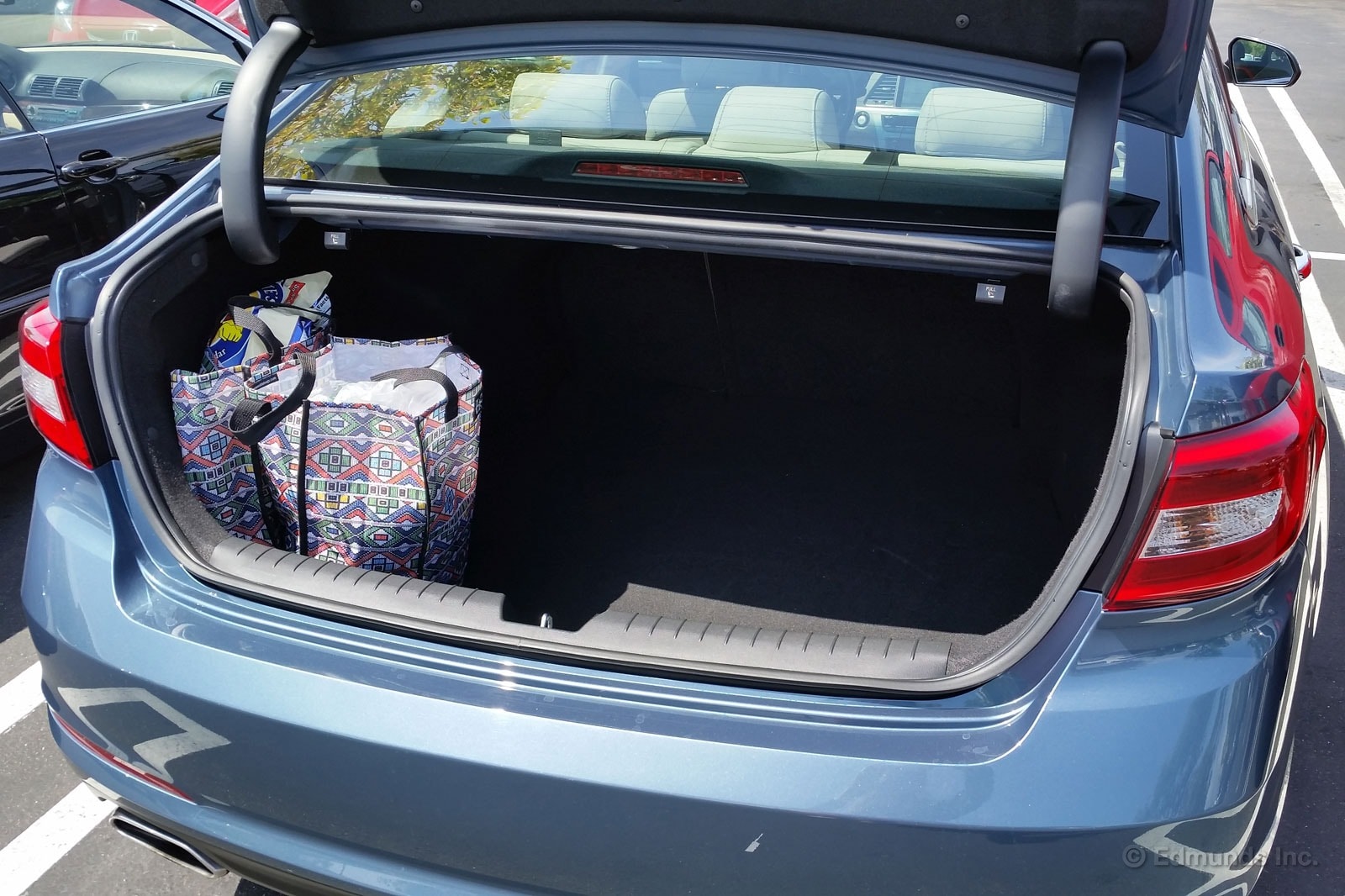
It's not the first time we noted the 2015 Hyundai Sonata has intrusive hinges in its cargo area. But today I realized just how annoying the Sonata's trunk setup can be.
With no cargo nets to hold my two grocery bags in place, the next best thing was to prop them in the trunk's corner.

Directly under the grocery-smashing hinges.
Hello, Pirate's Booty puree.
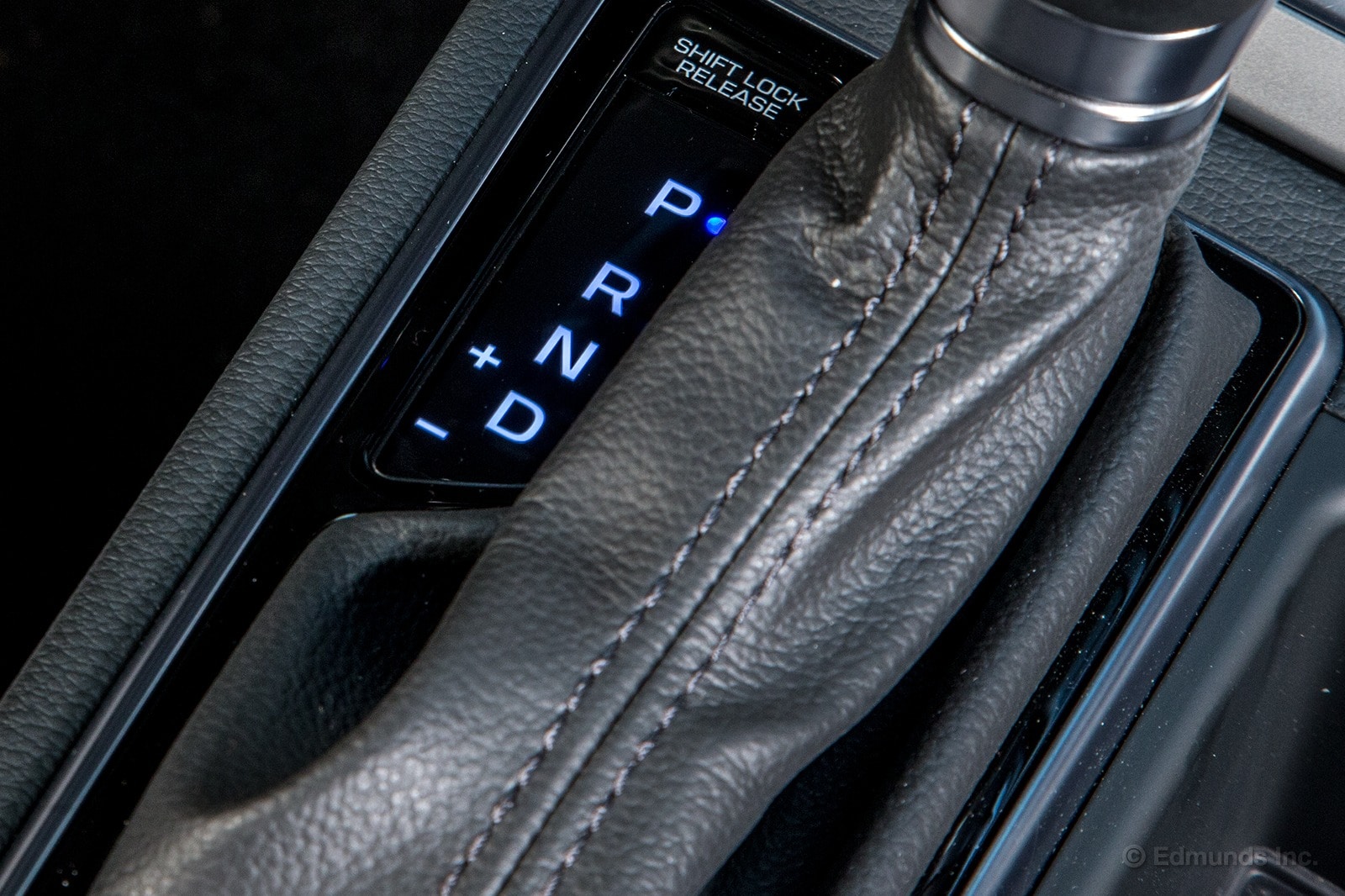
I got our suitcases into the trunk and my suit on the coat hook. The wife and I were finally ready to take our 2015 Hyundai Sonata six hours north to San Francisco for a wedding. Little did I realize it was graduation weekend for many universities.
I've made this journey, literally, a couple of hundred times in the last 17 years. The fact that I know every landmark relative to arrival time makes it that much more painful when the roads are clogged.
This trip was going to suck. Both ways.
Interstate 5 is two lanes in each direction, which means traffic gets backed up plenty by trucks. A long line of cars gets stuck behind the grandma going half-a-mile-per-hour faster than the truck she's trying to pass, while the guy in the M5 hangs so close to your rear bumper you can tell what aftershave he's wearing. It can get rather stressful.
In hectic situations like this, I thank the Hyundai engineer gods for Shiftronic. Trying to maintain the train of cool while passing the convoy is easily upset by the constant use of brakes. The Sonata's quick and responsive 6-speed Shiftronic made things so much easier. I could glide at a safe distance with little use of the brakes. This is a key stress relief in a near 400-mile traffic jam.
On the engine side, I'd agree with many other editors. The Sonata' s 185-horsepower, 2.4-liter four is respectable, but not impressive. It gets loud when making spirited highway passes, and it doesn't have the power to make many of the passes I'd like to make, but it does the job.
The only hiccup I had was after starting the Sonata for out return trip. There seemed to be a buzz coming from the engine bay. The sound reminded me of a loose fan shroud. I popped the hood and poked around, but couldn't pinpoint the noise. After the car warmed up, the rattle seemed to go away. Maybe the dealership can find the naughty bit of plastic at our next service interval.
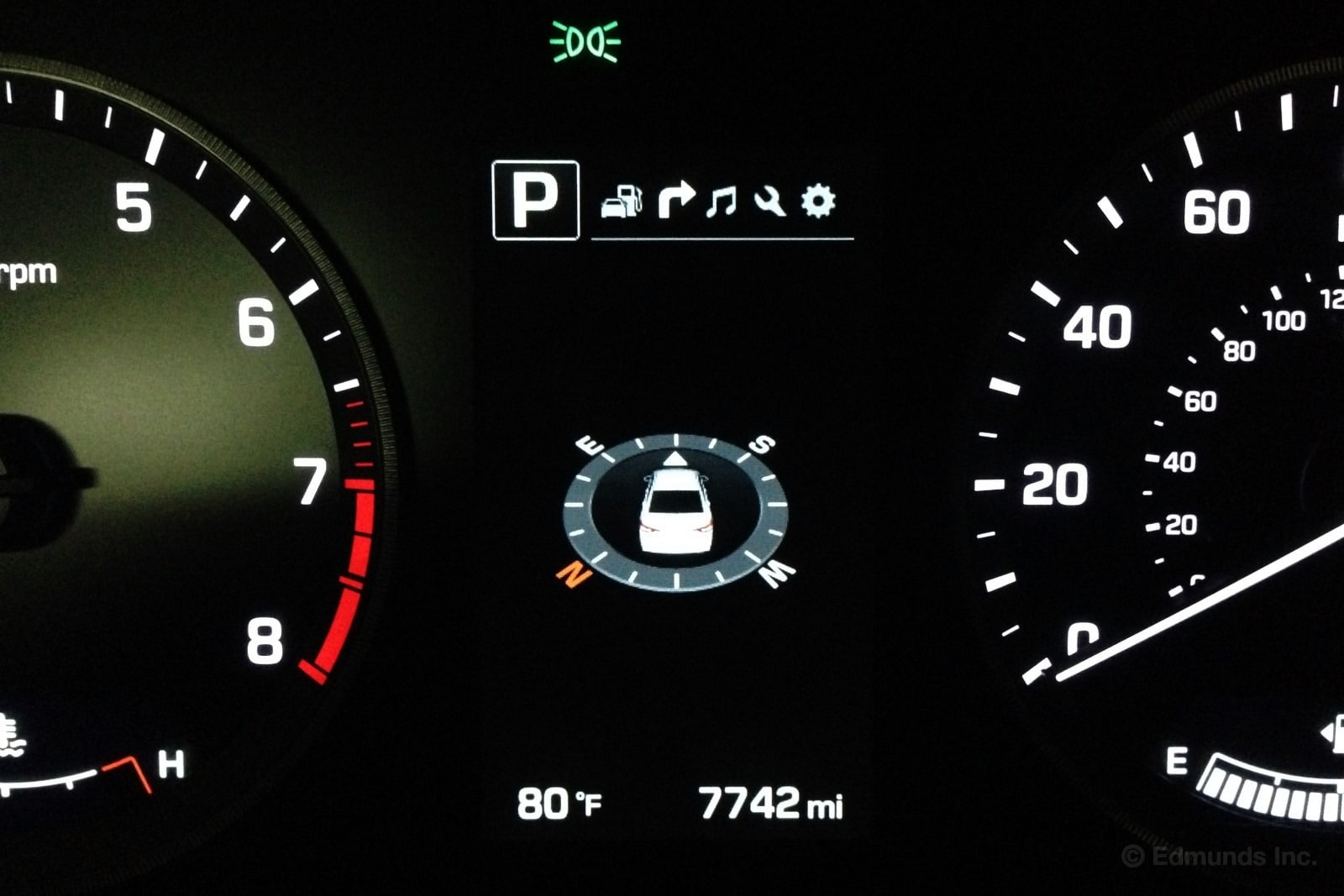
You know what doesn't much matter in the grand scheme of things, but bugs me anyway? A lot of stuff, actually, but in this case, it's when a high-resolution central infotainment display is paired with a back-to-basics trip computer in the gauge cluster.
I'm looking at you, Honda Accord.
In fact, the 2015 Accord's standard 8-inch central display can be supplemented with a separate touchscreen that slots in below it. Dual screens, dude! But you get the same simple trip computer either way, with a circular housing that reminds me of those digital Casio watches I used to collect in seventh grade. They were pretty cool. In 1993.
Happily, our 2015 Hyundai Sonata gets this detail right.
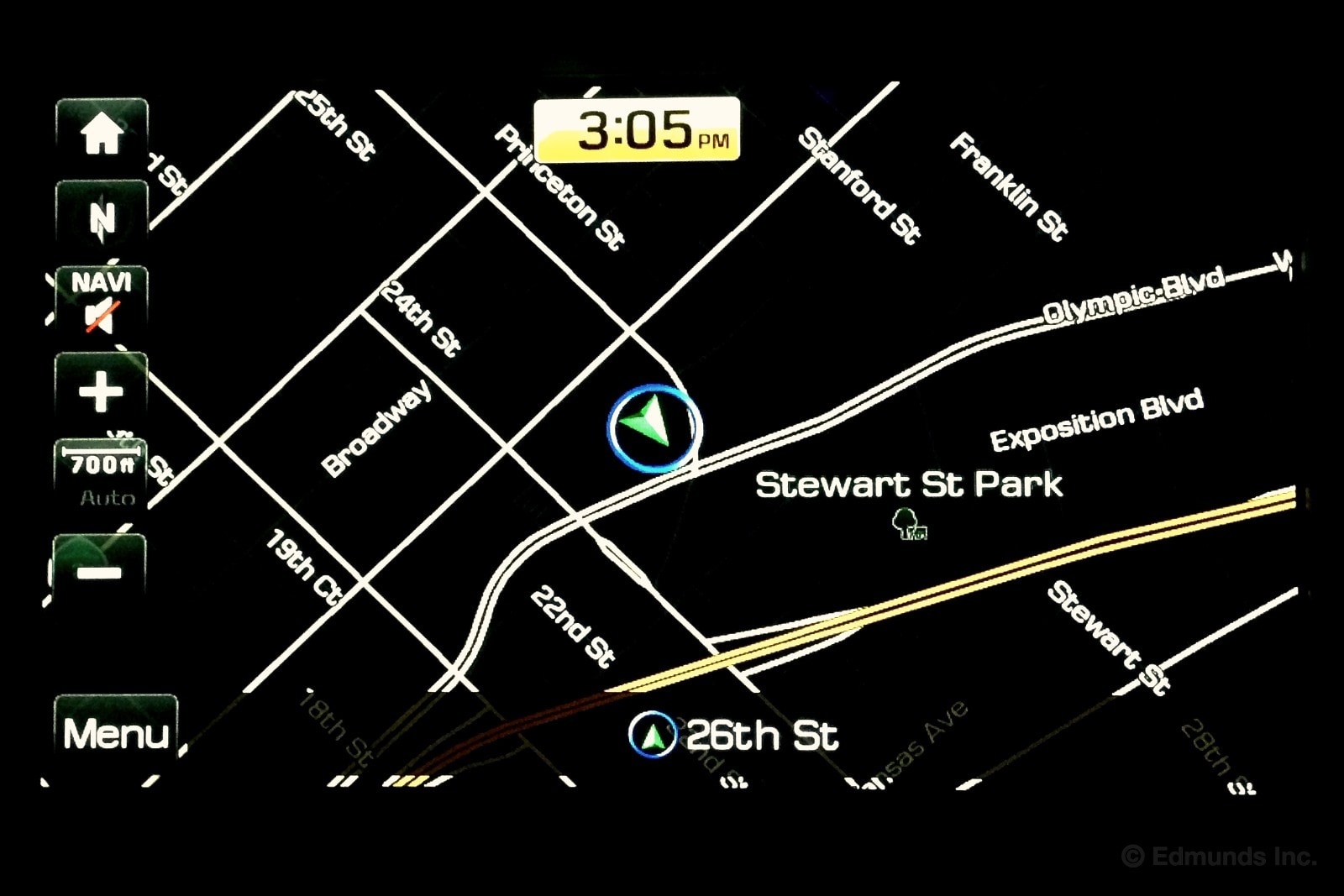
It's worth noting that our test car's 8-inch touchscreen with navigation (above) and 4.2-inch color trip computer are part of the optional Tech Package for Sport, so not every Sonata comes this way. But on models so equipped, these interfaces are in perfect sync.
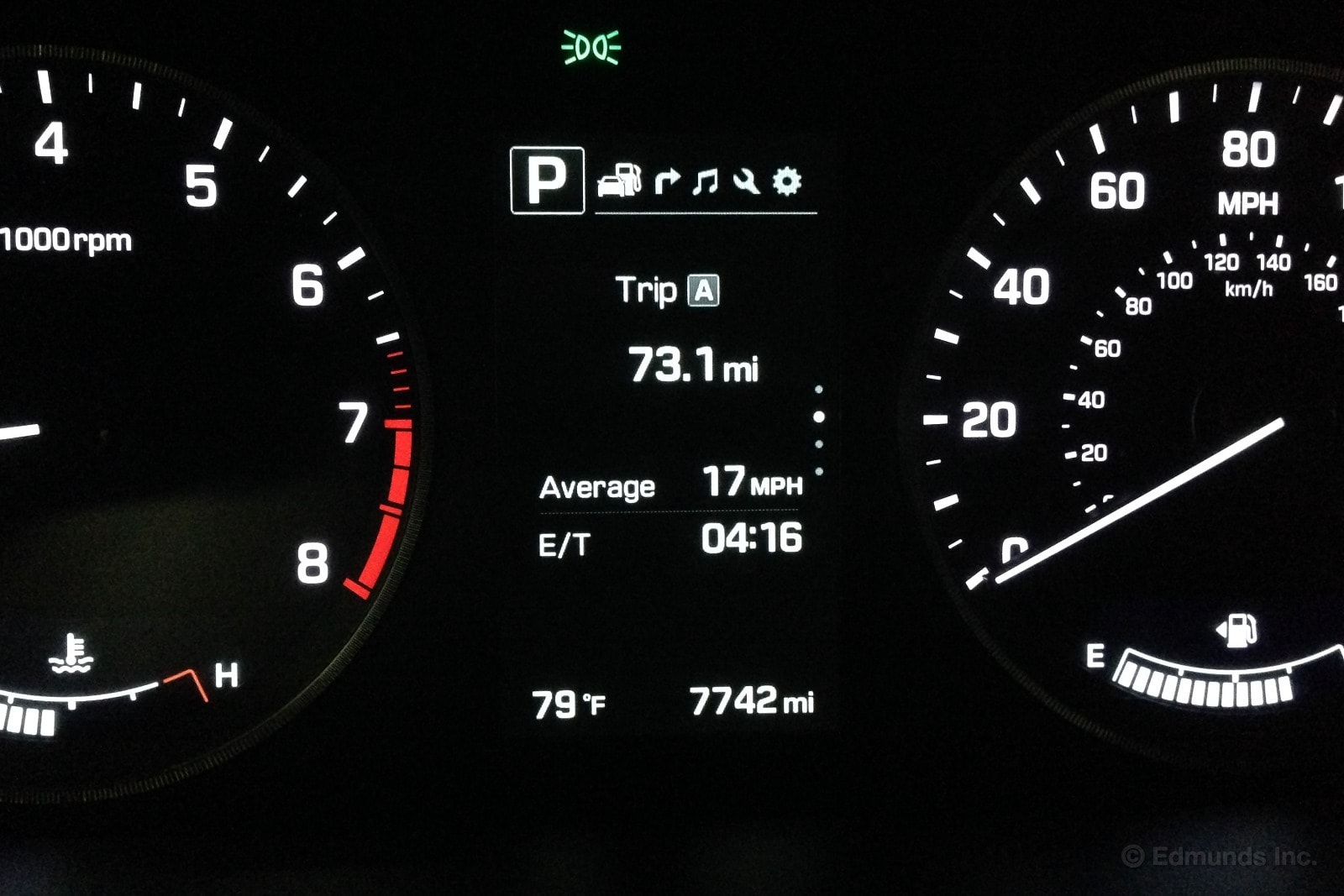
They use the same smooth font and the trip computer even has some graphically interesting icons up top to tell you what mode you're in. You can immediately tell that both screens are part of the same sophisticated system, as opposed to an Accord-style technological mismatch.
It may not matter much to most people, but it's one of those nice little touches that could clinch a conquest sale for Hyundai.
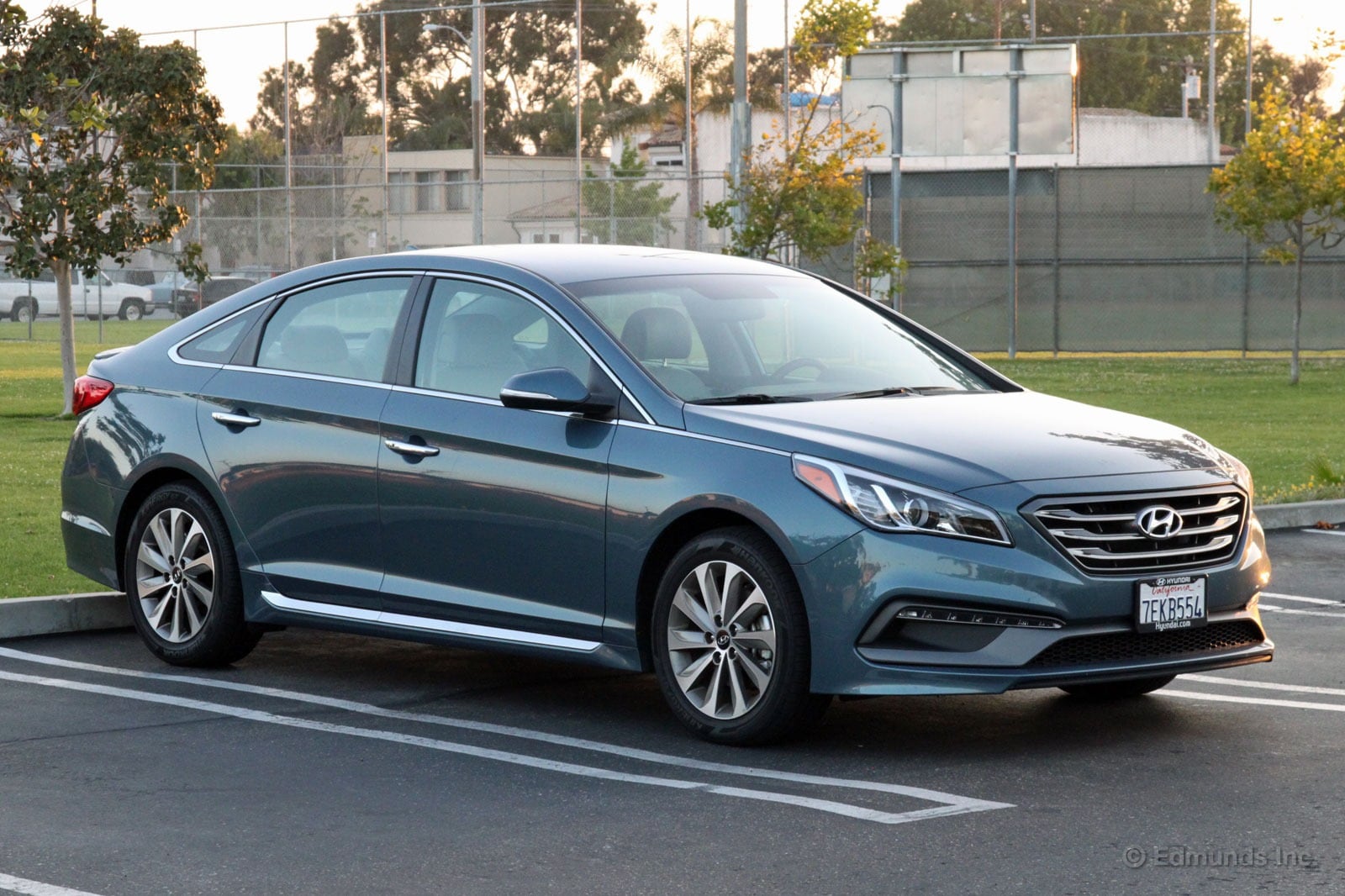
Since the day it was revealed to the public, the 2015 Hyundai Sonata has taken hit after hit for its conservative styling. It was inevitable. The previous model was almost universally loved for its extroverted styling. It put the Sonata on the lists of buyers who might have otherwise overlooked it, which was precisely the point, of course.
This time around, Hyundai dialed back the styling.
Although it's not quite so memorable, I still find it handsome. It's a more mature-looking sedan. It's not trying so hard to stand out, yet still looks distinctly different from segment leaders like the Honda Accord and Toyota Camry.
It has tasteful chrome trim, expensive-looking wheels and LED marker lights that give it a distinctive look at night. For a $24,000 car, I'd say it looks pretty nice. Will it go down as one of the more distinctive midsize sedans in recent memory? Uh, no. But if I'd just spent $24K for one, I'd feel pretty good about what I got for my money every time I looked at it.

After a slow April, our 2015 Hyundai Sonata racked up nearly 1,800 miles in May. Scott Jacobs gets credit for many of those miles thanks to a trip to northern California. He found that he liked the manual shift feature even if the engine wasn't always strong enough to make a pass.
The extra miles helped out the Sonata's overall mileage number as it climbed from 24.7 to an even 25.0. That's still a few cry from EPA number of 28 mpg in combined driving. We're not surprised by that number as most of us drive the Sonata in its "sport" mode more often than its "eco" mode. Editor Dan Frio tried the latter and got some anecdotal evidence that it works.
Other than its mileage-related posts, the Sonata didn't make too many waves. Editor Kelly Hellwig found that its trunk hinges aren't kind to groceries while I noted that it has one of the better navigation systems when it comes to user-friendliness.
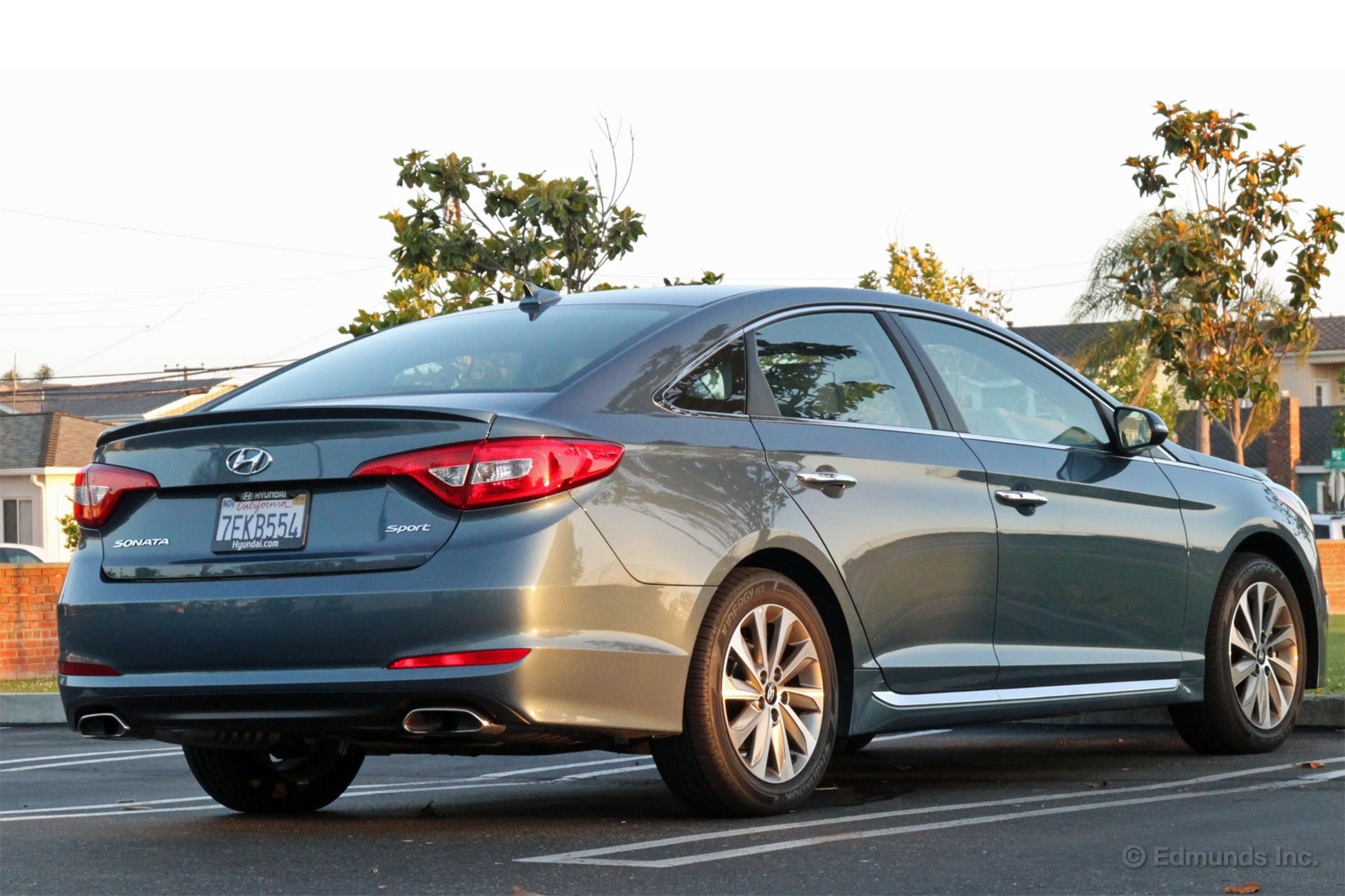
Whenever I picture our long-term 2015 Hyundai Sonata in my mind, I see it as a silver car. I'm not sure why, since our test car is actually a very fetching shade of blue. Noveau Blue, to be exact.

It's the kind of blue that looks brightly iridescent in full light, but downright comfortable and denim-y in low light.
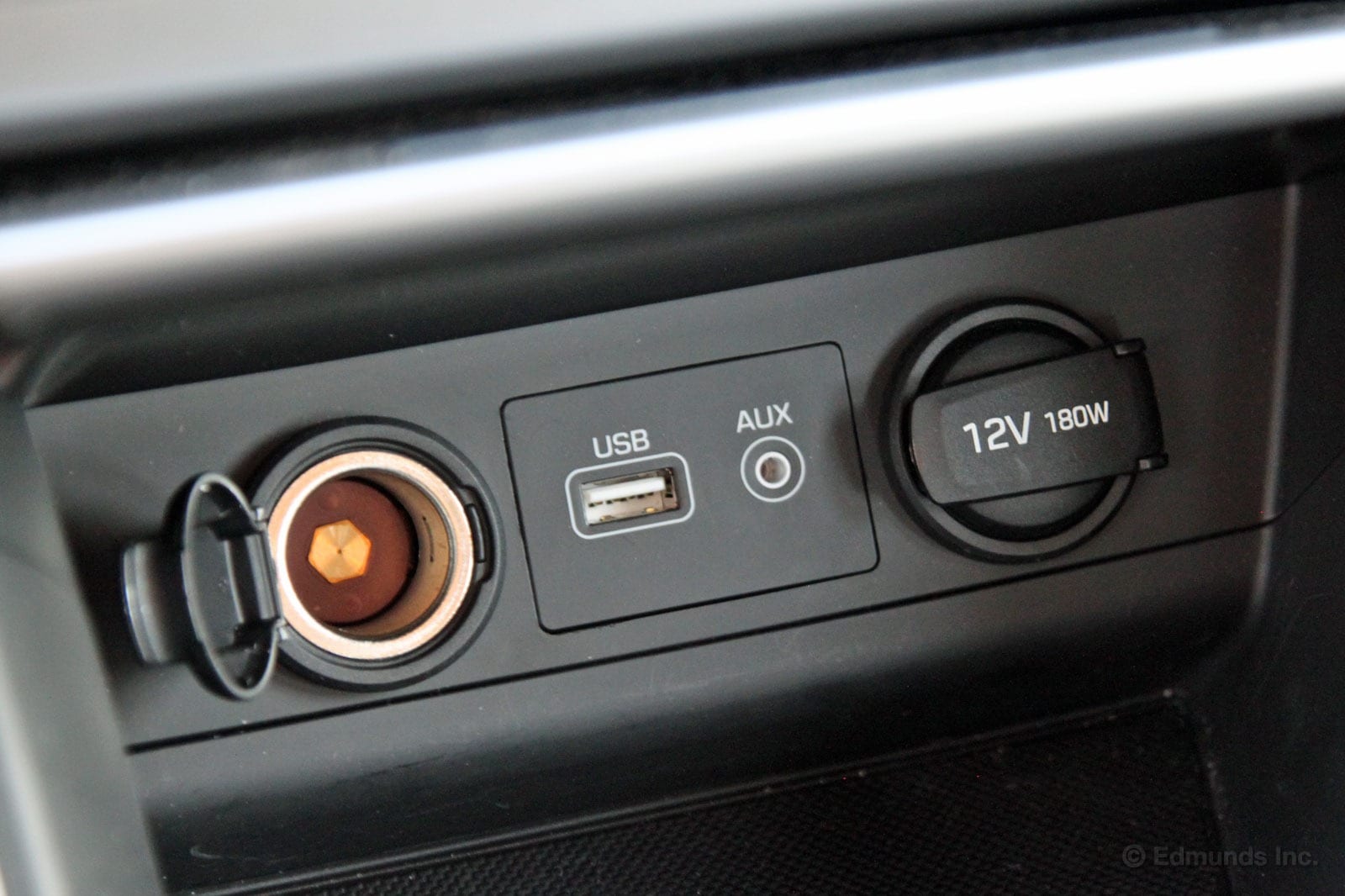
Just about any new car has at least one USB port these days. They're great for loading music or charging a phone, but they have their limitations. I tried to top off my iPad with this port in our 2015 Hyundai Sonata, only to receive the "not charging" message, which roughly translates into "this port will take three days to charge your iPad."
Like most USB ports in new cars these days, the connection in our Sonata is of the low power variety, specifically 500 milliamps at 5 volts. For comparison, the wall charger that comes with the iPad delivers 2 amps at 5 volts. Excuse the semantics if I have that wrong.
As convenient as USB ports are in modern cars, you have to be aware of their limitations when you hop in and start plugging in stuff. In this case, I would have been better off using a charger plugged into one of the 12-volt cigarette lighters. There are plenty of those chargers available that deliver more than enough amperage to bring an iPad back to life, not to mention your phone, too. It's just a matter of remembering to keep one on board.
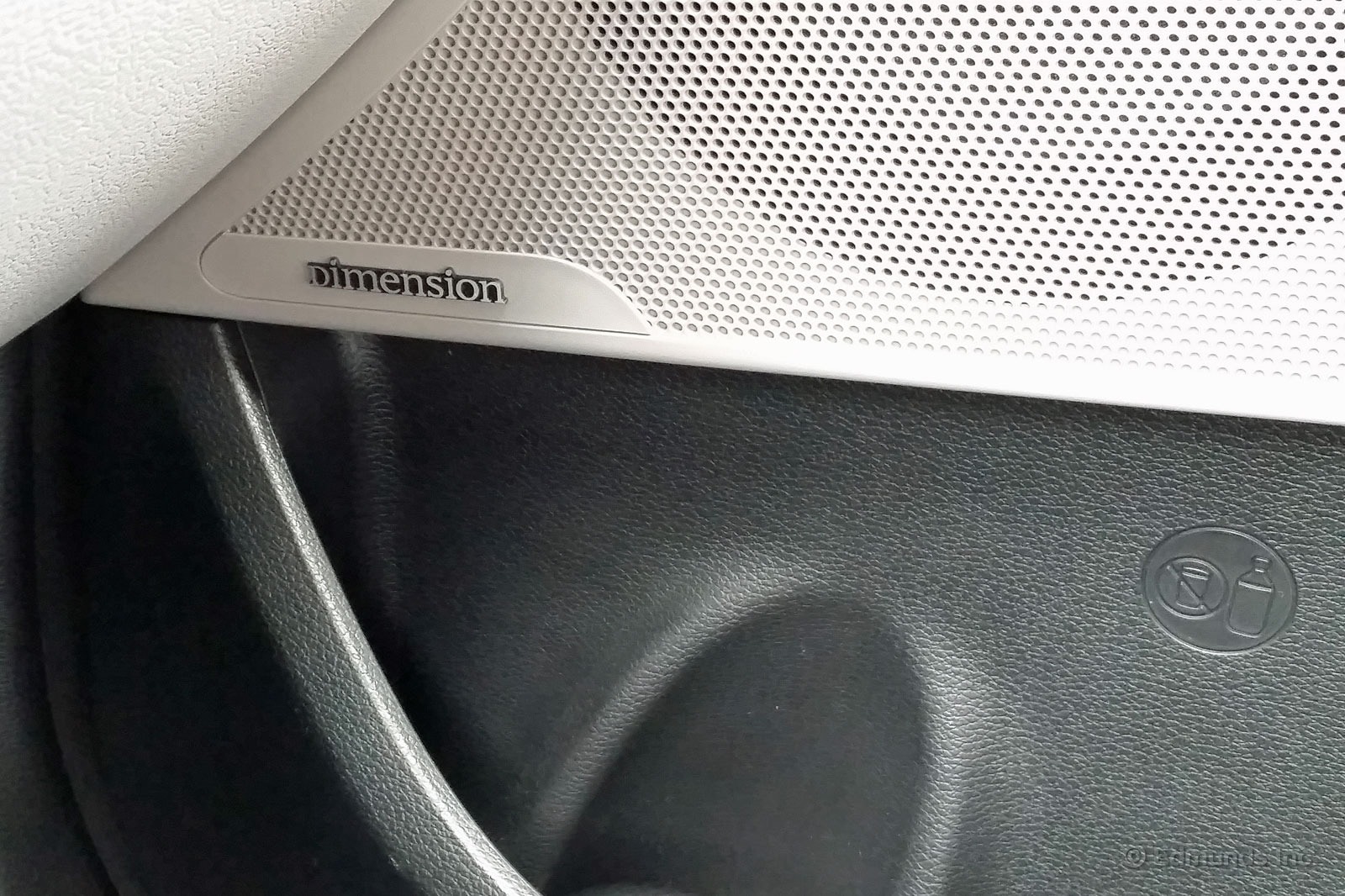
Good sound doesn't have to carry a big label. I realized that when digging into the stereo system in our 2015 Hyundai Sonata. While sitting in traffic, drumming on the steering wheel, I glanced at one of the car's front speakers to see what brand Hyundai selected for its midsize sedan.
"Dimension." What's that?
I headed straight to Google, thinking it'd be easy to find out what big-name maker was behind the Dimension label. After a few fruitless searches, I clicked on an old Edmunds' stereo review of the 2011 Sonata GLS.
My "ah, ha" moment came when I read this:
"Don't worry if you never heard of the brand because Hyundai just made it up. But sound-wise it can hold its own — and then some — with more familiar audio imprints."
Validation on two points: 1) I'm not the only one who is unfamiliar with the brand, and 2) our former stereo expert agrees that the Dimension system is in fact, a good one.
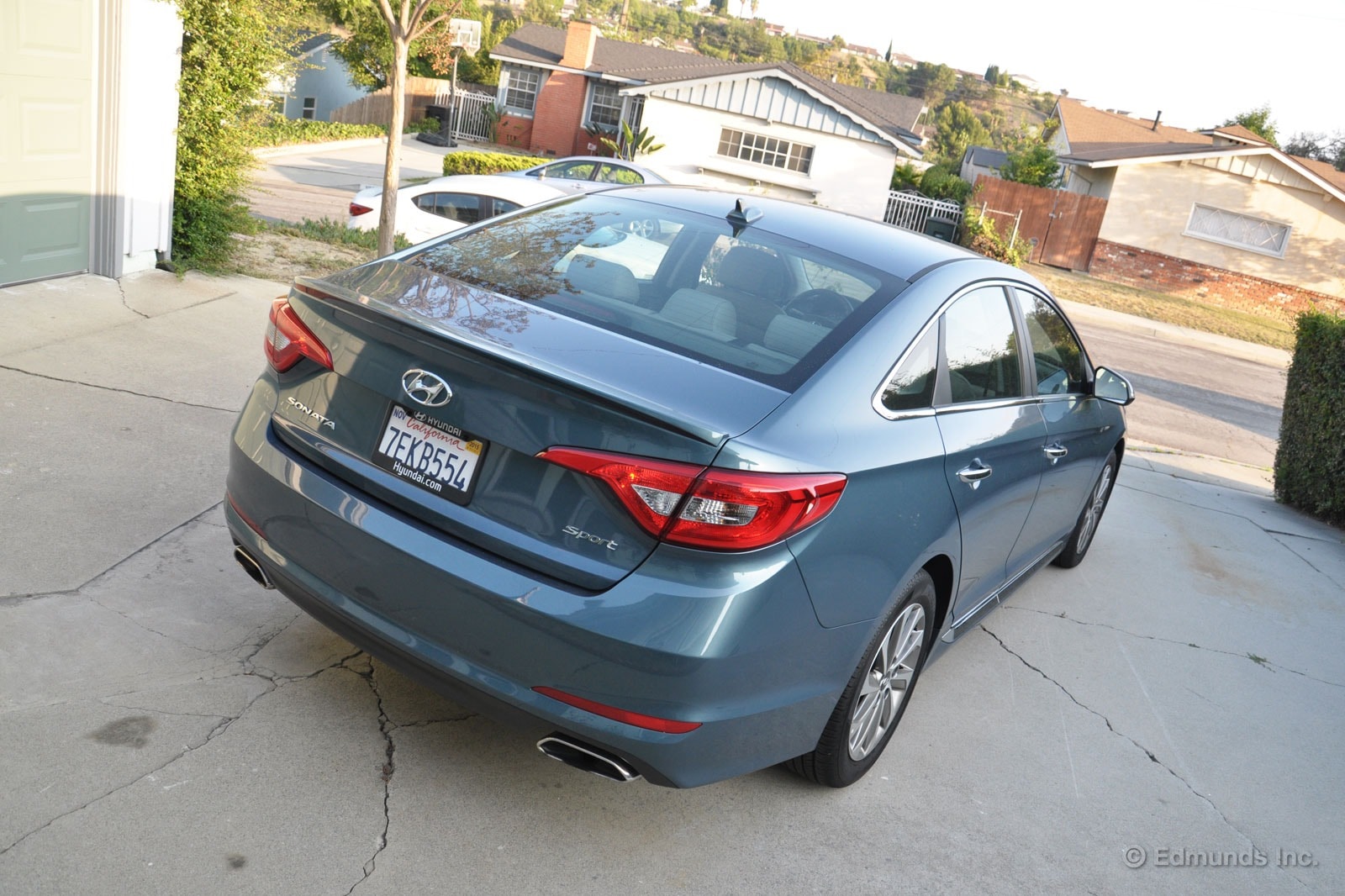
I'm beginning to get attached to our long-term 2015 Hyundai Sonata, and I certainly didn't expect that. As I circled through our company parking garage last week, I realized I was looking forward to my afternoon commute in the Sonata.
As I've previously written and as Scott Oldham has said, the Hyundai engineers did a nice job with the steering in this car. There's a precision that you notice as soon you turn the steering wheel (which, by the way, feels like it has a smaller diameter than the previous-generation Sonata's wheel), and that whets my appetite for the rest of the drive.
I really have no complaints about the ride, either. It's composed and the suspension absorbs most of the small ripples and dips that don't require my attention. This is not something I could say about earlier Sonatas.
Like Ed Hellwig, I'm content with the acceleration you get with our car's 185-horsepower, 2.4-liter engine and six-speed automatic transmission combination. Although our 8.2-second zero-to-60-mph time during instrumented testing isn't especially quick for a modern midsize sedan with a base four-cylinder engine, this isn't a reason to take the Sonata off your shopping list.
That said, the engine has an audible drone at highway cruise that bugs me from time to time. If I'm engrossed in a baseball game on AM radio, I'm oblivious to it, but if I'm only half-listening to public radio, I totally notice it. I haven't isolated exactly when it occurs (specific speeds, that is), but to date it's the only thing I don't like about driving the 2015 Hyundai Sonata.

The Whitney Portal Road in Lone Pine, Calif., which climbs to an elevation of 8,400 feet along a twisting road, was a great test for our 2015 Hyundai Sonata. The sedan handled the hairpin corners with confidence and the brakes never faded, keeping us from going through the guardrail and down into oblivion.
But one part of the package was missing: power.
I put the six-speed automatic transmission in manual mode, shifted all the way down to second gear, but the 2.4-liter four-cylinder engine still felt completely winded. And when I parked at the portal and shut it down, the air was filled with the alarming smell of hot metal.
I've made this climb in many other cars and was never so aware of the lack of power. To be fair, there were four guys in the car, and the hot temperatures and thin air would cut the performance of many cars.
Two of the Sonata's competitors, the 2015 Toyota Camry and the 2015 Honda Accord, share similar horsepower ratings (the Camry comes in with 8 fewer hp and the Accord ties its four-cylinder engine to a CVT). I'm interested to see how those cars would handle the same climb.
I'd say that 95 percent of the time, the Sonata's 185 horses would be adequate. And if I had to choose between power and fuel economy, I'd opt to save gas. But if I traveled into the mountains often, this probably wouldn't be my choice.
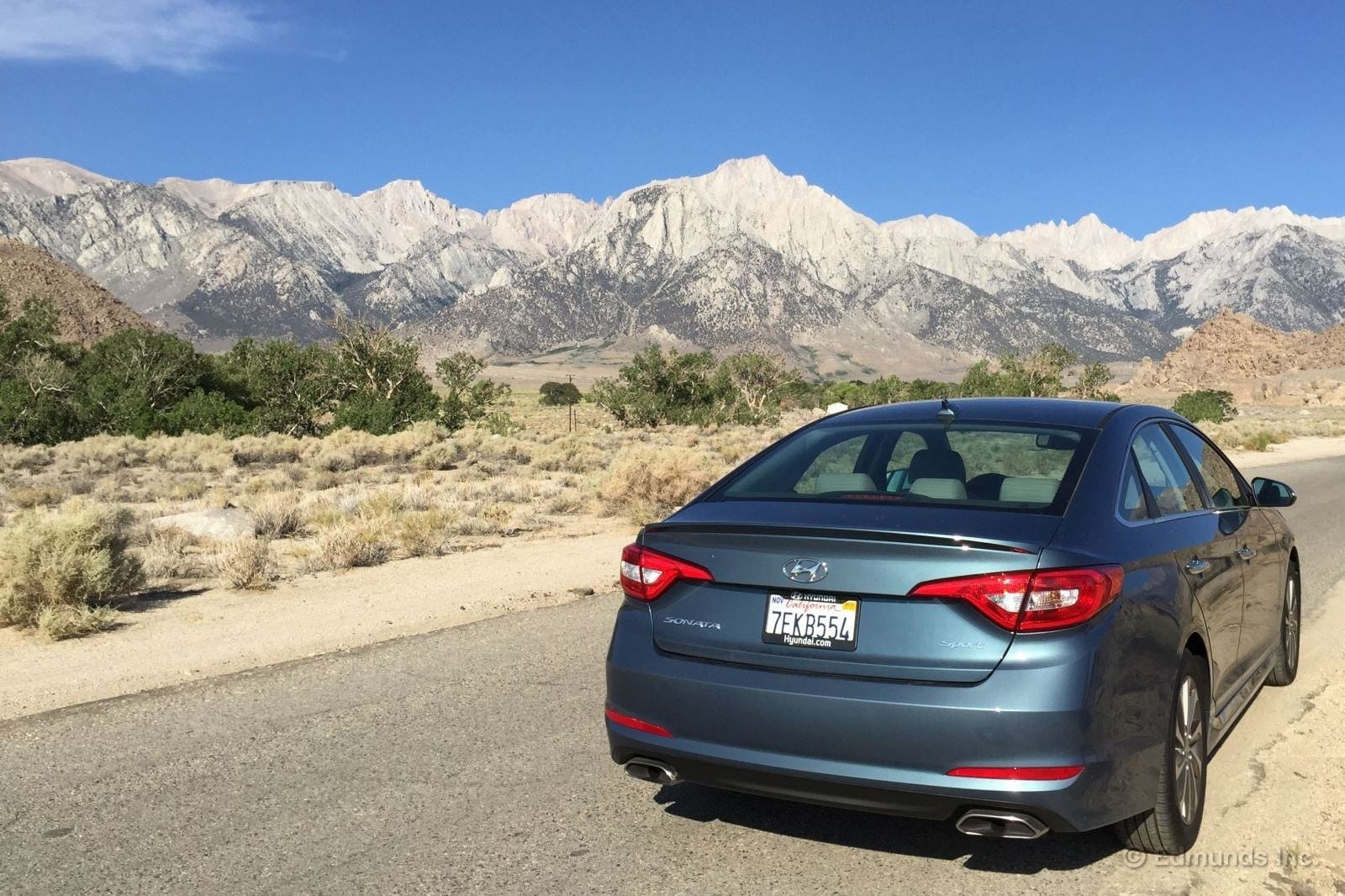
I pick up my wife from her job every day, and when I showed up in the 2015 Hyundai Sonata, her face lit up. "Nice car!" she said, getting in. "How do you like it?"
At that point, I'd only driven it home, but I was planning to take it on a short road trip. So I didn't have a ready answer for her. But as I drove over 600 miles, up into the mountains and California's Owens Valley, I kept a list of pros and cons.
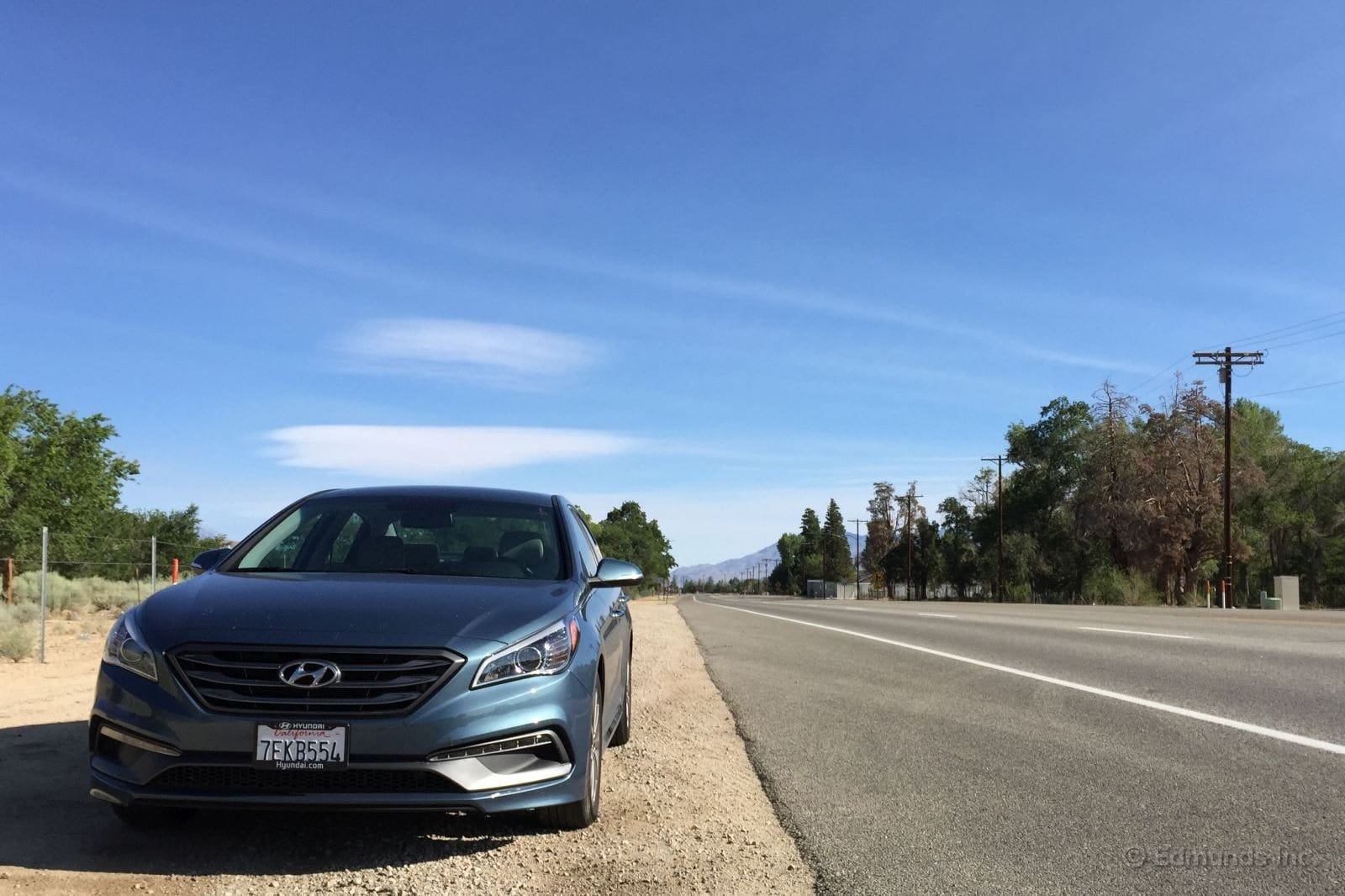
I'll lead off with the positives:
-As my wife pointed out, the Sonata has a striking design, especially in this beautiful blue
-It's roomy, with loads of legroom in the back
-Good fuel economy (if you drive it right)
-Huge trunk
-Great storage compartments around the driver's seat
Now, the downsides:
-Poor climbing power
-A/C is slow to blow cold
-No rear vents
-Upholstery in our model looks outdated
-Slow downshifts necessitate driving in Sport Mode
-Engine idle feels rough and engine isn't as composed as competitors
Overall, it was a pleasant car for a road trip and it accommodated four passengers nicely. I could be satisfied with this car as a daily driver. But would I buy it over some very qualified competitors? I don't think it make my top choice. As one of my travelling companions observed, "Hyundais make a great first impression, but it fades."
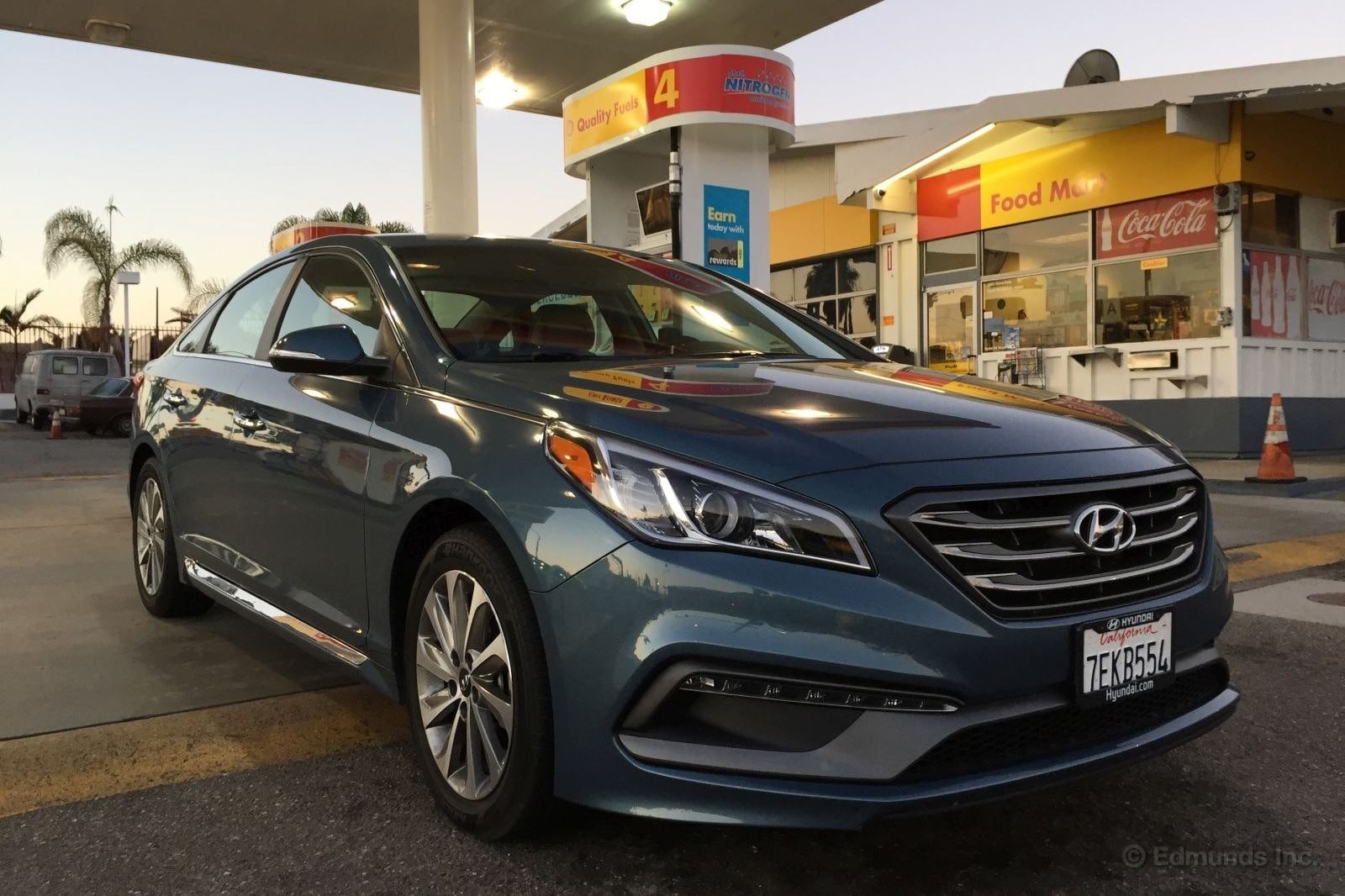
Preparing to leave on a road trip, I filled up our 2015 Hyundai Sonata and was shocked to find that it only got 16 mpg for that tank. The previous tank was much better at 22 mpg, but still well below the EPA-promised 29 mpg combined. Looking at our fuel economy updates, I see other editors have flagged this discrepancy.
But, hey, what better side benefit for a road trip than to check the fuel economy? So I filled up before I left, once on the road, and again when I returned from the 609-mile excursion.
Here's what I learned about EPA estimates versus real-world MPG in our Sonata.
I drove 230 miles through traffic on the first day without babying the 185-horsepower, 2.4-liter engine and setting cruise control at about 72 mph. The next day, I climbed into the mountains, which probably reduced fuel economy somewhat. On the final day, I drove home, descending from the mountains to sea level.
On the first tank of gas I got 28.3 mpg over 335 miles. On the second tank I got 29.8 mpg over 274 miles of driving. Those are pretty good numbers, right in line with the combined MPG estimate, but well shy of the 37-mpg highway estimate. I would have expected better given the amount of highway miles on our road trip. I checked the Sonata's competitors on fueleconomy.gov, and while they all offer similar ratings, I still wondered what they actually deliver.
I doubt many owners would complain about the mileage. Instead they would rejoice that, with an 18.5-gallon gas tank, the Sonata can cruise all day.
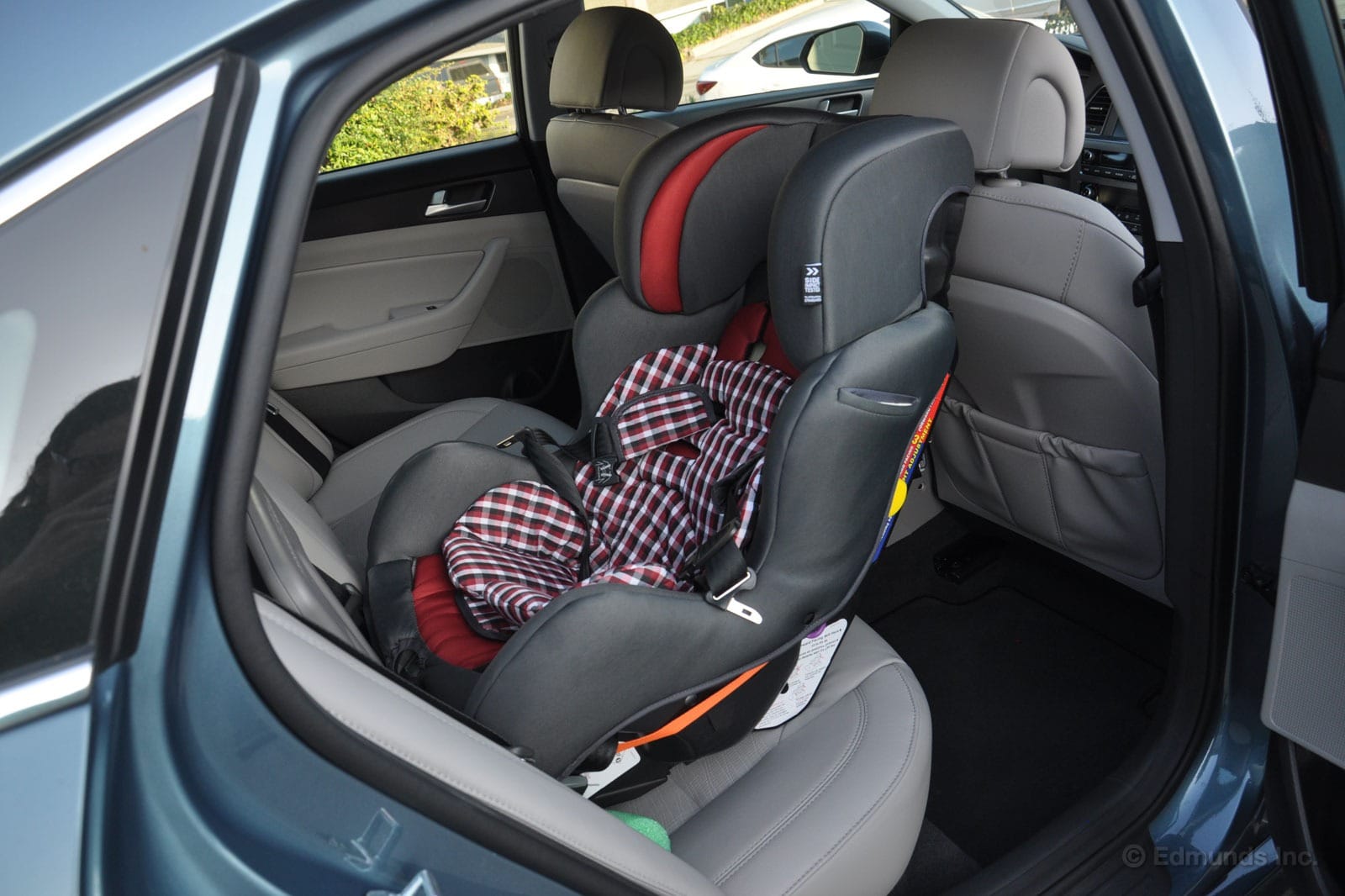
Previously, I installed my daughter's rear-facing convertible car seat in the rear center position of our 2015 Hyundai Sonata. It worked out OK, but I had to use the seatbelt to install the seat rather than the LATCH connectors, and my extra-wide First Years True Fit C680 SI car seat blocked use of the rear passenger-side seatbelt.
This time I felt lazy and just wanted to use LATCH, so I put the seat in the rear passenger-side position. Surprisingly, there was still plenty of legroom for a 5'10 tall passenger to ride up front.
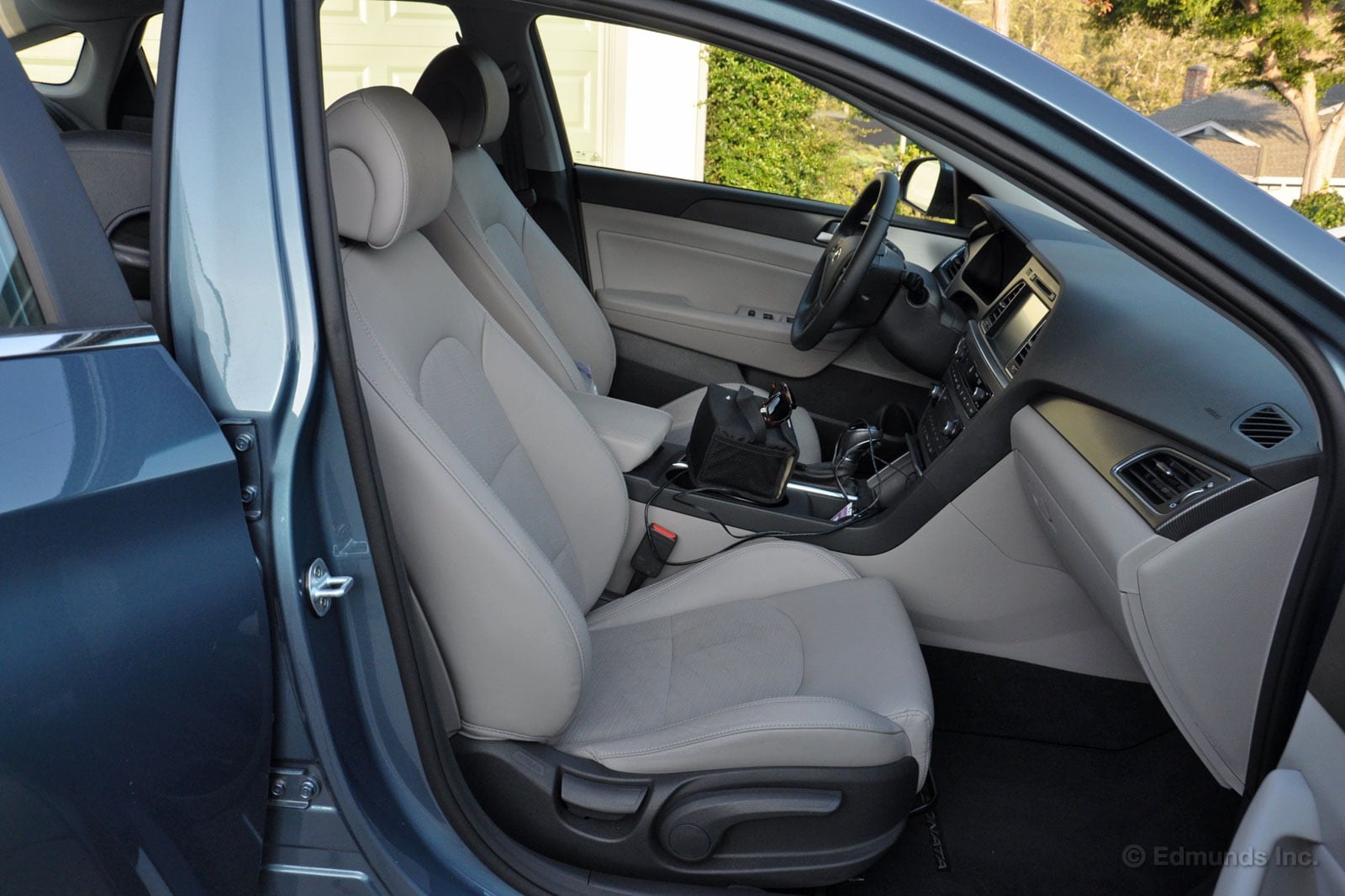
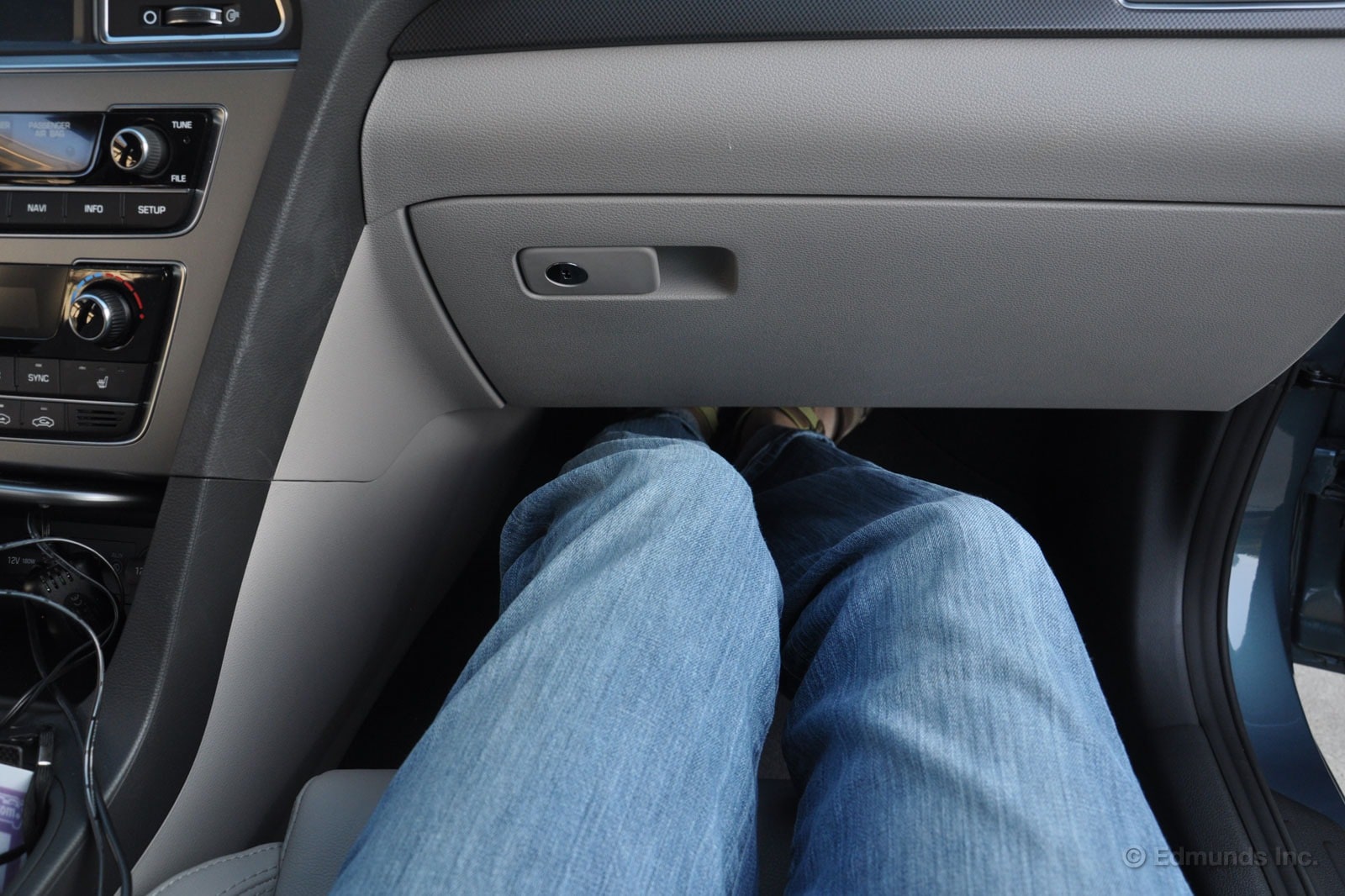
This was a much quicker and easier install for two reasons. First, the 2015 Sonata has an excellent LATCH setup. The covers over the lower anchor points are spring-hinged. Press on them with the car seat's connectors and they automatically open at exactly the right angle for the connectors to grab the metal bars.
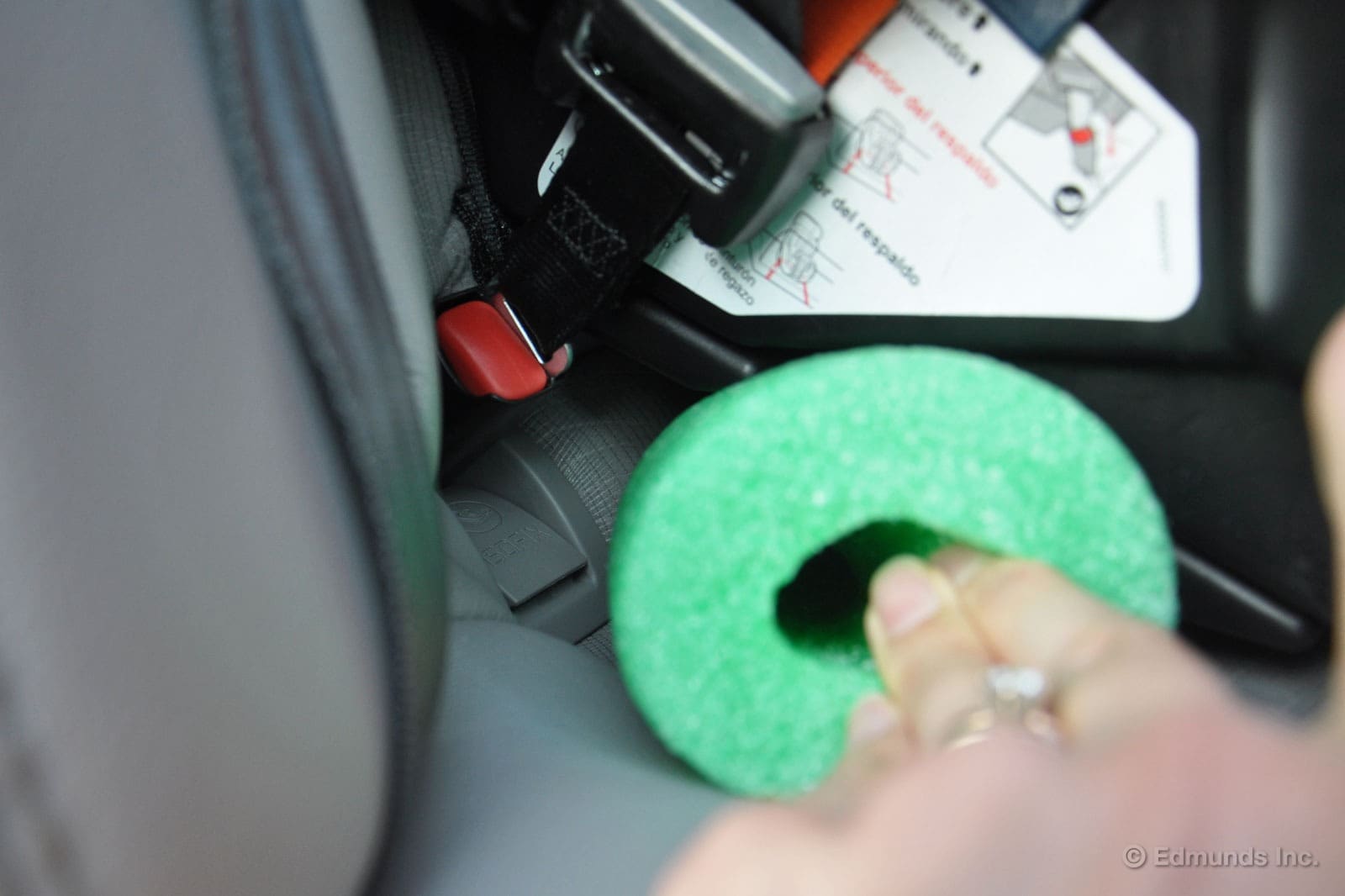
Second, the seat-bottom cushions in the rear outboard positions are covered with more cloth than the center position (which I think is all leatherette), so the seat doesn't slide around as much during the installation process. I used a pool noodle to get a slightly better angle, but could have gone without it because the level on the seat was in the green zone (green = OK) either way.
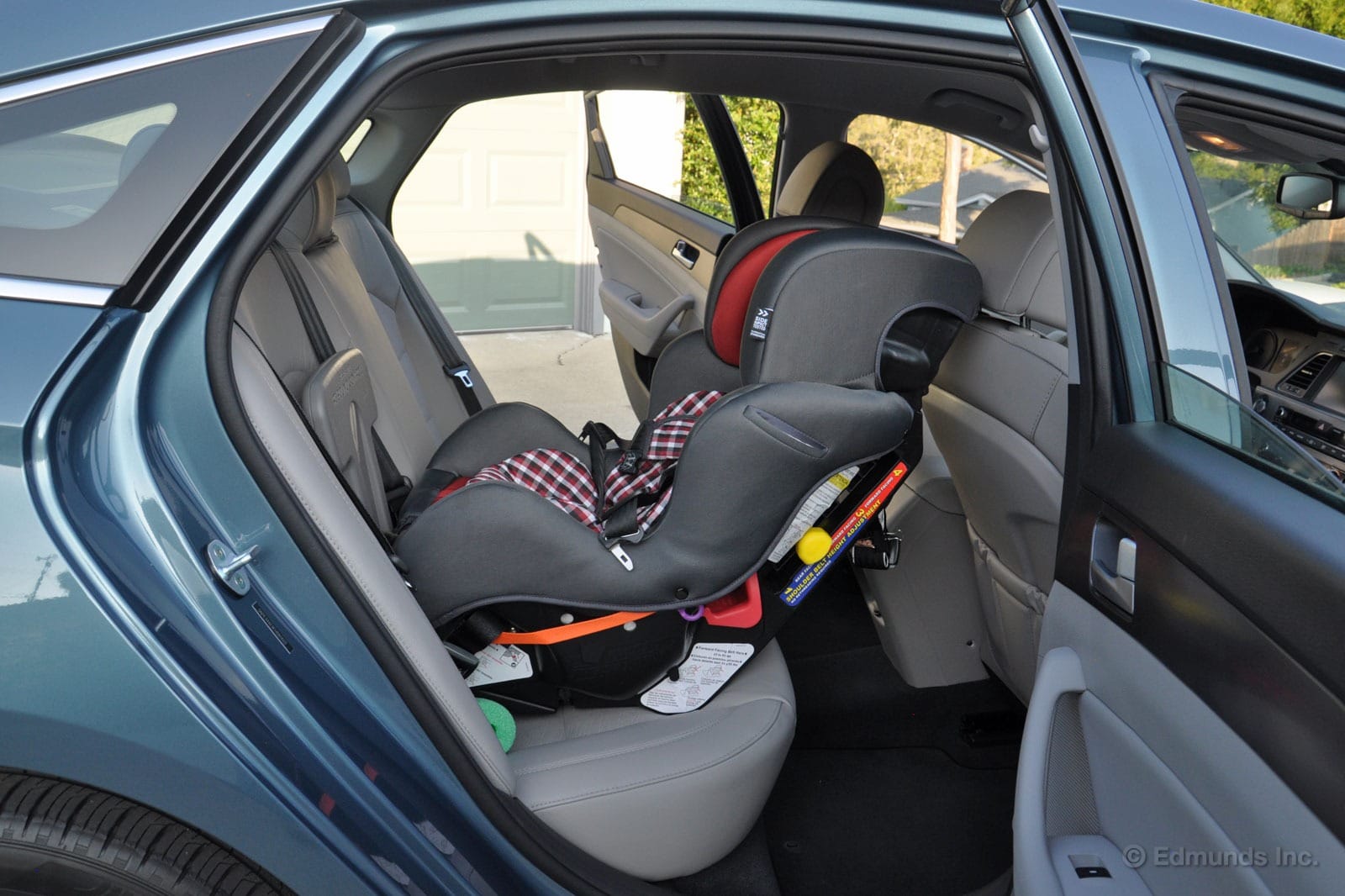
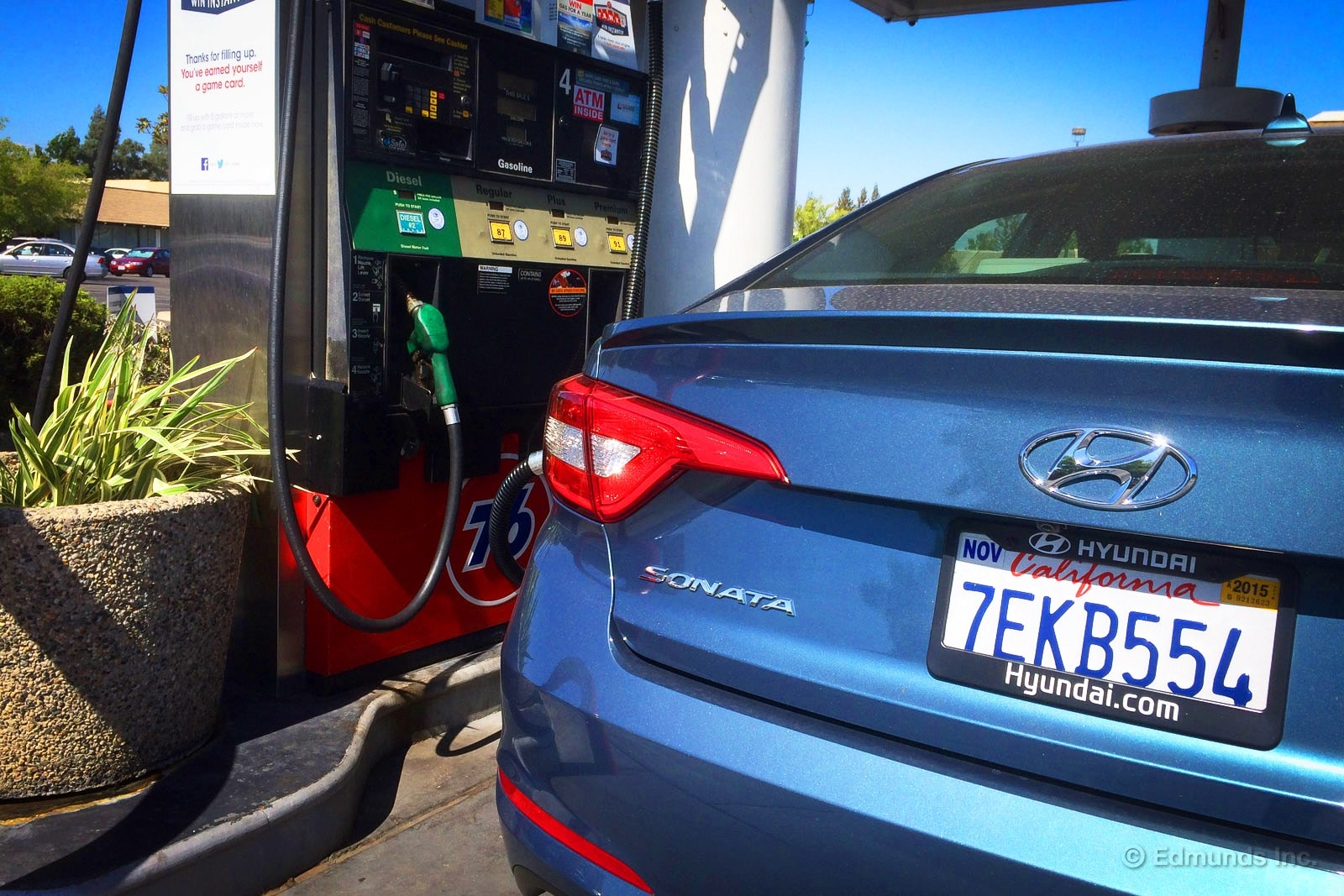
June was a busy month for our 2015 Hyundai Sonata as we added close to 2,000 miles to the odometer. A good chunk of that came from Phil Reed's road trip to Mount Whitney plus some long-distance driving of my own. The result was a rise in our lifetime fuel economy average and a new fill-up mpg record.
For the month of June, we averaged 25.5 mpg. That helped bump our lifetime average to 25.4 mpg. Last month, we were at 25.0 mpg. We also posted a best fill of 32.3 mpg after 429.8 miles of driving. Both are new records.
Granted, our lifetime average is below the official EPA estimate of 28 mpg. But considering that the majority of our long-term cars come up a little short of EPA, I feel that is 25.4 mpg a pretty solid figure, provided we can keep it there for the car's remaining months in service.
Worst Fill MPG: 16.2
Best Fill MPG: 32.3
Average Lifetime MPG: 25.4
EPA MPG Rating: 28 Combined (24 City/35 Highway Combined)
Best Range: 428 miles
Current Odometer: 9,919 miles

We received no warning as our 2015 Hyundai Sonata neared the 7,500-mile mark, the point designated for its first service. The onboard mileage-based minder on the Hyundai can be disabled manually and apparently that happened to ours sometime in the past 7,500 miles. No matter, as we record service intervals as part of the check-in procedure for every car in the fleet and knew when the Sonata was due for service.
There are no Hyundai dealerships near the office, so I took the Sonata home one night and in to Puente Hills Hyundai the following morning.
I pulled into the service area on a Thursday at 10:15 and waited outside my car for a minute. It was soon clear that no porter or advisors were coming outside to greet arriving customers. I went inside and spoke to the first available advisor.
The owner's manual lists an oil and oil filter change, inspections for the air cleaner filter and vacuum hose, and possible inclusion of fuel additive for the 7,500-mile service. The advisor quoted me $134.95, which included several inspections that were not listed in the owner's manual. One dealer-suggested service (not called for in the manual) was a tire rotation.
I specified that I did not want the dealer's service package, only what was listed in the manual. The price dropped to $35.45 before tax. The service would take an hour, so I unpacked my laptop in the customer lounge and helped myself to complimentary WiFi.
It seemed strange to me that a tire rotation was not listed in the owner's manual. An oil change and tire rotation is performed at most, if not all, scheduled maintenance intervals for other cars. I used the Edmunds Car Maintenance Guide and queried the list of services to be performed on a 2015 Hyundai Sonata at 7,500 miles. Sure enough, a tire rotation was listed.
I consulted the manual again. Tire rotations were not listed for any interval in the Maintenance section of the book. I did more digging and used Hyundai's online Maintenance Schedule page, which indicated that tire rotations should be done at every scheduled service.
Upon closer scrutiny, I found that the owner's manual does call for tire rotations every 7,500 miles, but this information is on page 7-44, several pages away from the Scheduled Maintenance Services listed from pages 7-10 through 7-19. Most manuals have a single location for all service interval needs rather than splitting critical information into multiple sections.
Before I concluded that the tires should in fact be rotated, the Sonata was done with its service. I was disappointed at the manual's confusing language and at myself for not trusting my gut. Sounds like a How-To rotate tires video is in order, with the Sonata as our subject vehicle.
Total cost: $37.25
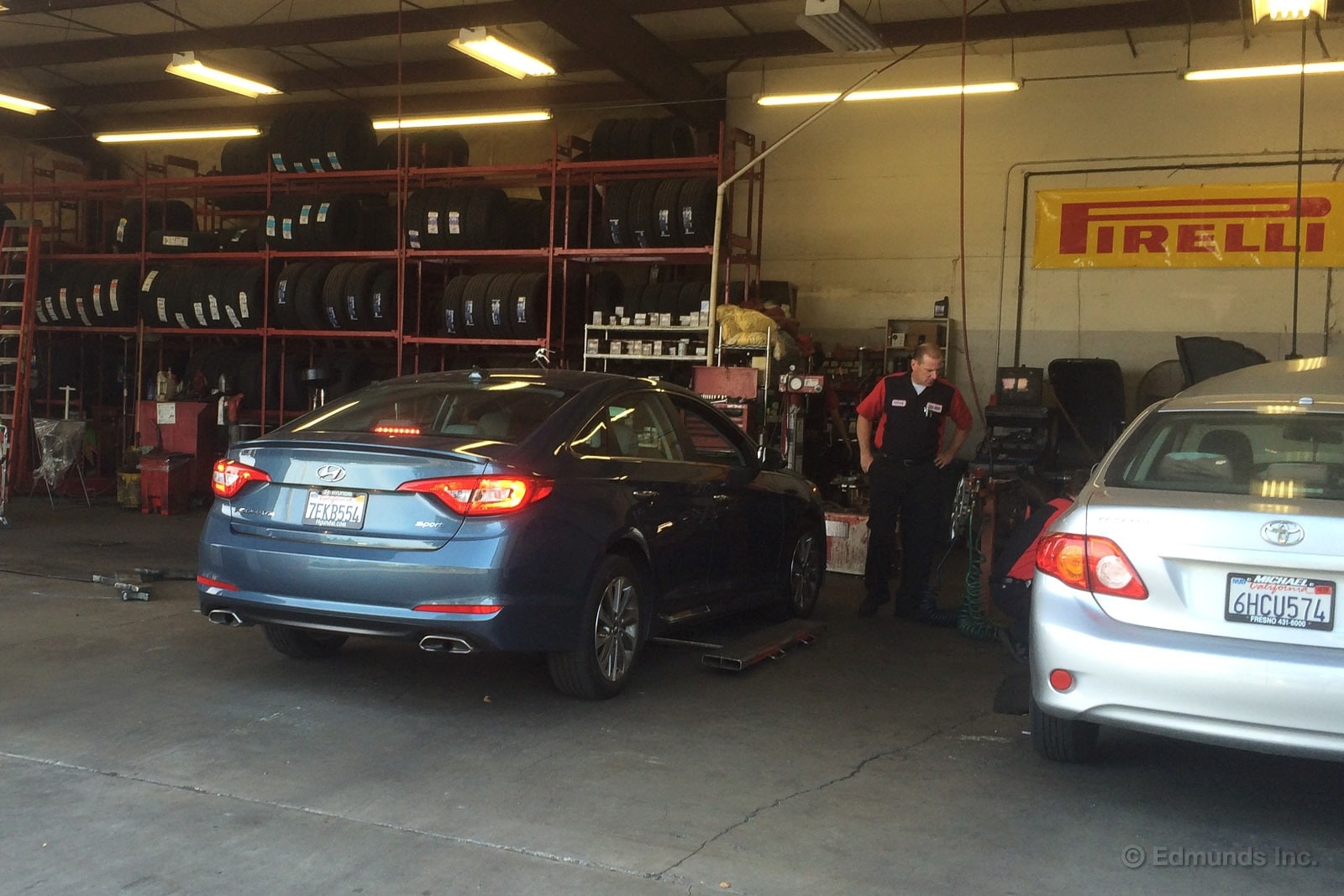
In recent weeks, the United States has seen landmark Supreme Court decisions that have tended towards the social left of the political spectrum. Meanwhile, our 2015 Hyundai Sonata is counter-acting all that by pulling hard to the right, so much so that Mike Huckabee has announced our car will be the official vehicle for his presidential campaign. (Ba-dum-tss! Thanks everybody, I'll be here all week!)
I drove about 450 miles on the highway in our Sonata recently and noticed the whole time that the car had strong tendency to pull to the right, counter-acted by holding the steering wheel slightly to the left. I'm normally forgiving of such things in our long-term test cars, but it was annoying and fatiguing on long drives in the Sonata. Plus, I knew I had another 700 miles of highway driving looming for the 4th of July holiday.
It was time to get this issue addressed. I headed over to my local tire and wheel shop (Tires Pros in Fresno, Calif.,) and had the guys there take a look.
The shop's owner was a little surprised I was actually bringing our Sonata in. Presumably they don't get many calls for alignments on new vehicles. He first suggested that a front-tire rotation might help remedy the pull. Sometimes the tires have an inherent tendency (just from the way they are made) to direct the car to the left or right instead of staying straight, he said. Swapping the front tires can help fix it. But he also said his technician would put the Sonata on their alignment machine and check it out.
It turned out that the Sonata's alignment was not correct. In particular, the toe of both rear wheels was not in the specified range. The shop speculated that this rear steering effect was causing the veering to the right.
With the tire rotation performed and the wheels now back in proper alignment, our Sonata is again rolling straight and bipartisan along the highway.
Total cost: $89.99

The Los Angeles metro area typically ranks as having the worst traffic in the United States. So that's our starting base. Now add in a big roadside brush fire right at the exact point where two big freeway arteries meet and effectively serve as the only way, once you've committed, to drive in or out of Los Angeles from the north. This fire blocks lanes and causes every motorist to be a looky-loo. Now try to drive through all this at 4 p.m. like I did recently. Fun!
Thankfully, I happened to be driving our 2015 Hyundai Sonata. There's not much else in our long-term fleet right now that can match the Sonata for providing long-duration comfort and serenity.
There are a few reasons for this, most of which we've covered before. Both Ed and Erin have written favorably about the driver seat. I'll add on and confirm that it's comfortable for multiple hours of sitting. I'll also second Kelly's observation about the enjoyable sound quality of the 10-speaker premium Dimension audio system. Just start playing some harmonious Celtic music (if that's your thing) and let the relaxation set in.
The Sonata's quiet, too. This Great Wall of Korea helps keep the Celts in and the blaring hip-hop from the motorist next to you out.
Finally: snacks. You need snacks at the ready when traffic slows to a crawl. The Sonata's got you covered with its handy storage cubbies.
Granted, if I was driving right towards a brush fire that was actually the start of some serious traffic Armageddon, maybe I'd want something else to escape LA. Like this, for instance. Otherwise, I'm happy piloting the Sonata for highway slogs.
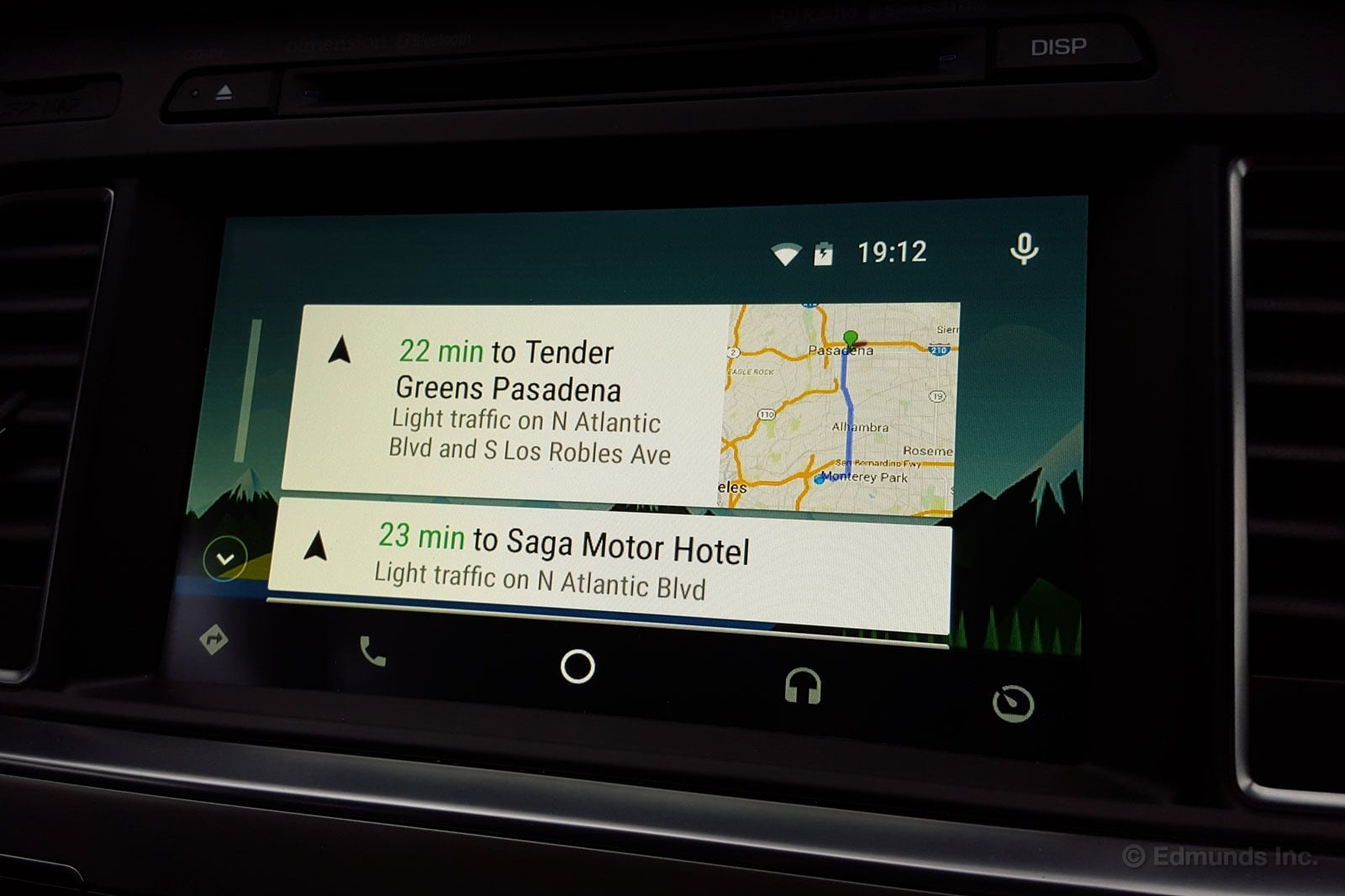
Back in May, Hyundai announced that Android Auto would be offered in the latest navigation system update for the 2015 Hyundai Sonata. Our friends at Hyundai helpfully sent us a thumb drive so that we could do the update ourselves in our long-term Sonata.
But it turned out we'd already gotten this update, apparently during a service visit for an airbag light in late December 2014. The dealer never mentioned that detail to us, though. No one on staff had been motivated to poke around for Android Auto either, since most of us have iPhones. I am one of the few editors with an Android phone.
I've started using Android Auto with my Sony Xperia Z3 Compact running the Lollipop 5.0.2 operating system. Although this interface is still in its infancy, I like it a lot so far.
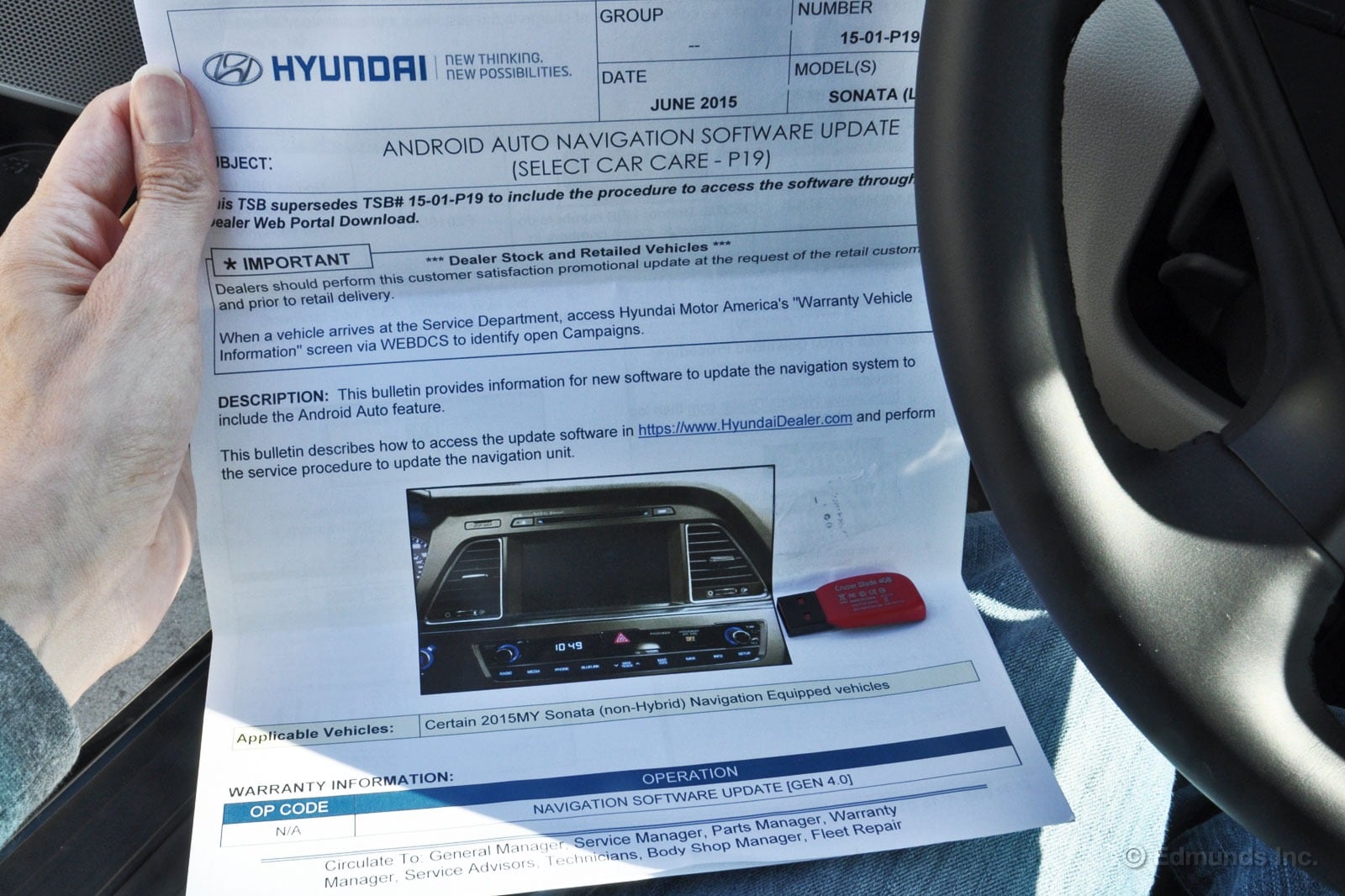
To enable Android Auto for the very first time, you go into the Setup menu and click the Connectivity icon.
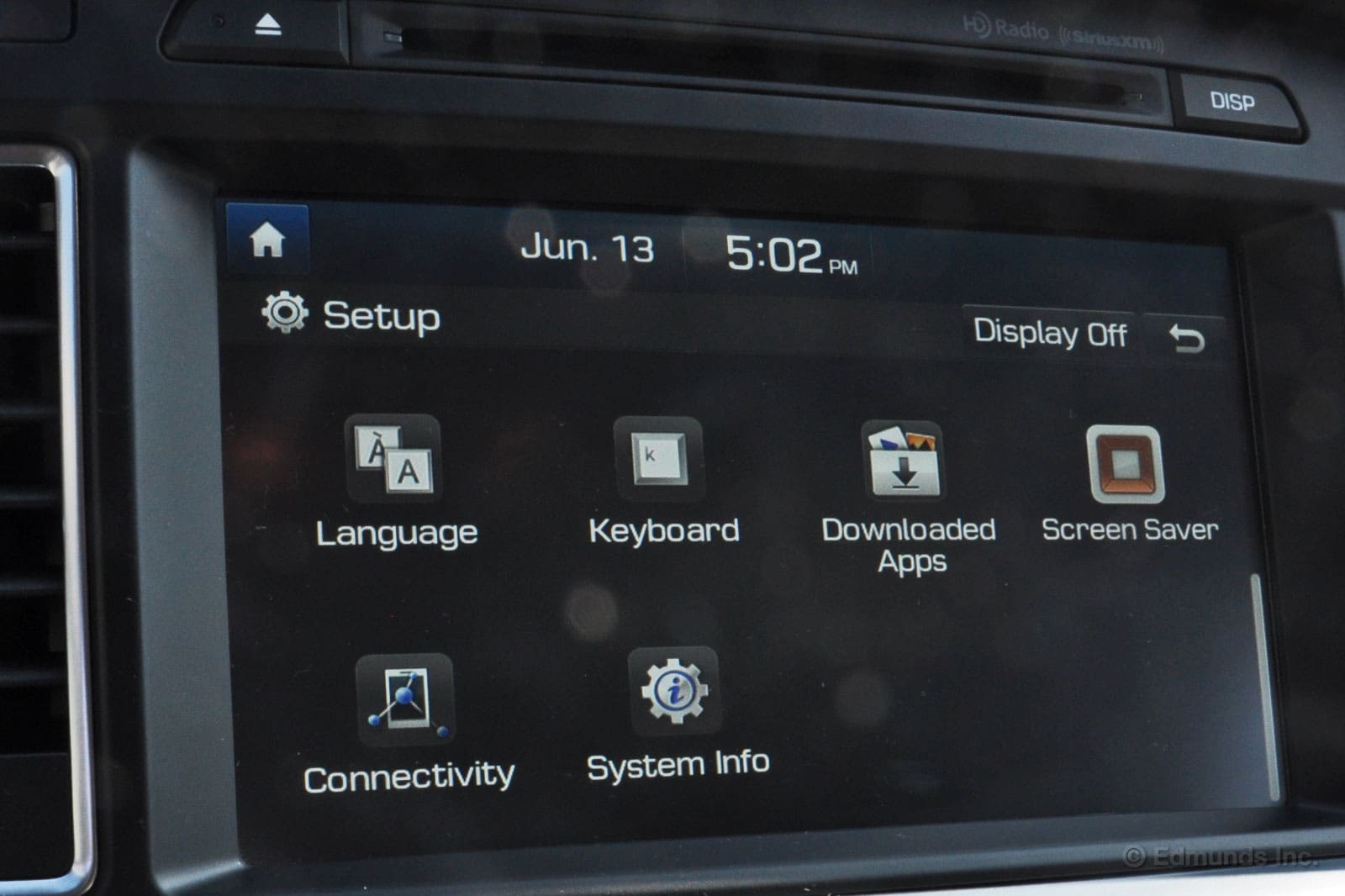
Doing so takes you to this screen, though I imagine in the future, there will be an option to choose either Android Auto or Apple CarPlay (which isn't yet available), depending on which type of phone you have active in the car.
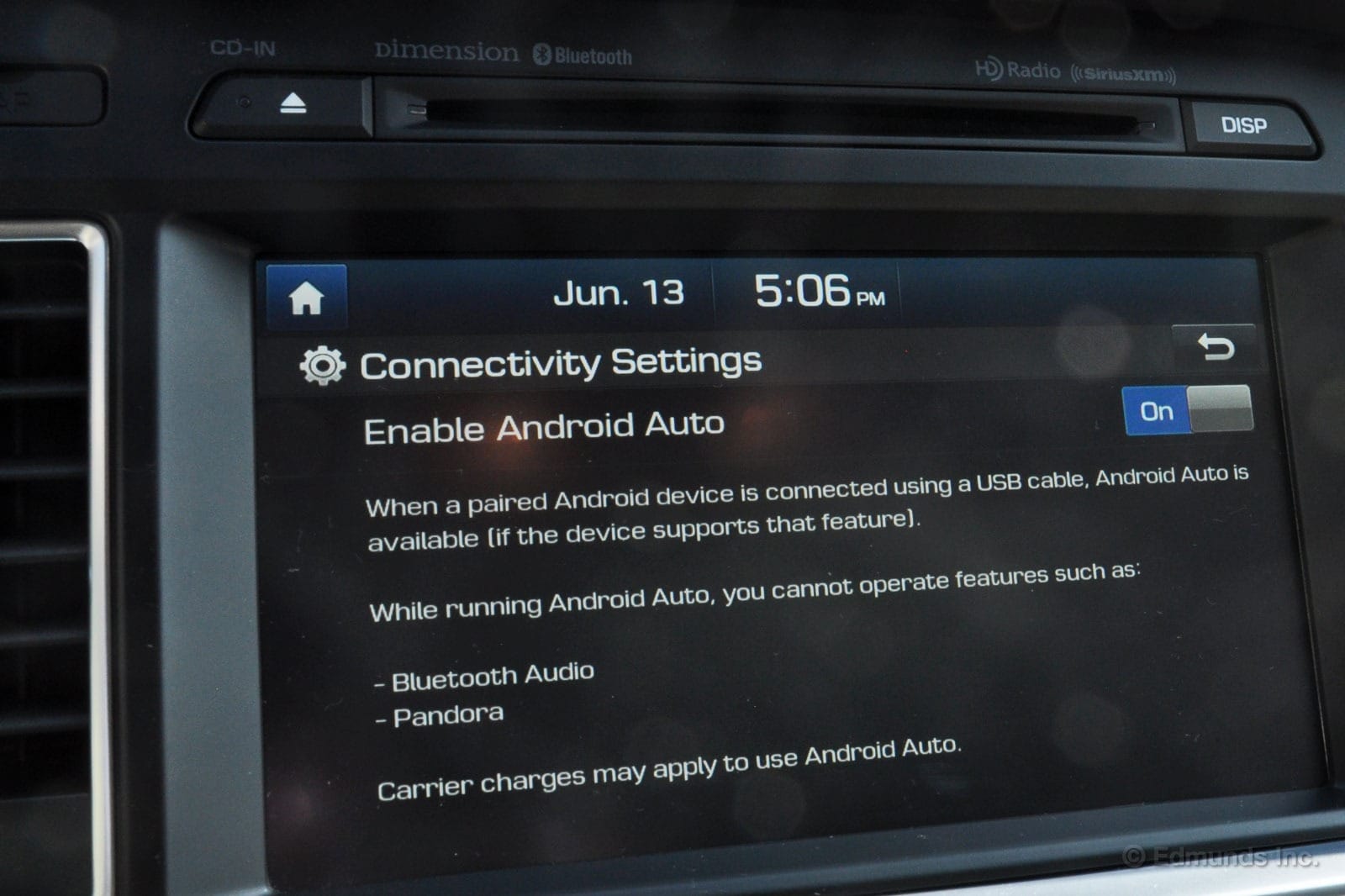
I clicked the button at the top right to turn on Android Auto and that brought up this are-you-sure-you-want-do-this screen.
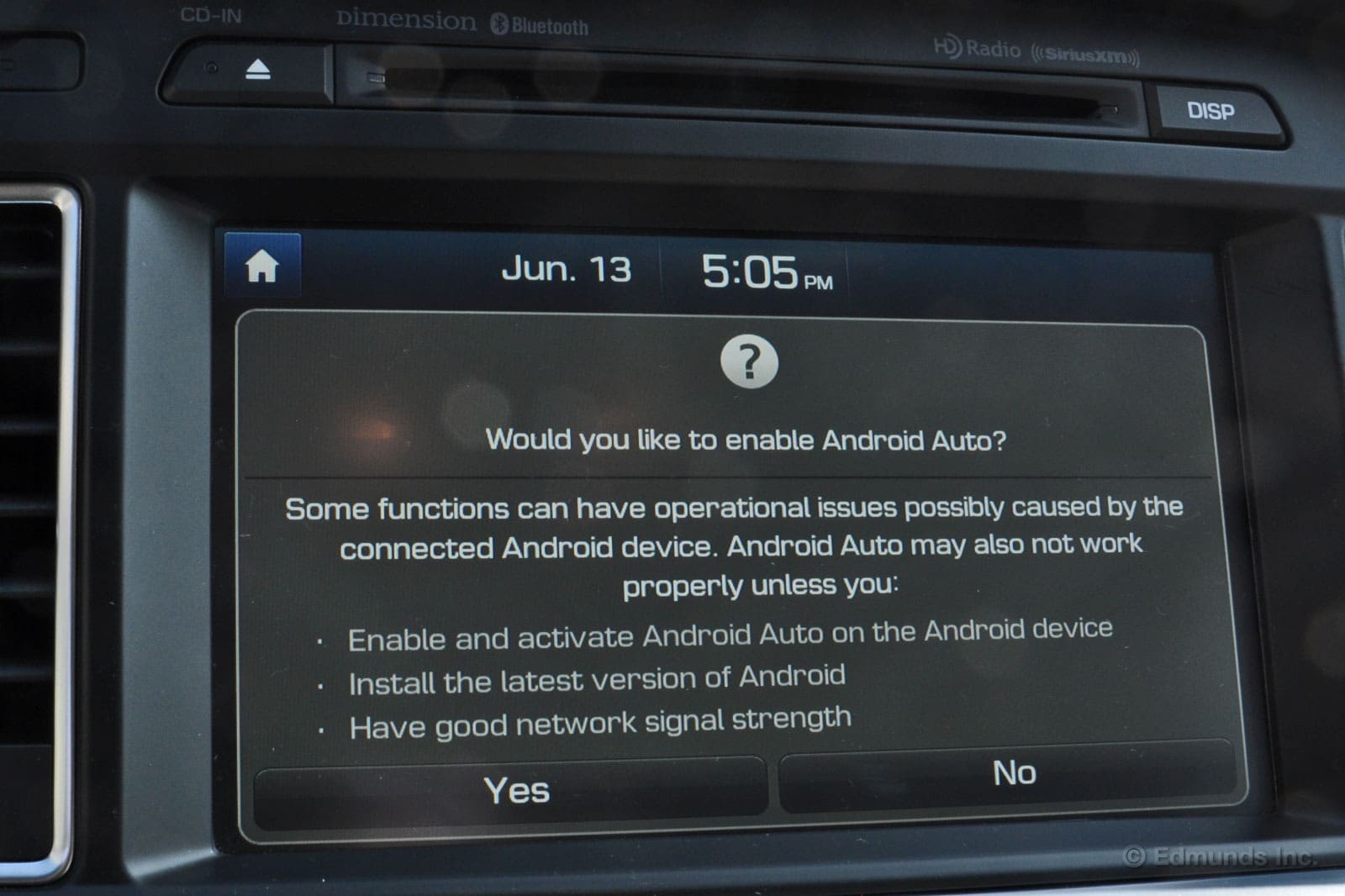
The homepage for Android Auto is familiar if you already use the Google Now "cards" on your phone. Generally, the destination I'm headed to is already in the cards (as in the lead photo of this post), either because I go there frequently or I've just researched it. But if not, it's easy to key in your destination when the car is stopped. I already have "Work" saved as a favorite in my Google Maps profile.
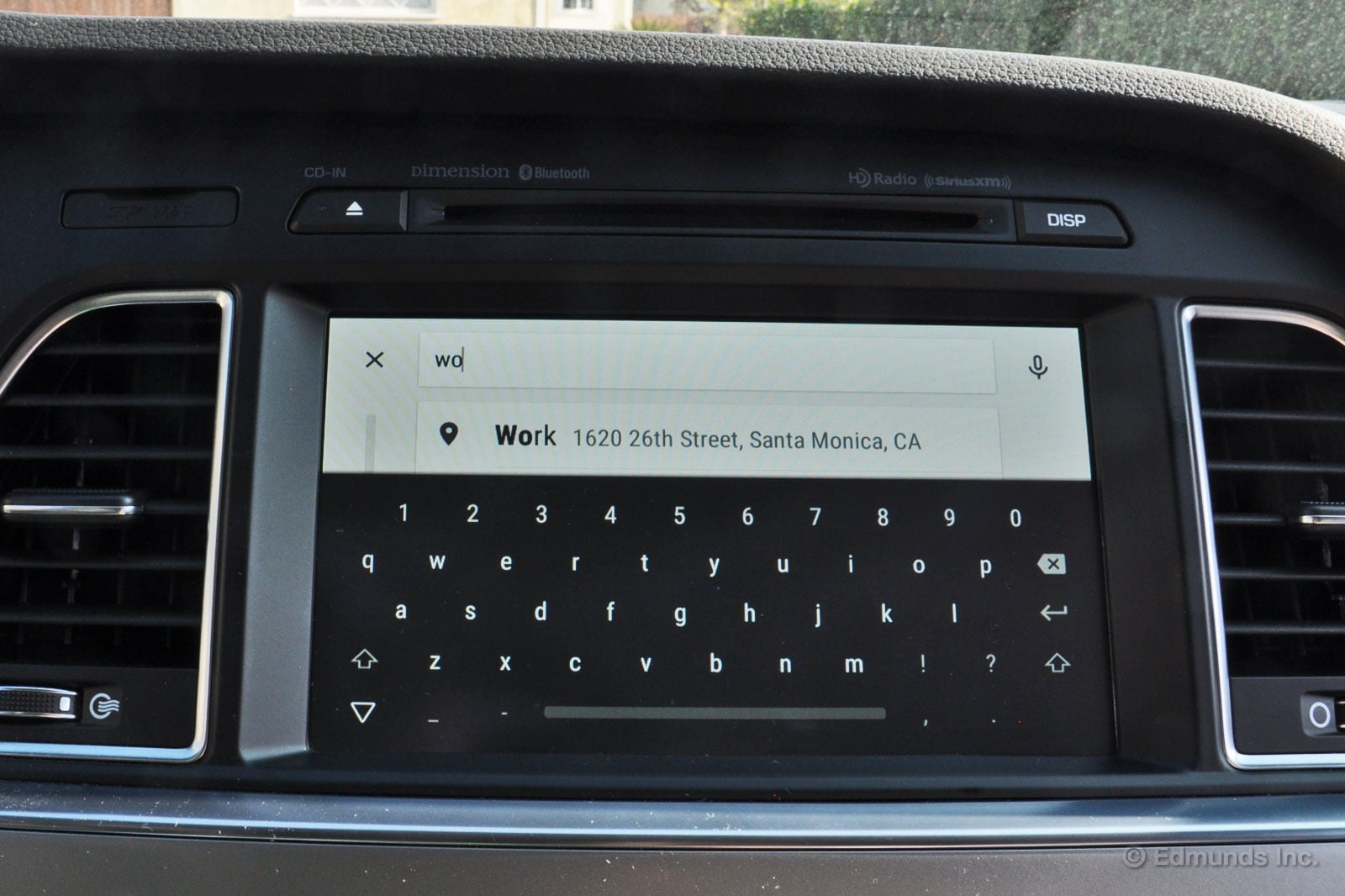
Just like in the Google Maps app on your phone, the Android Auto version gives you multiple route options in most cases.

The graphics are really crisp and colorful. They feel like an upgrade over the standard navigation software in our 2015 Sonata. But the main reason, in my opinion, to use Google Maps via Android Auto is for the traffic rerouting logic. It's more accurate than any factory navigation system (which can't be updated as often or as cheaply).
At the same time, it's nice to have Google Maps running on a large (8-inch), centrally located screen. Sure, I can run it on my phone, but at best, I'll have my phone in a holster suction-cupped to the windshield. This is better.
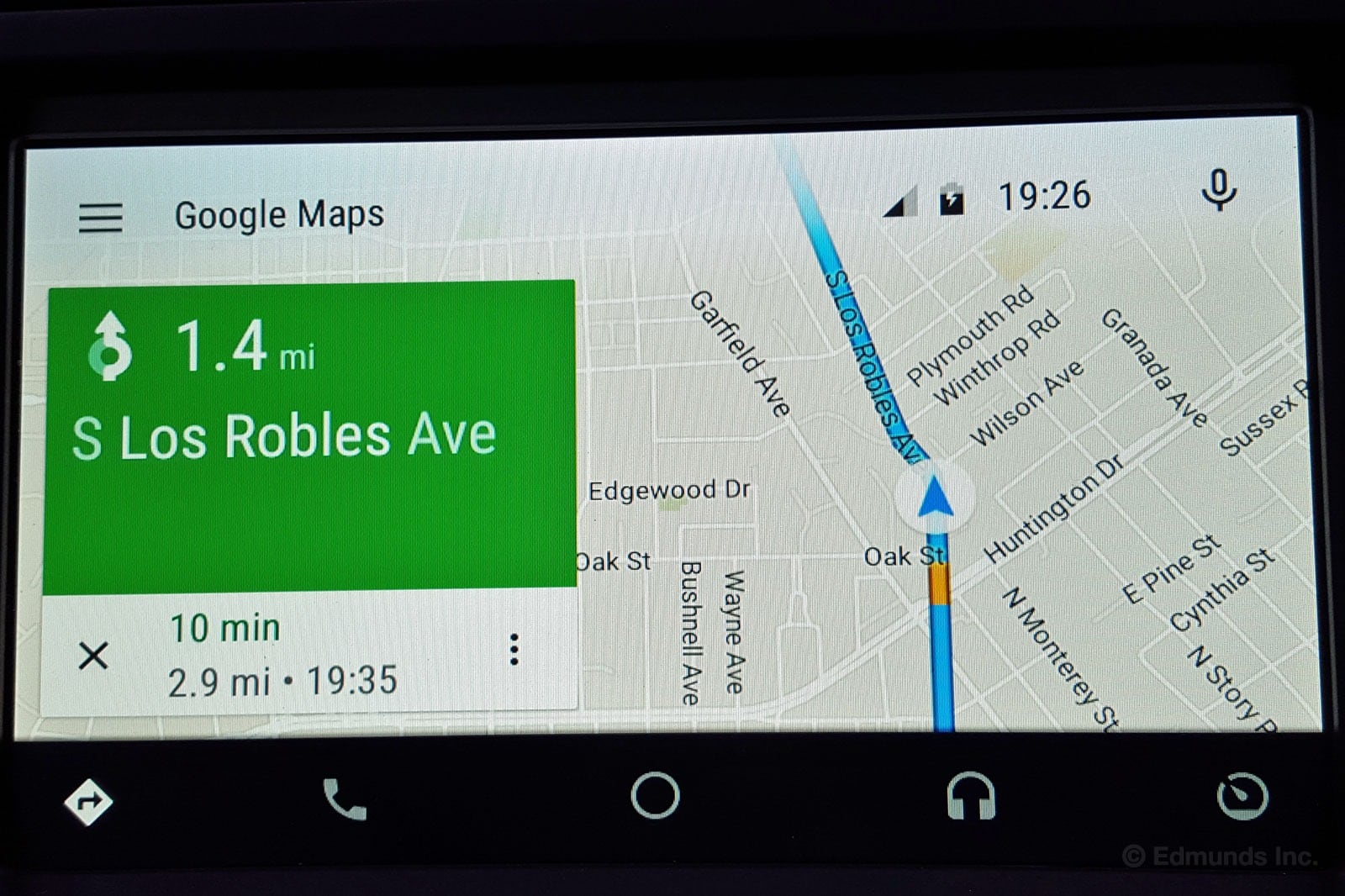
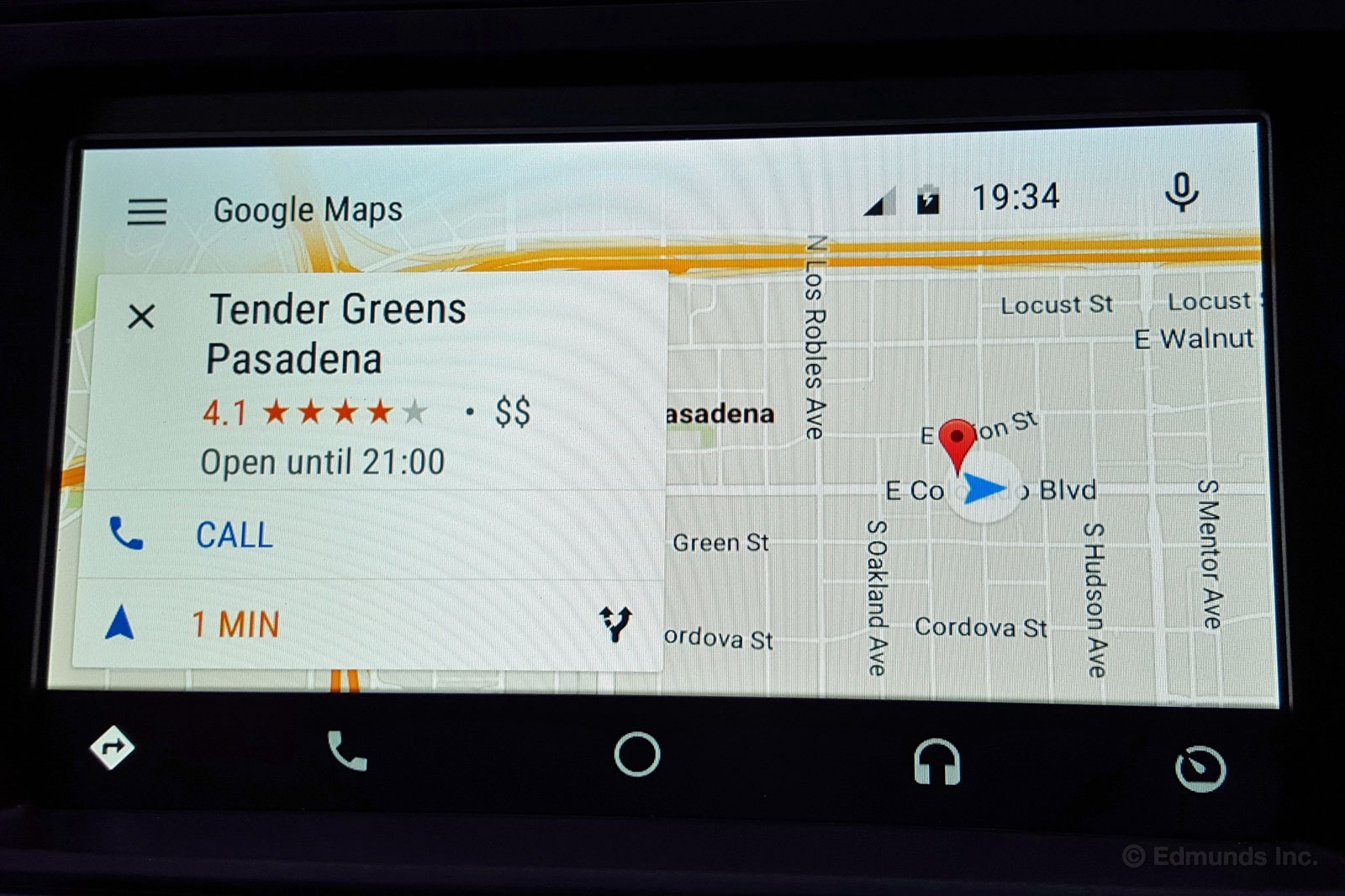
We've noted before that our Sonata's touchscreen has swipe capability like on a smartphone. This is really important for Android Auto, because most of the hard buttons surrounding the screen become non-functional once it takes over. If you want to zoom in or out on the map, you can pinch-zoom on the map and that brings up the + and - buttons you see here. After a while, they disappear. And just like in the phone version of Google Apps, you hit Resume to go back to guidance mode.
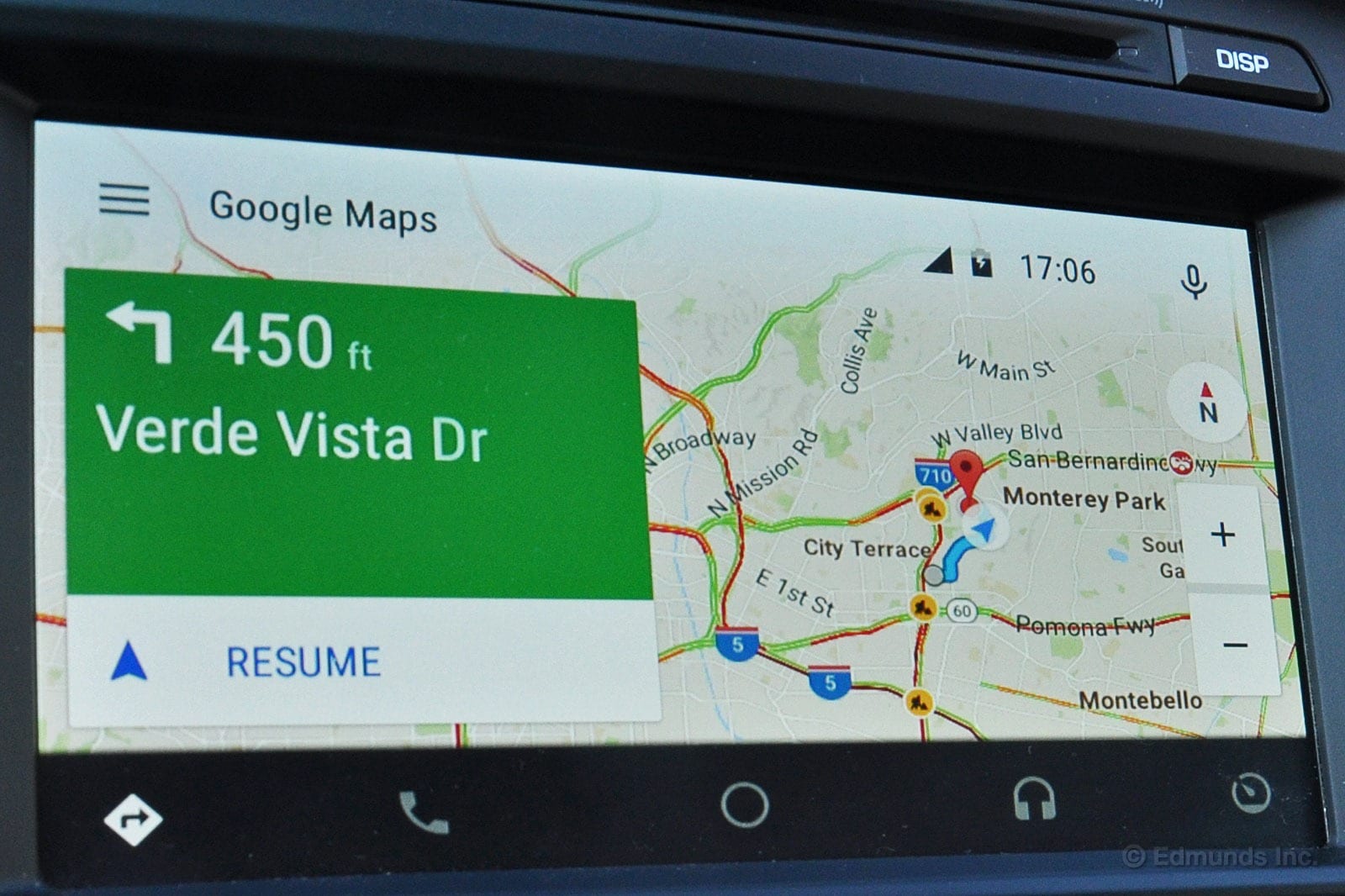
Here's a quick video of the Google Maps navigation system in action as shot by my front passenger. As you'll note, the voice guidance is just the same as it would be on your phone.
As much as I like the Google Maps interface, it's actually Android Auto's other apps that have me excited about this interface. (Indeed, Android Auto is the reason I switched from an iPhone to an Android phone.) I'll cover these other apps in my next couple posts.
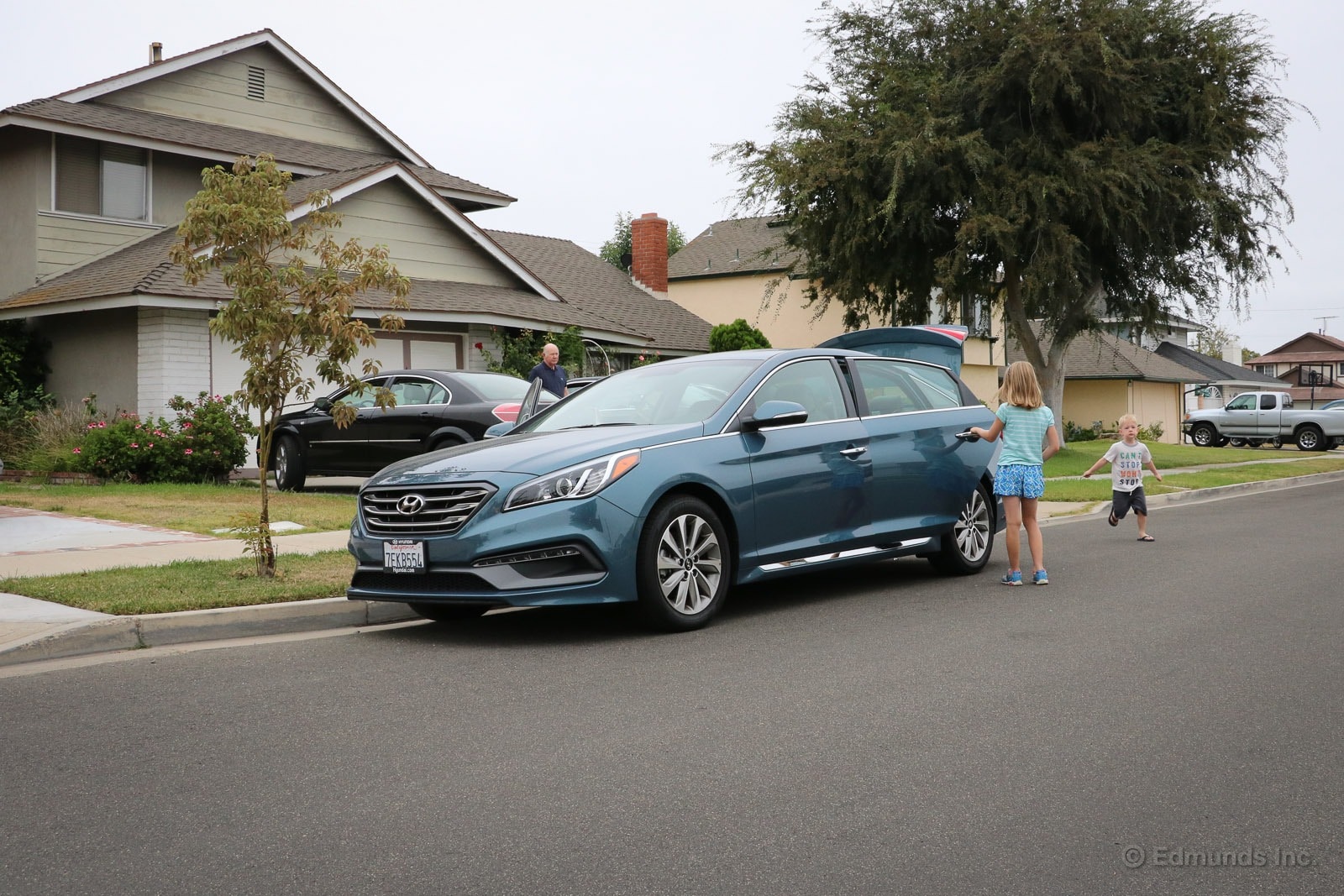
For the July 4th weekend, I drove my family (wife, two small children) to my in-law's house. Compared to the antics of, say, Vacation (either the classic old one or new one), my trip was wholly uneventful. But an uneventful 700 miles with two little kids is just fine by me.
Much of the credit goes to the Sonata.
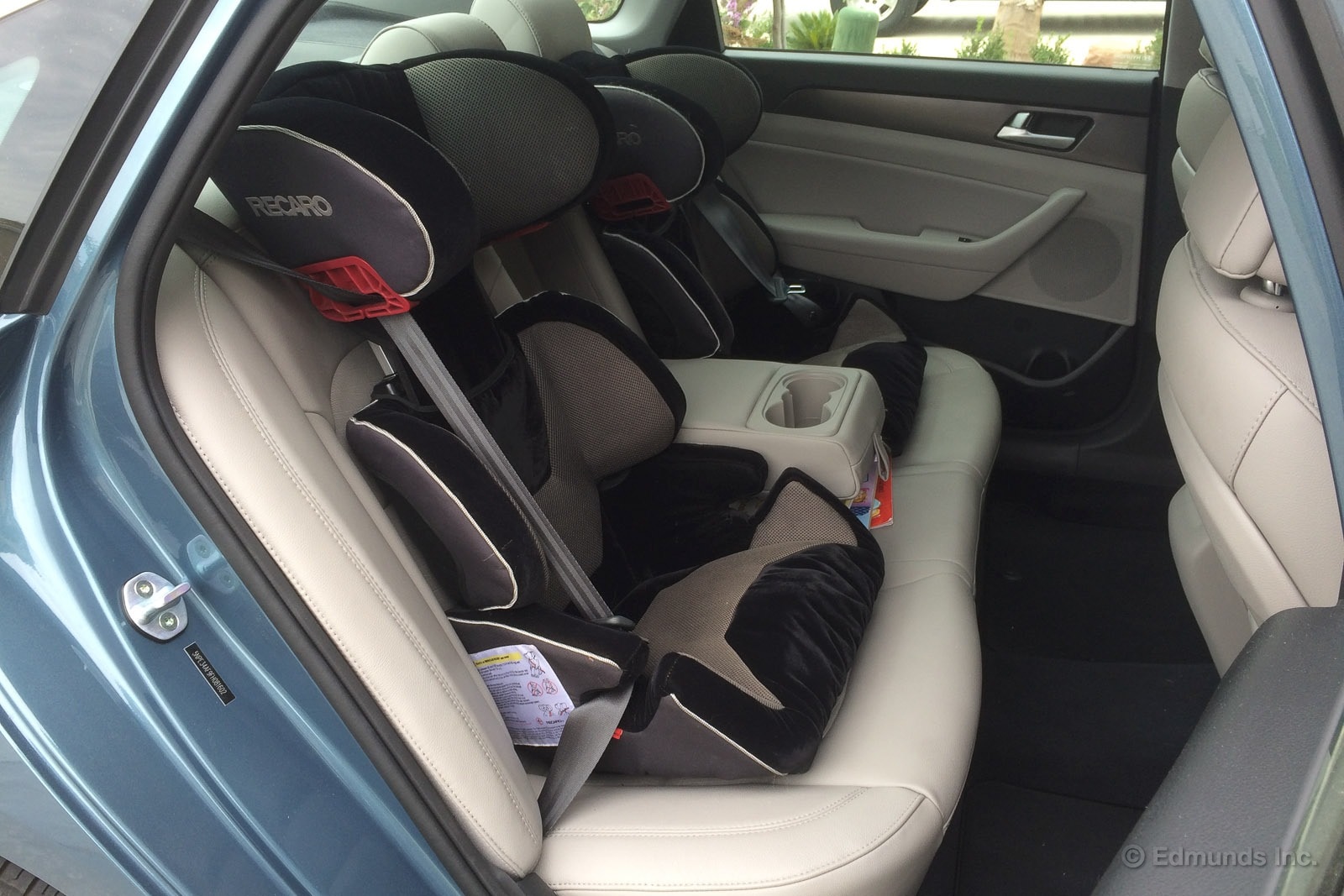
The Sonata is roomy, first of all. The ample rear legroom that Erin talked about in relation to a rear-facing child seat fitment also means little legs can't easily kick the front seats. My kids also liked the fold-down armrest and drink holders, which also served as a barrier between them (there wasn't much "He's touching me!" on this trip). My wife also seemed pretty happy in the front passenger seat. Despite lacking power adjustments, overall comfort seems very similar to the driver seat.
The Sonata's smooth and quiet ride quality came into play, as did the big trunk, which easily held our luggage and gear and kept in-cabin clutter to a minimum.
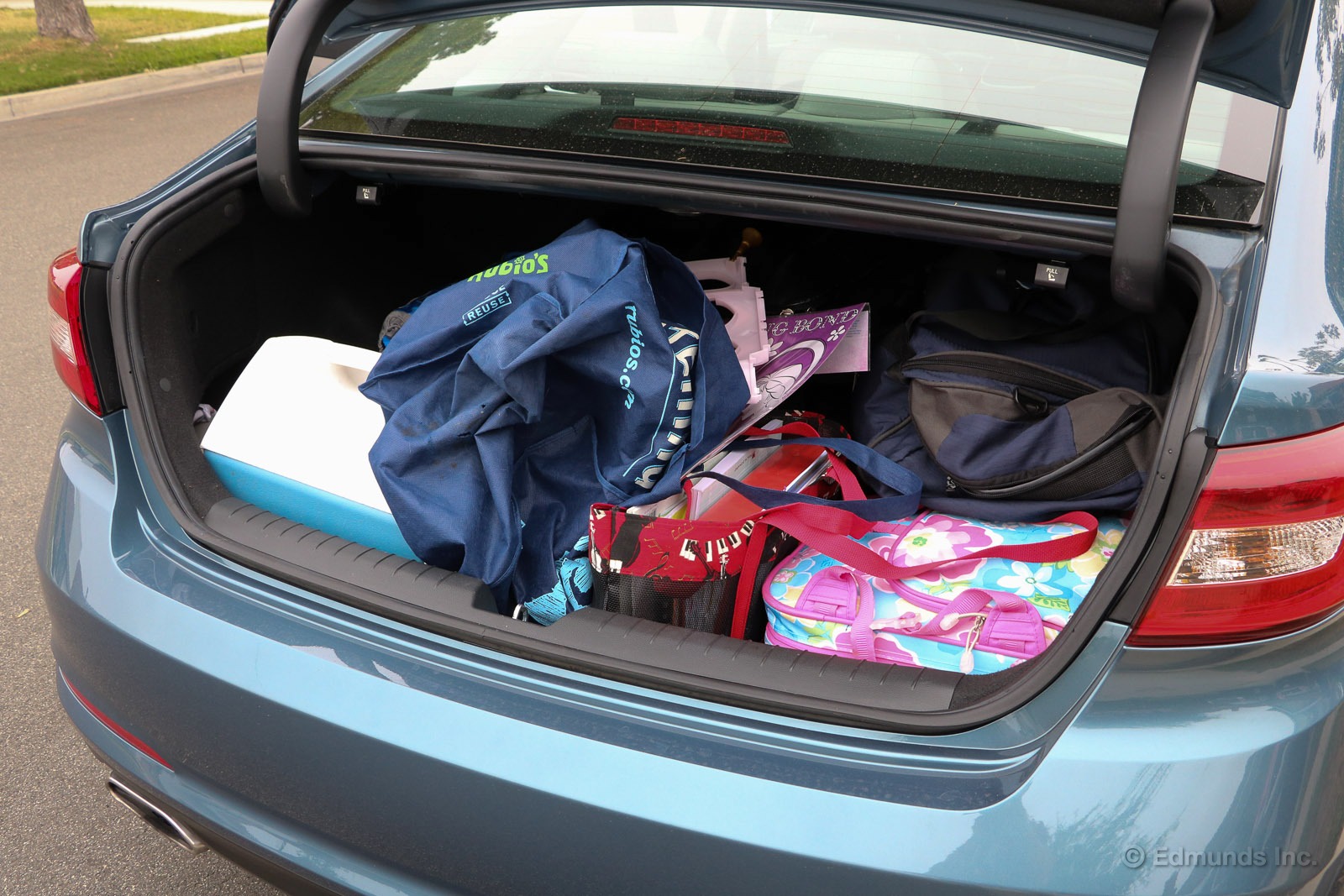
My wife drove the Sonata at one point and commented that the 185-hp four-cylinder engine didn't have a whole lot of pep. As she primarily drives a six-cylinder vehicle, I suppose the Sonata could feel that way. But for its class, the Sonata's acceleration (zero-to-60 mph in 8.2 seconds) is certainly acceptable. And for the approximately 700 miles I drove, the Sonata averaged 31 mpg.
Overall, the trip just reinforced my opinion that the 2015 Sonata is a top-tier pick for a family sedan.
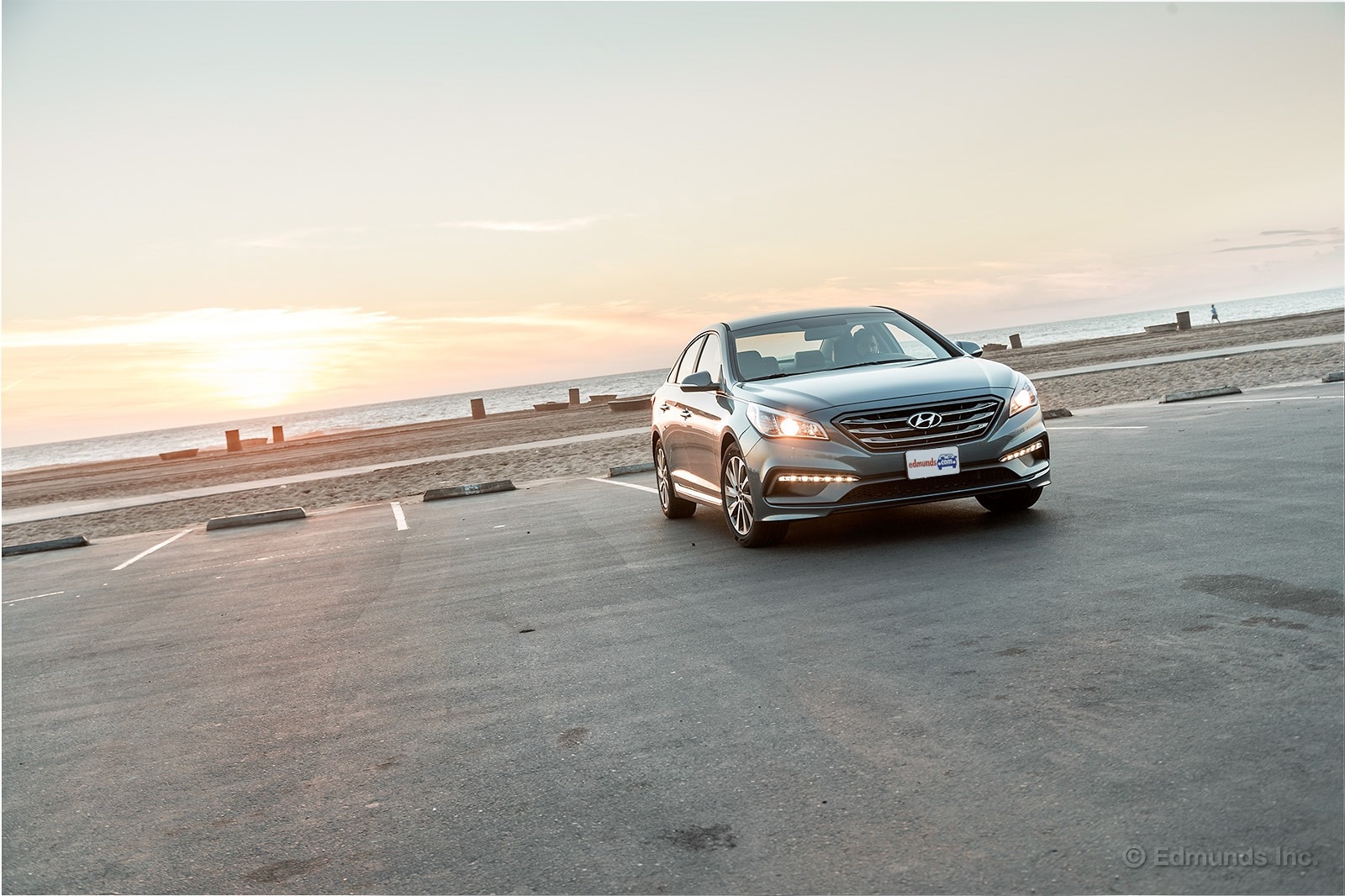
We've finally driven 10,000 miles in our 2015 Hyundai Sonata. We took delivery of our car back in December, so perhaps a little slow in hitting this milestone. Our goal for almost all of our long-term test cars is to drive them for at least 20,000 miles over 12 months or so. We still have the rest of the year to make up ground, however.
In the meantime, I've recapped our thoughts on the Sonata so far.
The Sonata's interior has gotten high marks. We've liked the roomy back seat, the comfortable front seats, the simple control layout, the generous storage cubbies and the big trunk. For the most part, we've also liked the touchscreen interface.
We haven't been quite as positive on the engine. Around town, the 2.4-liter engine is fine, but highway passing or climbing mountain grades seem to highlight its modest power output, even if the Sonata's track-test acceleration times are on-par with those of other family sedans.
So far, our Sonata has been nearly trouble-free. We had to take it to the dealer early on to check out a faulty airbag light, but that's pretty much it. More recently, we had it in for its 7,500-mile service.
Overall, I'd wager that Editor-In-Chief Scott Oldham's "I'm Impressed" update would mirror the opinions of most of our staff as well for these first 10,000 miles.
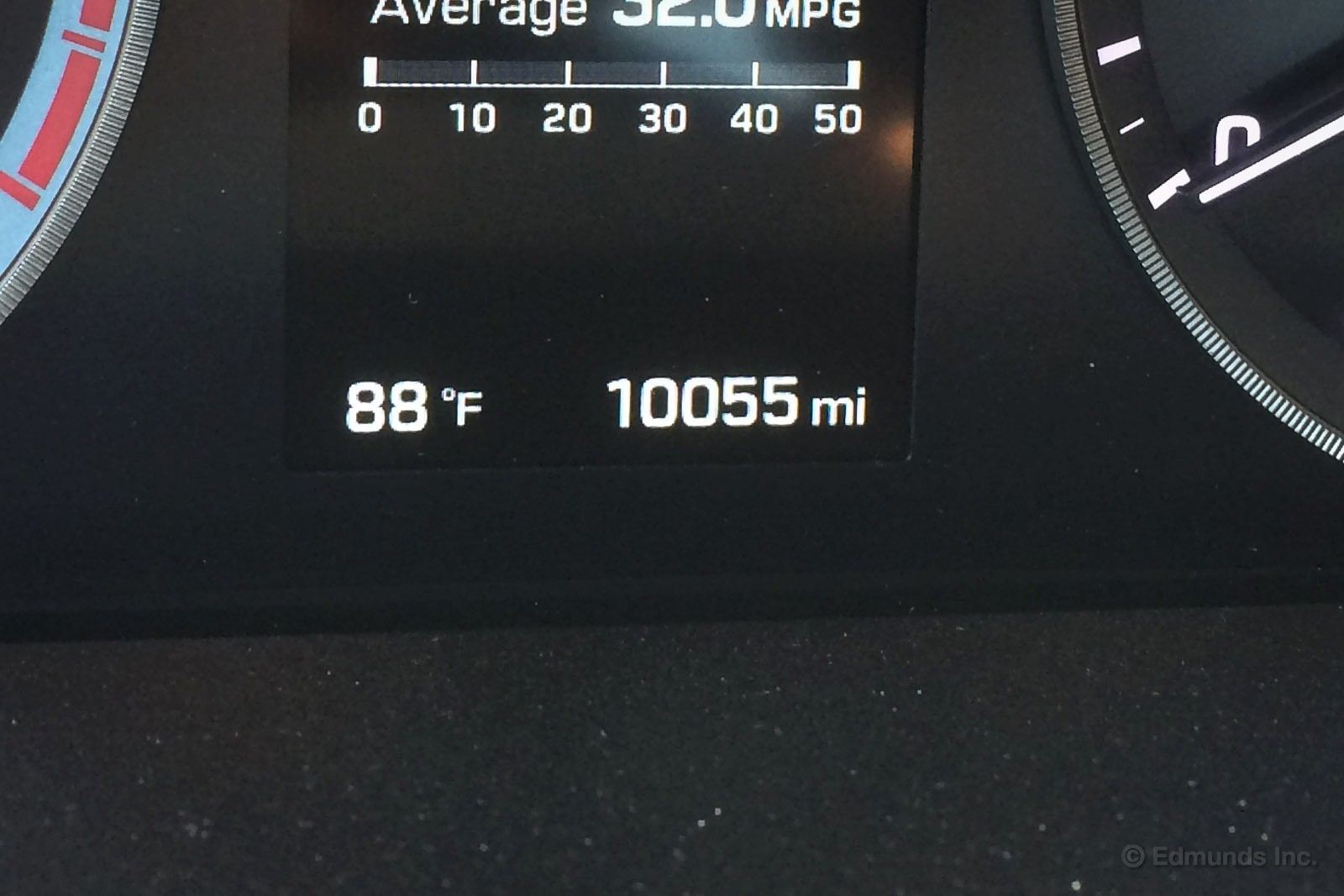
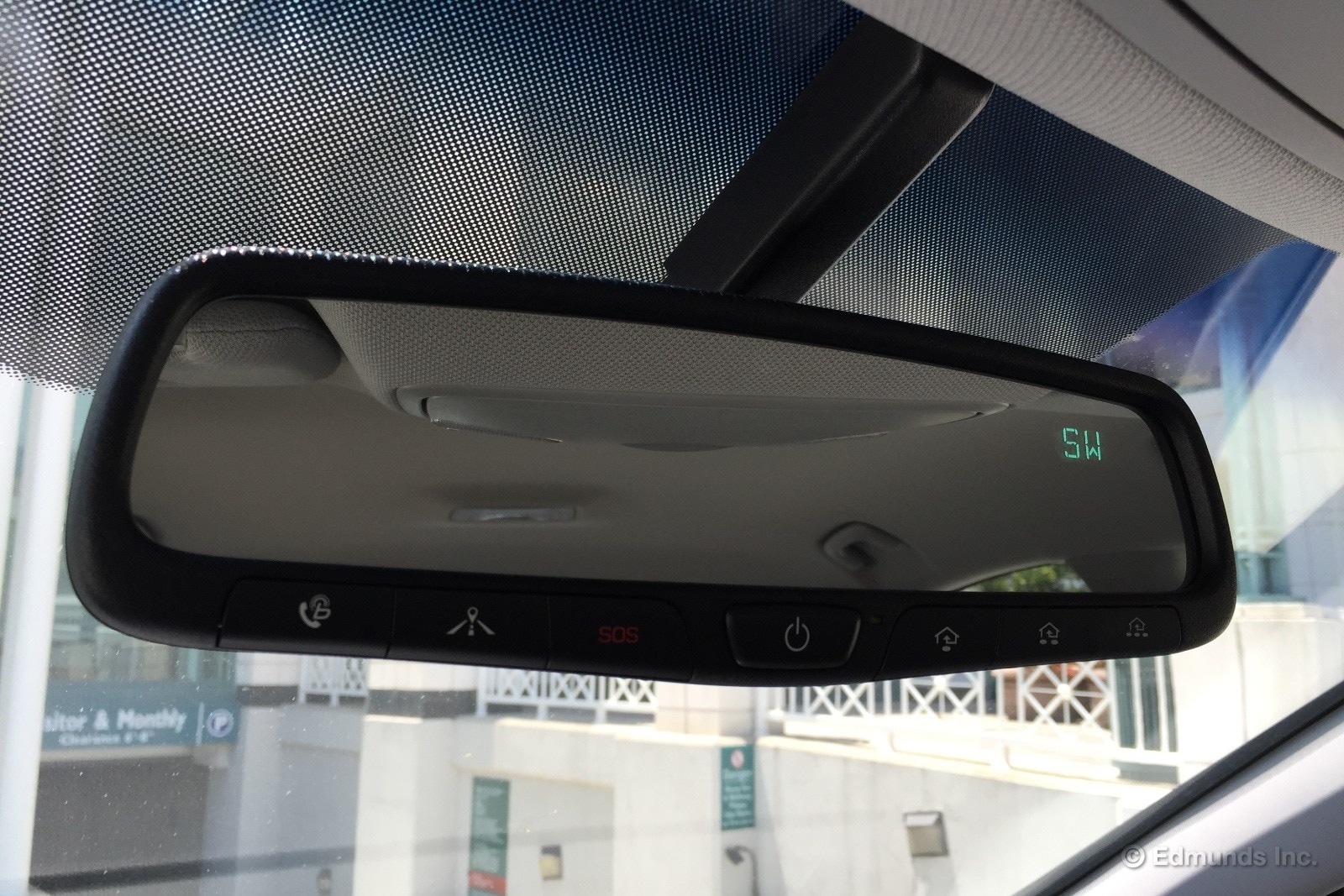
Brent's public shaming of the M235i's bare-bones rearview mirror (among other things) struck a chord with me, because I had our $39,745 Audi A3 the other night, and it's got a non-auto-dimming, non-Homelink-having mirror, too.
Last night I hopped into our 2015 Hyundai Sonata, which rings in at a cool $27,560. Look at that mirror! Audi and BMW, eat your hearts out.
Luxury-segment shoppers are less "price-sensitive," as they say, so I'm sure there's a strong business case to be made for nickel-and-diming on stuff like this. But what a pleasant surprise to find a full-featured mirror in a car that costs nearly $5,000 less than the average transaction price these days.
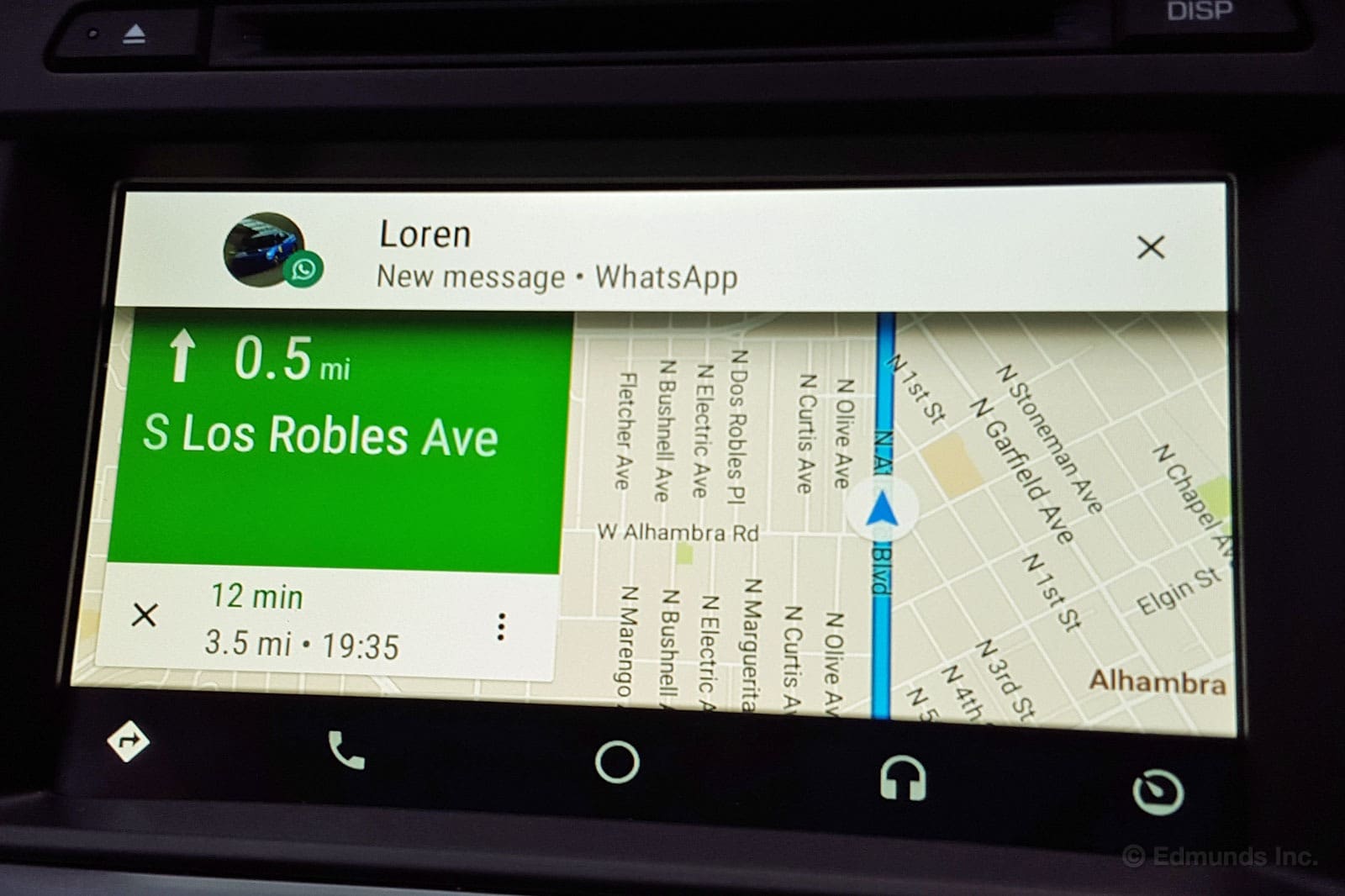
Unquestionably, Android Auto transforms our long-term 2015 Hyundai Sonata's navigation system experience for the better. But the main reason I decided to switch to an Android phone a few months back is the interface's support for third-party messaging apps.
Yes, I know. Most cars already give you speech-to-text capability for SMS texts. But I only send regular text messages when I have to. During the workday, my husband and I exclusively use WhatsApp to communicate about things large and small (it was the best app we could find after we gave up our BlackBerrys and could no longer use BBM). And Android Auto supports WhatsApp.
As I demonstrate in this video, the WhatsApp interface within Android Auto is basic but functional. You can tap a message when it comes in to have it read to you.
Then, you can either hit the mic icon in the upper right corner of the screen or long-press on the Talk button on the Sonata's steering wheel. You really do have to long-press on this button, by the way, because a short press takes you back into the car's native voice control system.
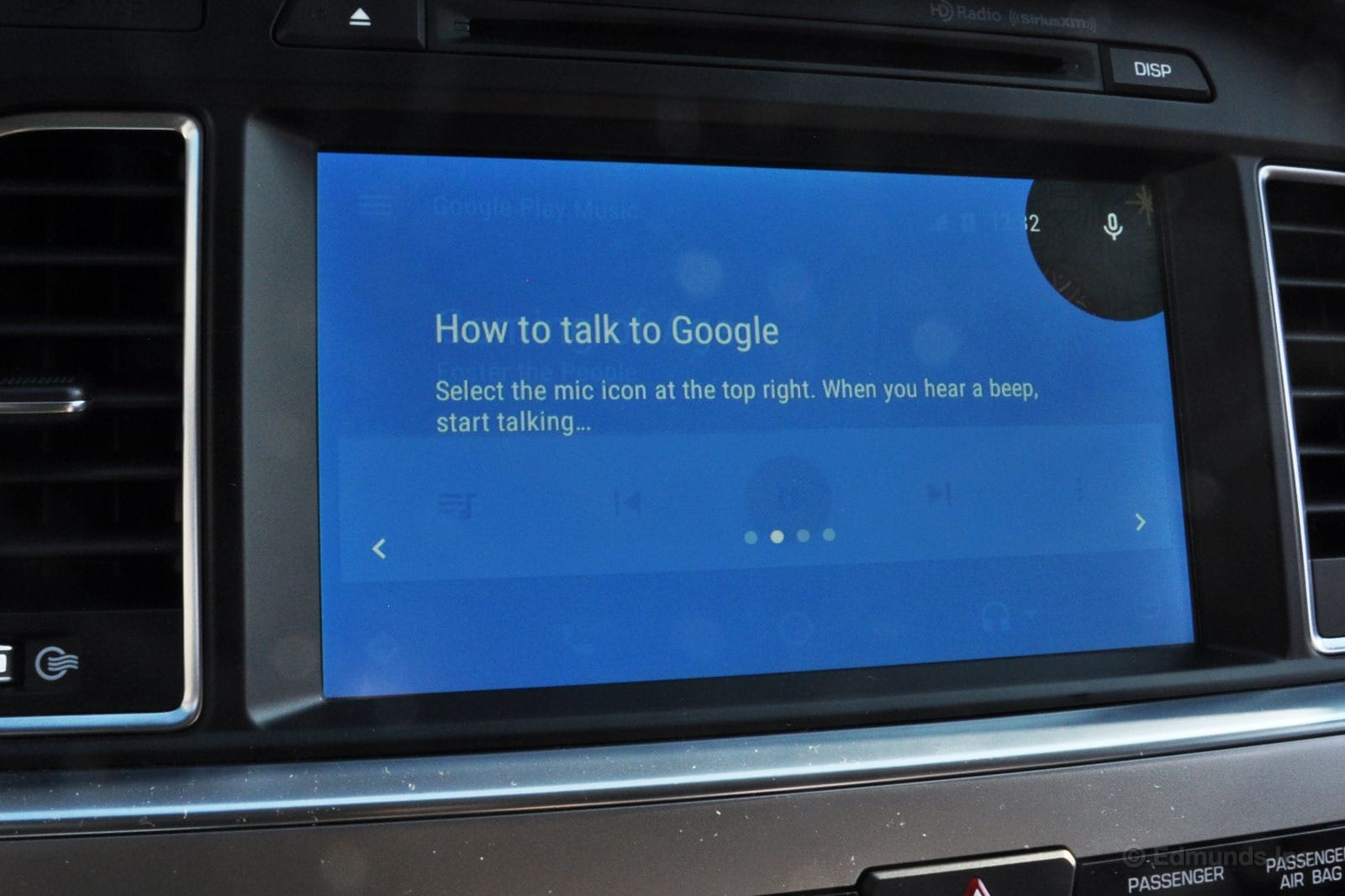
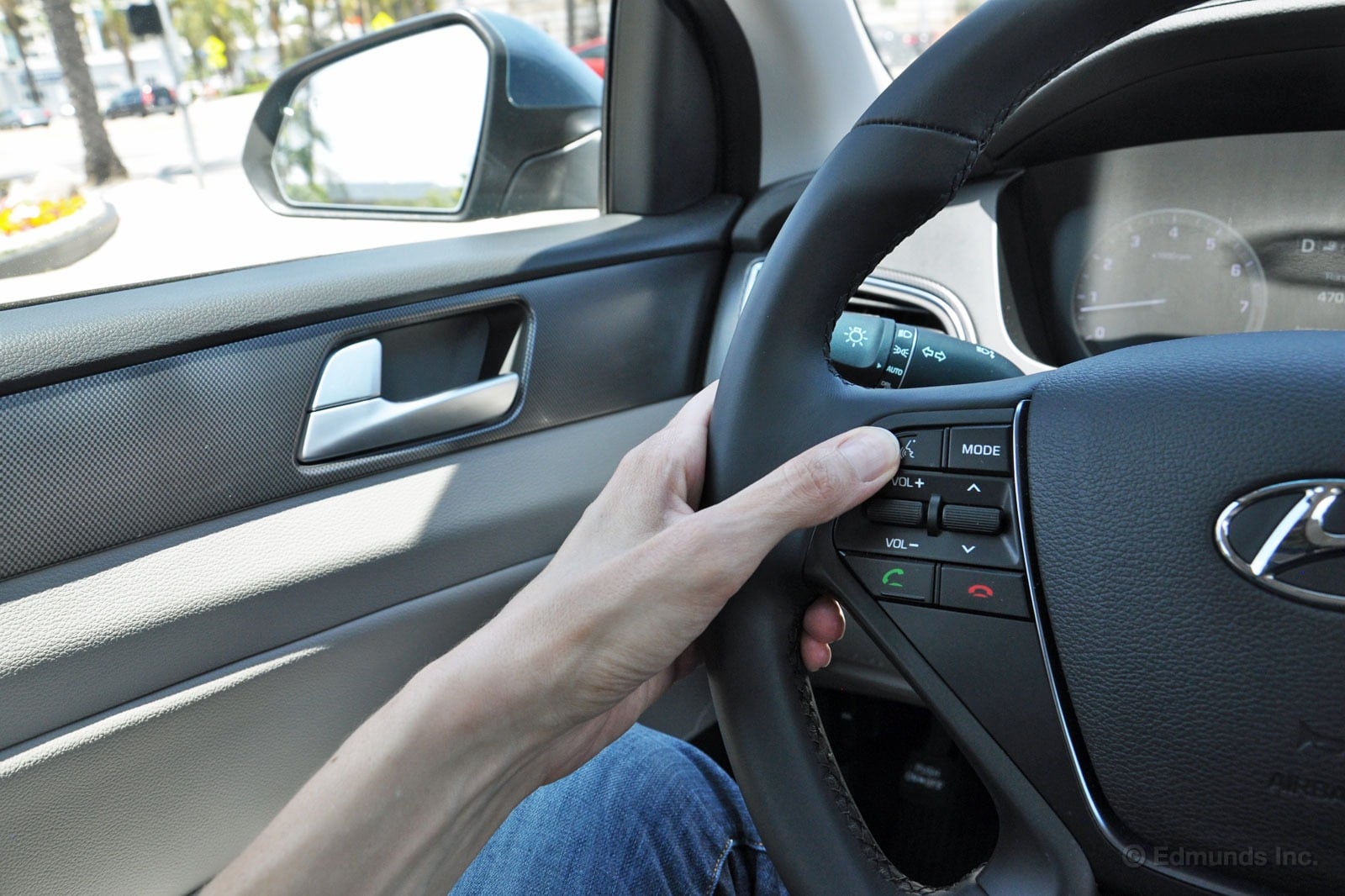
An obvious downside is that if you WhatsApp with multiple people, you can only communicate with the one who messaged you most recently when you're in the Hyundai Sonata. You can't select a specific contact name, and so far, "Reply" is the only voice command I've found that works. This very lengthy report on Android Auto goes into more detail about the limitations of messaging with the current version.
If I had more friends, these limitations would bother me. But for the moment, I only exchange WhatsApps with my best friend, so this very simple setup works well, which is to say, it's far better than not being able to WhatsApp at all.
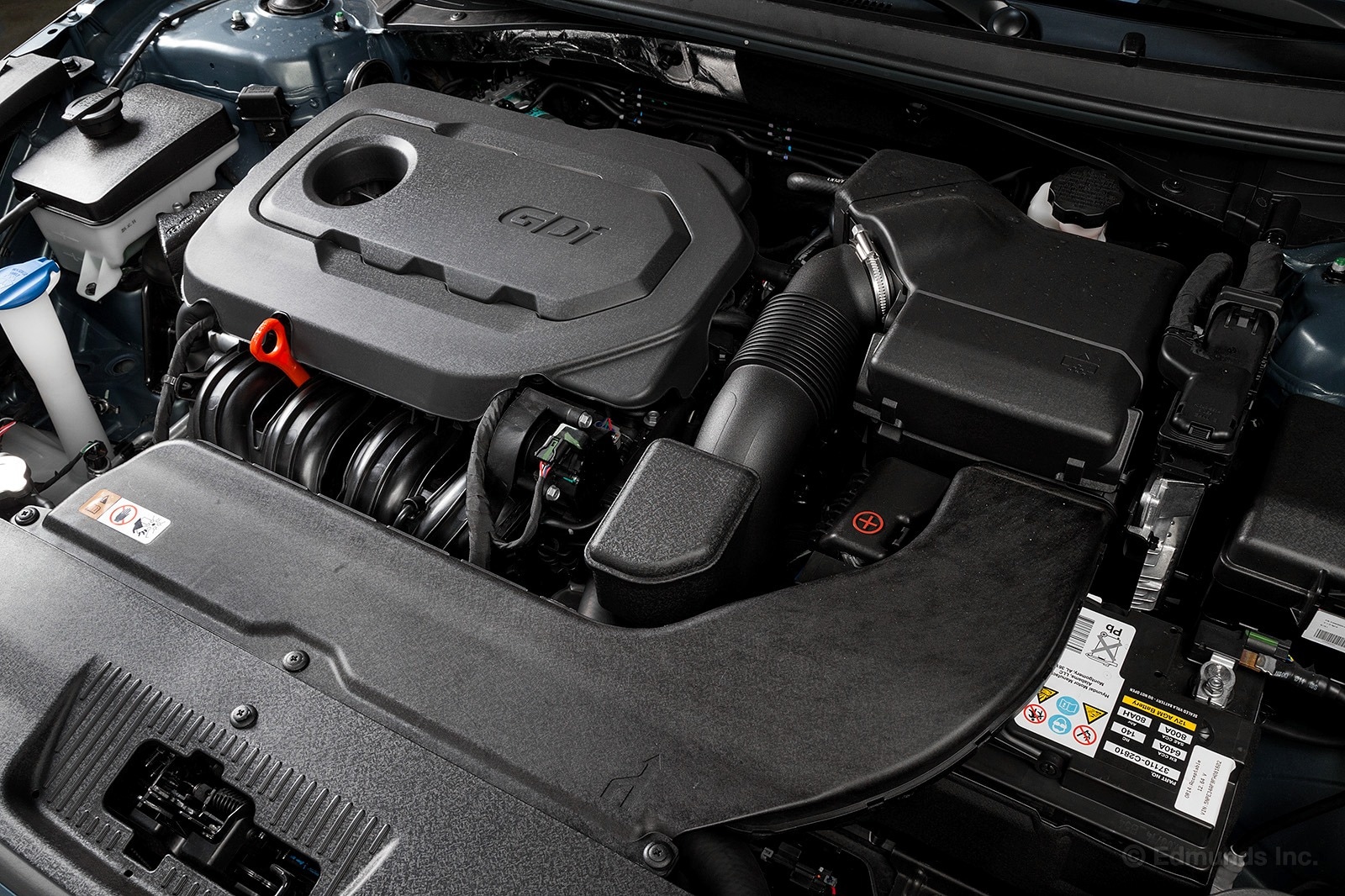
In July, while doing our best not to blow our fingers off like our NFL role models, our 2015 Hyundai Sonata kept its air dam down and covered another 1,000-plus miles. And while there wasn't much to report, short of an alignment correction and surpassing 10,000 miles, that's not a bad thing as no news is usually good news.
But we did dump a bunch of fuel in our Sonata and you came here to see how efficiently it was used, so let's not waste any more time.
On the downside, the Sonata is still a not-insignificant 2.4 mpg below the EPA's rating. But on the upside, it has been clawing itself out of the hole we put it in as it's been steadily increasing that average over the last three months.
For this month, three out of the four tanks surpassed 29 mpg and I wouldn't be surprised to see the Hyundai break the 27-mpg mark by the end of its time with us.
Worst Fill MPG: 16.2
Best Fill MPG: 32.3
Average Lifetime MPG: 25.6
EPA MPG Rating: 28 Combined (24 City / 35 Highway)
Best Range: 429.8 miles
Current Odometer: 11,288 miles
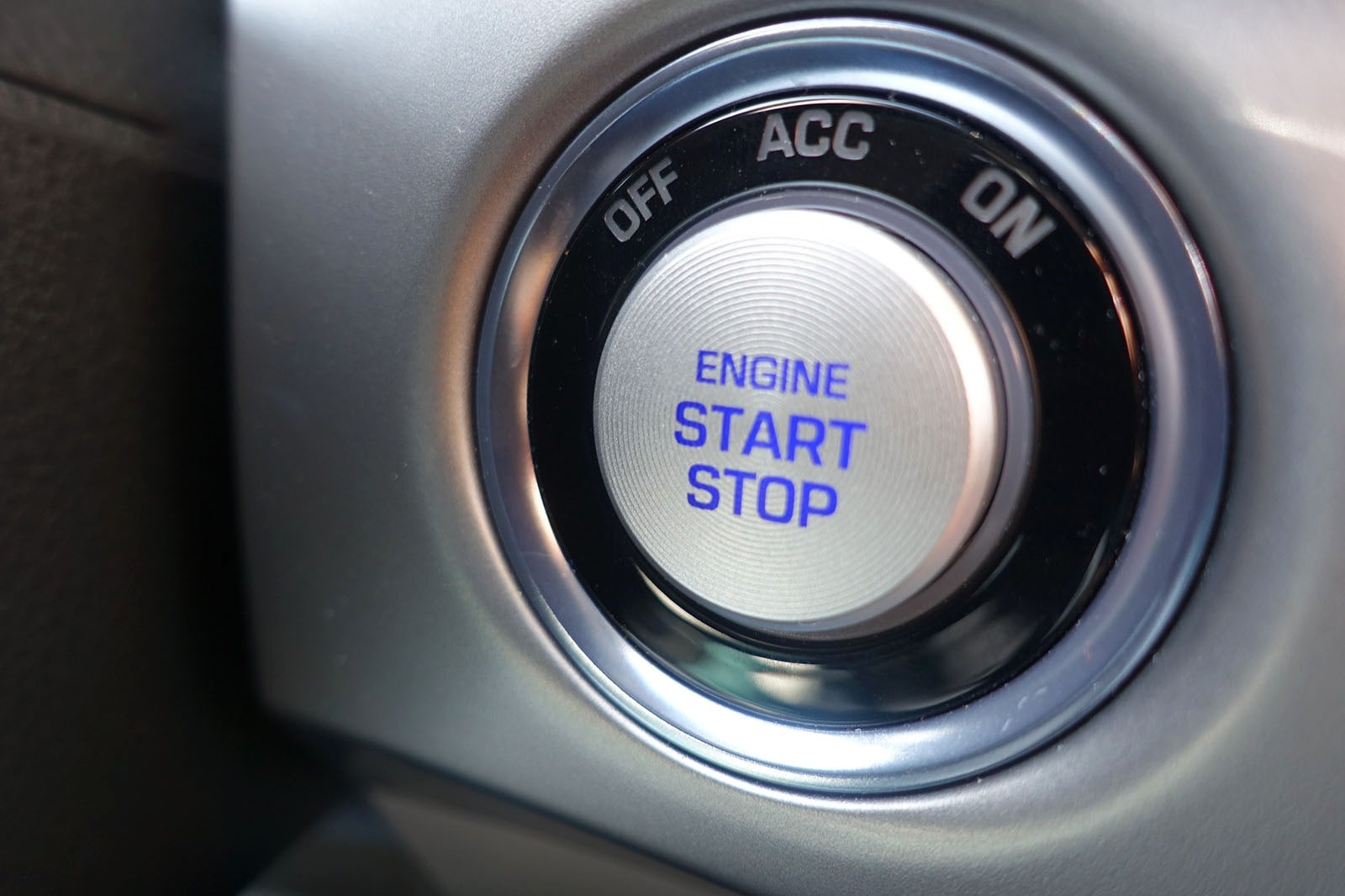
Looking at our long-term 2015 Hyundai Sonata, it's amazing that it costs $24K. In a previous update, Ed Hellwig gave the exterior props for its handsome, tasteful, and expensive-looking styling.
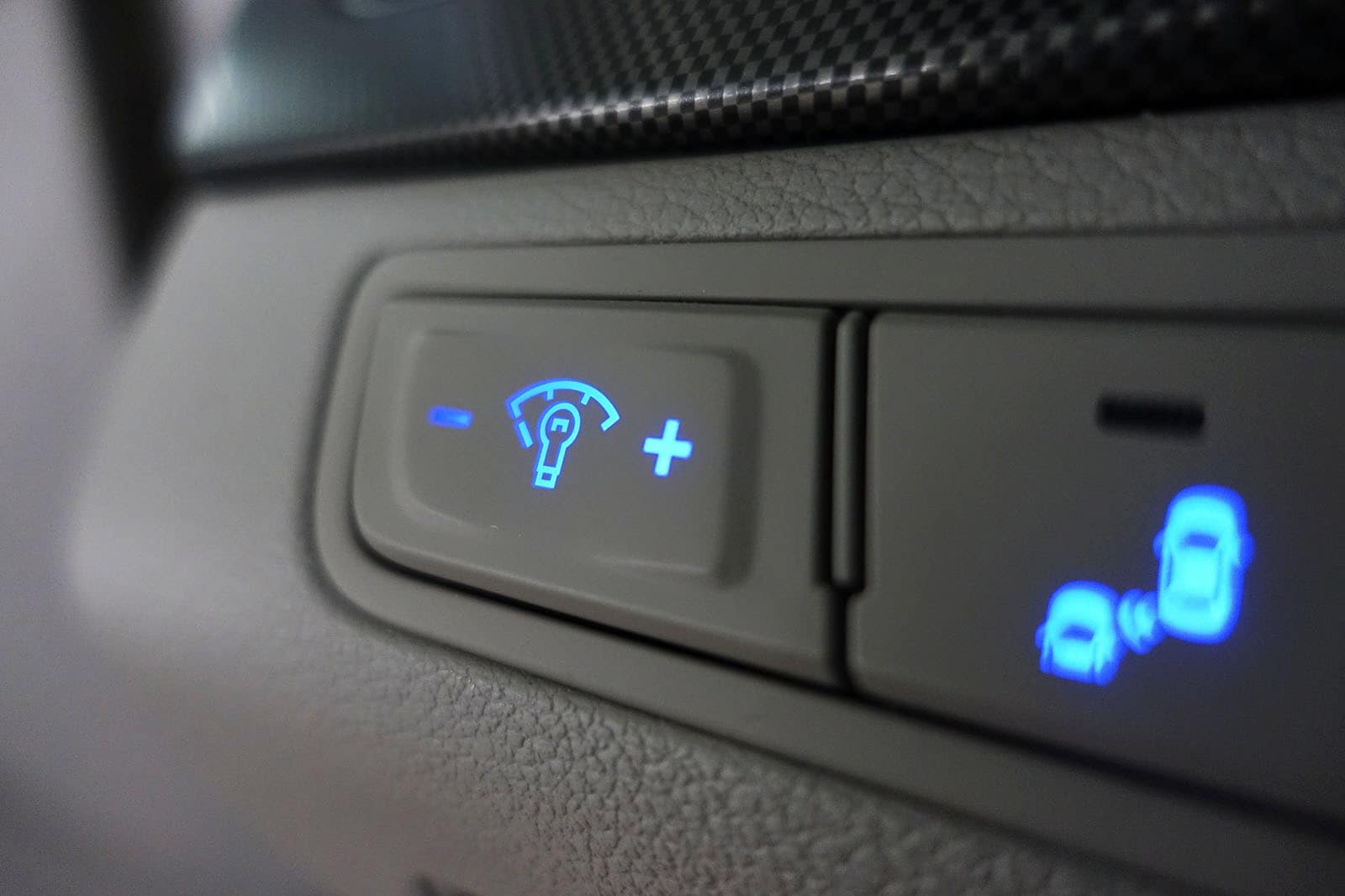
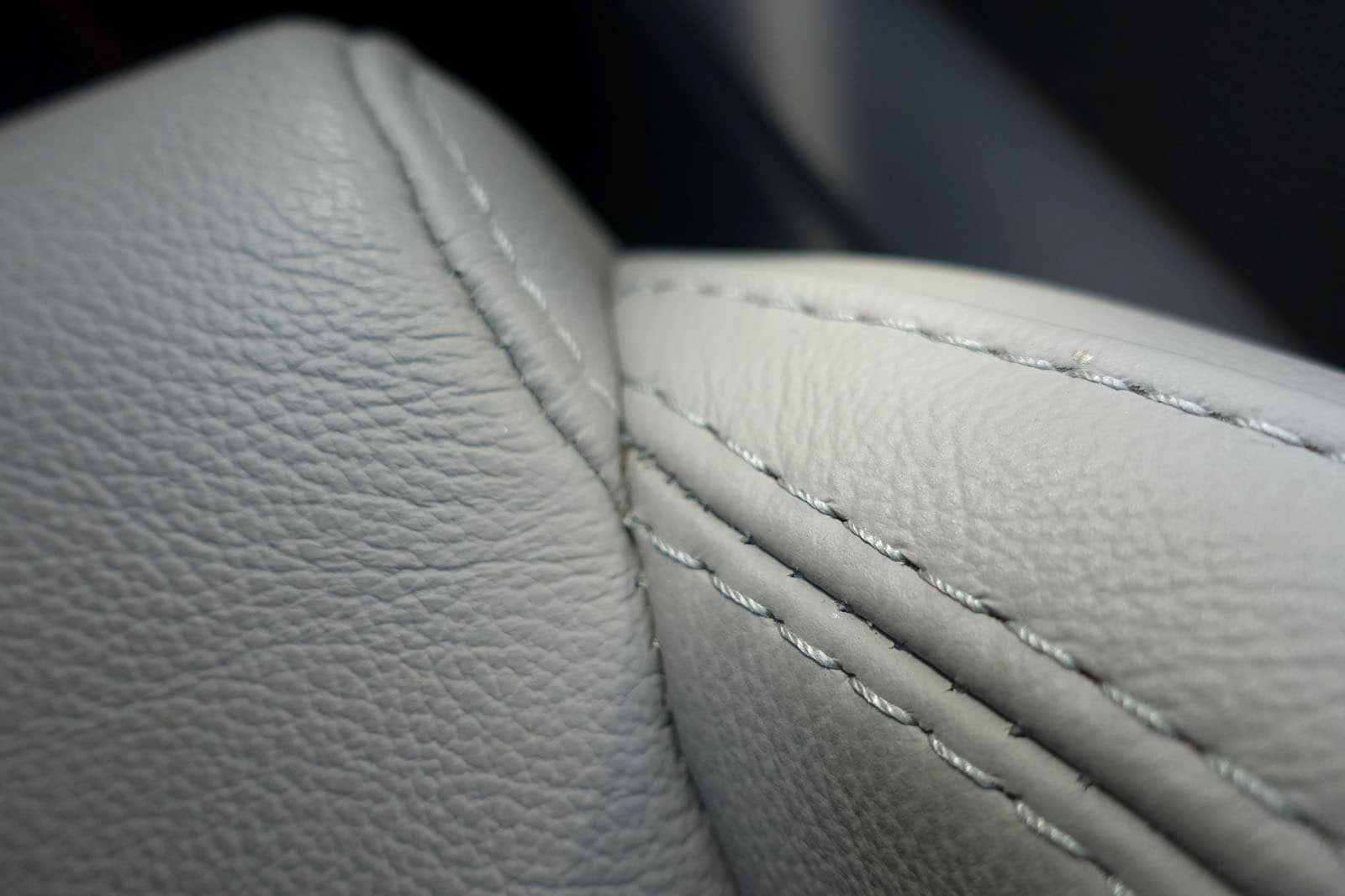

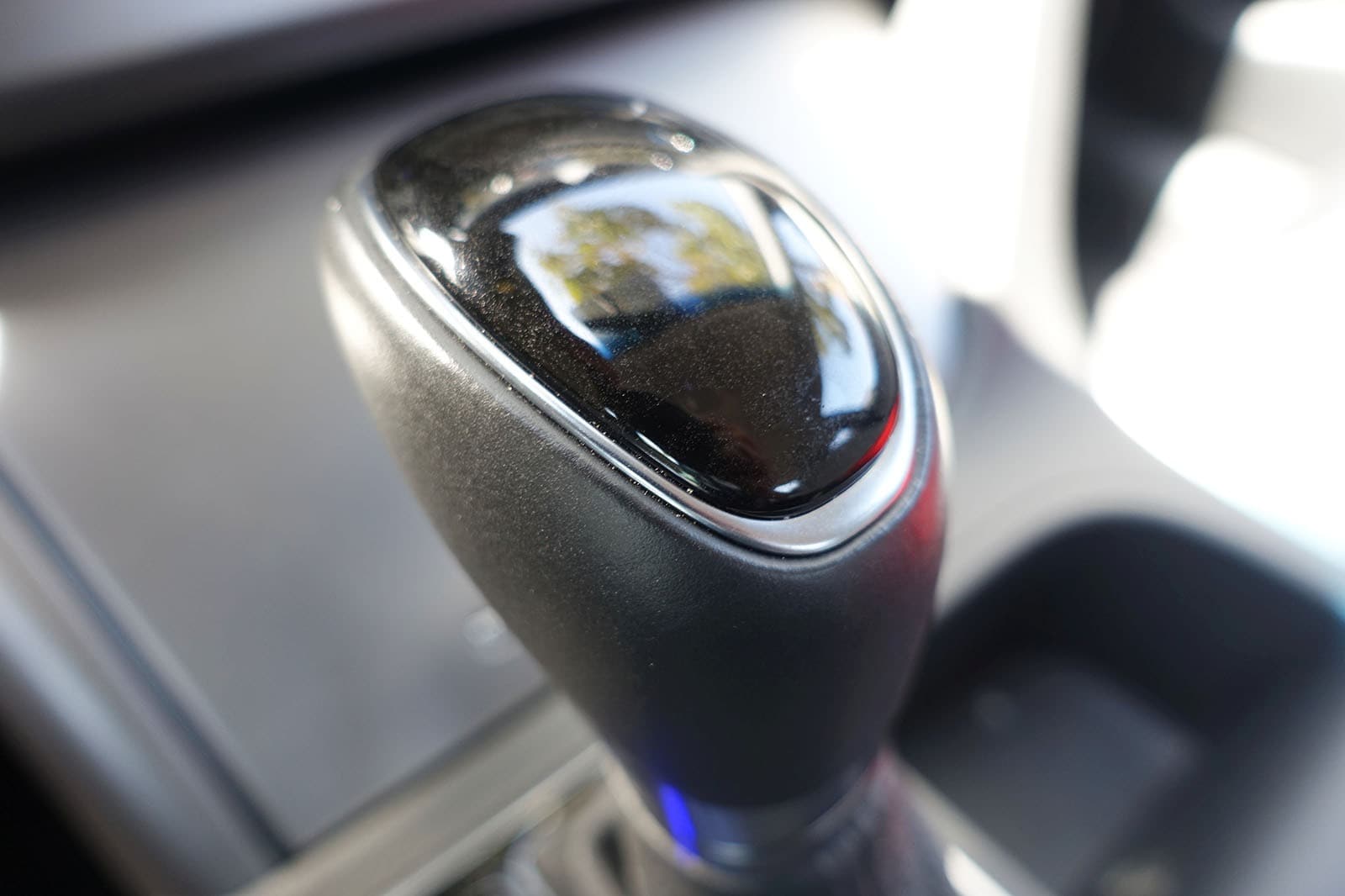

But check out its interior. Everything is nice to the touch. The surfaces don't feel cheap. You gotta appreciate little details like that fingerprint-esque pattern on the start button and the matte silver touches.
What do you think?
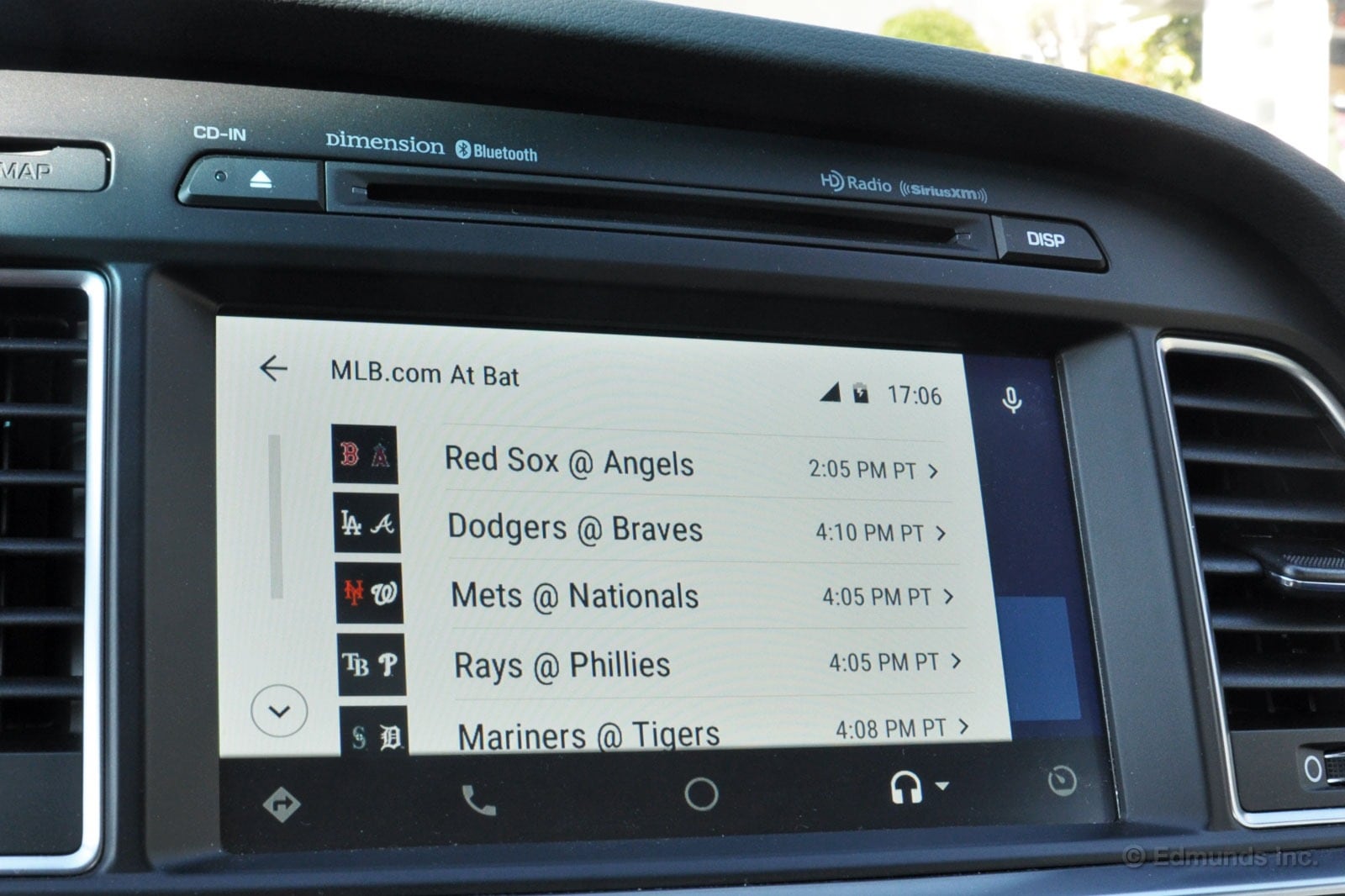
Without question, I wouldn't be as big a fan of Android Auto in our long-term 2015 Hyundai Sonata if it didn't support apps that I already use and like. I've already told you about my experiences with the Google Maps navigation system takeover and the integration of the third-party messaging app WhatsApp.
But Android Auto's support for the MLB At Bat app really makes me happy.
Of course, if you're a paid subscriber to MLB At Bat, you don't need Android Auto to listen to a game in a car. In the past, I've played it as a podcast when I had an iPhone and was plugged into the USB port, or when that didn't work, streamed it via Bluetooth. But in either case, the process is clunky. You have to select the game on your phone before you start driving, and it's easy to derail the feed whenever you stop the car, possibly causing you to miss critical moments in the game.
Using the app in Android Auto solves that problem. You tap the headphones icon at the bottom of the display and you'll see a list of all possible audio apps.

Assuming there are games in progress, tapping the MLB app pulls up a list of possible games. So you just choose one (as shown in my lead photo), and then pick your AM radio feed. As in the regular version of this app, there are home and road feeds in English, plus at least one Spanish broadcast.
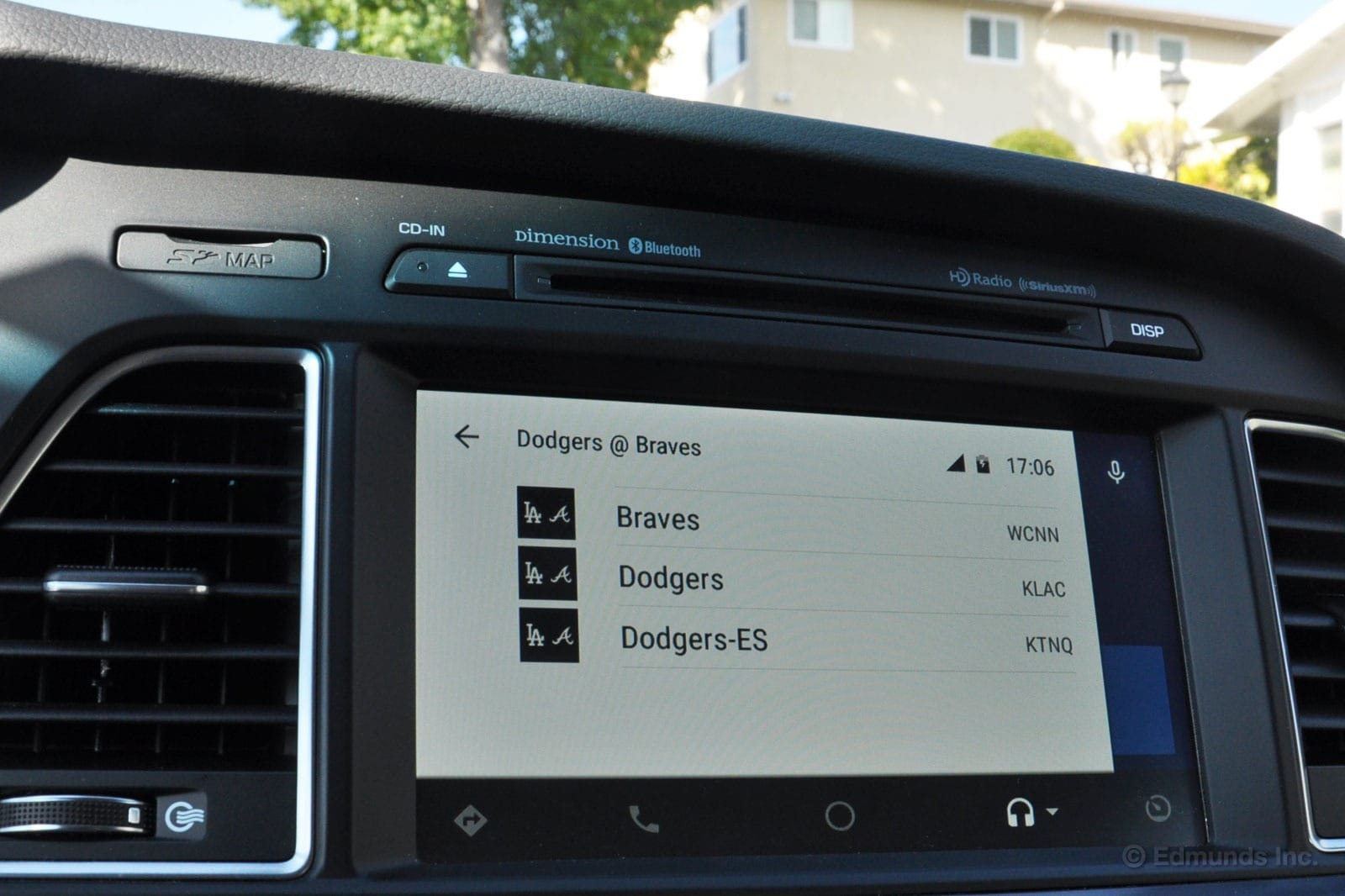
Obviously, if I'm driving around Los Angeles, there's no need to use the At Bat app to listen to the Dodgers since I can easily tune in the KLAC broadcast on AM 570. But if I'm on a road trip, or if I was a Toronto Blue Jays fan like James Riswick, you can see how useful this would be.
You can pause the game just as you can in the normal app.
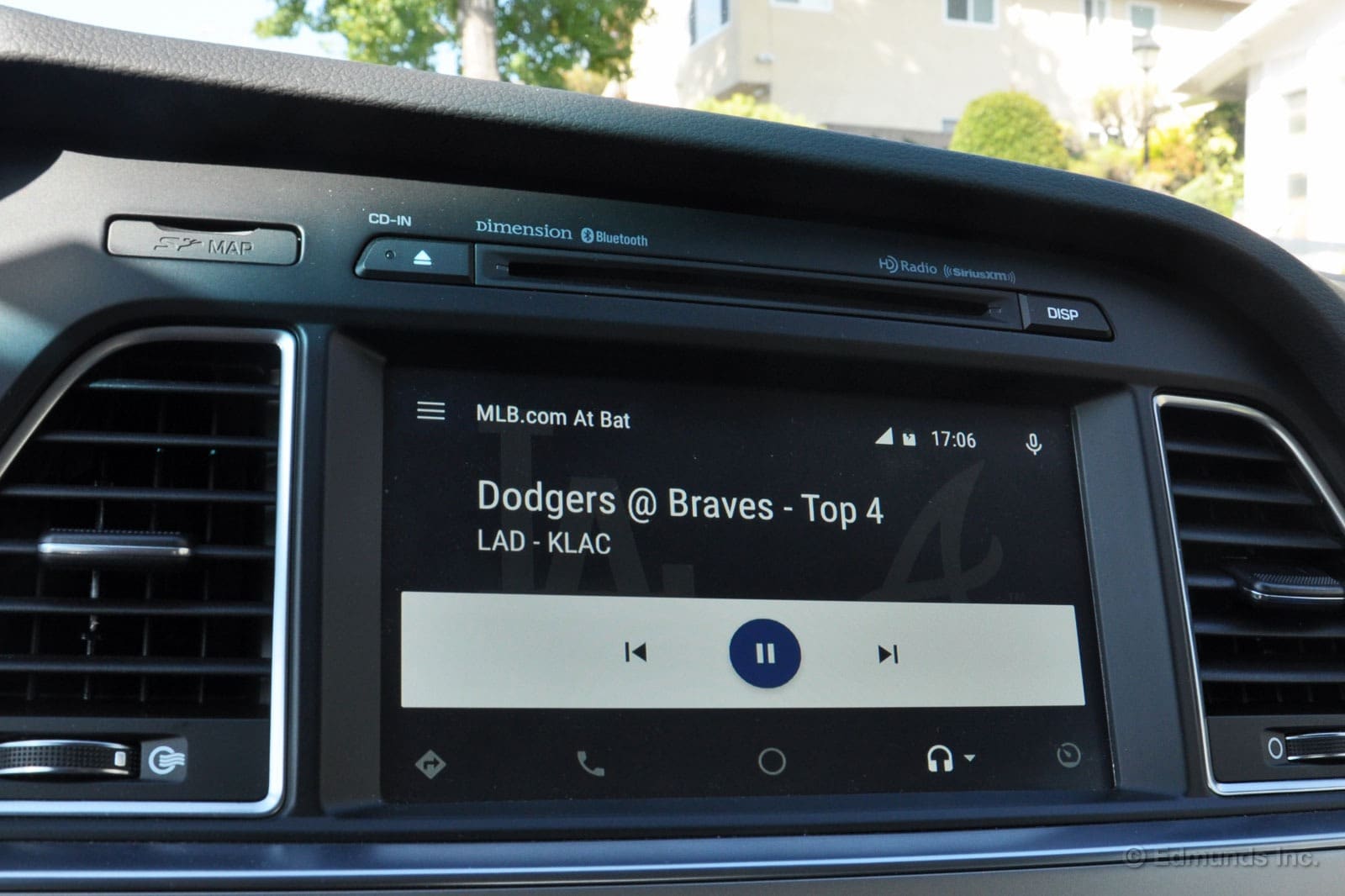
Once you have the app going, you can go to another screen and you'll get updates on the game as Google Now-style push notifications. You'll notice that mine show the inning but not the score. I believe that's because I've previously told Google not to update me with scores, because I don't want spoilers in case I've recorded the game (yeah, on the rare day that the Dodgers are televised in my area) to watch later.
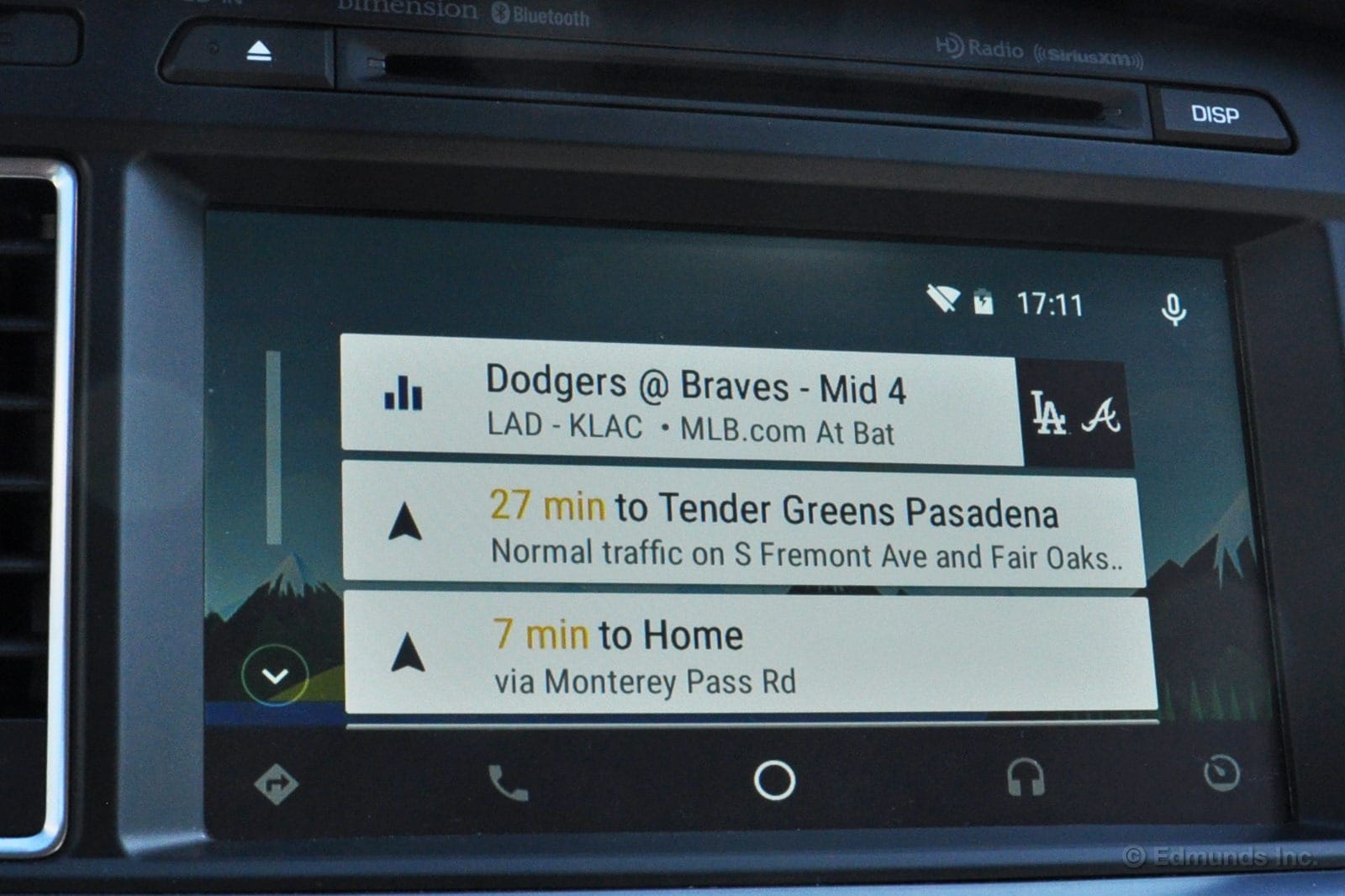
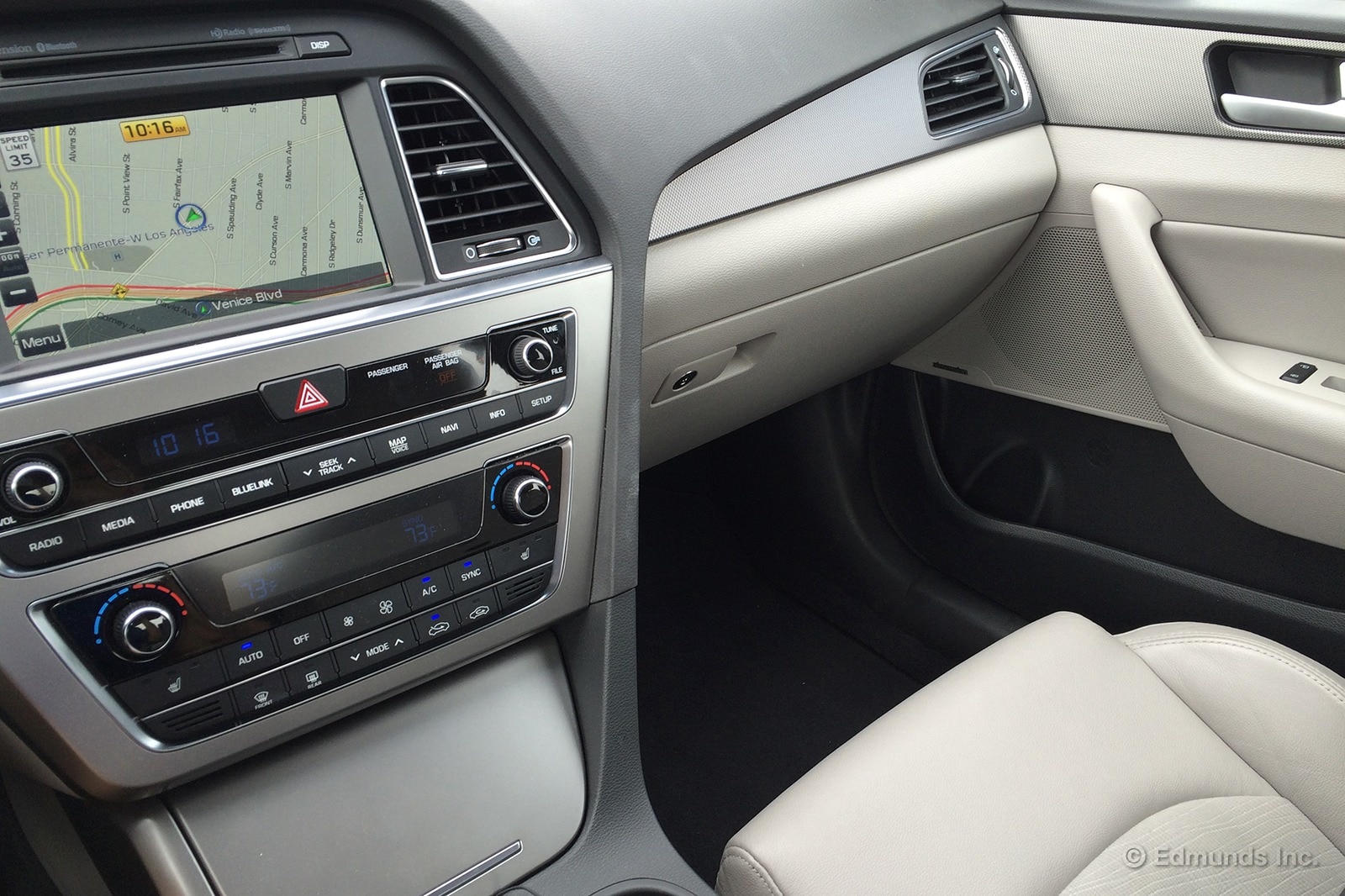
The 2015 Hyundai Sonata is just so very gray and I'm not even talking about our particular car's cabin color scheme, which could inspire the title of an E.L. James novel. Besides "gray," when I think of our Sonata, I think of such words as "agreeable," "sensible" and "pleasant." I struggle to think of anything wrong about it, and yet it's also utterly incapable of getting my pulse above flatline.
True, it's a family sedan, a segment where the bar for getting one's pulse blipping is decidedly low. And yet, just about every member of the segment apart from the dreary Chevrolet Malibu at least offers something more than simply "agreeable," be it driving verve or style inside or out.
I drove a Mazda 6 last week and found it to be both engaging to drive and appealing to look at, whether outside or in. The same could be said of the Ford Fusion, which has the added bonus of a truly impressive ride and quiet cabin that evokes a much more expensive car. Those are just two family sedans I could happily drive every day and not succumb to a daily bout of automotive ennui.
Heck, I'd happily drive the greatly improved Toyota Camry SE instead of our Sonata. Ditto an Accord, Altima or the surprisingly good Subaru Legacy.
I don't expect family sedans to be sport sedans or automotive art, but the competition is such now that they also don't have to be this dull and gray.

After telling you how much I like Android Auto in our long-term 2015 Hyundai Sonata for navigating, instant messaging and streaming baseball games, I should also say what I don't like.
My number one complaint is what you see above. The Sonata couldn't find Google, even though my phone had a cell signal. This happened immediately after I had been driving in a subterranean parking garage with no reception.
Driving along topside for a few minutes didn't seem to fix the problem, nor did unplugging and replugging the USB cable. I ended up rebooting my phone, which is inconvenient when driving.
My second complaint involves the USB cable. I don't like having to use a physical cable, but Android Auto requires it. It's especially annoying with my oddball smartphone, a Sony Xperia Z3 Compact. In order to provide a high level of water resistance, this phone has its micro USB port tucked behind a little plastic door.
It's not the sort of door you want to be prying open every day (it's delicate), so I have a Cruzerlite case that completely covers the door and instead exposes the phone's magnetic charge adapter port. To use Android Auto, I have to take the phone completely out of its case and expose its micro USB port.
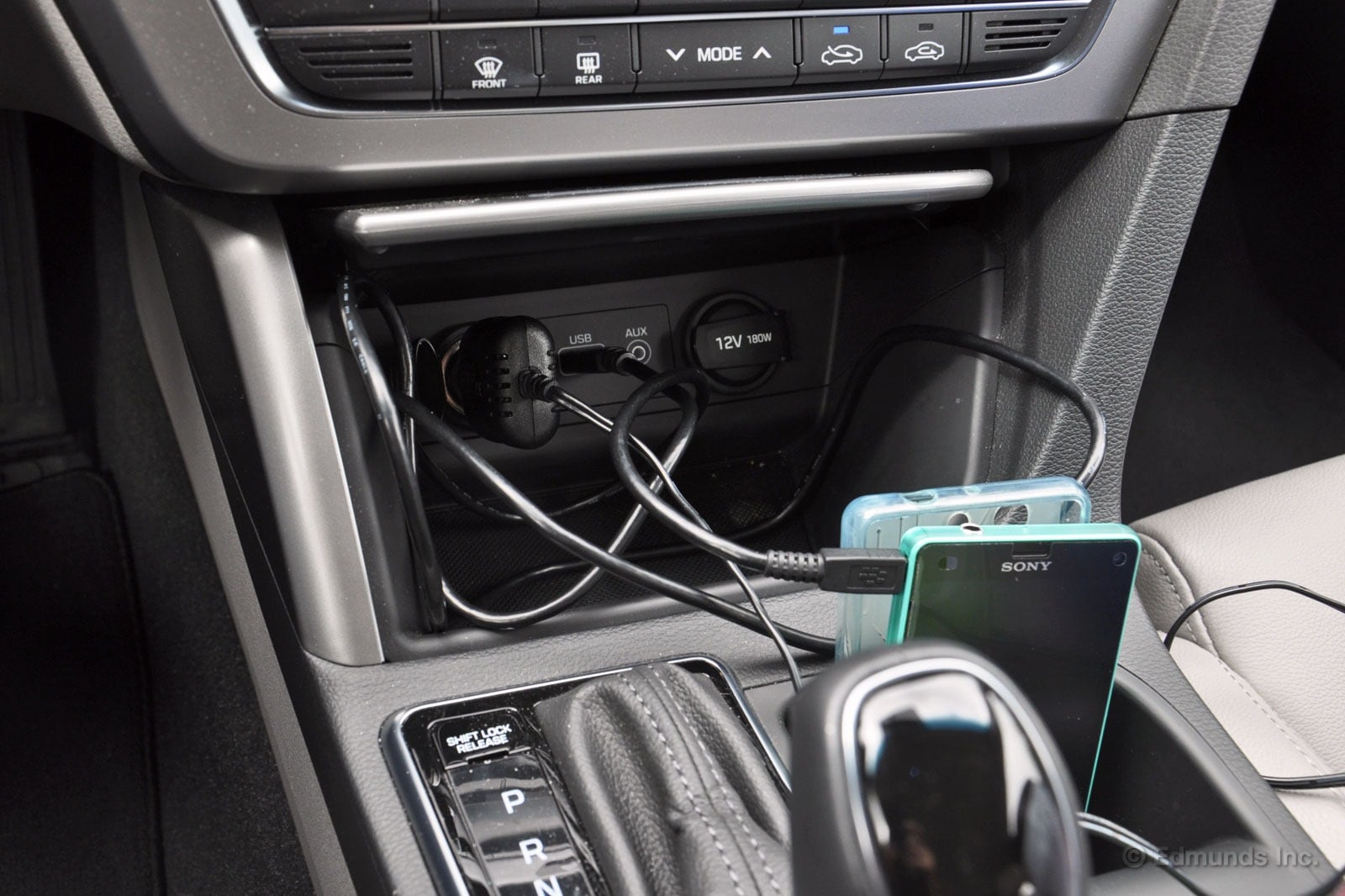
This is absolutely a problem unique to my phone and wouldn't be an issue if I had something like a Samsung Galaxy S6. But it would be nice if I didn't need to use a USB cable at all. Note the unsightly nest of cords at the bottom of the Sonata's center stack since I was simultaneously using the 12-volt outlet. Meanwhile, Apple's CarPlay will allow a wireless connection once the company releases iOS 9.
I also have a couple of complaints about the actual Android Auto experience. I can't control the "cards" that come up on the Google Now-style home screen. For example, I didn't want to go to Togo's in Montebello, California, at that exact moment, but because I'd recently searched for it on my phone, I was forced to see it in the car.
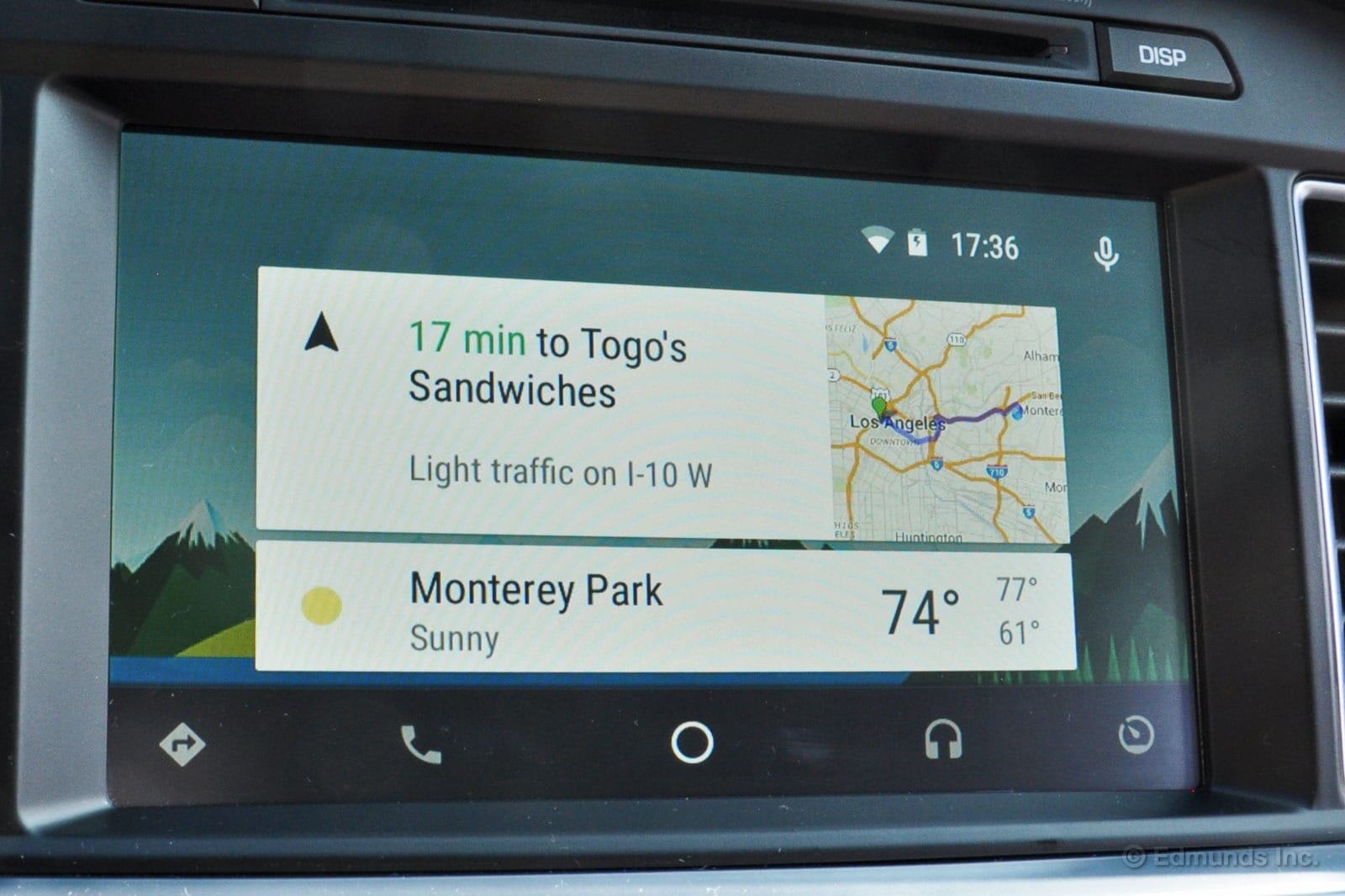
Also, because Android Auto completely takes over the Sonata's central display, you don't have the option for split-screen navigation and radio information as you see here.

Mind you, I can still listen to 91.5 FM while using Google Maps navigation, but if I wanted to see that I'm listening to that station, I'd have to call up the secondary audio display in the instrument panel.
Finally, I don't like this screen.

I checked the box for "Do not display this notice again," but it's only good for one driving session. Once you start up the Hyundai for your next drive, you must again agree to the broad disclaimers that Android Auto reserves the right to disappoint you.
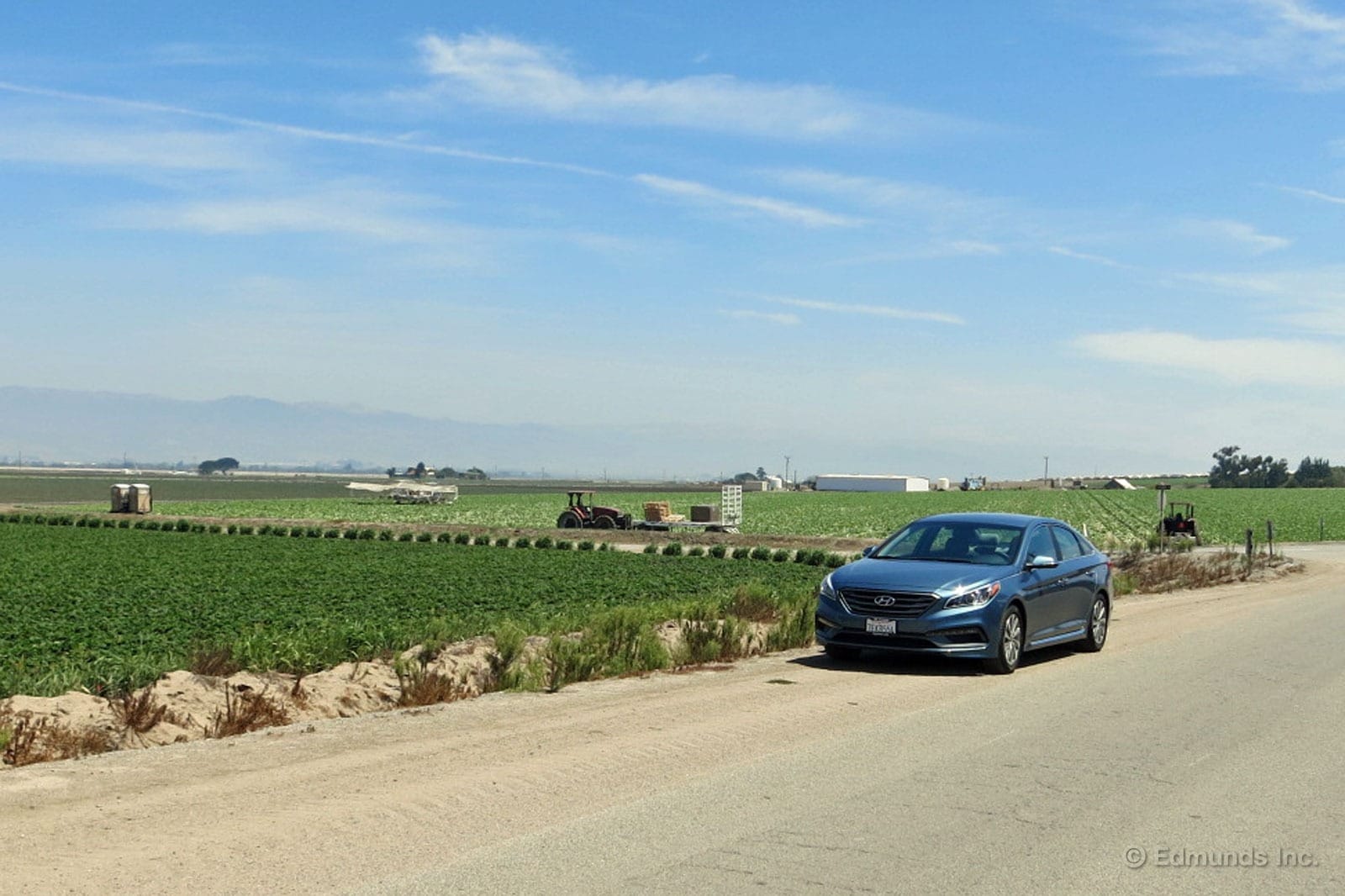
After more than 700 miles behind the wheel of our 2015 Hyundai Sonata this past weekend, I'm sold on its road trip capabilities. Here's why.
It has great seats. This is surprising since they don't boast much of a pedigree. They're not heavily bolstered or infinitely adjustable. They're not air-cooled or even covered in leather. But after several multi-hour stints behind the wheel, I rarely got uncomfortable. No squirming around to keep my rear end awake or any noticeable lack of lumbar support. I hardly noticed them at all which is good.
It gets solid mileage. Over the course of the trip, my overall average was 29.3 mpg. That's far from its highway number of 35 mpg, but there was quite a bit of around-town driving over the weekend in between the long slog at each end. It's not a bad number for a sedan of its size.
It has everything you need: satellite radio, navigation, plenty of range, big back seats and a sizable trunk. All in a car that costs just over $27,000.
Are there other vehicles in our fleet that I might have preferred? Sure. But after this road trip, I wouldn't hesitate to take this Sonata on the road again.
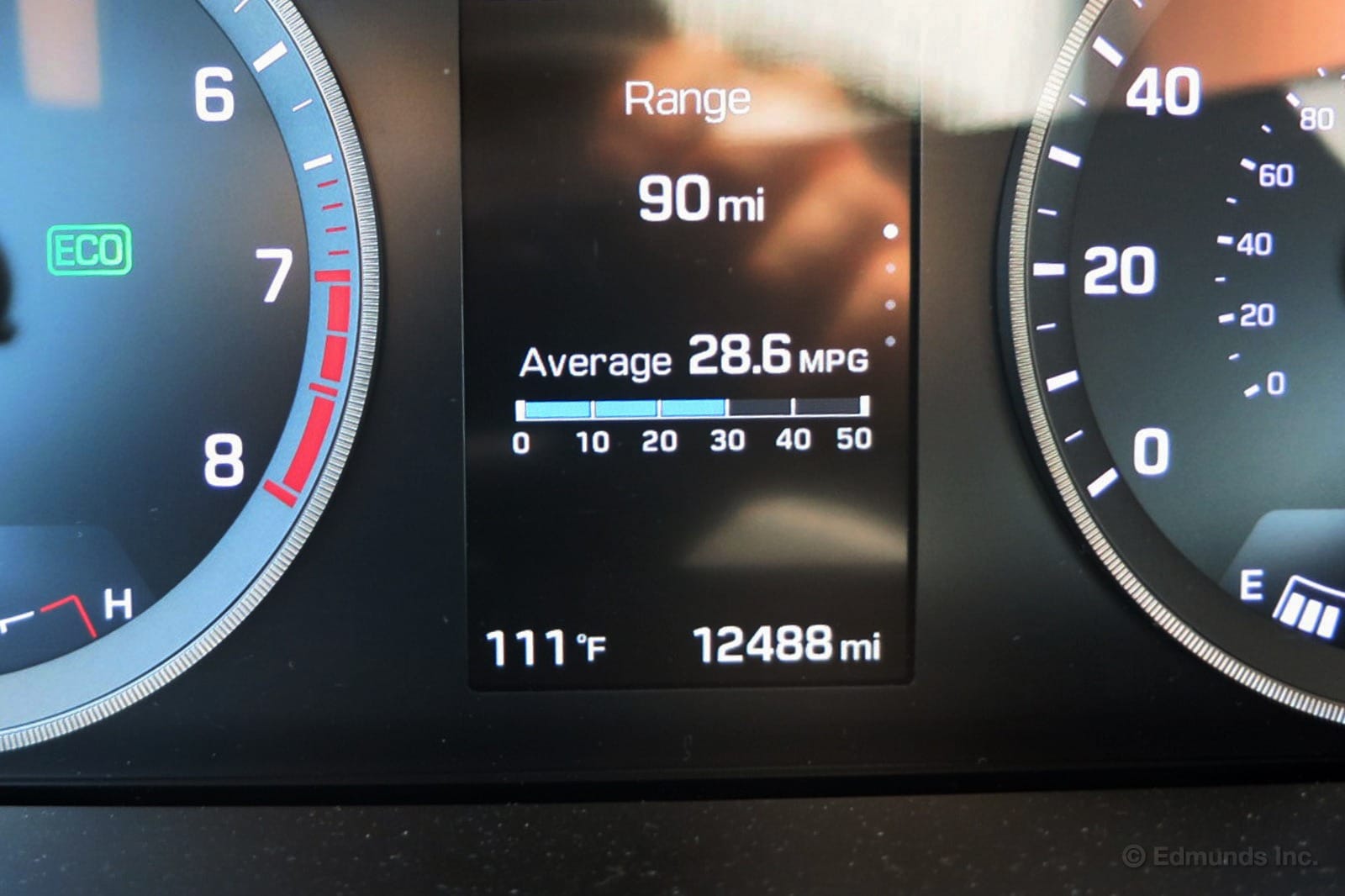
Returning home to southern California this past weekend from the more temperate central coast was an eye opener. Temperatures along the way were triple digits nearly the entire drive. Overheated cars littered the road at various spots, but the final push over the mountains into the Los Angeles basin was a particularly tough slog for some.
We counted at least a dozen cars and trucks on the side of the road with their hoods up, yet our 2015 Hyundai Sonata didn't seem to mind one bit.
With the air-conditioner blasting cold, I used the manual shift mode to keep it planted in third gear all the way up the grade. We managed to pass numerous slow pokes in the left lane and the Sonata's temperature barely budged. Not bad when it's 105 degrees outside.
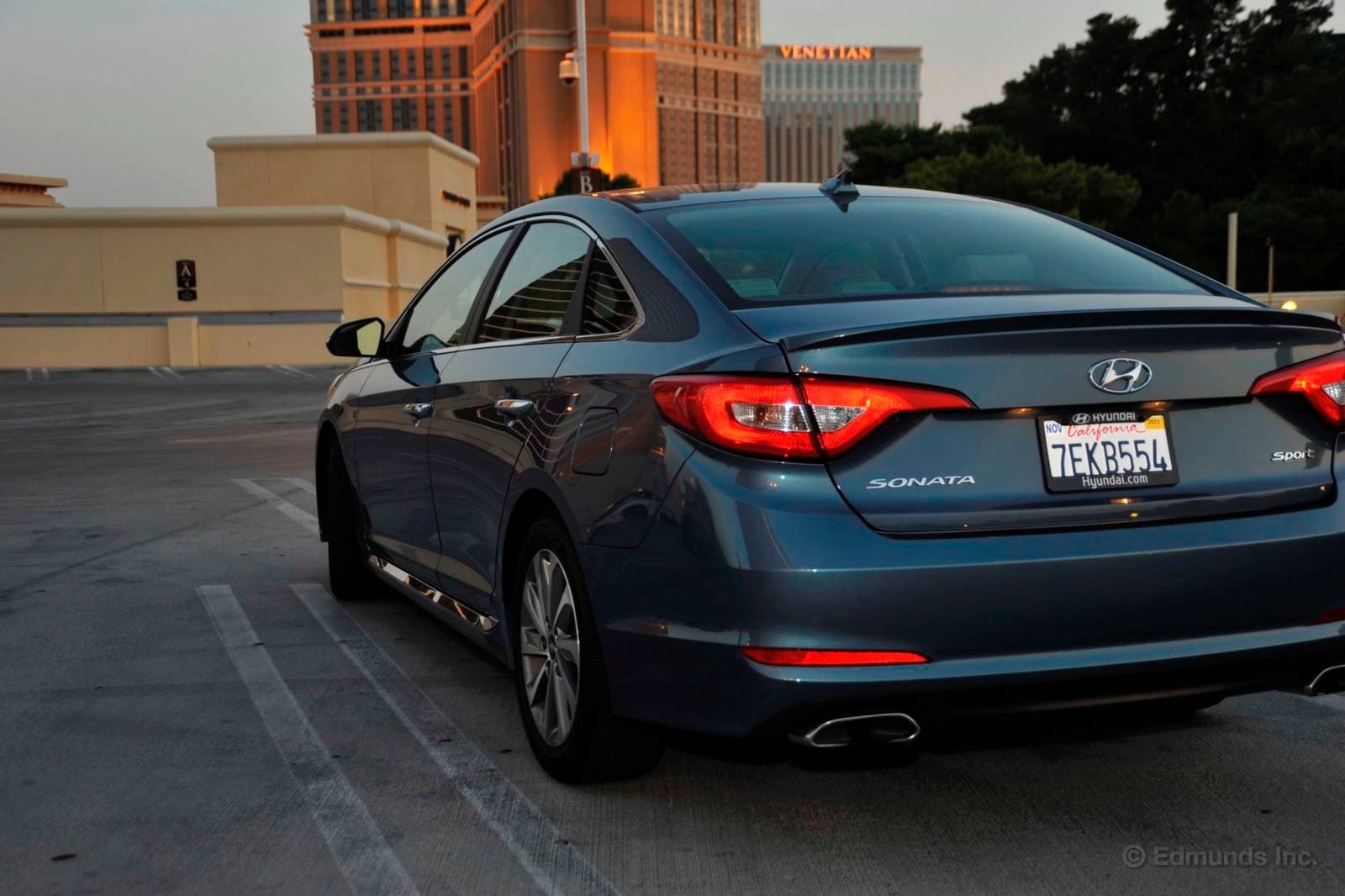
Photo by Mark S. Chevalier
Driving around Los Angeles at night there is so much light that I hardly notice the effectiveness of a car's interior lighting. But recently I drove to Las Vegas after dark, and on the long stretches of unlit interstate I came to appreciate the design of the 2015 Hyundai Sonata lighting. Two features in particular were especially thoughtful.
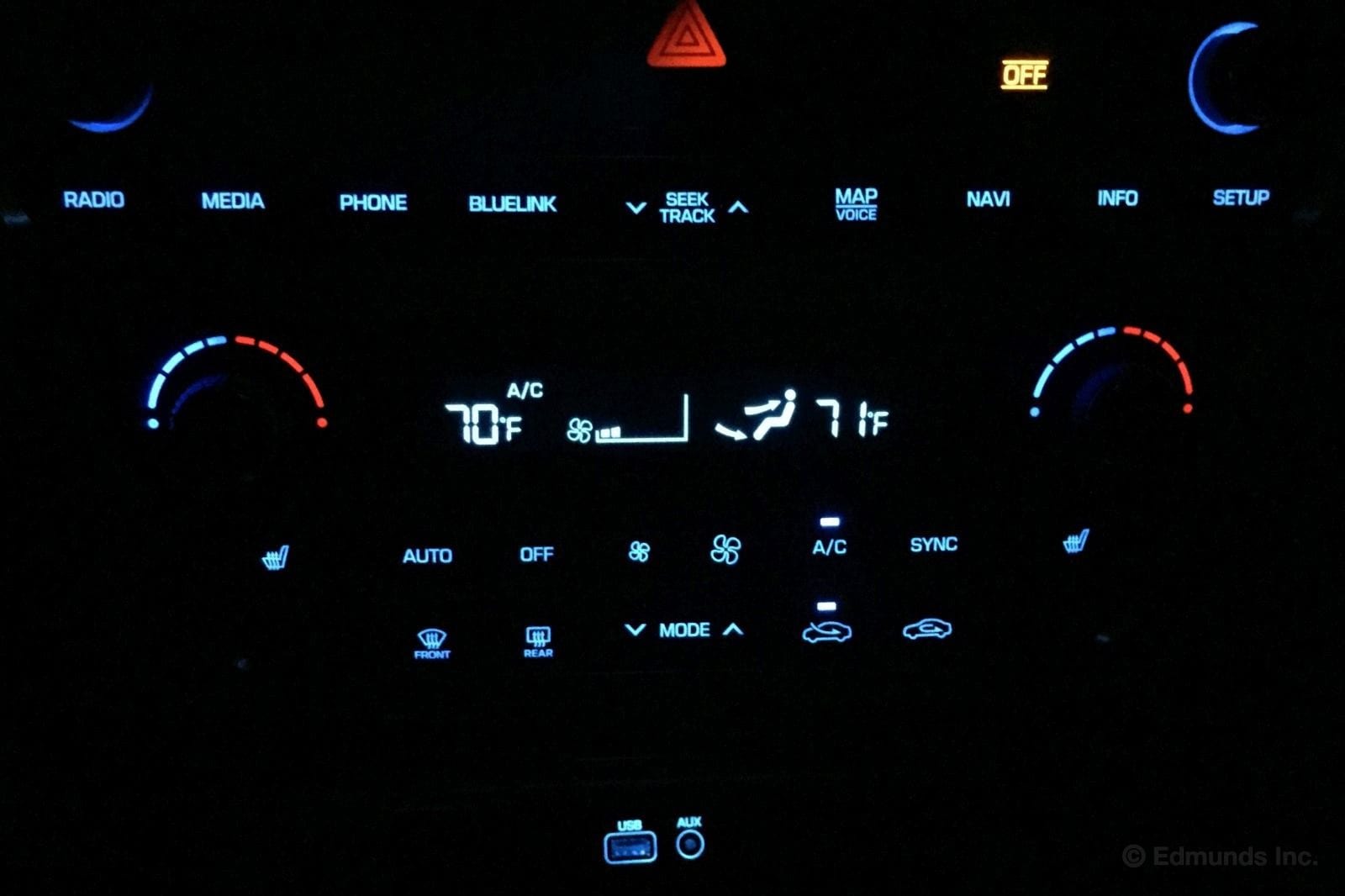
In this photo, you can see lighting that guides you to the USB and AUX connections. What you can't see from this photo is that these connections are so deep in the storage of the center console there is no way you could find them without this highlighting. It's a nice touch.
The second thing I really appreciated was impossible to photograph. It's a tiny pin light in the Sonata's roof that shines down on the storage areas in the center console. Once I cleared Los Angeles and was out in the desert, I noticed this light and appreciated the subtle illumination it provided. I didn't need to grope around blindly for things I needed.
I pictured some Hyundai designer, sitting in a test car, looking around and thinking, "Hmmmm, now where can we put a light where it won't be distracting, but it will be very, very useful?"
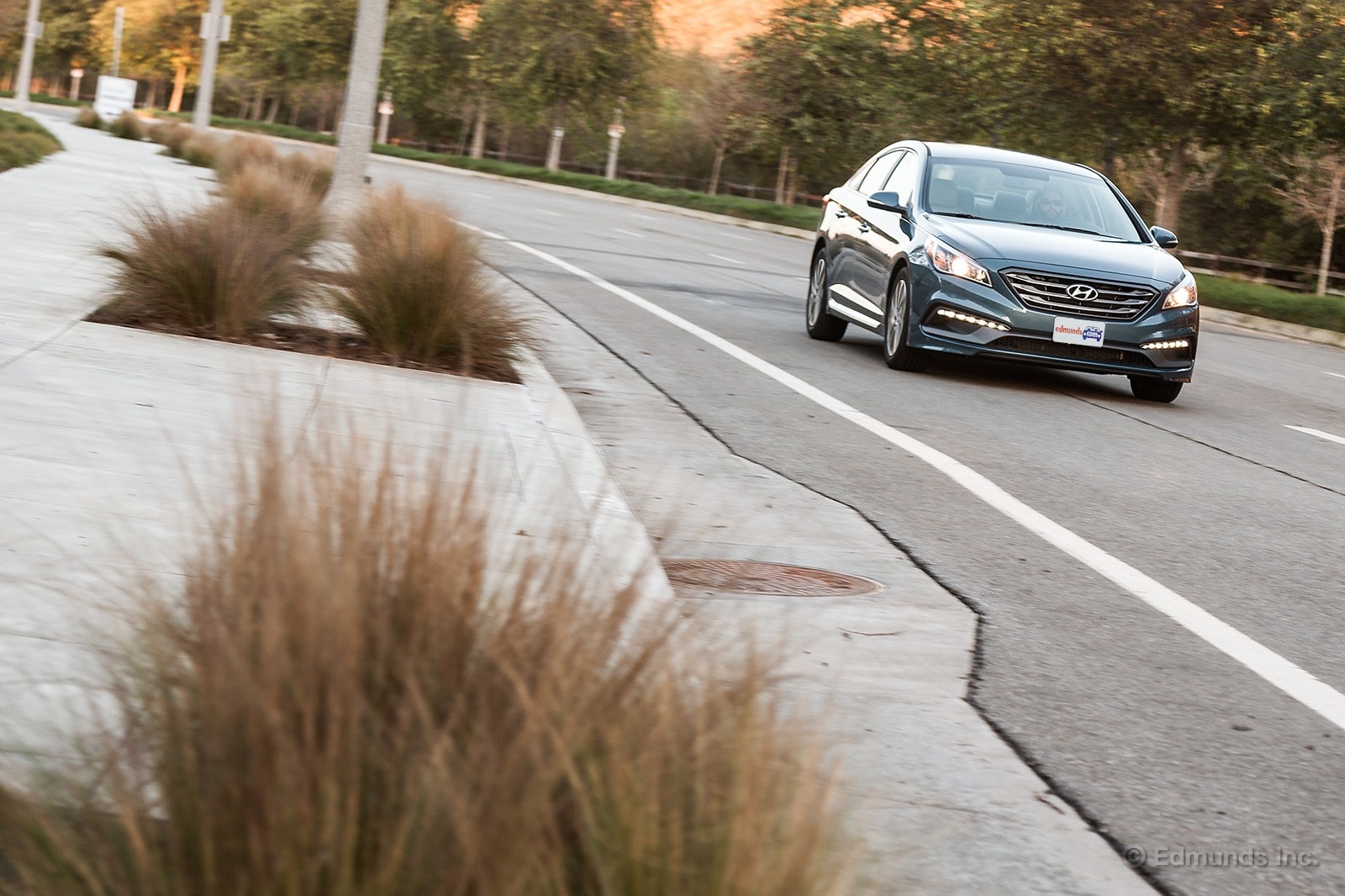
The time has come to buy a second car for my family, so I began considering the 2015 Hyundai Sonata in a completely new light. I had taken it on several road trips recently, including a recent blast to Las Vegas, and was intimately acquainted with it. My wife would be the primary driver of this new car and she's liked the long-term Sonata when I bring it home.
The problem is, I've always been heavily predisposed to Hondas. The only thing that could sway me was to see that the Sonata would either save me (us) some bucks or provide superior features. So I put the two cars in Edmunds' most useful car buying tool, the vehicle comparator (it's gone by several names over the years). I wanted to see if any significant difference jumped out.
After nerding-out over all the stats, I only saw three differences that caught my eye. The Sonata is rated at 25/37 mpg, while the Accord gets 27/36. That's not a big deal since Edmunds estimates that gas would cost $10 more per month for the Hyundai. However, our long term Sonata has struggled to get a lifetime average of 25.6 mpg, so the numbers don't tell the whole story.
The second difference is that the Sonata has a 6-speed automatic while the Accord has a CVT. This wouldn't be a problem for my wife, but I've never been a fan of the way CVTs feel and drive.
The biggest difference, not surprisingly, is in the warranty department. Hyundai has built its reputation on the 5-year/60,000-mile bumper-to-bumper warranty and the 10-year/100,000-mile powertrain warranty. Honda has taken a different tack, building its reputation for reliability, while only offering a 3-year/36,000-mile bumper-to-bumper warranty and a measly (by comparison) 5-year/60,000-mile powertrain warranty.
While it's nice to have all those worry-free years spread out in front of me, I also wonder how long I will keep this car, so it could all be moot.
Comparing prices is more difficult because that would depend, in the final analysis, on what kind of a deal you drove. The base Sonata SE stickers at $21,975, while the Honda Accord LX MSRP is $23,725 and the EX is $26,650.
So, after my blurry eyes returned to focus from staring at numbers, I realized the only way to make a decision is to test drive the Honda — and see what kind of a deal I can get on each car.
A Hyundai I'd Like to Own
I drove our 2015 Hyundai Sonata to San Francisco over Labor Day weekend and came away more impressed with the car than ever. Like Mr. Reed, I would buy one if I were shopping in this segment. No hesitation. After years of steady improvement, the Sonata is finally at the front of the pack. It's classy, capable and confident.
The new Genesis sedan is the first Hyundai in history that I'd be genuinely pleased to own, and I'm here to tell you that this Sonata is officially the second.

I took these photos in Clarion Alley, which is a must-see in the Mission according to me. That's not a roundabout way of saying our Sonata is a work of art, but I do think Hyundai nailed the styling this time. It's crisp and assertive, and a welcome change from the melting-candle look of the previous model.
I especially like the angular, LED-accented front fascia. I saw a number of new Sonatas in the rearview during the trip, and the word sophisticated kept occurring to me. That never happened before.
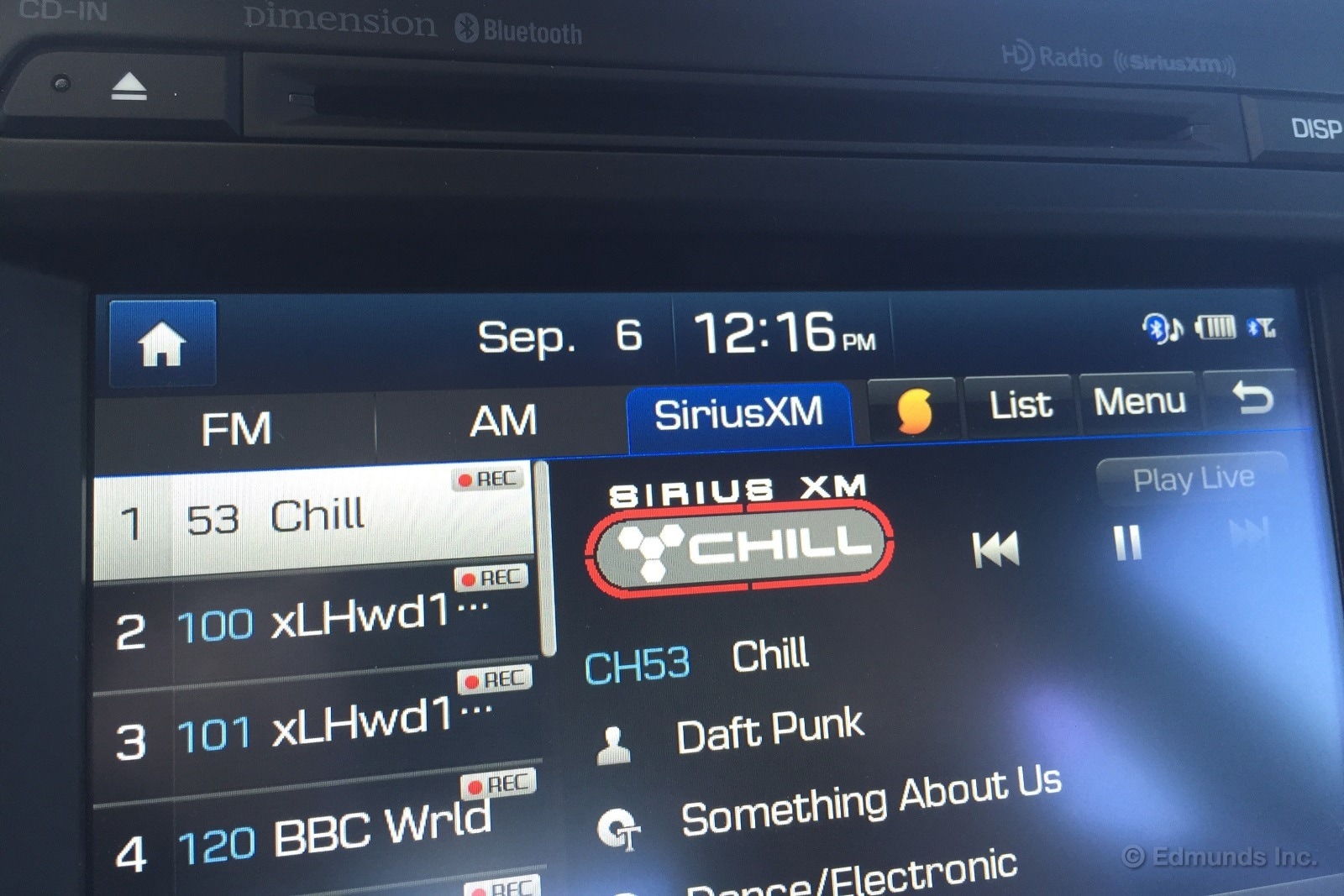
I've already complimented the Sonata's displays, but it bears repeating. From the fun font to the sharp resolution, this is precisely what a touchscreen from the land of Samsung and LG should look like. Overall, there's a "digital native" vibe inside this car that sets it apart from, say, the Mazda6 and Camry, which feel to me like analog devices with retrofitted technology. Also, I never know what the date is, so Hyundai gets bonus Sadlier Points for putting it front and center.

I did not, in fact, drive the Sonata to Scotland, although that's what this vista reminds me of. It's actually the San Luis Reservoir off Route 152, which connects Interstates 5 and 101. The access road was pretty rough, but I didn't hear a single rattle or squeak in the Hyundai's cabin. My wife's 2013 GTI with 20,000 miles would have sounded like it was about to fall apart.
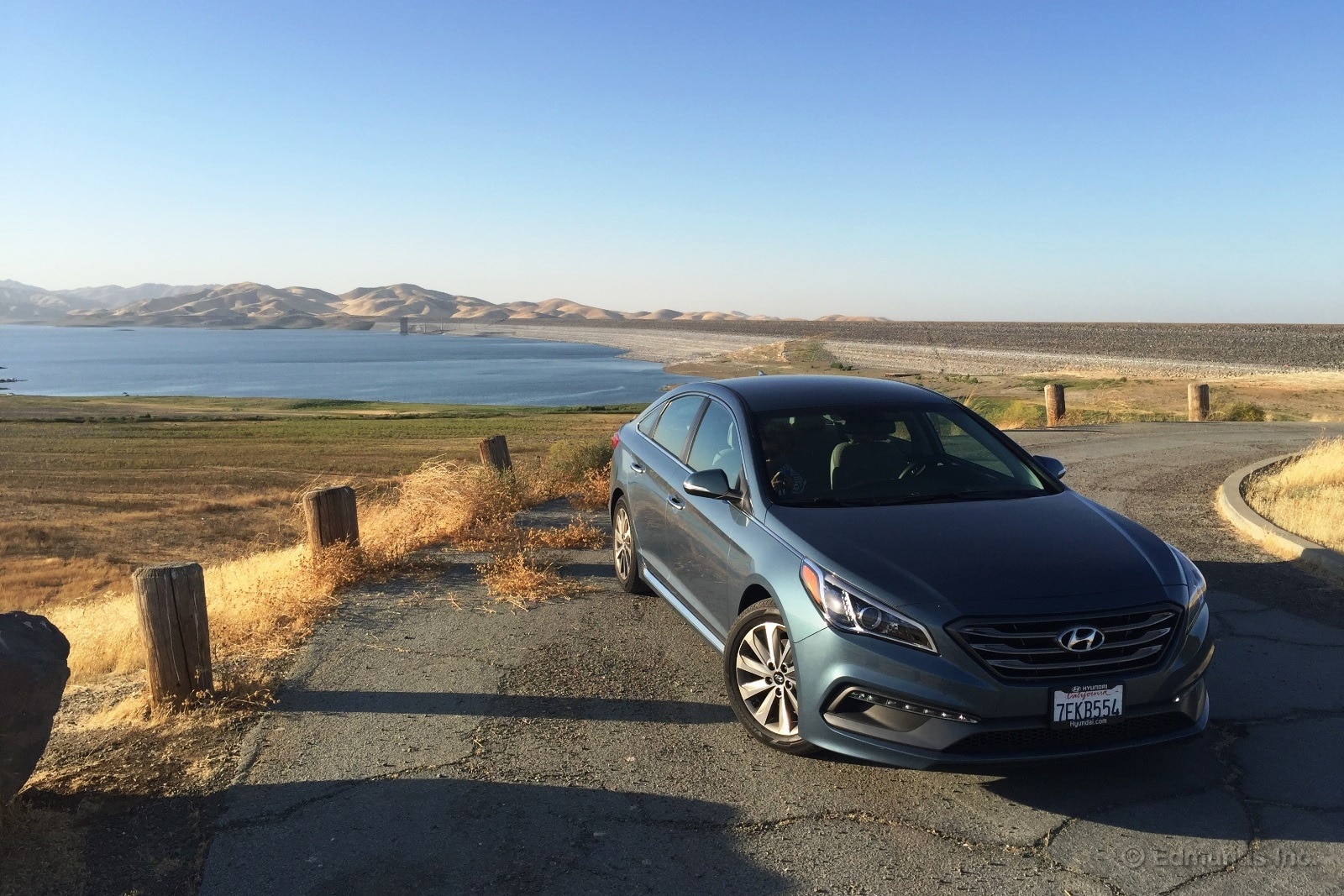
There's that front-end styling I was talking about. I mean, that's a good-looking car. It's just a fact.
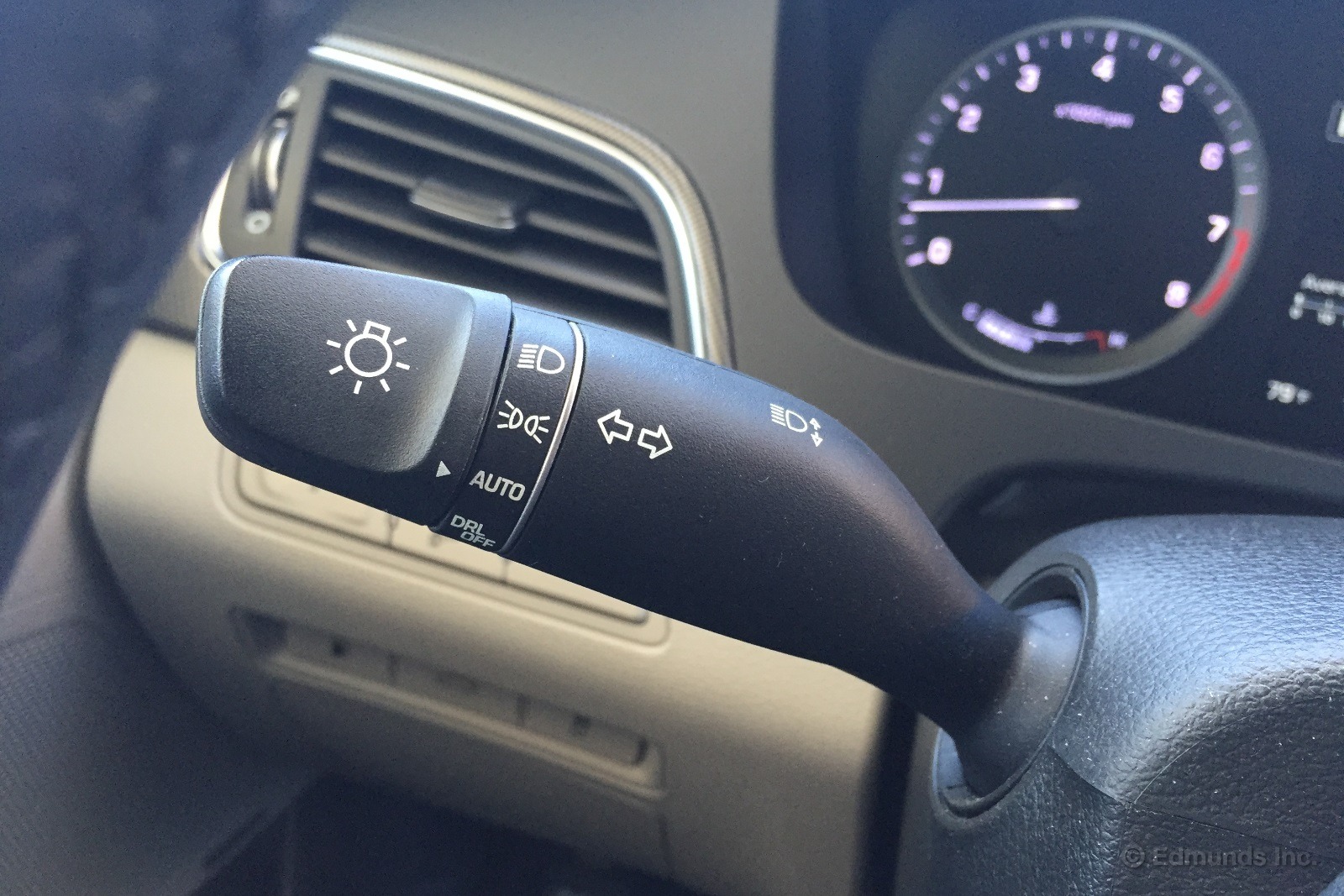
Okay, I found something I don't like. The turn-signal stalk feels decidedly flimsy. If you go in thinking that Hyundais are cheap cars, this stalk will confirm your bias. I expect Hyundai will correct this before long, but in the meantime, it's a bummer.
Oh, and I don't particularly like the 2.4-liter engine, either. It's only got sufficient power when you ride it hard past 4,000 rpm, and it sounds strained until you ease off. As many of us have discovered, it's an underachiever at the pump, too. I got 30.2 mpg in 850 mostly highway miles, well short of the EPA's 35-mpg highway rating.
And yet, my infatuation persists. This is a wonderful car for $27,560 as tested. It's luxury-sedan stable at high speeds, seriously roomy without driving like a boat, and packed with features I want at a price I can get down with. If the next Sonata improves as much as this one, everyone else might be playing for second.
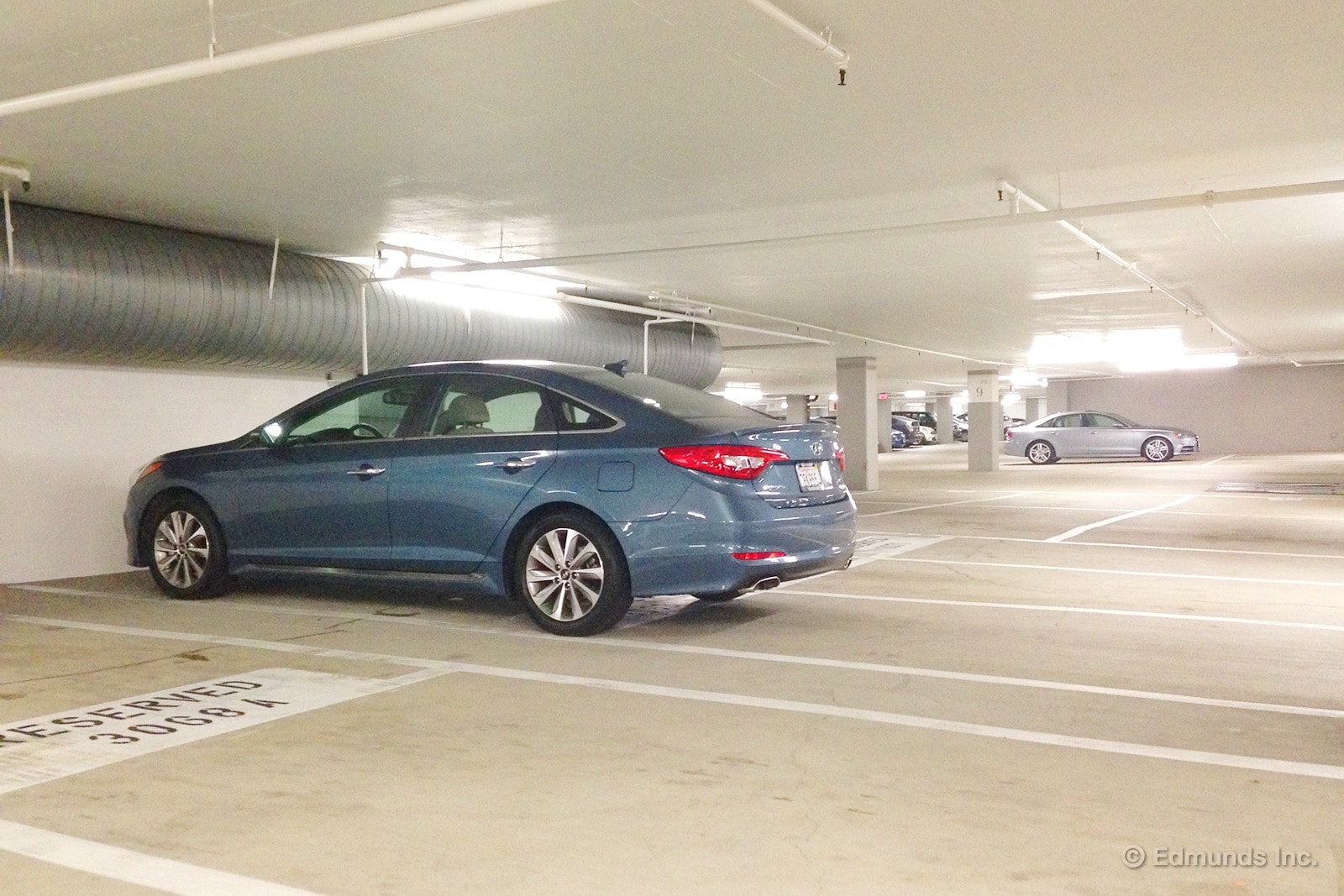
I might be the first person to think, let alone say out loud, that I was ready to trade the keys to a Dodge Viper for a 2015 Hyundai Sonata.
But after I pulled the Edmunds long-term Viper into my driveway after a Labor Day weekend mini road trip, after I'd stretched a leg to clear the baking, expansive door sill and warned my daughter and road-trip companion to do the same for the 16th or 19th time, and after unfolding my frame from the tiny cabin and doing 10 jumping jacks alongside the car, I said to my kid "Wow. That was fun. Now I'm ready for a normal car."
"Me too," she added. "This car is sure crazy."
You'll read all sort of commentary in future posts about this car and its daily livability. It's a simmering debate, at least among a few of us.
Kurt, for example, says it's the only car he'd buy if he had the money and that he would drive it every day, even just down to the Sail-In Liquor to buy a six-pack of Mickey's. Magrath and I, in agreement as rare as the passing of a comet visible to the naked eye, think he's nuts. We contend that when it came time to write the check, he'd opt for something more prosaic like a Z06 or loaded Cayman S.
But he remains steadfast that the Viper is so singular and theatrical that it's the only car he'd buy for that sum. Fair enough.
I was just happy to slide into the Sonata the following evening. Some things you just take for granted: An airy, welcoming cabin. Infinite seating adjustment. A padded armrest. Visibility.
No, the Sonata's direct-injection clatter doesn't warm the blood like the Viper's V10 at idle, or at 2,000 rpm, or anywhere in the powerband, really. But once on the road, the Sonata is smooth. It's quiet. It whips itself into gaps in traffic just fine. It will do most of the driving for you, if you prefer. I don't mean that in an autonomous car way, but rather in a way that melts away the outside world and lets you drive while letting your mind drift. The Viper demands your full attention all the time, every time.
And I concede that this is at the core of the Viper's appeal. It makes no concessions. Sure it has a stereo, but it can't keep up with 10 cylinders and side pipes. It has navigation and leather. It has seats. It's a driver's car in an era when that species verges on extinction. I tried to impress this on my kid as we neared home in the Viper.
"I know this car is loud and bumpy and tight, but I'm telling you, you need to remember this feeling and sound," I told her. "They won't be making cars like this when you're an adult."
Why not, she asked.
When you're an adult, I told her, many or most of the cars will probably be electric. You may not even have to drive them yourself. They most definitely will not use big truck engines. They probably won't be called Vipers, either.
As burly and visceral and endorphin-infused as the Viper is, I think it'd be a hard car to live with, to rely on, every day. For that, I'm glad there's the Sonata.

I don't think I've spent much time in our 2015 Hyundai Sonata. Nothing personal really, but I rarely need a four-door family sedan, so when the signout sheet comes around, I pass it along to someone who needs that kind of thing. Then I take something with more cylinders and fewer doors.
But last weekend I had a quicky road trip that would cover 500-600 miles of grueling, terrifically slow Southern California freeway in just a day or so and I thought this might be a good time to get to know the Hyundai.
Here are some thoughts. Presented as a list. Because it's 2015 and we read things in list form these days.
Before we get started, keep this in mind: Some of these are legitimate issues while others are the personal opinion of a guy with annoyingly specific taste and preferences.
-
Good grief this thing is quiet. Like "accidentally go 50 over the highway speed limit" quiet. There's some seam-slap from the tires over LA's horrible, randomly placed concrete slabs we call freeways, but it's minor. This thing's a tomb.
-
The powertrain doesn't agree with my driving style. At freeway speeds, I like a car to accelerate when I hit the throttle. The Hyundai likes to debate the issue of changing down a gear. Dislike. Sport mode kinda fixes this.
-
Meh seats. These featureless buckets don't breathe or hold you in place. Would a little thigh support kill anyone? My passenger thought the seat heating was weak.
-
I'm not a fan of the steering wheel material. The spec chart suggests that it's leather, as part of the $1,900 Premium package, but I' m not sure which animal it comes from. Something kind of oily.
-
Graphics on the infotainment system are great. So is the functionality. Sadlier already told you this, though. He's unfortunately wrong about the central IP being impressive in any way. But we can't start down the road on what JS is wrong about. We'll be here all year.
-
It's about $2,500 cheaper than I expected it to be. I had a rough idea where Sonata pricing started (+/- $21,000) and that the Sport* starts a little above that. But I guessed that this car, as equipped had a sticker price of $30,000 or just under that. It doesn't. It stickers at $27,560. That's an impressive price for this level of quiet, stuff and comfort. Very compelling. Add in the big warranty and you've got a package that's hard to beat. If a family member or close friend was in the market in this segment, this would be among my top recommendations.
-
*I'm not 100 percent sure that Hyundai knows what this word means. It's not what this is. At all.
-
I'd buy an Accord. Even if it is more expensive, I just prefer the way the Accord drives and feels. I like the steering wheel better, I like the seats better and I like the big new touchscreen display better than I like this one. I prefer Honda's powertrain, too. And for sure I like the way the Accord looks more than I like this one. Once again, Sadlier disagrees with me here. Disagreement is good. People have different opinions on styling and that's why they have different car designs. He thought the last one had a "melting candle" look. My thinking was that at least getting your inspiration from a melting candle is better than this design which can best be praised for its efficiency of sheetmetal stamping. Also, he wears glasses so....
Fuel Economy Update for August - Many Miles Moves the Needle

We stretched the legs of our long-term 2015 Hyundai Sonata in August, adding about 3,000 miles to the odometer. A couple of long road trips comprised almost half of those miles, but we ranged pretty far afield even when staying local. Of the 11 times we filled the Sonata in August, five of those tanks covered 300 or more miles.
We also managed to set a new MPG record. Skilled hypermiler Phil Reed managed to eke out 189 miles on just 5.7 gallons during his trip across the desert to Las Vegas, yielded 33.4 mpg. Granted, that's a somewhat abbreviated tank — less than half of the Sonata's usual capability — but still indicative of what we can achieve with a light foot.
For August, the Sonata averaged 27.0 mpg, just one gallon short of its EPA combined rating. This relatively efficient month helped boost the Sonata's lifetime MPG to 25.9 (from 25.6), which is close enough to 26, and which is tolerably closer to the EPA's 28 mpg combined — but a still not-insignificant shortfall.
Worst Fill MPG: 16.2
Best Fill MPG: 33.4
Average Lifetime MPG: 25.9
EPA MPG Rating: 28 Combined (24 City/35 Highway)
Best Range: 429.8
Current Odometer: 15,580
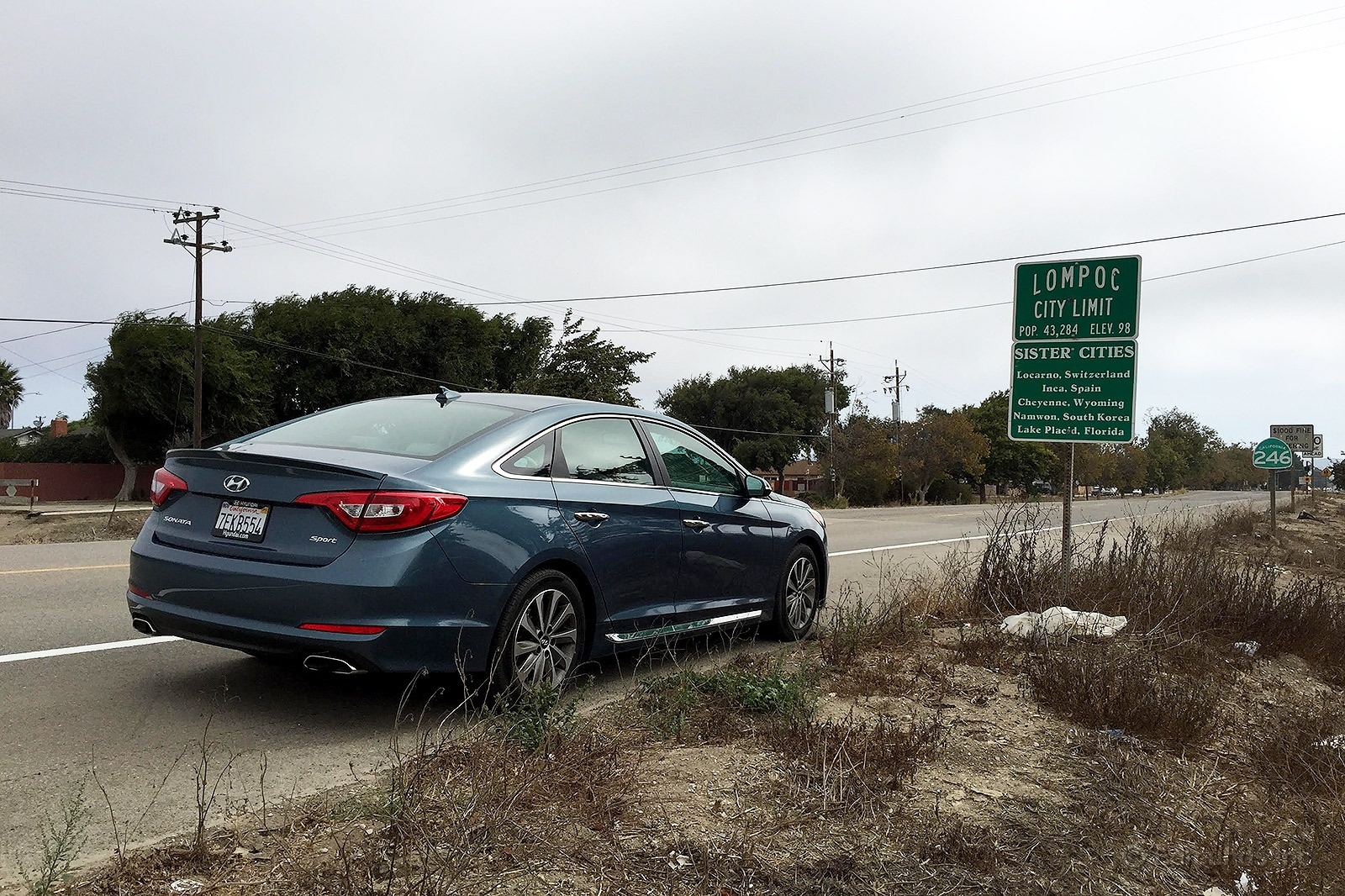
Lompoc, California is a sleepy agricultural enclave about 150 miles north of my home in Los Angeles. It's also more famously home to the state penitentiary where Dominic Toretto served two years for attempted murder.
So there's really no reason to go to Lompoc, but I found one. And I asked our long-term 2015 Hyundai Sonata to get me there.
And the one-day round-trip reminded me how much I like this car.
The Sonata's combination of design, comfort and performance just feels right to me. I like the way this car looks (although I don't love the color). I very much like the style and functionality of its interior and the wonderful balance of power, response and efficiency delivered by its
turbocharged
engine and automatic transmission.
I'm comfortable in the Sonata both literally and figuratively. I like the shape of its seat. I like the feel of its upholstery. I like the placement of its controls and its sporty seating position. Nothing about the Sonata is trying too hard to be cool or edgy or relevant, but it isn't boring or unadventurous either. This ain't no pod.
It hits that same sweet spot mechanically. Our Sonata rides well but doesn't float around and feel like your grandpa's Oldsmoboat. It also manages an impressive level of athleticism. It handles well and feels adhered to the road without riding like a racecar.
The Sonata is fun to drive. And it likes to be driven. But it doesn't make you suffer for the privilege. Not even a little.
And when you're humming along northbound on the superslab, hours into the run and still more than 100 miles from home, that's exactly what you want.
Fuel Economy Update for September - Long-Distance Runner

It was another busy month for our 2015 Hyundai Sonata: nearly 2,500 miles added to the odometer in September. That's a lot for a car that many of our staff (and apparently our readership) finds boring, drab, competent, uninspired, and other degrees of faint praise. For the record, I like this car more every time I drive it, but that's for another post.
Josh's trip to the Bay Area accounted for about a third of our September miles, and although he may have only averaged 30.2 MPG on his trip, his miles helped lift the Sonata's lifetime average a couple of points, from 25.9 to 26.1 mpg.
One of his tanks was even a record-setter: 127.4 miles covered using just 3.6 gallons. That works out to 35.7 mpg, exceeding the Sonata's EPA highway rating.
It's nothing to get excited about, as it's a small sample size of highway miles on Josh's return leg. But it got me curious about how our Sonata is performing on "long tanks," those with, 300 trip miles or more, for example. The result isn't too shabby.
Since the Sonata joined our fleet in December, we've covered 300-plus miles on a single tank 25 times. Three of those times we covered 400 miles or more. Over those 25 tanks, the Sonata is averaging 27.6 mpg — very near the EPA combined rating.
And not all of those tanks were from road trips, either. I'd say most of them aren't. Phil had one 300-plus tank on his recent Colorado road trip. Josh had three of them on his Bay Area run. There are some other long-distance runs mixed in there, but I'd say most of these are true combined driving miles. We'll have to consider stretching our Sonata's legs — and tanks — a little bit more to see an increase in its lifetime average.
Worst Fill MPG: 16.2
Best Fill MPG: 35.7
Average Lifetime MPG: 26.1
EPA MPG Rating: 28 Combined (24 City/35 Highway)
Best Range: 429.8
Current Odometer:
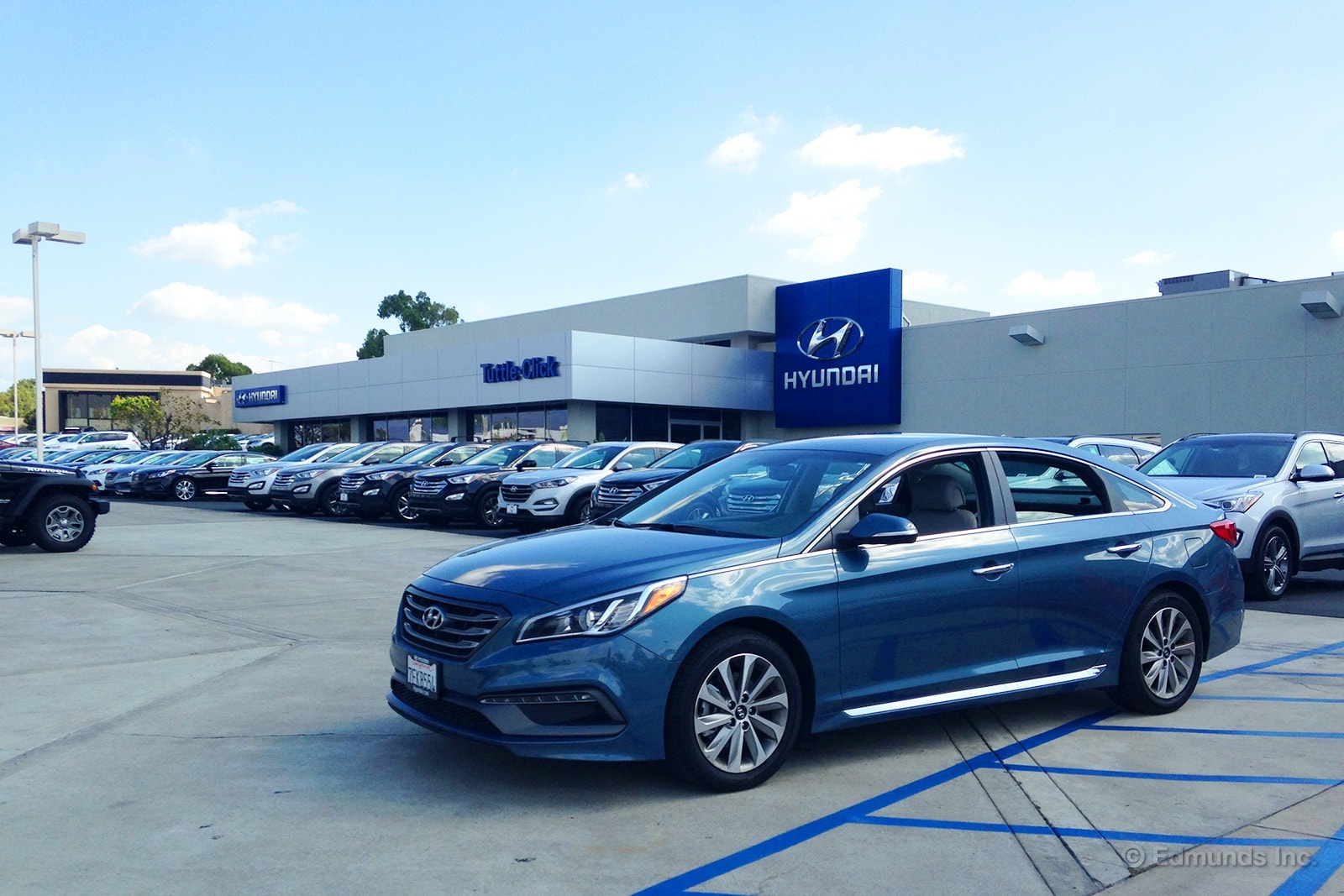
It was time for a 15,000-mile check-up on our 2015 Hyundai Sonata, so we made an appointment at Tuttle-Click Hyundai in Irvine. It was a good thing we had. When we showed up at 10:00 on a Tuesday morning, the service line was jammed. One of the service advisors grumbled something about only having two techs on duty before shuffling away in a hurry.
Thankfully the dealer was prioritizing appointments over drop-ins, much to one agitated customer's grief, who simply couldn't understand why his schedule didn't deserve more consideration than everyone else's. The service advisor that helped him deserved a medal, calling other Hyundai dealerships in the area to see if they could squeeze in Obviously Important Man and help him accomplish the obviously important things he needed to do that day.
Our service advisor, Stephany, gave an ETA of about 2 hours and 15 minutes for an oil-and-filter change, engine air filter change, cabin air filter change, fuel additive service and a tire rotation. It would take a little longer if we wanted the Sonata washed.
I told her to skip the wash and fuel additive service, then waited for the courtesy shuttle to deliver me home about two miles away. I was reminded why it's sometimes fun to take these shuttles if there are other passengers. You can get some candid opinions from people about their cars while passing a few miles. The only other passenger was a nice lady who had dropped her 2015 Genesis 5.0 for service. She loved it even more than the Infiniti FX35 she previously owned, she said.
The Genesis had excellent "get-up-and-go" and loads of features like adaptive cruise control that could bring the car to a complete stop, then resume travel, unlike her Infiniti, which she said would not engage cruise control at less than 40 mph. The only adjustment she needed to make was to adapt to the Genesis throttle calibration, which she explained was mushier, with less feel, than the FX.
Stephany called a bit ahead of schedule to tell us the Sonata was ready for pick up. The oil and filter change required five quarts of 5W-20. Stephany included a $15 discount, bringing the total to $29.96 for the oil change. The cabin air filter set us back $78 ($25 filter, $53 labor), which was an eye-opener. Nice labor margin on that one. The engine air filter added about $19 for a grand service total of $131.19
Tuttle-Click also addressed two open recalls on our Sonata, one for an airbag control software update, the other to replace the passenger seatbelt buckle cover. This was our second experience with Tuttle-Click Hyundai, and aside from the rich service fee for the cabin air filter installation, we were again impressed with their service level. We'll visit again when the need arises.
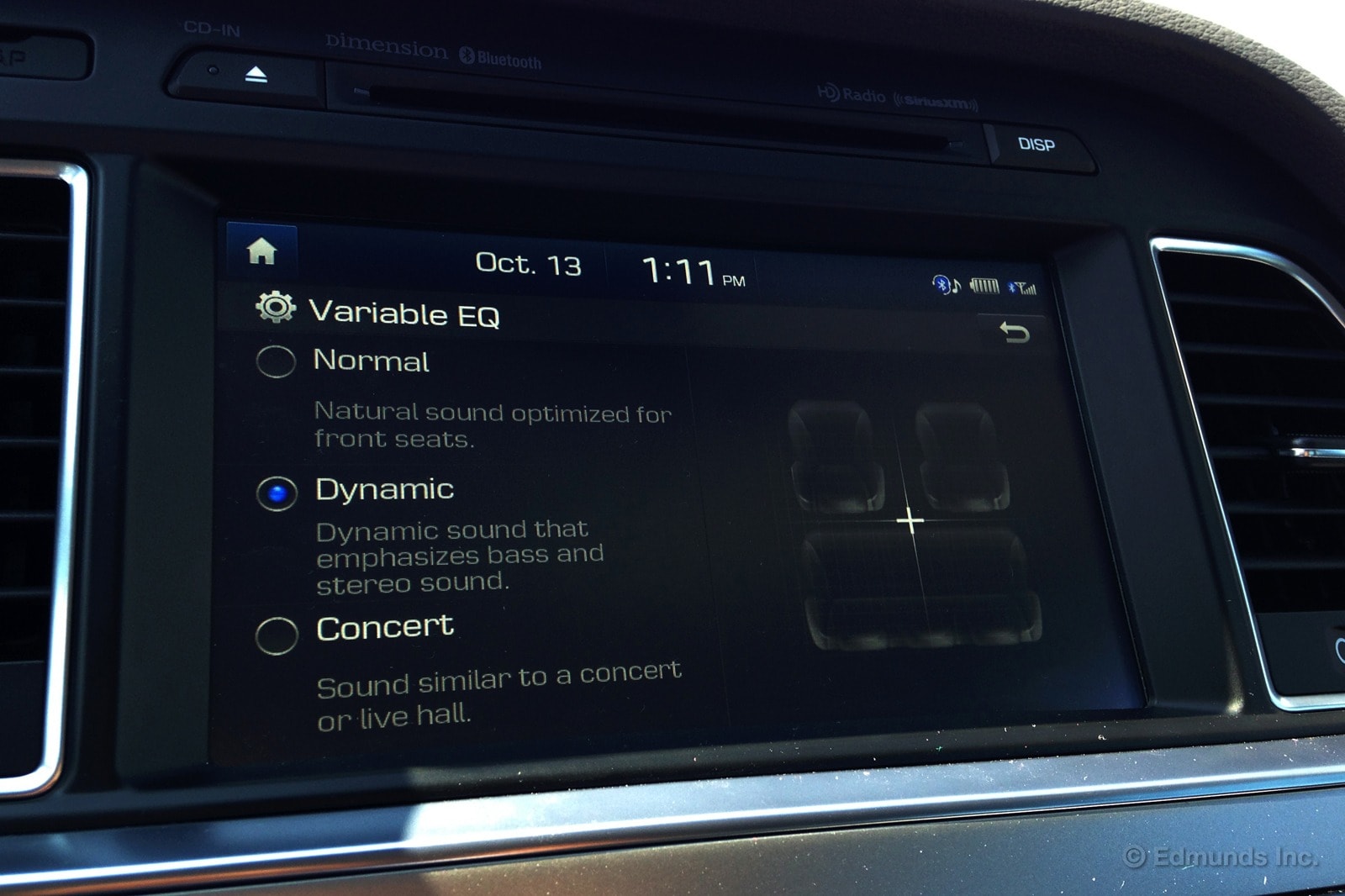
When rap producer Dr. Dre signed his name to a line of now-ubiquitous headphones, he had a music industry legend, Jimmy Iovine, to provide the marketing muscle, and consumer electronics manufacturer Monster to build the product. A cool logo, cool, crisp colors, and celebrity and athlete endorsements helped sell thousands of the headphones at around $200 a pair. They were the perfect complement to the iPod Era, flashy sneakers for your big head, and they invigorated a dormant headphone market.
But they didn't sound that good. Early versions were what you might expect from a hip-hop marketing angle: big, boomy and bassy, muddy, with not very accurate frequency reproduction. Even by most objective, not-fussy audio standards, they were more fashion than frequency. Iovine has said that critics missed the point, that the headphones were meant to excite, and not be neutral, audiophile-grade listening experiences. Sorry Jimmy, but they sucked.
To be fair, Beats by Dre headphones have improved. Seems like the company, now owned by Apple, has heard the criticisms and started to address them. But they won't shake the early bass-heavy reputation so easily.
Turns out the whole "Beats Effect" has even touched our 2015 Hyundai Sonata.
First off, the Dimension audio system in our Sonata is nice, nicer than you might expect at the Sonata's price. It's doesn't pack a ton of power, and the 400-watt Infinity system upgrade isn't available on the Sport trim, so for what we've got, it does the job.
But dig into the Sound settings menu, and you'll find this Variable EQ menu. In a separate menu, you can adjust bass, midrange and treble settings, but if you want a quick default bias setting, you can choose from Normal, Dynamic and Concert.
Normal is just that. It's basically a midrange-forward tone that favors balance, and there's no appreciable change in the sound stage or imaging. Just a basic go-to setting. Concert brings the mids even further forward, shaves the highs, and seems to add a bit of reverb to trick you into thinking you're in a theater or hall. It's not super convincing, unless you were in a concert hall with only a few working bass cabinets in the PA system.
And then you have Dynamic, or the "Beats Effect" setting. As it says, it boosts the bass tone, pulls back the mids and highs, and shifts the soundstage from the dash to the doors. And it's effective. It's nice for the right kind of music like hip-hop or electronic-heavy material.
No, it's not very accurate. This system and setting won't win awards for frequency response or EQ curve, and you'll hear the same music pretty differently on even a decent home stereo or theater system. But you will get some of that punch and rumble, which again can be fun with the right tracks. I enjoyed feeding some newer hip-hop and old classics through this setting.
But the underpowered system can only hang so long. A track like Outkast's "Spaghetti Junction," which features deep, elongated pulses of trademark hip-hop bass drum beats, leaves the speaker cones croaking and trying to leap from their foam surrounds with each pulse.
Still, it's a fun feature to offer, even if it's only an occasional one-trick pony, and not one you'd expect to find in a family sedan.
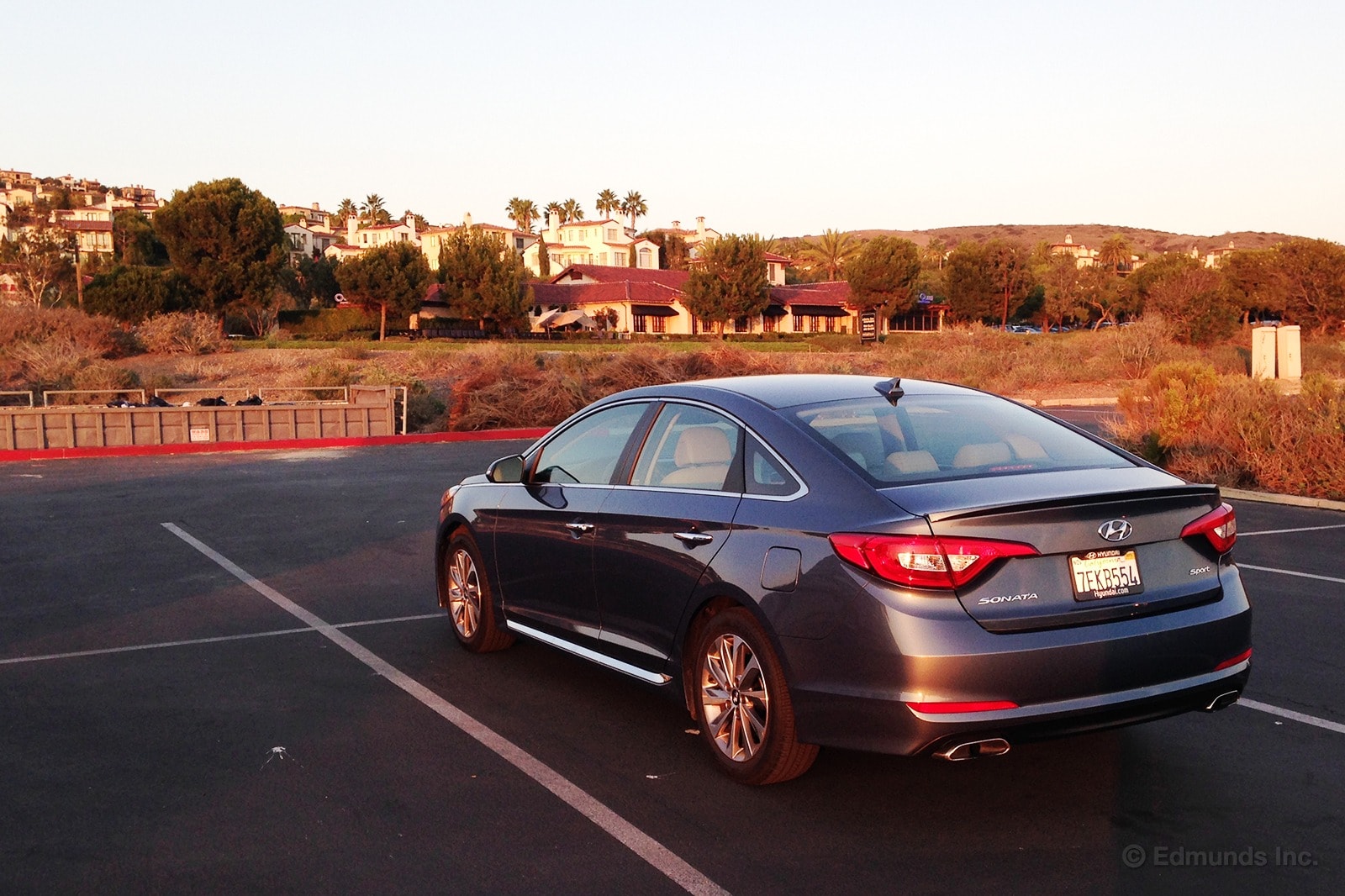
I like our 2015 Hyundai Sonata. No, it's not the most inspired car, nor the classiest. Not a lot of brand cachet behind that badge and you're definitely not impressing the valet in the Sonata. But as a Monday through Friday car, I could live with the Sonata very nicely. It'll get me to work in comfort and quiet, it lays out all of my techy needs — music, podcasts, phone, navigation — in logical an comprehensive order within the center stack. It's got loads of room the backseat for when I need to ferry the kid, kid-friends, or adult friends.
I can even opt for the turbo "Eco" version if I want a little more sauce. Less horsepower, more sauce, you say? It's true. The Eco model we tested, with its wee 1.6-liter four-cylinder was quicker to 60 mph (7.5 seconds) than our long-termer with its larger engine and additional horsepower (8.2 seconds).
Even the Sonata's audio system is nice.
But there are two things that really hold back the Sonata from asserting itself in this class, both among wonky critics like us and perhaps among shoppers for whom midsize family sedans begin and end at Accord and Camry.
The Sonata's engine sound and ride quality are, I think, its two character flaws. Simply put — and these are very general, but, I think, tangible observations — the Sonata's four-cylinder just doesn't sound very good, especially when pushed hard or spurred to immediate action. Many of us have noted this.
On start-up, the four-cylinder clatters along to its direct-injection soundtrack. This in itself isn't a huge deal and is a sign of the times, as most engines start going the fuel-savings, emissions-reducing direct injection route. But the Hyundai's engine never develops into anything resembling a purr or even just a pleasant low-order hum that you might find in the Accord, for example.
Instead, it's just a scratchy buzz that only gets more prominent as you request more from the engine. It wouldn't cause me to write the Sonata off my list or recommend it to someone, but it's one of those details that I think keeps the Sonata out of that "elite" class, if you can call it that.
This also seems like a pretty fixable problem. Hyundai's engineers just need to figure out how to make the thing sound better, especially when stressed — and not just with intake honkus, exhaust or piped-in sound trickery. There needs to be a very real different timbre from the engine when it's creating and containing all those tiny explosions. Maybe they should consult with Dr. Dre.
Secondly, the Sonata's ride quality isn't quite up to par. That's not to say it's not comfortable. The Sonata is plenty comfortable for both short and long-hauls. But the suspension and chassis feel chatty and ragged in a way that the benchmarks in this class don't. You can count on a cushy, sophisticated, borderline luxury ride in an Accord. The Sonata isn't far behind, but still lacks that level of ride quality engineering, that dampening that results from number-crunching and materials testing, to vault it to that elite company.
Perhaps the Sonata's price point prohibits Hyundai from investing the additional time and R&D. Maybe it's just a knowledge gap that Hyundai is working actively to close. The Sonata's value proposition is undeniable. It's not cheap, but you can buy one for less than the benchmarks and you sacrifice very little. But Hyundai won't be able to cruise on the value proposition for long. Eventually they'll have to mind some important, subtle and elusive details to make the Sonata a benchmark itself.
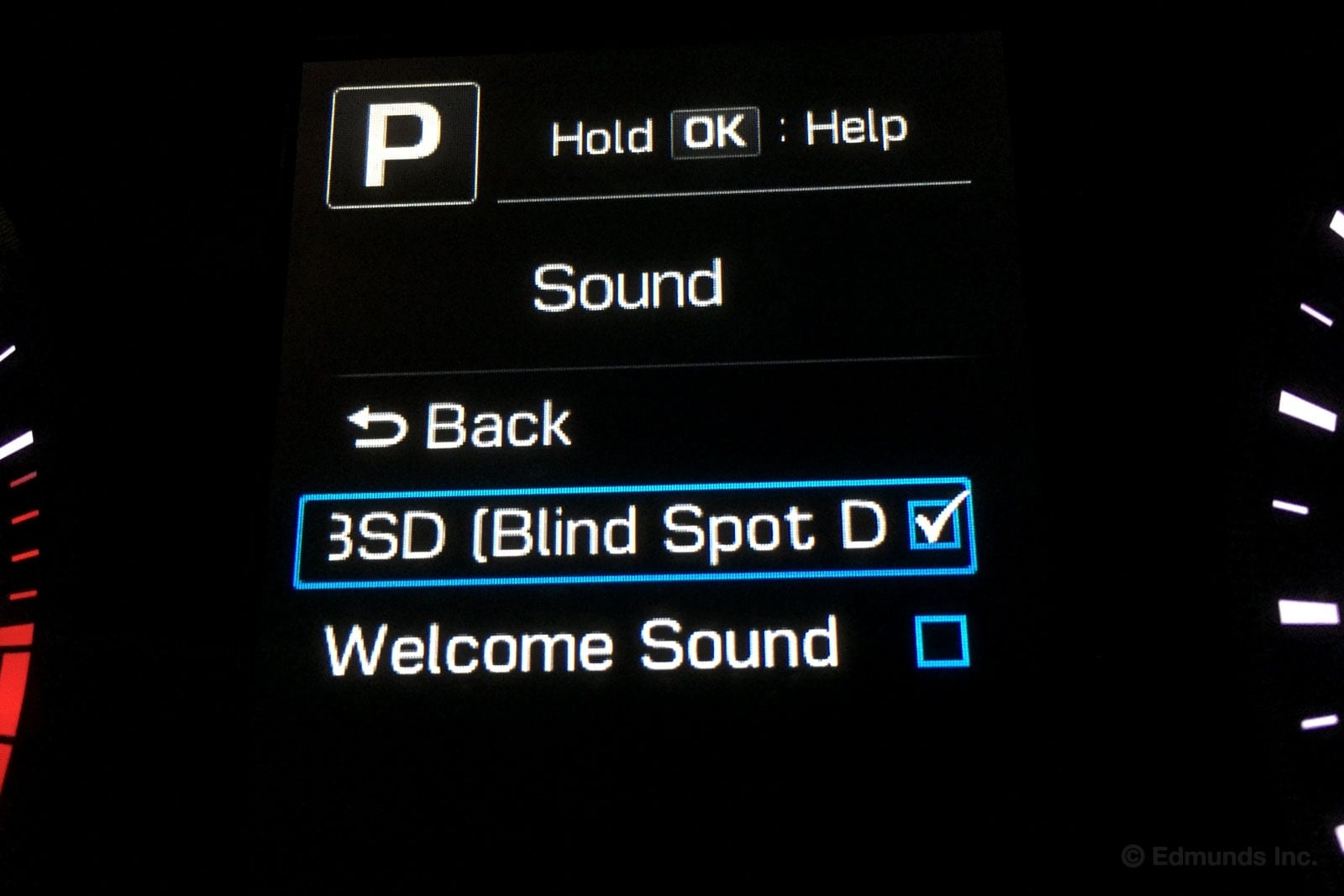
Normally, blind-spot monitoring systems provide a subtle and welcome alert. I'll always recommend proper side-mirror placement first, but I'm happy to have the additional safety layer. Except when driving our 2015 Hyundai Sonata. Its system is not subtle. And its effects will make you use the turn signals less, further worsening the world as a place to drive in.
When you flip the turn signal while alongside another car, a small light flashes around the side-view mirror. This is how it's supposed to work. This is helpful. Our Sonata goes one step further and plays an audio alert when it catches something. This is also tolerable.
But the audio alert doesn't stop.
If you use your turn signals like you're supposed to, you activate them to show where you intend to be well before you plan on going there. You leave it on until you're there, even if there's a car you have to move around or wait for. If you do this in the Sonata, the loud alarm goes on and on. The only way to make it stop is to turn off the turn signal.
See the problem? You're being punished for good driving. If the car keeps beeping an alert at you, you're less likely to activate the thing causing the alert.
Actually, there's another way to turn the alarm off. It's in a digital menu in the gauge cluster. The problem is you can't change it when you're moving (thanks, Legal Department). So during a 90-minute slog through rush hour traffic last week, I dutifully suffered through the alarm.
For about five minutes.
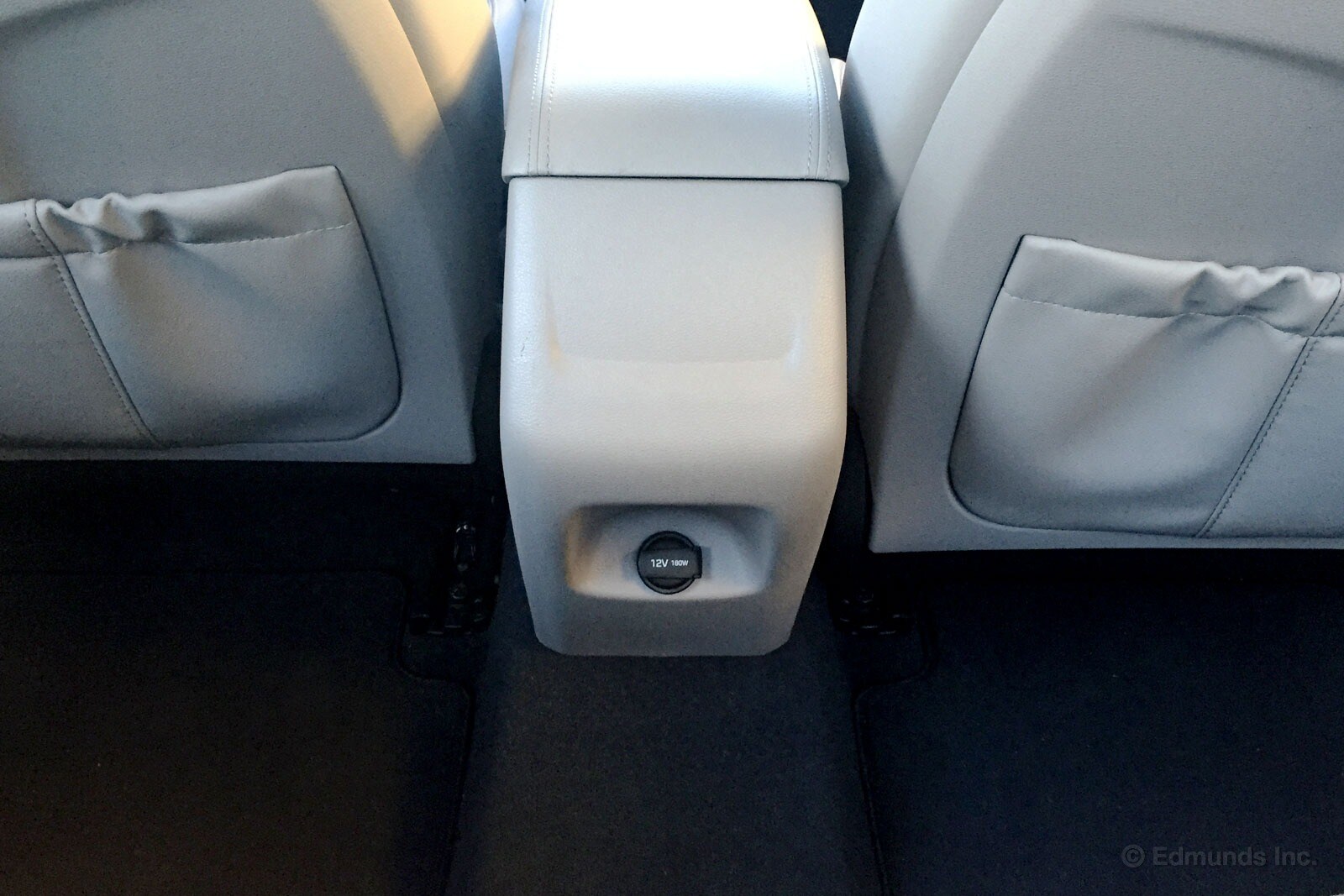
"It's hot back here."
This is already a potentially volatile situation. My mom and my girlfriend are in the back of our 2015 Hyundai Sonata, and we're stuck in stop-and-go traffic. The climate control system says 70 degrees and auto. My butt confirms this. Our Sonata does a great job keeping cool, so I don't believe the complaint.
I ask them to check the rear vents. Maybe the louvers have been shut. They can't find any.
"That's ridiculous," I say. I reach behind the center arm rest and feel for the vents.
There aren't any.
Not only are mom and girlfriend uncomfortable, I'm wrong, too. Uh oh.
I push the front vents up towards the roof and crank the air conditioning down to "Lo". I hope it helps, but I can't hear any complaints from the back over the sound of the fans. Once we get to our destination, I hop in the back seat.
Not only are there no vents in the center arm rest, there's nothing under the seats or in the pillars between the front and rear doors.
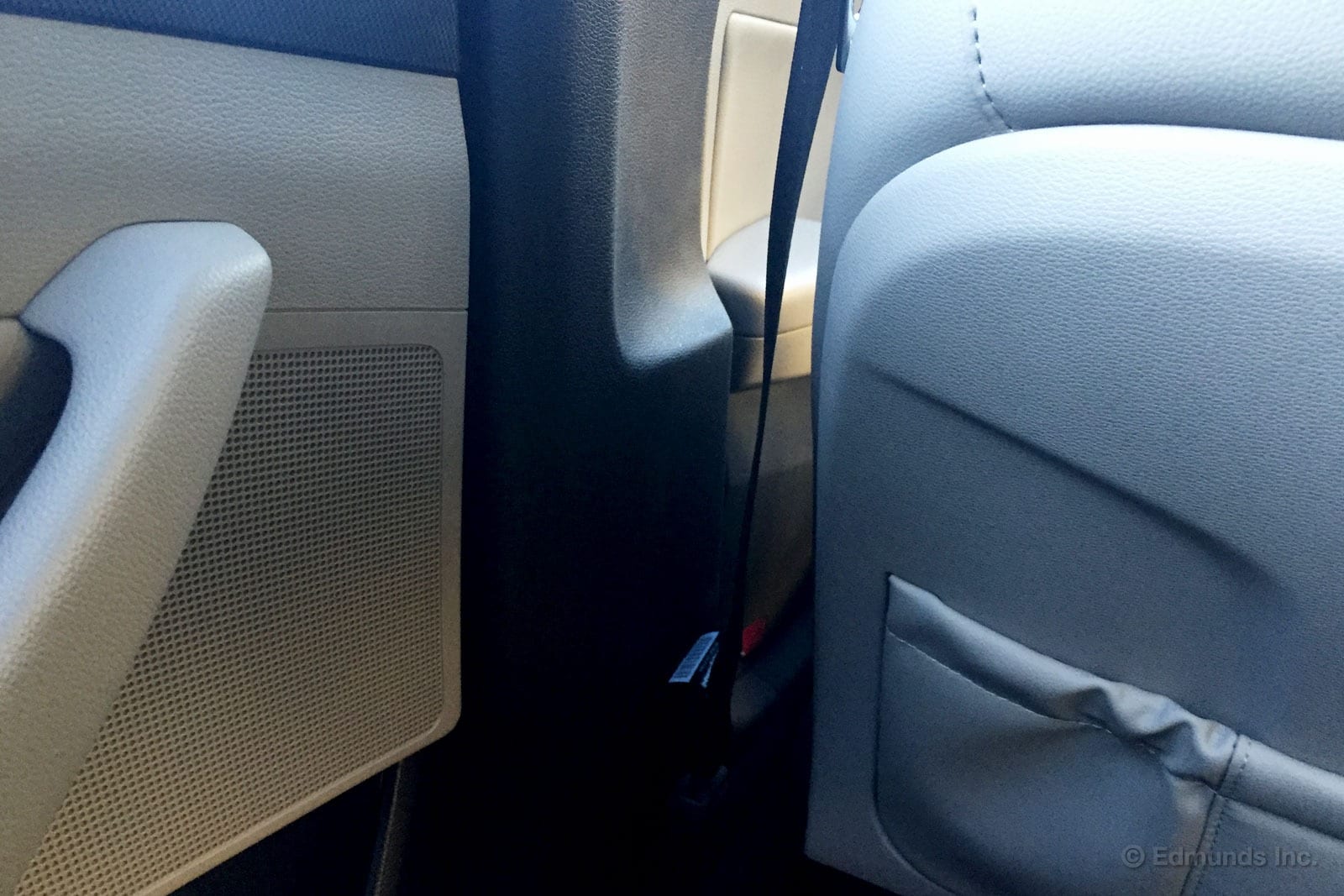
Curious, I started researching midsize sedans. These vehicles, after all, are built with the idea that you're probably going to put people-like things in the back seat. It's why the back seat is there. It's why our Sonata's back seat feels so large.
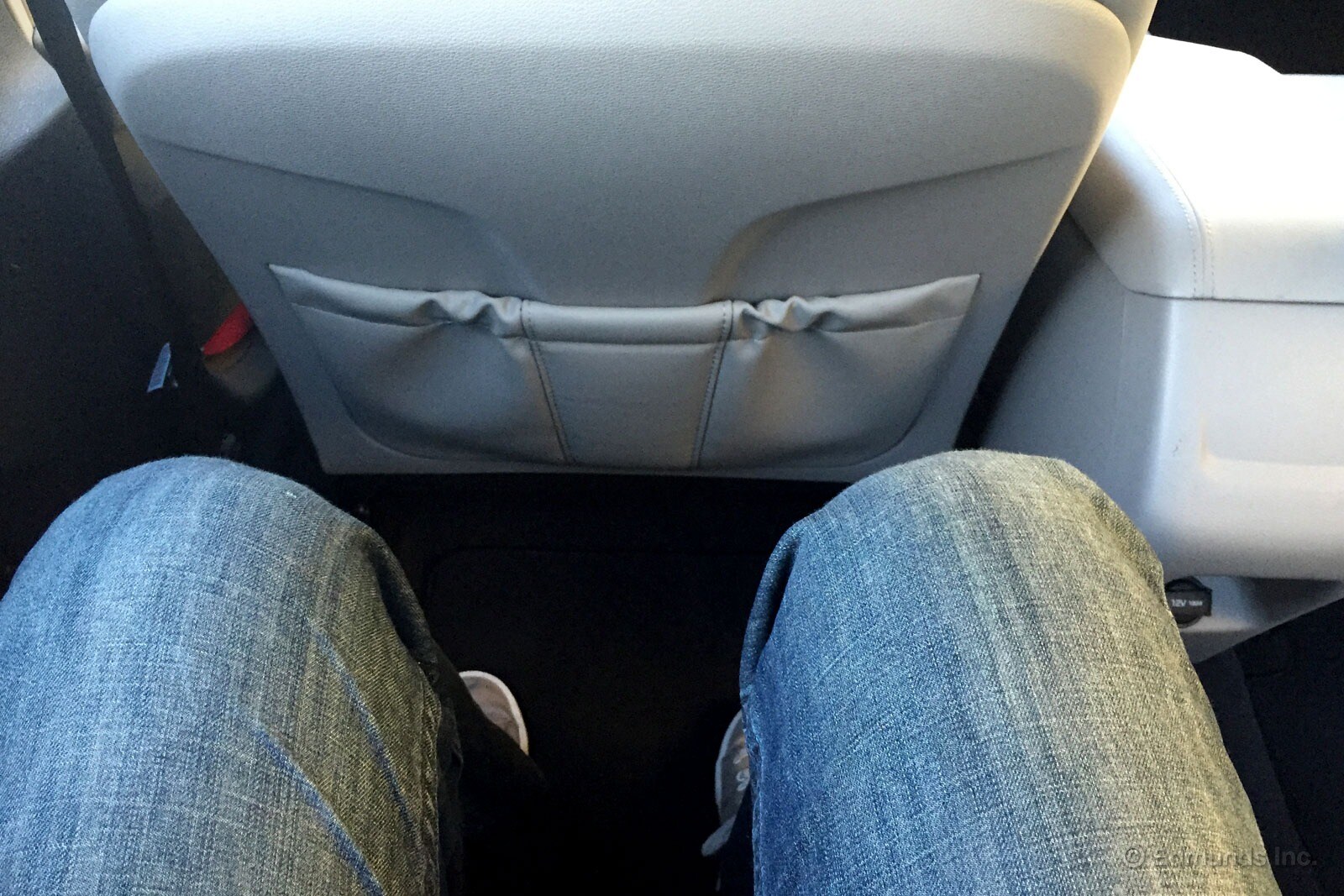
I was surprised to find that, as fiercely competitive as this segment may be, no entry-level midsize sedan has standard rear vents.
Because finding this information was such a pain, here's a list of how much you need to spend to get rear vents in a midsize sedan, from least expensive to most. These prices include destination, but not current incentives. I've also opted for the automatic transmission for the Mazda6 and Honda Accord to keep the comparison fair with the rest of the group.
| Ford Fusion SE | $24,555 |
| Kia Optima EX | $25,460 |
| Chevrolet Malibu 1LT | $25,895 |
| Mazda6 Touring | $25,815* |
| Hyundai Sonata Sport (Premium Package) | $26,435 |
| Nissan Altima 2.5 SV (Convenience Package) | $26,895 |
| Honda Accord EX | $27,100* |
| Volkswagen Passat 1.8T SE | $27,100 |
| Toyota Camry XLE | $27,145 |
| Chrysler 200C | $27,620 |
| *With automatic | |
This list leads me towards a well-optioned compact car.
Transporting your mom and your girlfriend simultaneously? It's best avoided.
Smart Trunk Surprise — Here's How It Works (with Video)
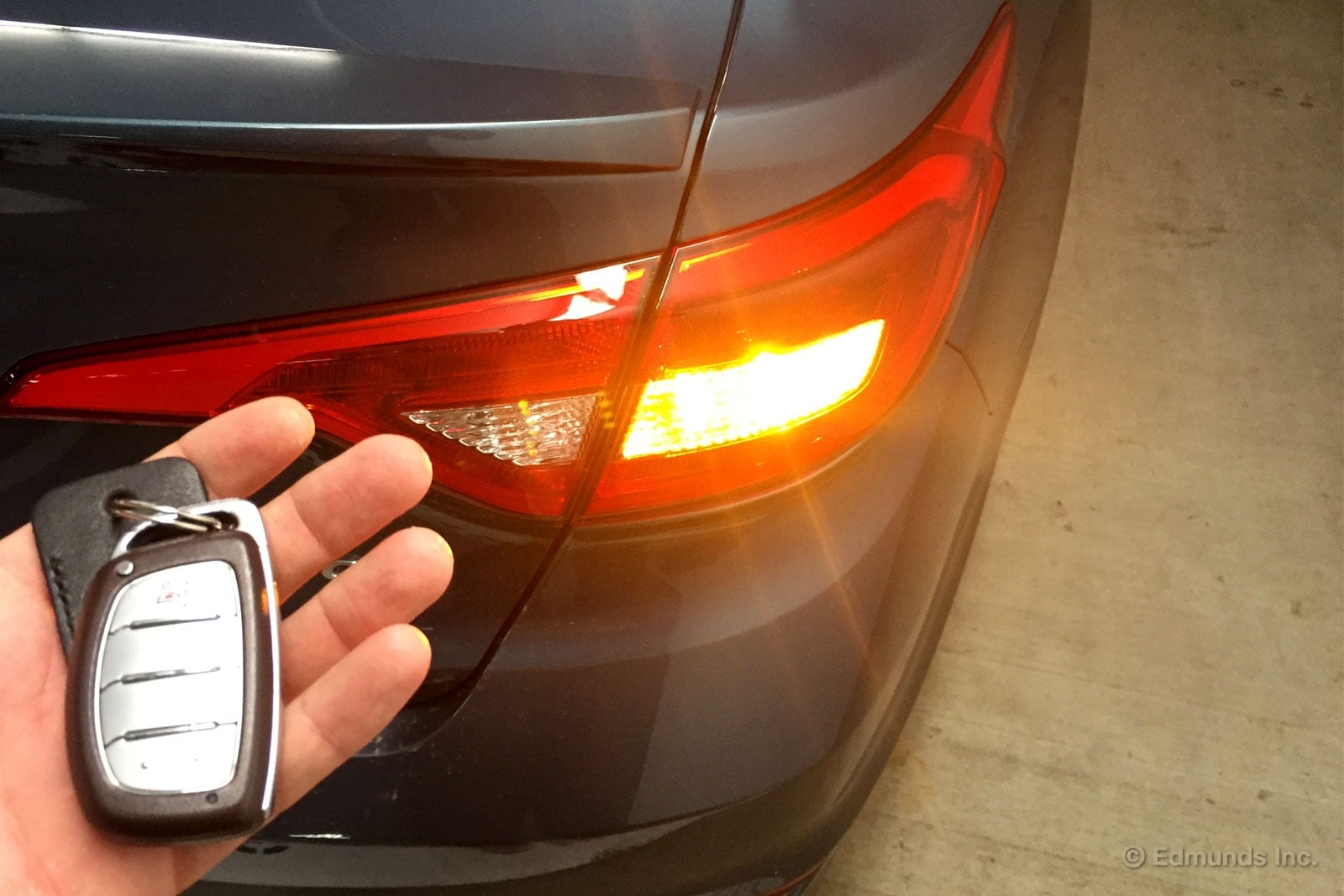
I thought it was weird how our 2015 Hyundai Sonata beeped whenever I walked up behind it. Was it a greeting? If so, then why didn't it unlock the doors?
Had I done my homework, I would have realized it was the Sonata's hands-free trunk opening feature, which Mike Monticello has already reported on. I realized this after five amusing minutes in the garage spent approaching the car from various angles trying to replicate the beeping.
Where the previous post told you how the trunk worked, I'll do one better and show you the process with a video:
As you can see from the video, the trunk merely unlatches. It doesn't fully open to receive an armload of groceries. But while I couldn't make it open further, like how Monticello experienced, I'd still rather have this feature than not.
Fuel Economy Update for October: A Little More Led in Our Step
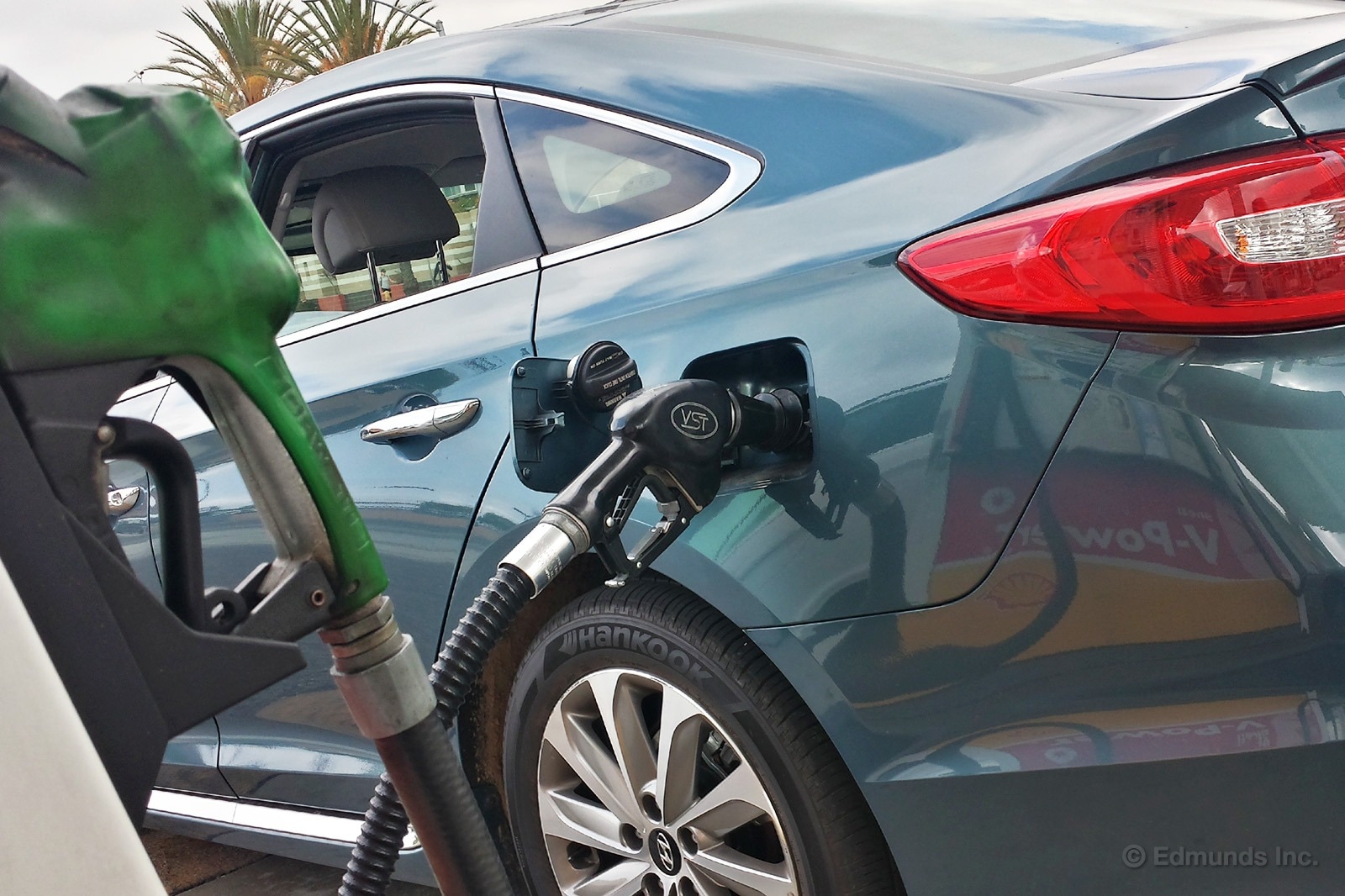
October proved to be another uneventful month with our 2015 Hyundai Sonata. While most of us have always found the Sonata a capable companion, Dan Frio and Carlos Lago got busy picking some nits. Far from heavy criticism, but still relevant, are things like slightly lackluster audio system, clattery engine sounds and a still not-as-refined as-we'd-like suspension.
Meanwhile, Carlos found out the hard way that our Sonata lacks the rear passenger air vents we've come to expect from many midsize sedans.
Once you're done clicking those links, click the one below to see what kind of mileage we wrung out of this thing.
I don't know if it was the late summer heat, but our shoes were a little more lead-y than usual in October. For the month, we averaged 23.26 mpg and — this should go without saying — we didn't set any new distance or mileage records for the month. We're still 2 mpg shy of the EPA rating, but we've got a little more time with our Sonata to see if it can do better.
Worst Fill MPG: 12
Best Fill MPG: 35.7
Average Lifetime MPG: 26.0
EPA MPG Rating: 28 Combined (24 City / 35 Highway)
Best Range: 429.8 miles
Current Odometer: 18,115 miles
Balance of Power — A Case For and Against the Four-Cylinder Turbo
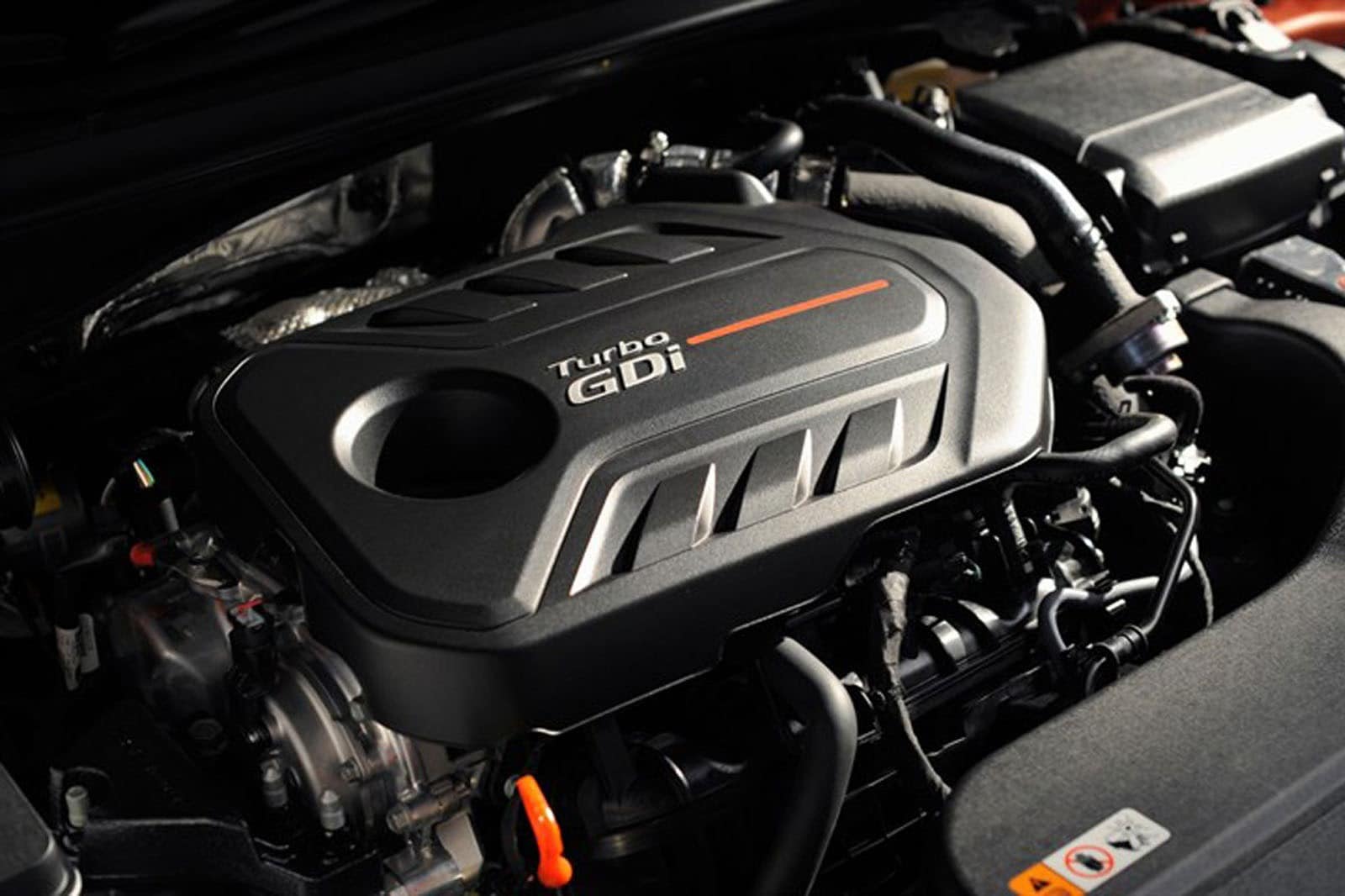
I recently spent a day driving Kia's Optima, the counterpart to the Sonata. Though the two cars look different, they're mechanical twins, depending on equipment, of course.
Our long-term 2015 Hyundai Sonata is fitted with the volume-selling 2.4-liter normally-aspirated four-cylinder. However, the Optima I drove happened to be the SX Turbo trim, which comes with the 2.0-liter four-cylinder turbo. The 2.0-liter turbo is the top engine available in the Sonata and Optima, but it no longer competes with the optional V6s available in the Camry and Accord.
This, frankly, makes no sense.
First, some history. Back when the last generation Sonata/Optima were new, the Korean brands were making a real effort to keep pace with the optional Japanese V6s from Honda and Toyota in terms of power. In 2011, the Japanese V6s produced 271 horsepower and 268 hp, respectively.
Remember that Kia and Hyundai switched away from their own 3.3-liter V6 that year by embracing the four-cylinder turbo instead. The turbo-four was rated at 274 hp and 269 pound-feet of torque. The Koreans probably needed to fight the perception that switching to a four-cylinder as the optional engine might not provide the performance available from the top-of-the-line Japanese competitors. Hence the V6-topping power rating.
Fast forward to the 2015 model year and the current generation of the Sonata and Kia Optima (2016 model year). The top engine in both is still a 2.0-liter four-cylinder turbo. The Japanese V6s still make impressive power (the Accord makes 278 hp, the Camry makes 268 hp). Now, however, the Korean 2.0-liter four cylinder turbo engine produces a far more modest 245 hp. Why?
The obvious answer — better fuel economy — doesn't seem to hold water. Both the 2011 and 2015 turbo-four-powered Sonatas are rated by the EPA at 26 mpg combined. Somehow the Optima managed to lose 1 mpg combined with this engine (from 26 to 25 mpg combined) despite an almost 30-hp reduction in peak power for 2016. That, friends, is a lose-lose.
It's possible that Hyundai/Kia realized that the premium engine in a midsize sedan doesn't exist to make the car faster than its competitors. Possibly the strategy switched from being the most powerful sedan in the class to simply being more powerful than the base engine cars which some buyers perceive as underpowered. Because let's face it, nobody buys a midsize sedan to beat their neighbor's Camry in a drag race.
It could also be the case that after a $100 million civil suit thanks to inflated fuel economy numbers, the Korean automakers have just become more conservative in all their claims, including power.
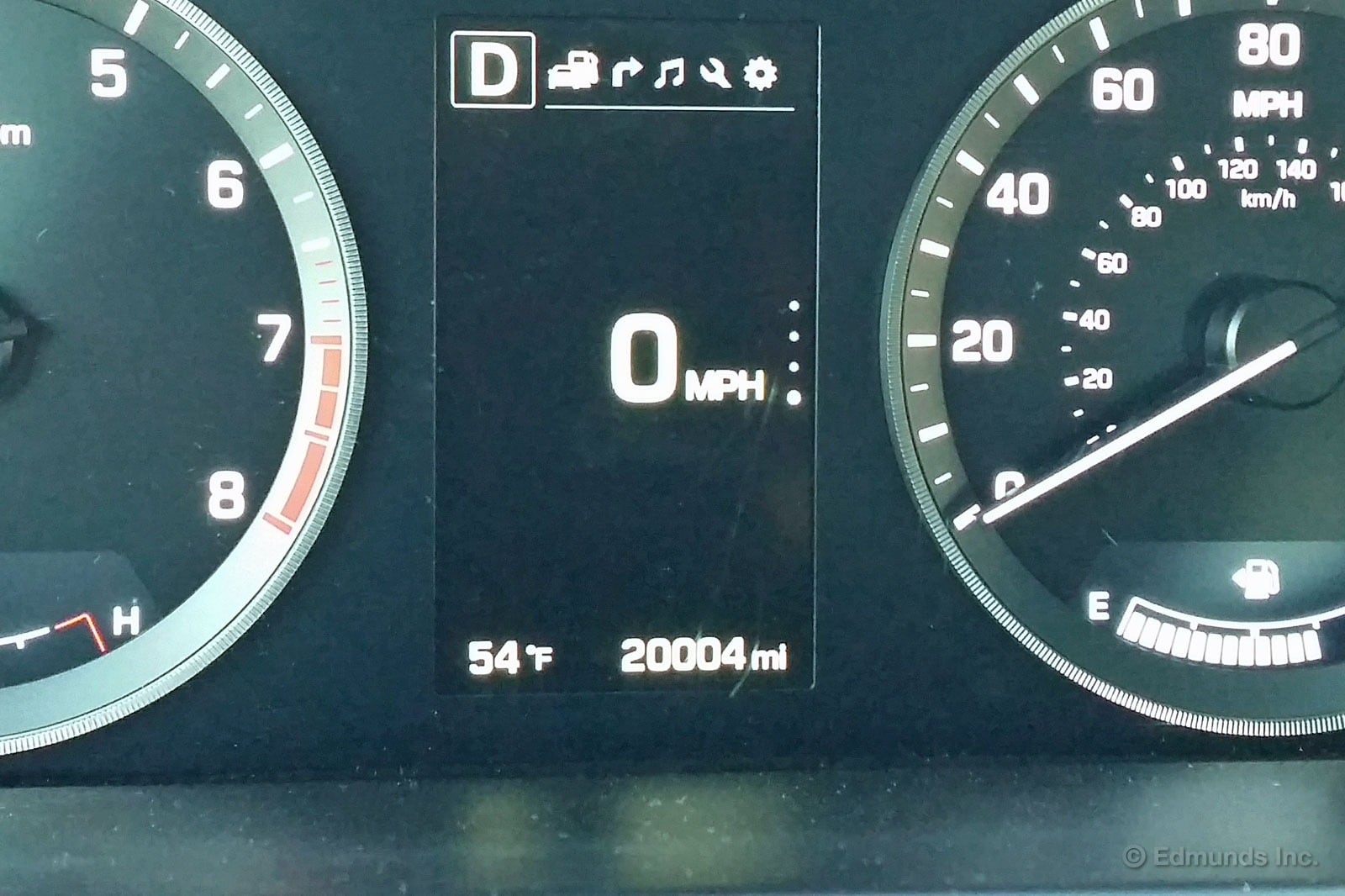
It's almost been a year since our 2015 Hyundai Sonata entered its long-term test, so it wasn't much of a surprise when I looked down at the odometer this weekend and noticed that it had just clicked past 20,000 miles. Time flies in the face of unpretentious competence.
Almost nothing of note has happened in the past year. No minor service issues, no serious problems, not even a flat tire. Other than a slight pull to the right that was remedied with a quick trip to alignment shop, our Sonata has been flawless.
I remember driving the Sonata during its first few weeks in the fleet and thinking that it felt surprisingly sharp. The suspension was dialed in nicely, the engine responded quickly and the steering was precise. It was a new car, so everything should have been in order, but past Hyundais didn't always feel this precise.
Even after 20,000 miles, it still feels just as well-sorted. No squeaks or rattles, and the suspension still feels dialed in. Usually by the time the odometer has passed 20,000 miles, cars get a little soft around the edges, yet this one still has that same sharpness. I've liked this car from day one and nothing this past year has soured my feelings on it.
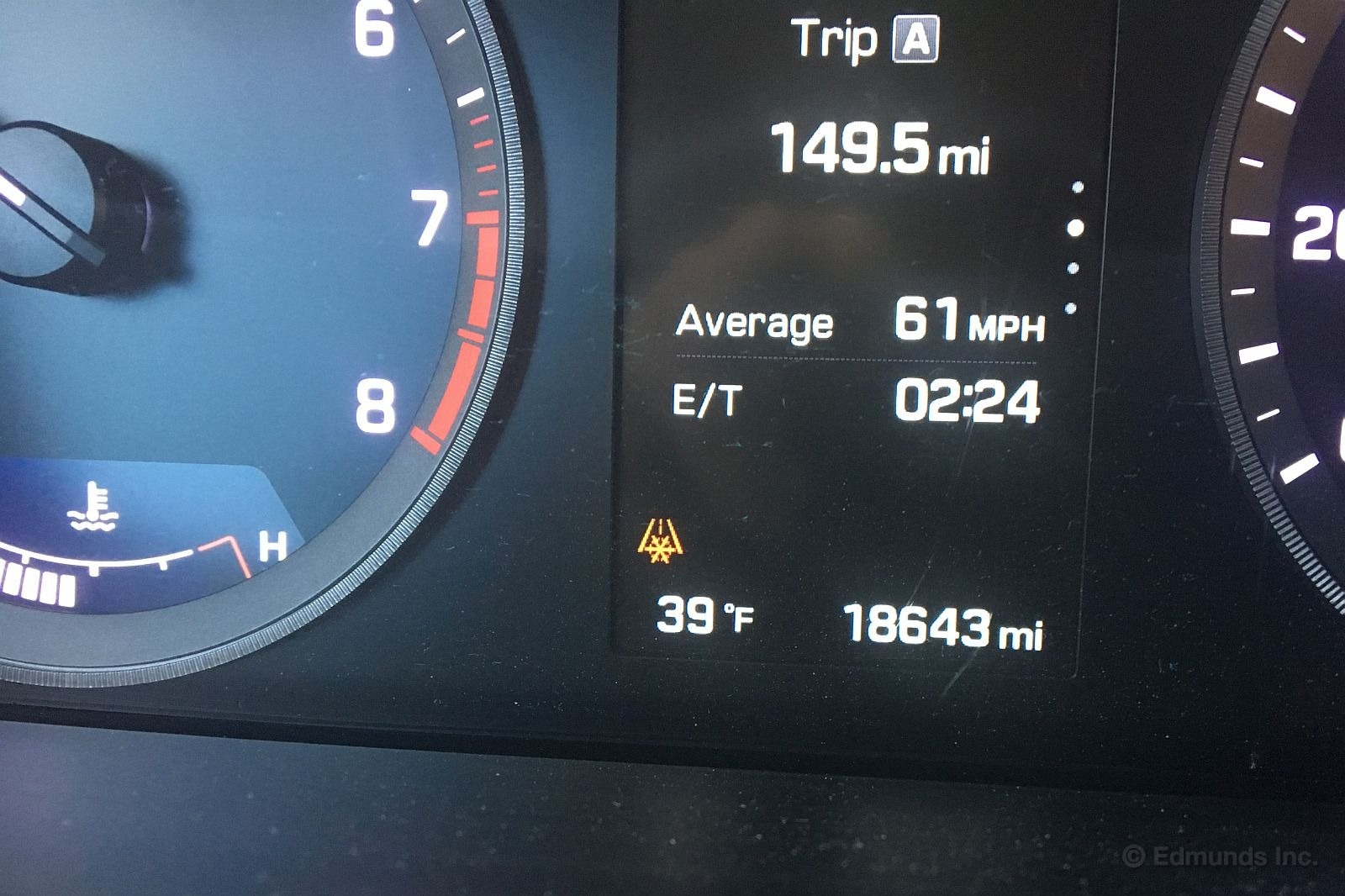
It was a nice, crisp, early November morning as I headed east on Interstate 8 toward Arizona in our 2015 Hyundai Sonata. The sun was just barely peeking over the horizon and outshining the more distant stars as I left San Diego behind and worked my way over the many 4,000-foot summits of the Laguna mountains.
A small yellow snowflake icon winked on near the outside temperature gauge, which to my surprise read 39 degrees. Funny, it hadn't been near that cold when I backed out of my driveway in the dark some two hours earlier. And that's exactly the point of the light.
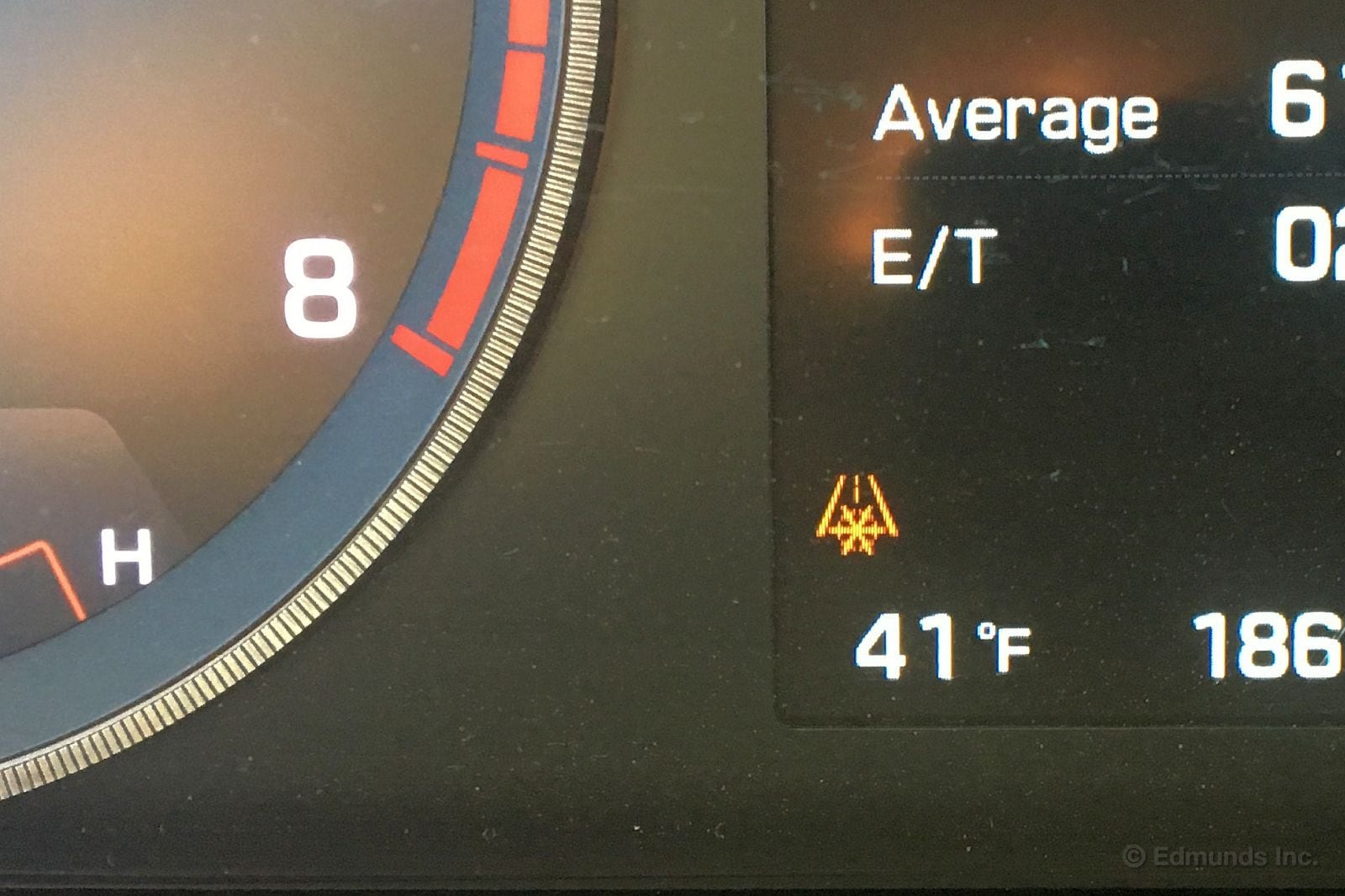
It's there to remind clods like me that the temperature has dropped to a point where tire rubber begins to stiffen, making reduced cornering grip and stopping power possible.
All-season tires possess a wide range of operating temperature that extends down into true winter conditions, but the old saying "jack of all trades, master of none" applies. If I expected the snowflake icon to stay on for months, this would be the crossover point at which a dedicated winter tire would do better.
Those that have fitted aftermarket three-season "summer" tires for extra performance should view the snowflake icon far more seriously. For them this is a dire warning to be extremely careful. The warm-weather rubber compounds used in those tires turn hard as rocks at such temperatures. They will not see you safely through a real winter, perhaps not even around the next corner.
As for me, it's a gentle reminder to take stock of my situation. I've got all-season tires, I'm just passing through, I just crossed the last summit and the sun is coming up. The tires I've got are fine for this, and I'm not driving into persistent colder-trending conditions that will truly affect the core temperature of my tires.
Indeed, the temperature gauge clicked back to 40 degrees a couple of minutes later. But the light didn't go out right away. The system waited until 42 degrees to avoid the possibility of an irritating on/off winking that might result if I'd been travelling through an area of persistent 39.5-degree weather. I can't argue with that.
The Long Road to Phoenix
Duty called me to a business trip in Arizona, where I would hear all about the new Nissan Titan XD. My destination in Phoenix wasn't all that far away, so the decision between driving and flying was easy. Our 2015 Hyundai Sonata sedan got the call because I hadn't road-tripped it yet.
Nominally, the drive to Phoenix is a simple six-hour interstate cruise. But my event started in the morning and I'd lose an hour changing time zones. I had to leave the day before and grab a hotel, and since it was a day off I decided to stray off course and take my time. I'd never been to the Organ Pipe Cactus National Monument before, and I had my eye on a couple of other random spots.
All told, my elongated figure-eight round-trip route would amount to well over 1,300 miles.
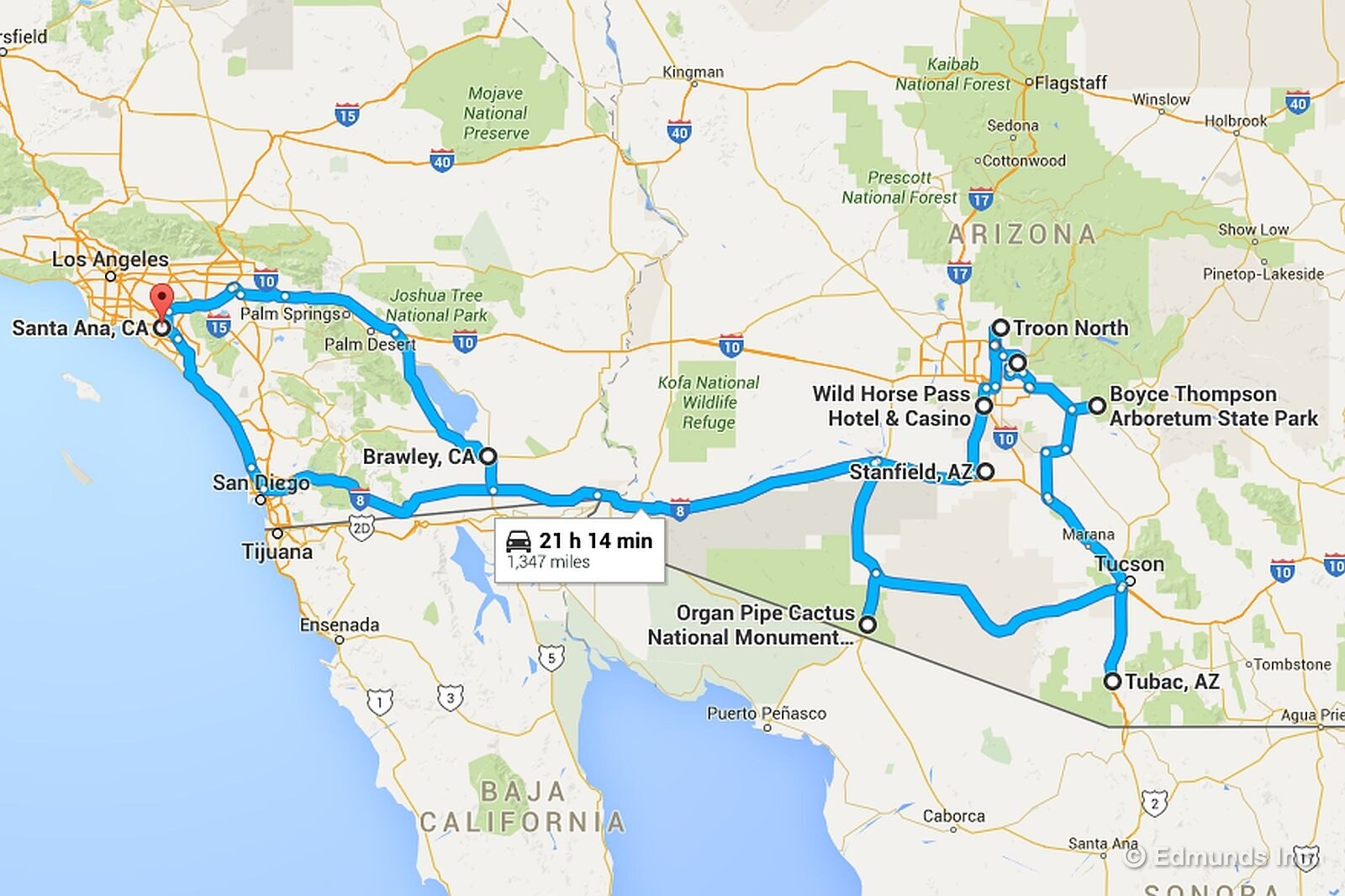
You've never seen so much nothing interspersed with cactus. The ratio tips decidedly toward the latter when you get into the Organ Pipe Cactus National Monument and other rugged and mountainous areas.
I got out and hiked around a couple times, but no matter how carefully I scanned the ground, my shoes invariably collected long and pointy cholla cactus spines. No matter, the expansive scenery was nearly as stunning from behind the wheel on the lonely two-lane roads I chose through the Tohono O'odham Nation.

Invariably, I started paying attention to my fuel economy and range. The 75-mph Arizona freeways were unlikely to produce any records, but when I rolled into the gas station next to my hotel in Fountain Hills, I was surprised to see I'd set a new "best range" mark of 458 miles while rolling along at a respectable 33.4 mpg.

The trip home began in earnest from the Nissan Proving Ground in Stanfield, Arizona, well south of Phoenix. The most direct route was the lonely Interstate 8, with a jog north past the Salton Sea to finish the trip along the axis of Interstate 10.
The tank already had 75 miles under its belt when I headed out, but I was determined to make it home without stopping for fuel. The event wrapped up just after lunch, and I was going to regain my lost hour when I crossed back in to the Pacific time zone. I had a good chance of making it home in time for dinner.

A moderate headwind vexed me for a time, but it died out as I crossed into California. The biggest delay was yet another Border Patrol checkpoint near Kane Spring. It was clear sailing after that and eventually I rolled up to my neighborhood gas station after the Hyundai sipped on that one tank of fuel for all of 501.6 miles, another new "best range" mark. And the low-fuel warning light hadn't come on until I exited the freeway and began the final mile.
I added 13.447 gallons, resulting in a calculated 37.3 mpg. But that felt wrong. It seemed that too few gallons had gone in, resulting in too much mpg. The Sonata had clicked off about a gallon prematurely once before when I filled it before the previous weekend's errands, so I was suspicious. I resolved to figure it out the following day.
Next morning I began the 46.4-mile drive to work, but I soon gained confidence I'd been right about the short fill when the fuel gauge dropped one segment below "full" within the first 10 miles. I stopped at the station nearest the office after a traffic-free highway commute and added 2.667 gallons, which resulted in a laughably wrong 17.3 mpg that nevertheless made sense in the circumstances.
The extra fuel and poor mpg were conclusive evidence that my hunch about the previous night's short fill was correct.
So I added the two together to make my official return-trip calculation using 16.124 gallons over 548 miles. That worked out to 34.0 mpg, a solid number that makes a lot more sense.
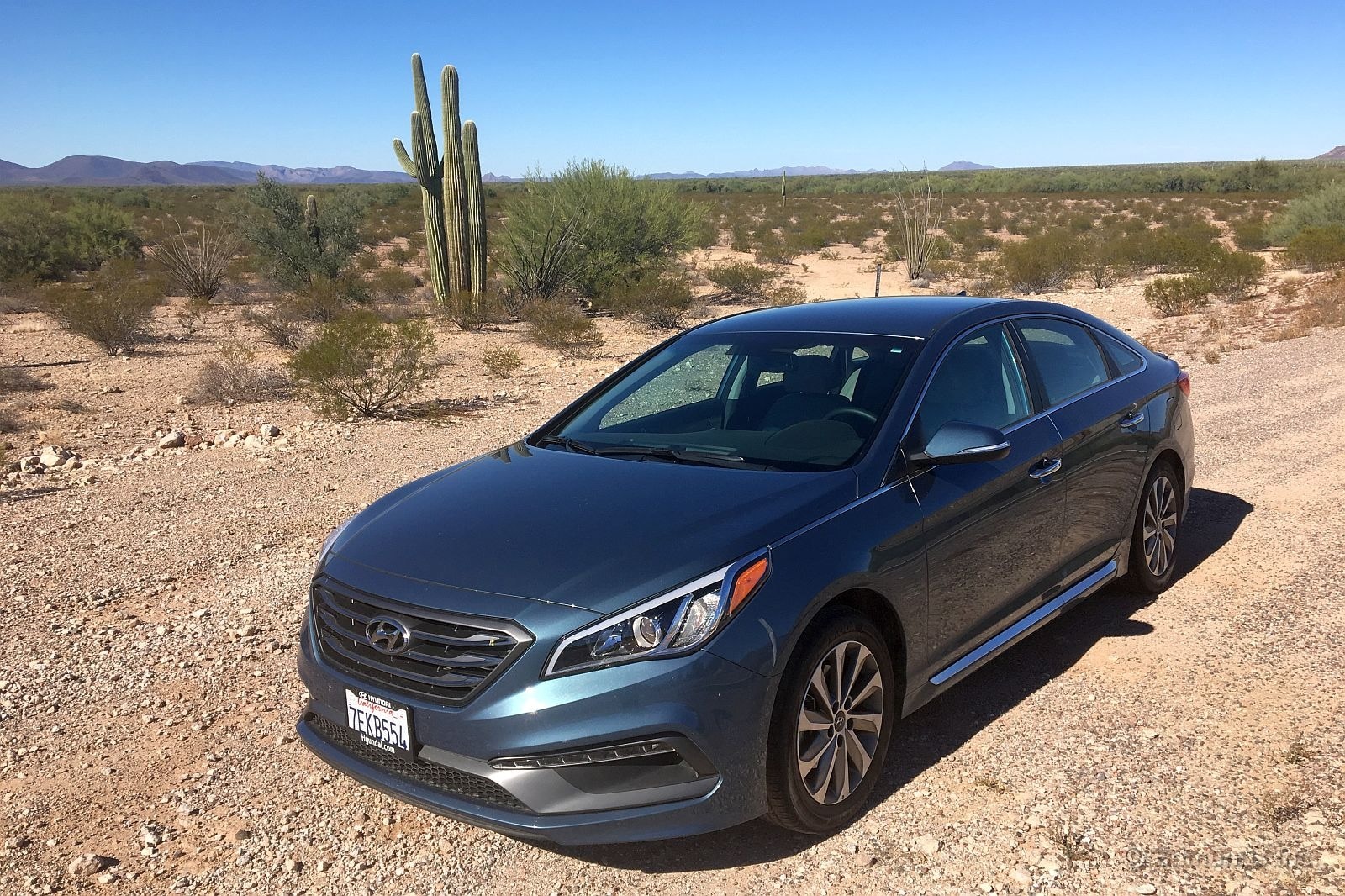
How was the car?
Smooth and comfortable. The seats never got tiring and the driving position remained agreeable throughout. It was just me and a single bag, so I can't say anything about road trip ride comfort with the whole family on board. There was no one to complain about the lack of rear seat cooling vents.
My biggest beef concerns the coarse sound of the 4-cylinder engine at idle and when accelerating from low speeds around town. It's the least pleasing aspect of our 2015 Hyundai Sonata.
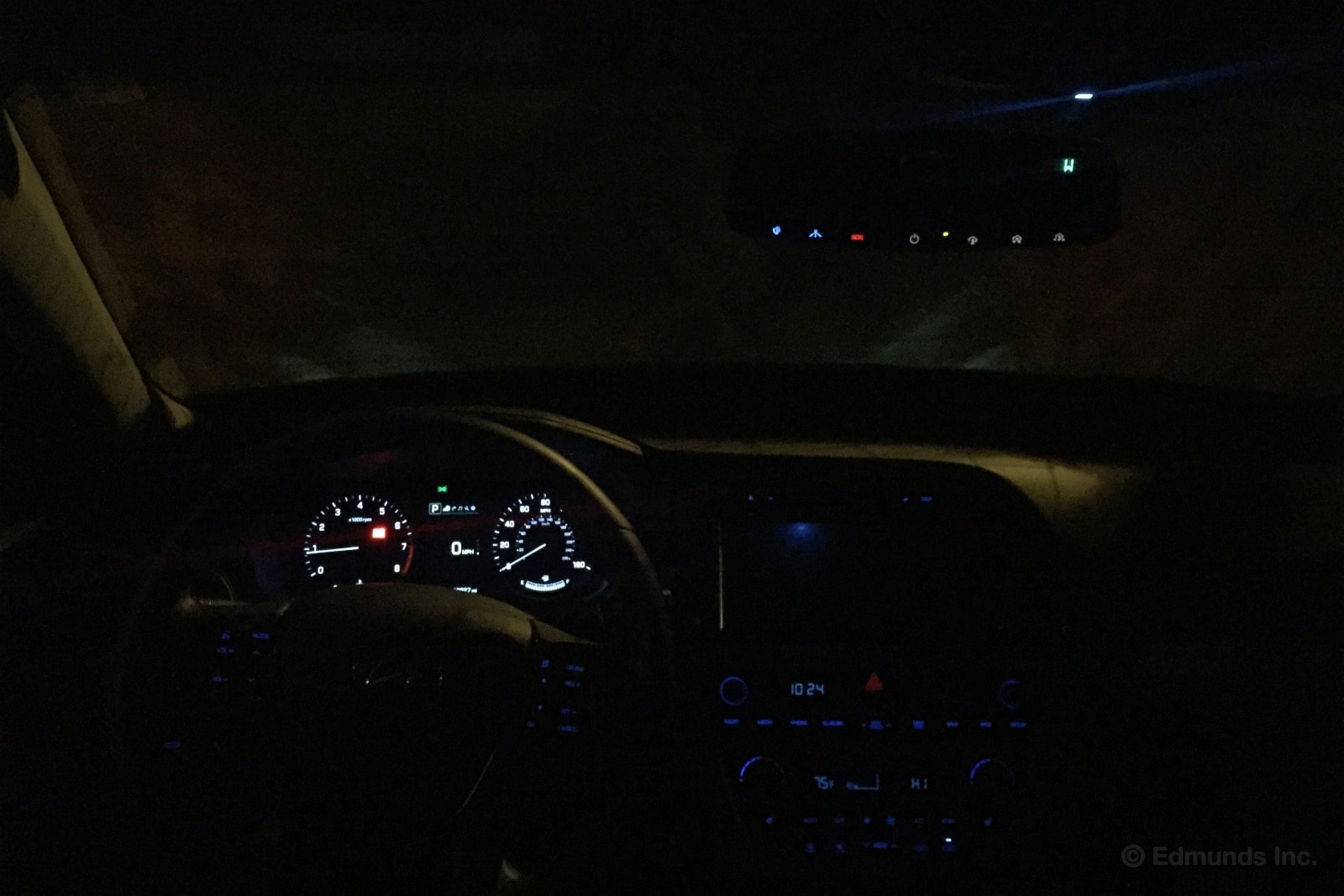
I'm a big fan of our long-term 2015 Hyundai Sonata. It's quiet, comfortable and fairly decent at the wheel. I agree with Ed about the user-friendly interior design and the generous rear-seat legroom. Brent summed up why the Sonata is great as a daily commuter, including the excellent driver's seat and sound system. I don't have many bad things to say about the car.
The one glaring issue I have is the single, blue LED that illuminates the cabin at night.
Phil wrote a post back in September about this very same light. While he seems to appreciate the blue glow that the light provides at night, I find it a nuisance and a distraction.
When I'm cruising on the highway at night, I like to turn all of the dash lights to their dimmest setting. This allows me to focus on the road and not on the myriad of buttons and knobs that fill modern cars. As long as I can still read the gauge cluster, I'm fine with the low light. The Sonata even allows you to turn off the infotainment display without actually turning off the HVAC or radio.
Still, that blue LED shines in the corner of my eye. It's not bad enough to stop me from driving the Sonata, but it's not my first car choice if I'm out at night.
Maybe it's my seating position that places the light right at the edge of my vision. Maybe the light is reflecting off of my glasses. I can't say for certain why it bothers me more than others, but that little blue LED has made me appreciate little things like illuminated cupholders and consoles. Personally, I think they're a better solution for brightening a darkened interior at night.
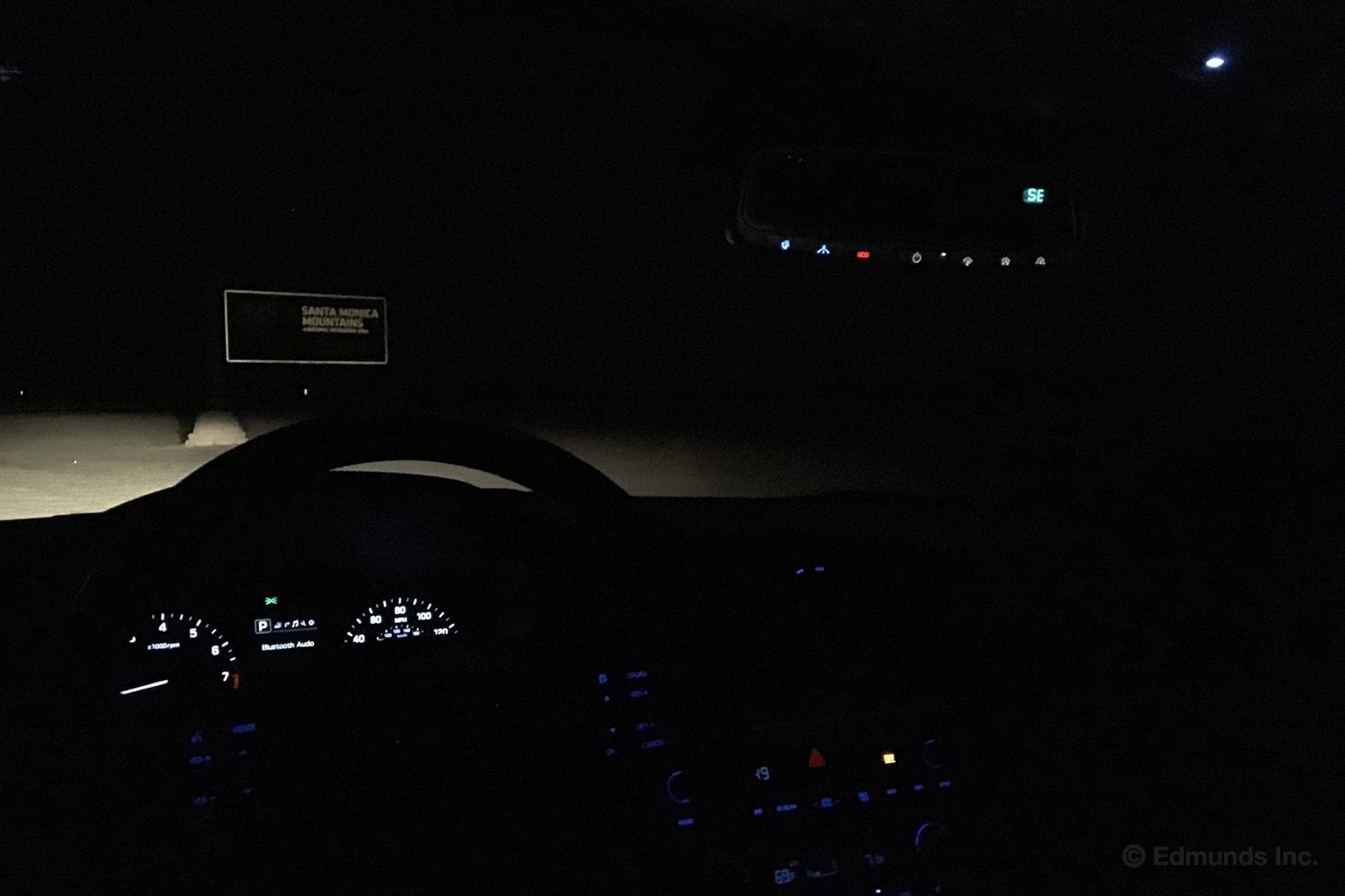
By most any measure, our 2015 Hyundai Sonata is a very pleasant and competent family sedan.
Except that it's constantly trying to blind me.
This is without a doubt the most difficult shot I've ever tried to take for the long-term blog. So if it's not overwhelmingly clear what's going on, read the words. If it's still not clear, go read something by Monticello. There's probably a bike involved.
Right. So. The blinding.
This is what the interior of the Sonata looks like at night. Pretty normal right? Except for that bright light at the top right. That's no moon, friends, that's an LED. Its purpose is to illuminate the cupholders so that when it's dark out, I can periodically check on my cups to make sure they haven't evaporated.
In practice, it just sits there, dangling at the edge of my peripheral vision about 16 inches from my eye being the brightest thing in the car.
Hooray!
Look at how much light it casts on my phone.

If this was mine, I'd throw a piece of gaff tape on it. And then, after a few days, I'd get annoyed at how the tape looks and then I'd dismantle the overhead console and disconnect the light. And then because I'd inevitably break one of the stupid clips, I'd have to take it to the dealership to have them fix the rattle from the overhead console.
They'd then reconnect the light, starting the whole thing over again.
Wrap-Up
What We Got
Hyundai had a tough job when it came to designing a follow-up to the widely praised Sonata sedan sold from 2010-'14. That car injected a little style into a class that was known mostly for anonymous designs. It got the Sonata mentioned in the same sentences as the Honda Accord and Toyota Camry, and we had a great experience with our long-termer.
The 2015 Hyundai Sonata took a more conservative approach when it came to its styling, but the rest of the car was solid. We gave the new 2015 model an "A" rating after an initial road test, so we decided to see how it would hold up over a year of hard use.
We passed on the two turbocharged engine options and settled on the volume seller. The Sonata Sport comes equipped with a 2.4-liter four-cylinder mated to a six-speed automatic transmission. We added the Premium package that included a blind-spot monitor, leather seats with cloth inserts, dual-zone climate control and hands-free entry. We also added the Tech package that included an 8-inch navigation system, Dimension audio and an auto-dimming rearview mirror.
All in, our 2015 Hyundai Sonata Sport rang up at $27,560, which put it right in the heart of the midsize family sedan segment. Here's what we found.
Performance
"In Sport Mode, the changes are subtle but preferable. The Sonata's throttle sensitivity and suspension tuning don't change, but its steering gets a bit heavier and, most importantly, the transmission holds gears longer or, as the owner's manual says, 'Up-shifting is delayed.'" — Scott Oldham
"I like the responsiveness of the throttle, and the six-speed automatic does a good job of getting the most of its 185 horsepower. That said, this is not a fast car by any means. Thankfully, it's not dreadfully slow either. You can make passes on the highway in a reasonable amount of time and if you want to gutter ball someone at a light, it will do that, too." — Ed Hellwig
MPG
"I don't know if it was the late summer heat, but our shoes were a little more lead-y than usual in October. For the month we averaged 23.3 mpg and, this should go without saying, we didn't set any new distance or mileage records for the month. We're still 2 mpg shy of the EPA rating, but we've got a little more time with our Sonata to see if it can do better." — Kurt Niebuhr
"Since the Sonata joined our fleet in December, we've covered 300-plus miles on a single tank 25 times. Three of those times we covered 400 miles or more. Over those 25 tanks, the Sonata is averaging 27.6 mpg, very near the EPA combined rating." — Dan Frio
Comfort
"I'm comfortable in the Sonata both literally and figuratively. I like the shape of its seat. I like the feel of its upholstery. I like the placement of its controls and its sporty seating position. Nothing about the Sonata is trying too hard to be cool or edgy or relevant, but it isn't boring or unadventurous either. This ain't no pod." — Scott Oldham
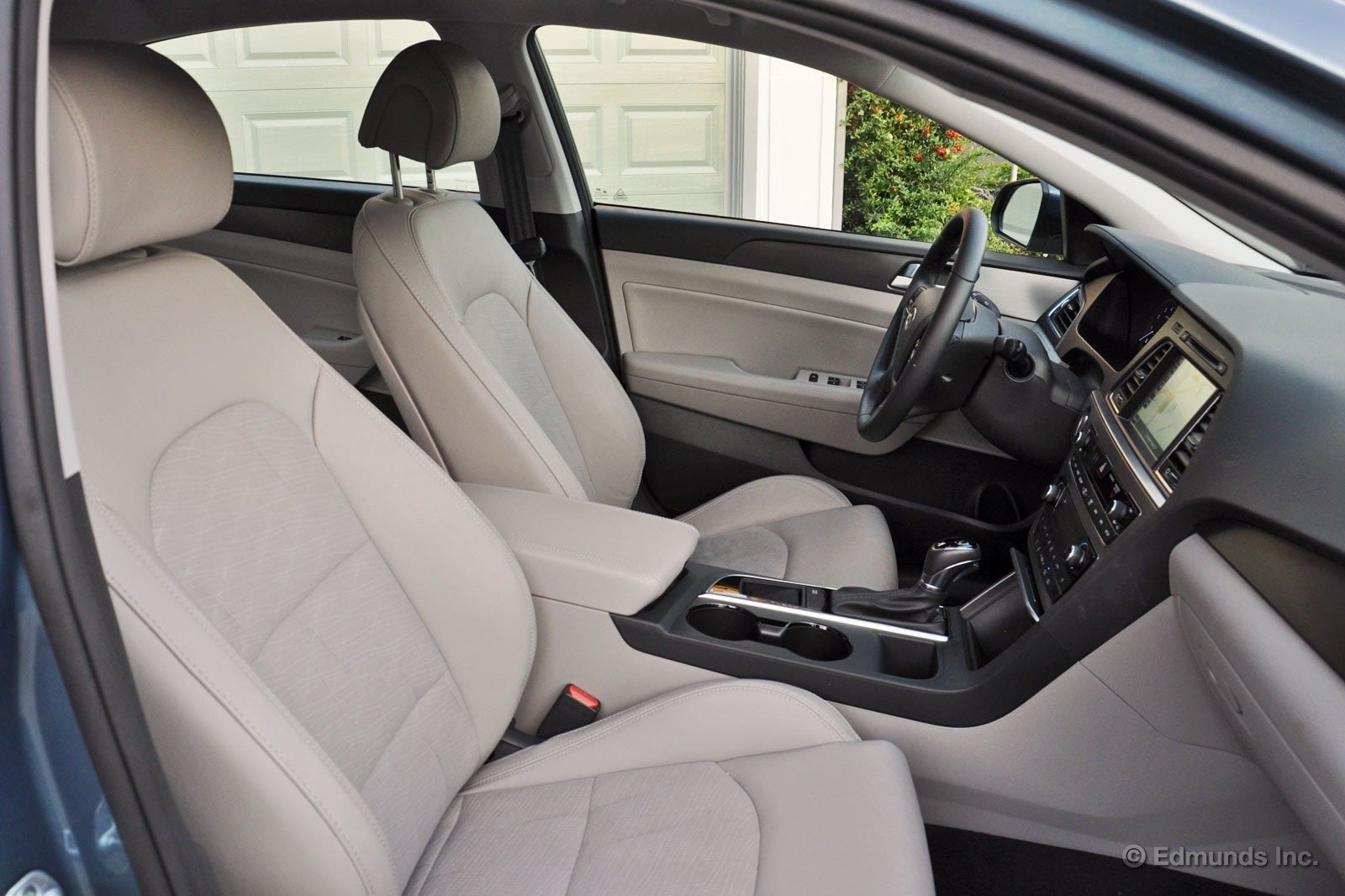
"I'm glad to report the initial indications are good. The seat not only feels well designed in the first few miles, it still feels that way two hours later. Any new car seat should be comfortable to some degree, but designing a seat for a mainstream sedan that appeals to everybody often leads to a design that's average across the board." — Ed Hellwig
Cargo Space
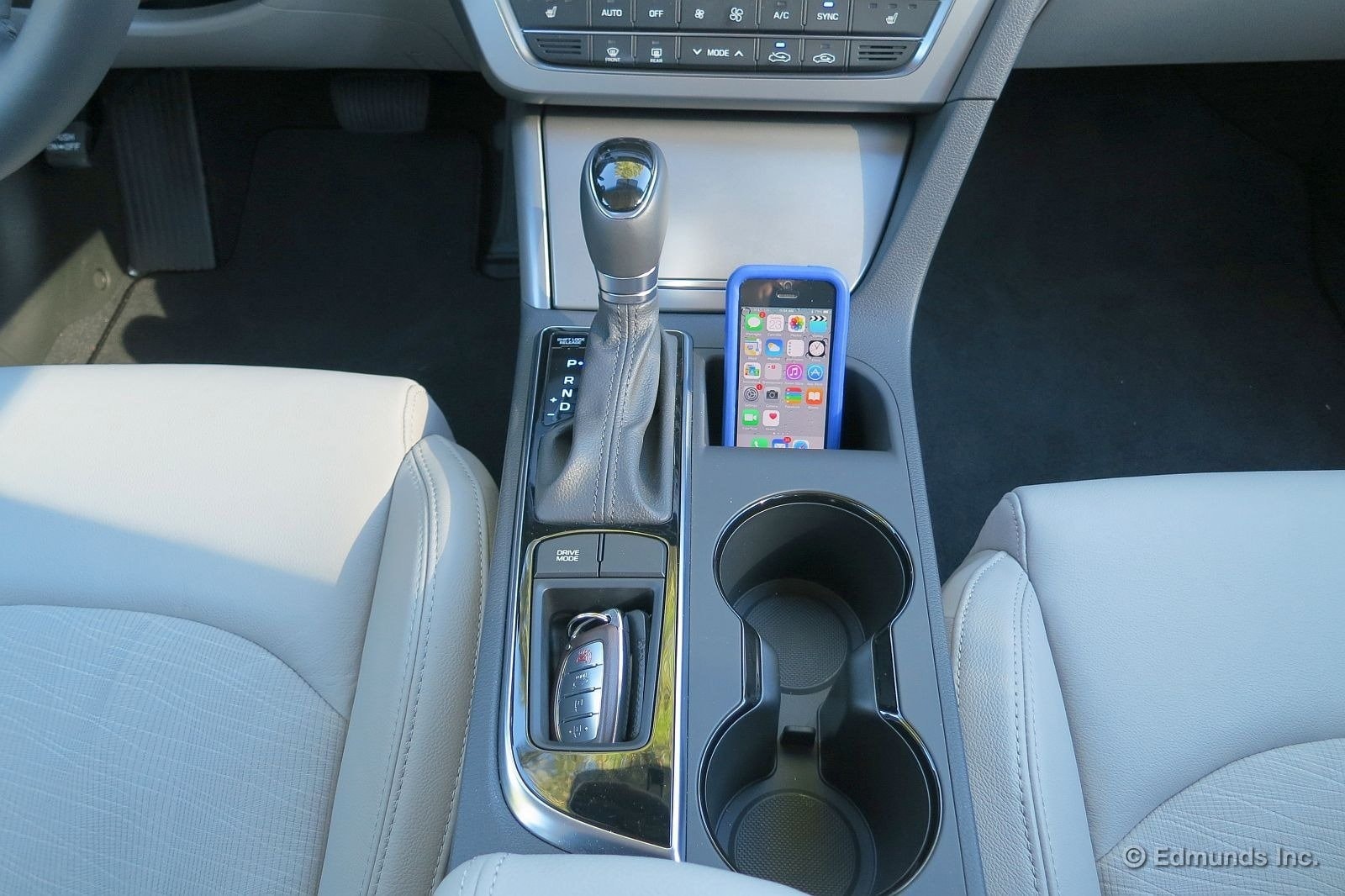
"I like the thought that was put into small-item storage in the 2015 Hyundai Sonata. For instance, the front bin, where the USB port and your music device reside, has a handy security door to keep things hidden when you're not in the car." — Mike Monticello
"Loading items such as suitcases into the Sonata's 16.3-cubic-foot trunk is helped out by a wide opening. The only downside I've noticed is that if you're packing in a lot of stuff high, you have to pay some attention to where the trunk lid hinges lower down (when you close the lid). This is true for most sedans, but the Sonata's 'gooseneck' hinges seem to be positioned a couple of inches more inward than, say, the ones in our last big-trunk sedan, the Volkswagen Passat. Other than that, our Sonata is at the ready for carrying our stuff." — Brent Romans
Interior
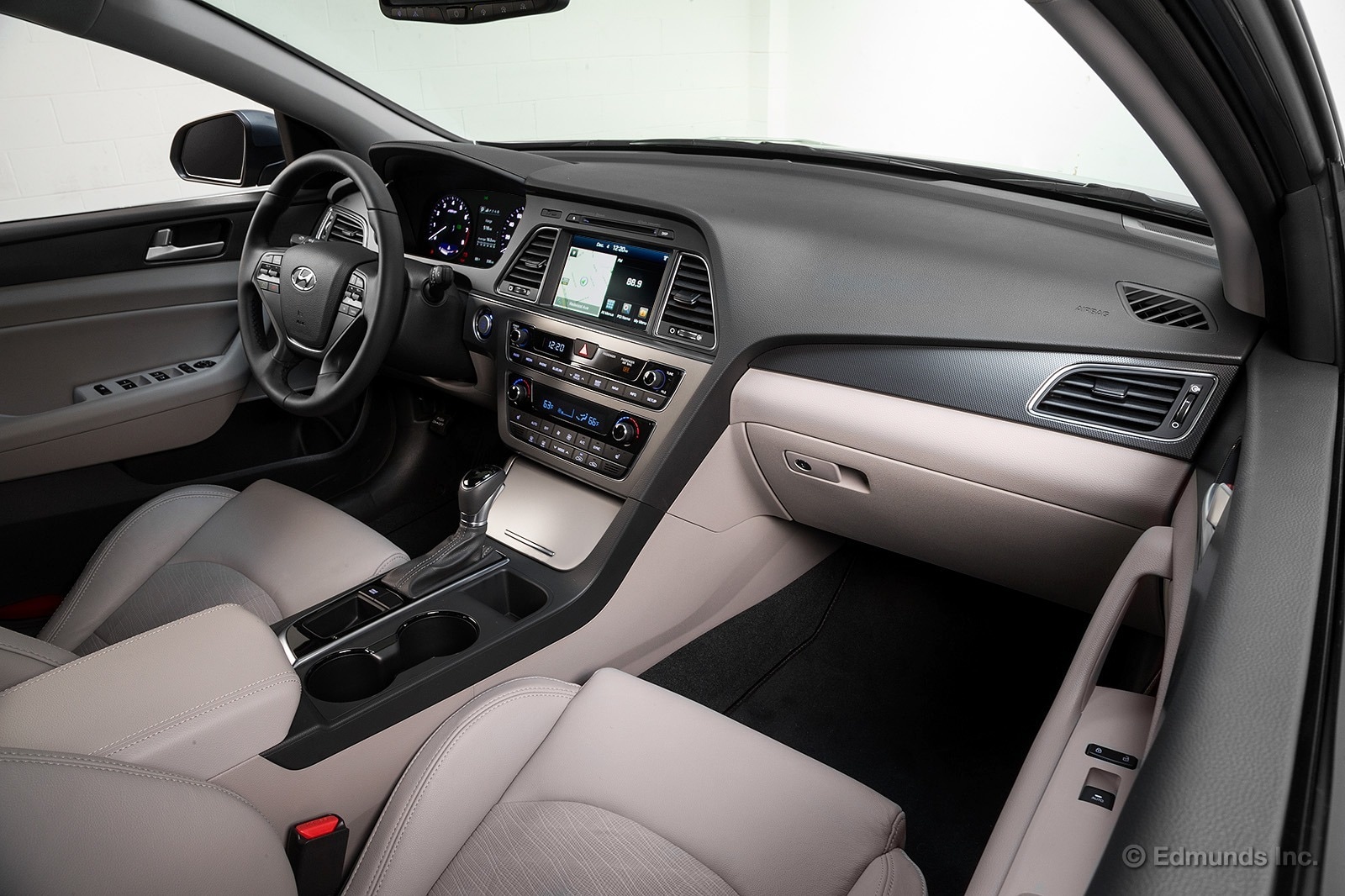
"I also love the new interior. It feels rich and high-quality, but not overdone. Not cartoonish. The seat and driving position are among the best I've ever felt and the design of the dash, console and all other controls and touch points are very much to my liking." — Scott Oldham
"Where does it come up short? Legroom. With 35.6 inches of rear legroom, the Sonata comes up around 3 inches short of the Accord and the Camry and half-an-inch short to the Altima. So why does it still feel roomy? It's tall and wide. When it comes to headroom, the Sonata nearly matches the Camry (38 vs. 38.1 inches) and beats the Accord and Altima by at least half an inch." — Ed Hellwig
Audio and Technology
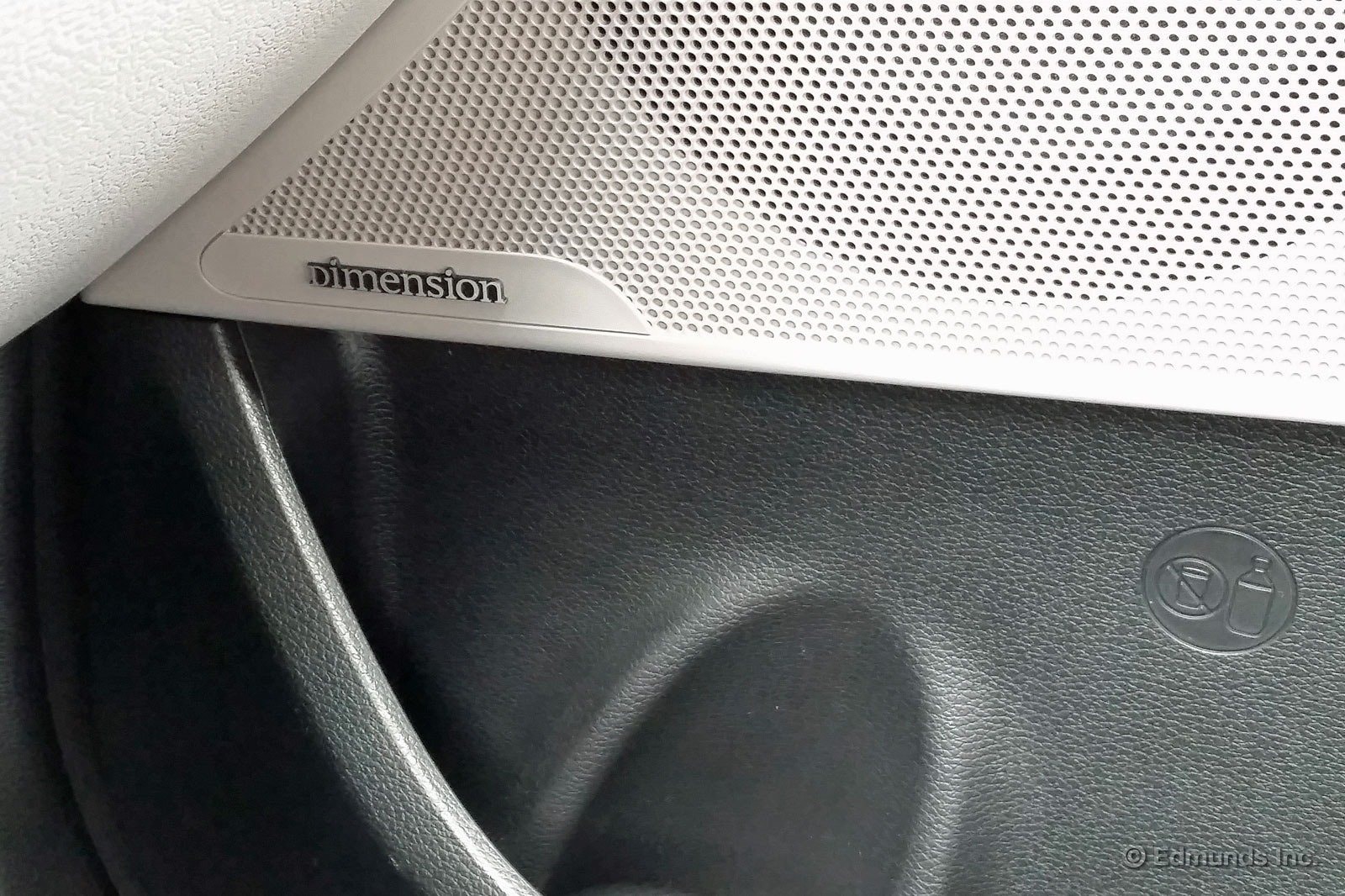
"This system and setting won't win awards for frequency response or EQ curve, and you'll hear the same music pretty differently on even a decent home stereo or theater system. But you will get some of that punch and rumble, which again can be fun with the right tracks. I enjoyed feeding some newer hip-hop and old classics through this setting." — Dan Frio
"The screen has high-resolution graphics that result in crisp fonts, detailed maps and a useful view from the rearview camera. It responds quickly to your touch inputs and has hard buttons below the screen for shortcuts to the main system operations such as radio, media and navigation." — Brent Romans
Maintenance
"It seemed strange to me that a tire rotation was not listed in the owner's manual. An oil change and tire rotation is performed at most, if not all, scheduled maintenance intervals for other cars. I used the Edmunds Car Maintenance Guide and queried the list of services to be performed on a 2015 Hyundai Sonata at 7,500 miles. Sure enough, a tire rotation was listed." — Cameron Rogers
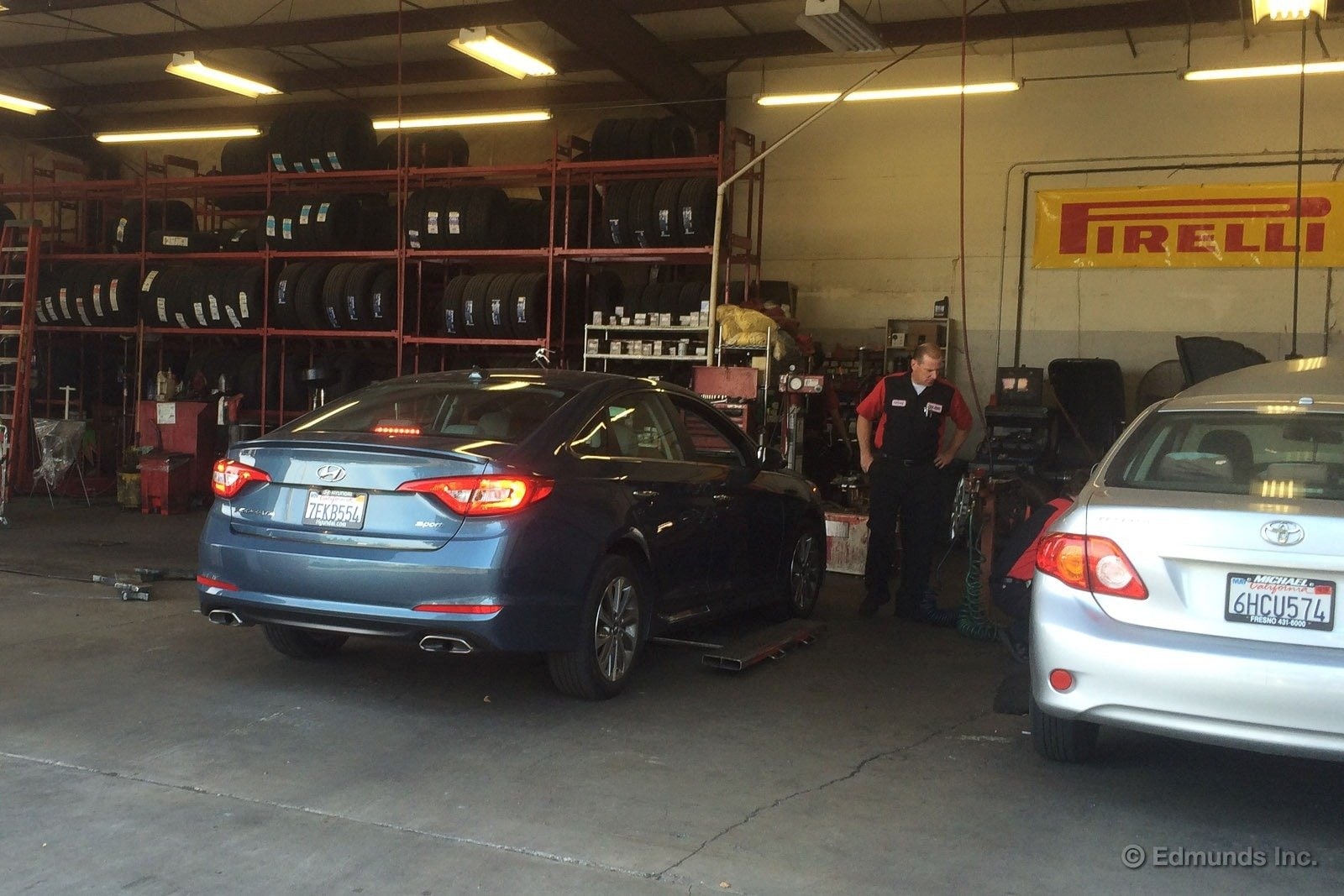
"The shop's owner was a little surprised I was actually bringing our Sonata in. Presumably they don't get many calls for alignments on new vehicles. He first suggested that a front-tire rotation might help remedy the pull. Sometimes the tires have an inherent tendency (just from the way they are made) to direct the car to the left or right instead of staying straight, he said. Swapping the front tires can help fix it. But he also said his technician would put the Sonata on their alignment machine and check it out. It turned out that the Sonata's alignment was not correct. In particular, the toe of both rear wheels was not in the specified range. The shop speculated that this rear steering effect was causing the veering to the right." — Brent Romans
Miscellaneous
"Even after 20,000 miles, it still feels just as well-sorted. No squeaks or rattles, and the suspension still feels dialed in. Usually by the time the odometer has passed 20,000 miles, cars get a little soft around the edges, yet this one still has that same sharpness. I've liked this car from Day One, and nothing this past year has soured my feelings on it." — Ed Hellwig
"It's about $2,500 cheaper than I expected it to be. I had a rough idea where Sonata pricing started (+/- $21,000) and that the Sport starts a little above that. But I guessed that this car as equipped had a sticker price of $30,000 or just under that. It doesn't. It stickers at $27,560. That's an impressive price for this level of quiet, stuff and comfort. Very compelling. Add in the big warranty and you've got a package that's hard to beat. If a family member or close friend was in the market in this segment, this would be among my top recommendations." — Mike Magrath
Maintenance & Repairs
Regular Maintenance:
The owner's manual calls for service every 7,500 miles, so the Sonata went in twice for regular maintenance. There was a separate issue with the car's alignment that prompted a visit to a local tire shop. There was also a dealer visit early on to diagnose an illuminated airbag light.
The owner's manual was unclear on what was called for in the first service, and though the 15,000-mile service went much smoother, it was far more costly. The total for all maintenance came to $258.43.
Service Campaigns:
Soon after the Sonata arrived, the airbag warning light came on. It turned out that a sensor had disconnected itself. While fixing that issue, the dealer performed a software update for the infotainment system.
During the 15,000-mile service, the dealer dealt with two open recalls. First, it updated the airbag control software. Secondly, it replaced the passenger seatbelt buckle cover.
Fuel Economy and Resale Value
Observed Fuel Economy:
The 2015 Hyundai Sonata sport is rated at 28 mpg combined (24 city/35 highway).
Over 12 months and 20,000 miles, we averaged 26.1 mpg, significantly off the 28 mpg combined EPA rating. Our best tank averaged 35.7 mpg and our worst was 16.2 mpg, although that was on a very short 78-mile tank. Our best range was 501.6 miles on a single tank.
Resale and Depreciation:
The MSRP for our 2015 Hyundai Sonata Sport was $27,560. The Edmunds TMV® Calculator valued the Sonata at $17,745 based on a private-party sale, a substantial 36 percent depreciation. That's far higher than the 21 percent for the 2011 Hyundai Sonata GLS we tested.
Summing Up
Pros: Comfortable, well-designed interior; quiet cabin on the road; plenty of power from four-cylinder engine; solid, well-timed shifts from six-speed automatic transmission; seats remain comfortable over the long haul; long range between fill-ups; no rattles or notable wear after 20,000 miles.
Cons: Didn't deliver EPA fuel economy estimates; less rear legroom than competitors; higher-than-average depreciation.
Bottom Line: After putting more than 20,000 miles on our 2015 Hyundai Sonata Sport, we still think it's one of the best sedans in the midsize segment. If your primary concern is fuel efficiency, there are better cars out there, but this Sonata delivers a top-notch experience in every other respect.
| Total Body Repair Costs: | None |
| Total Routine Maintenance Costs: | $168.44 (over 12 months) |
| Additional Maintenance Costs: | $89.99 |
| Warranty Repairs: | Reattach airbag sensor wiring harness; replace passenger seatbelt cover |
| Non-Warranty Repairs: | Fix alignmnent |
| Scheduled Dealer Visits: | 2 |
| Unscheduled Dealer Visits: | 1 |
| Days Out of Service: | None |
| Breakdowns Stranding Driver: | None |
| Best Fuel Economy: | 35.7 mpg |
| Worst Fuel Economy: | 16.2 mpg |
| Average Fuel Economy: | 26.1 mpg |
| True Market Value at service end: | $17,745 (private-party sale) |
| Depreciation: | $17,365 (36% of original MSRP) |
| Final Odometer Reading: | 20,570 miles |
The manufacturer provided Edmunds this vehicle for the purposes of evaluation.